-
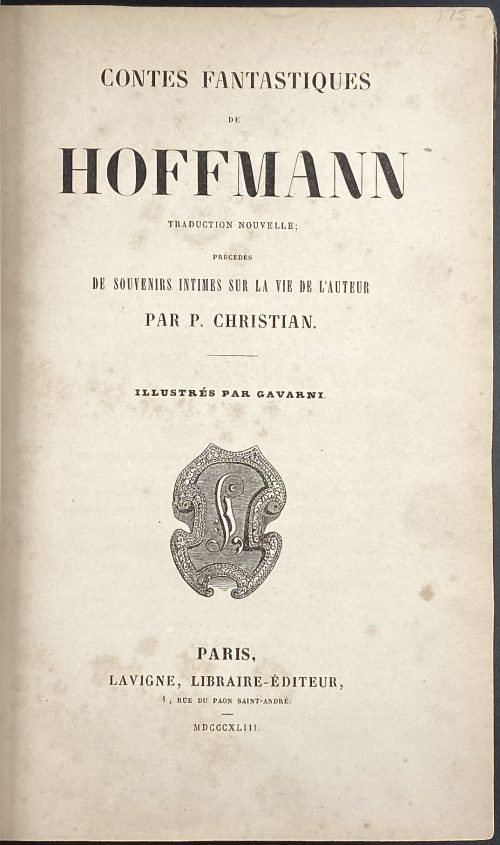 Title: CONTES FANTASTIQUES | DE | HOFFMANN | TRADUCTION NOUVELLE ; PRÉCÉDÉS | DE SOUVENIRS INTIMES SUR LA VIE DE L’AUTEUR | PAR P. CHRISTIAN. | ILLUSTRÉS PAR GAVARNI. | {Publisher’s device} | — PARIS, | LAVIGNE, LIBRAIRE-ÉDITEUR, | 1 RUE DU PAON SAINT-ANDRÉ. | MDCCCXLIII. || Pagination: ffl, [i-vi] –h.t. / colopon, t.p. /blank, dedication /blank, [vii] viii-xix [xx][1,-3] 4-522, bfl, + woodcut illustrations by Brévière et Novionafter Gavarni: 10 full page plates, initials, tail pieces, and in text. Collation: [a]-b4 c2, 1-654 661. Binding: Quarter brown morocco over marbled boards, raised bands with gilt double fillets, gilt arabesque in compartments, title lettering. Catalogue raisonné: L. Carteret (1927), p. 295.
Title: CONTES FANTASTIQUES | DE | HOFFMANN | TRADUCTION NOUVELLE ; PRÉCÉDÉS | DE SOUVENIRS INTIMES SUR LA VIE DE L’AUTEUR | PAR P. CHRISTIAN. | ILLUSTRÉS PAR GAVARNI. | {Publisher’s device} | — PARIS, | LAVIGNE, LIBRAIRE-ÉDITEUR, | 1 RUE DU PAON SAINT-ANDRÉ. | MDCCCXLIII. || Pagination: ffl, [i-vi] –h.t. / colopon, t.p. /blank, dedication /blank, [vii] viii-xix [xx][1,-3] 4-522, bfl, + woodcut illustrations by Brévière et Novionafter Gavarni: 10 full page plates, initials, tail pieces, and in text. Collation: [a]-b4 c2, 1-654 661. Binding: Quarter brown morocco over marbled boards, raised bands with gilt double fillets, gilt arabesque in compartments, title lettering. Catalogue raisonné: L. Carteret (1927), p. 295. -
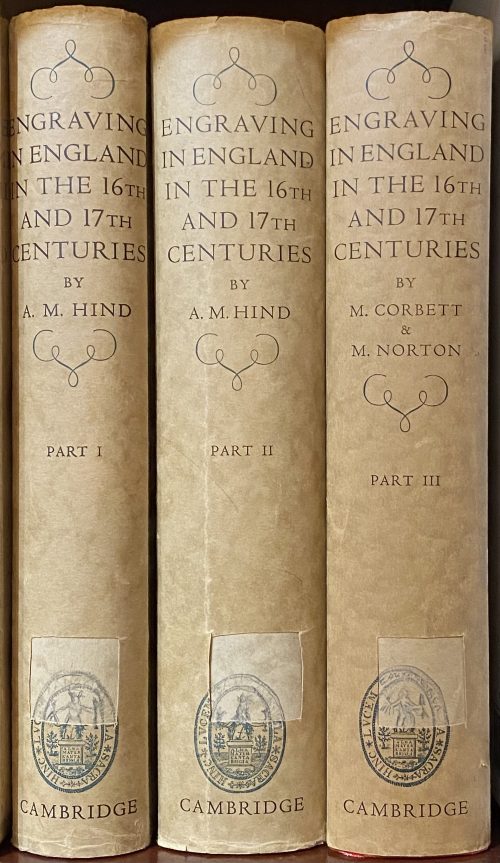 A three-volume set. VOL. 1: ENGRAVING IN ENGLAND | IN THE | SIXTEENTH AND SEVENTEENTH CENTURIES | A DESCRIPTIVE CATALOGUE | WITH INTRODUCTIONS | BY | ARTHUR M HIND | Sometime Keeper of Prints and Drawings in the British Museum | and Slade Professor of Fine Art in the University of Oxford | PART I | THE TUDOR PERIOD | WITH 319 ILLUSTRATIONS | {The coat of arms of the University of Cambridge} | CAMBRIDGE | AT THE UNIVERSITY PRESS | 1952|| Pagination: ffl, [i-vi] – h.t. / blank, frontis., t.p. / colophon, dedication / blank; vii-xxx; 1-333 [334 blank] [2] – the plates / blank; 1-156 pp. of plates. Collation: a-b8, 1-218 + 78 leaves of plates at the end. VOL. 2: ENGRAVING IN ENGLAND | IN THE | SIXTEENTH AND SEVENTEENTH CENTURIES | A DESCRIPTIVE CATALOGUE | WITH INTRODUCTIONS | BY | ARTHUR M HIND | Sometime Keeper of Prints and Drawings in the British Museum | and Slade Professor of Fine Art in the University of Oxford | PART II | THE REIGN OF JAMES I | WITH 618 ILLUSTRATIONS| {The coat of arms of the University of Cambridge} | CAMBRIDGE | AT THE UNIVERSITY PRESS | 1955|| Pagination: [i-iv] – h.t. / blank, t.p. / colophon; v-xiv [xv] [xvi blank]; 1-396 [397] [398 blank] [2] – the plates / blank; 1-252 pp. of plates. Collation: a-b8, 1-268 + 126 leaves of plates at the end. VOL. 3: ENGRAVING IN ENGLAND | IN THE | SIXTEENTH AND SEVENTEENTH CENTURIES | A DESCRIPTIVE CATALOGUE | WITH INTRODUCTIONS | PART III | THE REIGN OF CHARLES I | WITH 466 ILLUSTRATIONS | COMPILED FROM THE NOTES OF | THE LATE A. M. HIND | BY | MARGERY CORBETT & MICHAEL NORTON | {The coat of arms of the University of Cambridge} | CAMBRIDGE | AT THE UNIVERSITY PRESS | 1964|| Pagination: [i-vi] – h.t. / blank, frontis., t.p. / colophon, dedication / blank; vii-xxx; 1-333 [334 blank] [2] – the plates / blank; 1-214 pp. of plates. Collation: [a]8, 1-258 + 107 leaves of plates at the end. Each of three volumes bound in red cloth with gilt lettering to spine, residuals of library stickers, dark spotting to the top and lateral edges; tan DJ with title lettering in a frame to front, lettering to spine, advert. to back, with cut off stickers to spine; ‘The Francis Bacon Foundation’ ink stamp to front pastedown.
A three-volume set. VOL. 1: ENGRAVING IN ENGLAND | IN THE | SIXTEENTH AND SEVENTEENTH CENTURIES | A DESCRIPTIVE CATALOGUE | WITH INTRODUCTIONS | BY | ARTHUR M HIND | Sometime Keeper of Prints and Drawings in the British Museum | and Slade Professor of Fine Art in the University of Oxford | PART I | THE TUDOR PERIOD | WITH 319 ILLUSTRATIONS | {The coat of arms of the University of Cambridge} | CAMBRIDGE | AT THE UNIVERSITY PRESS | 1952|| Pagination: ffl, [i-vi] – h.t. / blank, frontis., t.p. / colophon, dedication / blank; vii-xxx; 1-333 [334 blank] [2] – the plates / blank; 1-156 pp. of plates. Collation: a-b8, 1-218 + 78 leaves of plates at the end. VOL. 2: ENGRAVING IN ENGLAND | IN THE | SIXTEENTH AND SEVENTEENTH CENTURIES | A DESCRIPTIVE CATALOGUE | WITH INTRODUCTIONS | BY | ARTHUR M HIND | Sometime Keeper of Prints and Drawings in the British Museum | and Slade Professor of Fine Art in the University of Oxford | PART II | THE REIGN OF JAMES I | WITH 618 ILLUSTRATIONS| {The coat of arms of the University of Cambridge} | CAMBRIDGE | AT THE UNIVERSITY PRESS | 1955|| Pagination: [i-iv] – h.t. / blank, t.p. / colophon; v-xiv [xv] [xvi blank]; 1-396 [397] [398 blank] [2] – the plates / blank; 1-252 pp. of plates. Collation: a-b8, 1-268 + 126 leaves of plates at the end. VOL. 3: ENGRAVING IN ENGLAND | IN THE | SIXTEENTH AND SEVENTEENTH CENTURIES | A DESCRIPTIVE CATALOGUE | WITH INTRODUCTIONS | PART III | THE REIGN OF CHARLES I | WITH 466 ILLUSTRATIONS | COMPILED FROM THE NOTES OF | THE LATE A. M. HIND | BY | MARGERY CORBETT & MICHAEL NORTON | {The coat of arms of the University of Cambridge} | CAMBRIDGE | AT THE UNIVERSITY PRESS | 1964|| Pagination: [i-vi] – h.t. / blank, frontis., t.p. / colophon, dedication / blank; vii-xxx; 1-333 [334 blank] [2] – the plates / blank; 1-214 pp. of plates. Collation: [a]8, 1-258 + 107 leaves of plates at the end. Each of three volumes bound in red cloth with gilt lettering to spine, residuals of library stickers, dark spotting to the top and lateral edges; tan DJ with title lettering in a frame to front, lettering to spine, advert. to back, with cut off stickers to spine; ‘The Francis Bacon Foundation’ ink stamp to front pastedown. -
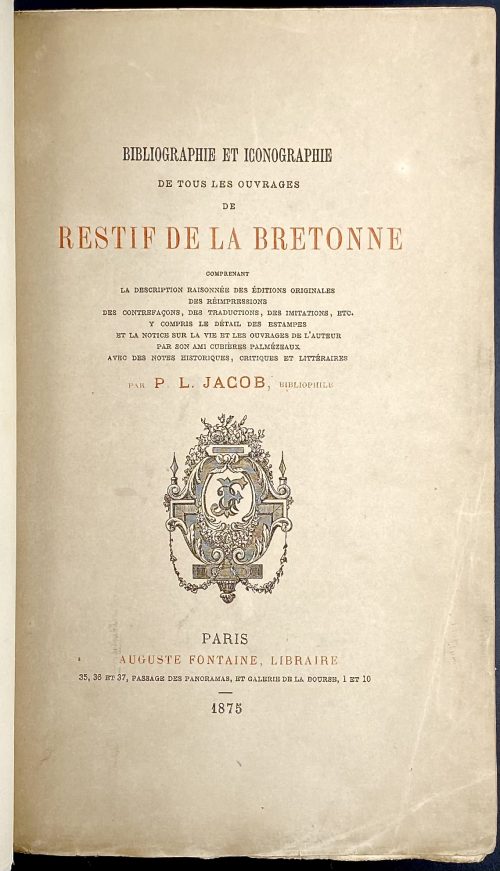 Title: BIBLIOGRAPHIE ET ICONOGRAPHIE | DE TOUS LES OUVRAGES | DE | RESTIF DE LA BRETONNE | COMPRENANT | LA DESCRIPTION RAISONNÉE DES ÉDITIONS ORIGINALES | DES RÉIMPRESSIONS | DES CONTREFAÇONS, DES TRADUCTIONS, DES IMITATIONS, ETC. | Y COMPRIS LE DÉTAIL DES ESTAMPES | ET LA NOTICE SUR LA VIE ET LES OUVRAGES DE L'AUTEUR | PAR SON AMI CUBIÈRES PALMÉZEAUX | AVEC DES NOTES HISTORIQUES, CRITIQUES ET LITTÉRAIRES | PAR P. L. JACOB, BIBLIOPHILE | {Publisher’s device} | PARIS | AUGUSTE FONTAINE, LIBRAIRE | 35, 36 ET 37 PASSAGE DES PANORAMAS, ET GALERIE DE LA BOURSE, 1 ET 10 | 1875 || Pagination: ffl, 1 leaf with owner’s engraved ex libris, orig. tan wrapper w/lettering, 1 blank leaf, [2] – h.t. / tirage, 453 of 500, frontis. Portrait, [2] – t.p. / blank, [i] ii-xv [xvi blank], [1] 2-510, [2] – imprint / blank, [1] 2-8 advert., 1 blank leaf, orig. back wrapper, orig. spine, bfl. Note: pp. starting from p. 76 and up to p. 455, between every two leaves of text, there are leaves of grid paper bound in, some with the reader’s handwritten ink remarks. Collation: Prelims., 8vo; a8, 1-328 + advert. Binding: ¾ brown morocco over marbled boards, spine with raised bands and gilt lettering, peacock marbled endpapers. Original wrappers preserved. Size: 23.5 x 14 x 8 cm. Provenance: Juan Hernandez bookplate engraved on a laid and watermarked paper sheet and including a library storage № 2272 The catalogue is produced by Paul Lacroix (French, 1806 – 1884) under the pseudonym of P. L. Jacob; the essay of Restif de La Bretonne biography – by Barbier Michel Cubières de Palmeseaux (French, 1752 – 1820). Frontispice: engraved portrait of Nicolas-Edme Restif de La Bretonne (French, 1734 – 1806) by Eugène Loizelet (French, 1842 – 1882) after Louis Berthet (French, fl. 1775 – 1808) after Louis Binet (French, 1744 – c. 1800).
Title: BIBLIOGRAPHIE ET ICONOGRAPHIE | DE TOUS LES OUVRAGES | DE | RESTIF DE LA BRETONNE | COMPRENANT | LA DESCRIPTION RAISONNÉE DES ÉDITIONS ORIGINALES | DES RÉIMPRESSIONS | DES CONTREFAÇONS, DES TRADUCTIONS, DES IMITATIONS, ETC. | Y COMPRIS LE DÉTAIL DES ESTAMPES | ET LA NOTICE SUR LA VIE ET LES OUVRAGES DE L'AUTEUR | PAR SON AMI CUBIÈRES PALMÉZEAUX | AVEC DES NOTES HISTORIQUES, CRITIQUES ET LITTÉRAIRES | PAR P. L. JACOB, BIBLIOPHILE | {Publisher’s device} | PARIS | AUGUSTE FONTAINE, LIBRAIRE | 35, 36 ET 37 PASSAGE DES PANORAMAS, ET GALERIE DE LA BOURSE, 1 ET 10 | 1875 || Pagination: ffl, 1 leaf with owner’s engraved ex libris, orig. tan wrapper w/lettering, 1 blank leaf, [2] – h.t. / tirage, 453 of 500, frontis. Portrait, [2] – t.p. / blank, [i] ii-xv [xvi blank], [1] 2-510, [2] – imprint / blank, [1] 2-8 advert., 1 blank leaf, orig. back wrapper, orig. spine, bfl. Note: pp. starting from p. 76 and up to p. 455, between every two leaves of text, there are leaves of grid paper bound in, some with the reader’s handwritten ink remarks. Collation: Prelims., 8vo; a8, 1-328 + advert. Binding: ¾ brown morocco over marbled boards, spine with raised bands and gilt lettering, peacock marbled endpapers. Original wrappers preserved. Size: 23.5 x 14 x 8 cm. Provenance: Juan Hernandez bookplate engraved on a laid and watermarked paper sheet and including a library storage № 2272 The catalogue is produced by Paul Lacroix (French, 1806 – 1884) under the pseudonym of P. L. Jacob; the essay of Restif de La Bretonne biography – by Barbier Michel Cubières de Palmeseaux (French, 1752 – 1820). Frontispice: engraved portrait of Nicolas-Edme Restif de La Bretonne (French, 1734 – 1806) by Eugène Loizelet (French, 1842 – 1882) after Louis Berthet (French, fl. 1775 – 1808) after Louis Binet (French, 1744 – c. 1800). -
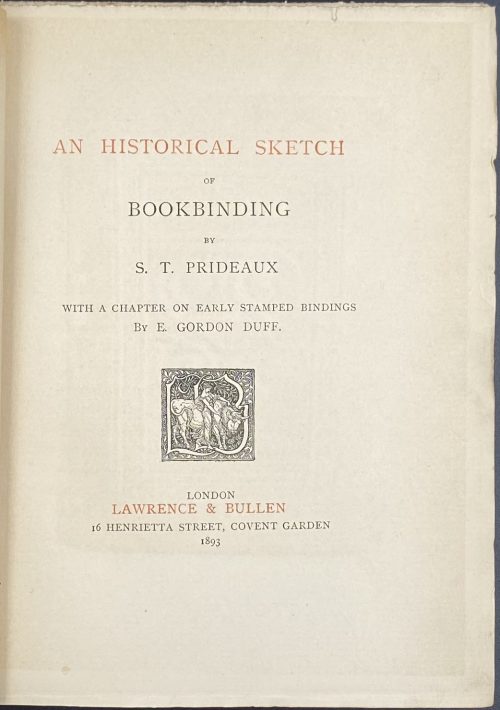 Title in black and red: AN HISTORICAL SKETCH | OF | BOOKBINDING | BY | S. T. PRIDEAUX | WITH A CHAPTER ON EARLY STAMPED BINDINGS | BY E. GORDON DUFF. | {Publisher’s device} | LONDON: LAWRENCE & BULLEN | 16 HENRIETTA STREET, COVENT GARDEN | 1893 || Pagination: [i, ii] – h.t. / blank, [2] – blank / frontis. w/guard, [iii, iv] – t.p. / colophon, [v], vi – preface, [vii, viii] – contents / blank, [1] 2-303 [304 blank]. Collation: 8vo; [A]4 B-U8. Binding: Grey cloth with gilt-stamped lettering and publisher’s device to front cover, gilt lettering to spine, blue floral ornamental endpapers, free margin untrimmed; printed on laid paper.
Title in black and red: AN HISTORICAL SKETCH | OF | BOOKBINDING | BY | S. T. PRIDEAUX | WITH A CHAPTER ON EARLY STAMPED BINDINGS | BY E. GORDON DUFF. | {Publisher’s device} | LONDON: LAWRENCE & BULLEN | 16 HENRIETTA STREET, COVENT GARDEN | 1893 || Pagination: [i, ii] – h.t. / blank, [2] – blank / frontis. w/guard, [iii, iv] – t.p. / colophon, [v], vi – preface, [vii, viii] – contents / blank, [1] 2-303 [304 blank]. Collation: 8vo; [A]4 B-U8. Binding: Grey cloth with gilt-stamped lettering and publisher’s device to front cover, gilt lettering to spine, blue floral ornamental endpapers, free margin untrimmed; printed on laid paper. -
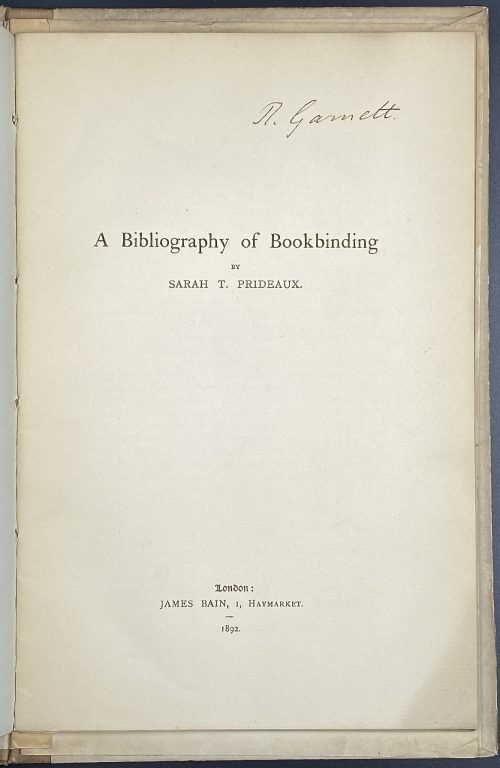 Title: A Bibliography of Bookbinding | by | SARAH T. PRIDEAUX | […] | London: | JAMES BAIN, 1 Haymarket. | 1892 || Pagination: ffl, [2] – front orig. wrapper, [2] t.p. / blank, [1] 2-23 [24] [2] back orig. wrapper. Binding: User’s quarter buckram and cardboard binding with gilt 686.P.6 number to front cover, 686 P to front wrapper, ink inscription T. Garnett (possibly Garnett & Co, Printers of Manchester Guardian) to t.p., blue ink stamp of Manchester P. F. libraries, pencilled 686 P6 to t.p. verso. To front pastedown an armorial bookplate of the Manchester public free libraries. and pasted Class No. R686 P6. Blueish original wrappers preserved.
Title: A Bibliography of Bookbinding | by | SARAH T. PRIDEAUX | […] | London: | JAMES BAIN, 1 Haymarket. | 1892 || Pagination: ffl, [2] – front orig. wrapper, [2] t.p. / blank, [1] 2-23 [24] [2] back orig. wrapper. Binding: User’s quarter buckram and cardboard binding with gilt 686.P.6 number to front cover, 686 P to front wrapper, ink inscription T. Garnett (possibly Garnett & Co, Printers of Manchester Guardian) to t.p., blue ink stamp of Manchester P. F. libraries, pencilled 686 P6 to t.p. verso. To front pastedown an armorial bookplate of the Manchester public free libraries. and pasted Class No. R686 P6. Blueish original wrappers preserved. -
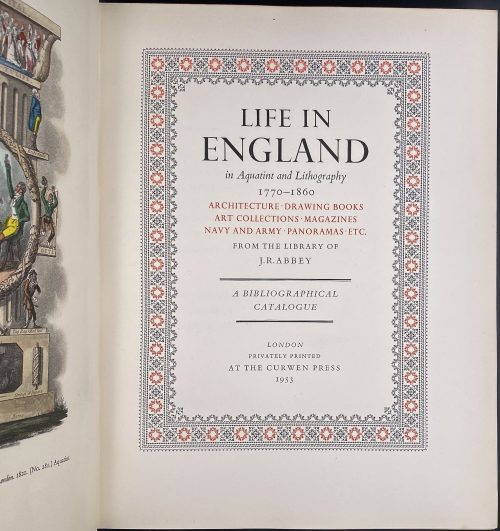 Title in black and red: LIFE IN ENGLAND | in Aquatint and Lithography | 1770—1860 | ARCHITECTURE • DRAWING BOOKS | ART COLLECTIONS • MAGAZINES | NAVY AND ARMY • PANORAMAS ETC. | FROM THE LIBRARY OF J. R. ABBEY | — | A BIBLIOGRAPHICAL | CATALOGUE | — | LONDON | PRIVATELY PRINTED | AT THE CURWEN PRESS | 1953 || Pagination: 2 blank leaves, [2] – limited edition 114 of 400 / blank, [i, ii] – h.t. / blank, [2] blank / frontis., [iii, iv] – t.p. / printer, v – contents, [vi] –blank, vii-ix – list of plates, [x] – blank, xi-xiii – list of ill., [xiv] – blank, xv-xxi – preface, xxii – blank; [1, 2] f.t. / blank, 3-427 [428], 2 blank leaves. Binding: Hardcover, 32 x 25.5 x 6.5 cm; brown cloth, red label with gilt lettering to spine, tan DJ with lettering to front and spine.
Title in black and red: LIFE IN ENGLAND | in Aquatint and Lithography | 1770—1860 | ARCHITECTURE • DRAWING BOOKS | ART COLLECTIONS • MAGAZINES | NAVY AND ARMY • PANORAMAS ETC. | FROM THE LIBRARY OF J. R. ABBEY | — | A BIBLIOGRAPHICAL | CATALOGUE | — | LONDON | PRIVATELY PRINTED | AT THE CURWEN PRESS | 1953 || Pagination: 2 blank leaves, [2] – limited edition 114 of 400 / blank, [i, ii] – h.t. / blank, [2] blank / frontis., [iii, iv] – t.p. / printer, v – contents, [vi] –blank, vii-ix – list of plates, [x] – blank, xi-xiii – list of ill., [xiv] – blank, xv-xxi – preface, xxii – blank; [1, 2] f.t. / blank, 3-427 [428], 2 blank leaves. Binding: Hardcover, 32 x 25.5 x 6.5 cm; brown cloth, red label with gilt lettering to spine, tan DJ with lettering to front and spine. -
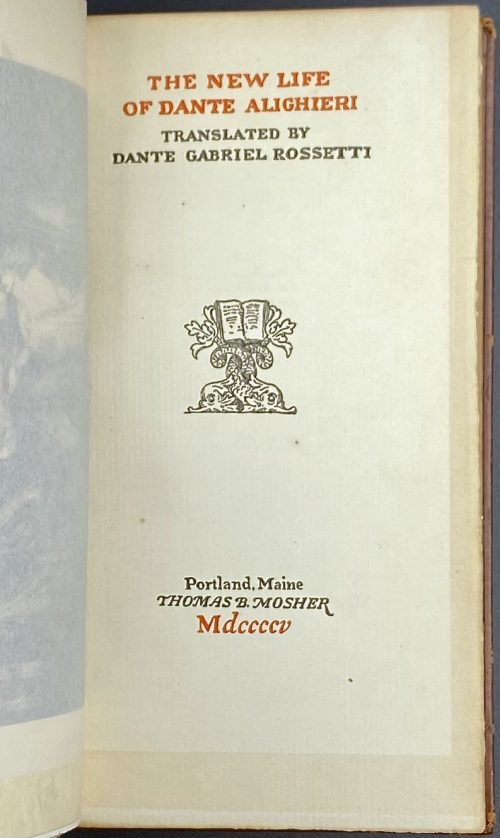 Title: THE NEW LIFE | OF DANTE ALIGHIERI | TRANSLATED BY | DANTE GABRIEL ROSSETTI | {Publisher's device} | Portland, Maine | THOMAS B. MOSHER | Mdccccv Pagination: Ffl [i-viii] ix-xii [xiii] [xiv blank], [1, 2] 3-97 [98] bfl; frontis. w/guard; Note: “This fourth edition on Van Gelder paper consists of 925 copies”. Binding: Hardcover, 18.2 x 10.2 cm, full brown morocco possibly by Sangorski & Sutcliffe, with embossed design elements, raised bands, gilt lettering to spine, TMG, other untrimmed; printed on laid paper with watermark.
Title: THE NEW LIFE | OF DANTE ALIGHIERI | TRANSLATED BY | DANTE GABRIEL ROSSETTI | {Publisher's device} | Portland, Maine | THOMAS B. MOSHER | Mdccccv Pagination: Ffl [i-viii] ix-xii [xiii] [xiv blank], [1, 2] 3-97 [98] bfl; frontis. w/guard; Note: “This fourth edition on Van Gelder paper consists of 925 copies”. Binding: Hardcover, 18.2 x 10.2 cm, full brown morocco possibly by Sangorski & Sutcliffe, with embossed design elements, raised bands, gilt lettering to spine, TMG, other untrimmed; printed on laid paper with watermark. -
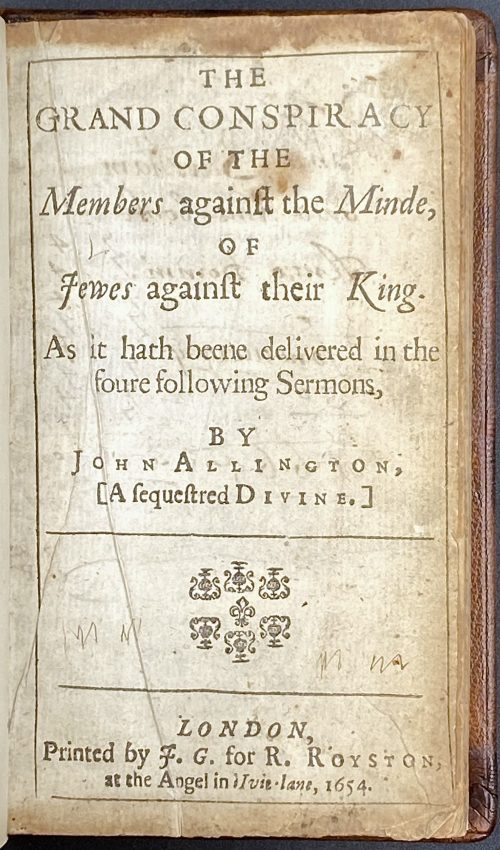 Title: THE | GRAND CONSPIRACY | OF THE | Members again∫t the Minde, | OF | Jewes again∫t their King. | As it hath beene delivered in the | foure following Sermons, | BY | John Allington, [A ∫eque∫tered Divine.] | — | {ornament} | — | LONDON, | Printed by J.G. for R. Royston, | at the Angel in Ivie-lane, 1654.|| Contents: Grand conspiracy of Jewes against their King. A sermon preached in August 1647; Grand conspiracy of Jewes against their King. A sermon preached in January 1649; Grand conspiracy of Jewes against their King. A demonstration of the highest insolencies proceed from men of the lowest and most base extractions Pagination: [2] – t.p. / blank; 1-214. Collation: 12mo; A-I12. Binding: Hardcover; 15 x 9.5 cm, later blind-stamped morocco, raised bands, gilt lettering in compartments. Inscription: Ink by hand by John Bartham, January 30, 1665, to t.p. verso; Pencil by hand to front pastedown: Wing A 1209A.
Title: THE | GRAND CONSPIRACY | OF THE | Members again∫t the Minde, | OF | Jewes again∫t their King. | As it hath beene delivered in the | foure following Sermons, | BY | John Allington, [A ∫eque∫tered Divine.] | — | {ornament} | — | LONDON, | Printed by J.G. for R. Royston, | at the Angel in Ivie-lane, 1654.|| Contents: Grand conspiracy of Jewes against their King. A sermon preached in August 1647; Grand conspiracy of Jewes against their King. A sermon preached in January 1649; Grand conspiracy of Jewes against their King. A demonstration of the highest insolencies proceed from men of the lowest and most base extractions Pagination: [2] – t.p. / blank; 1-214. Collation: 12mo; A-I12. Binding: Hardcover; 15 x 9.5 cm, later blind-stamped morocco, raised bands, gilt lettering in compartments. Inscription: Ink by hand by John Bartham, January 30, 1665, to t.p. verso; Pencil by hand to front pastedown: Wing A 1209A. -
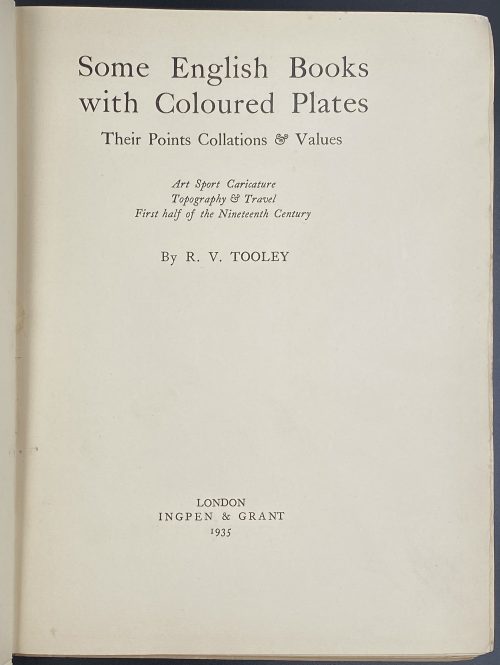 Title: Some English Books | with Coloured Plates | Their Points Collations & Values | Art Sport Caricature | Topography & Travel | First half of the Nineteenth Century | by R. V. Tooley | […] | LONDON | INGPEN & GRANT | 1935 || Pagination: [i-vi] vii-viii, [1] 2-288, Collation: 8vo, π3 A-S8. Size: 26.3 x 20.3 cm Binding: Hardcover, brown polished cloth, bevelled boards, gilt lettering to spine, TMG, other untrimmed.
Title: Some English Books | with Coloured Plates | Their Points Collations & Values | Art Sport Caricature | Topography & Travel | First half of the Nineteenth Century | by R. V. Tooley | […] | LONDON | INGPEN & GRANT | 1935 || Pagination: [i-vi] vii-viii, [1] 2-288, Collation: 8vo, π3 A-S8. Size: 26.3 x 20.3 cm Binding: Hardcover, brown polished cloth, bevelled boards, gilt lettering to spine, TMG, other untrimmed. -
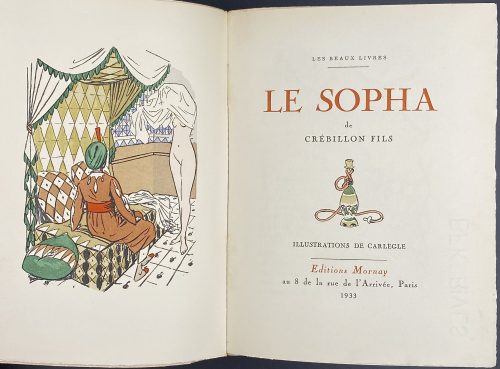 Title: LES BEAUX LIVRES | — | LE SOPHA | de | CRÉBILLON FILS |{vignette}| ILLUSTRATIONS DE CARLÈGLE | — | Éditions Mornay | au 8 de la rue de l’Arrivée, Paris | 1933 || Series: Les beaux livres Binding: Original pictorial wrappers, margins untrimmed, uncut; printed on BFK Rives paper (watermark); the number of copy blacked out. Justification of the print run on p. [329].Pagination: [1-8] 9-326 [327-331], ill., woodcuts in text. Size: 20.2 x 15.5 cm
Title: LES BEAUX LIVRES | — | LE SOPHA | de | CRÉBILLON FILS |{vignette}| ILLUSTRATIONS DE CARLÈGLE | — | Éditions Mornay | au 8 de la rue de l’Arrivée, Paris | 1933 || Series: Les beaux livres Binding: Original pictorial wrappers, margins untrimmed, uncut; printed on BFK Rives paper (watermark); the number of copy blacked out. Justification of the print run on p. [329].Pagination: [1-8] 9-326 [327-331], ill., woodcuts in text. Size: 20.2 x 15.5 cm -
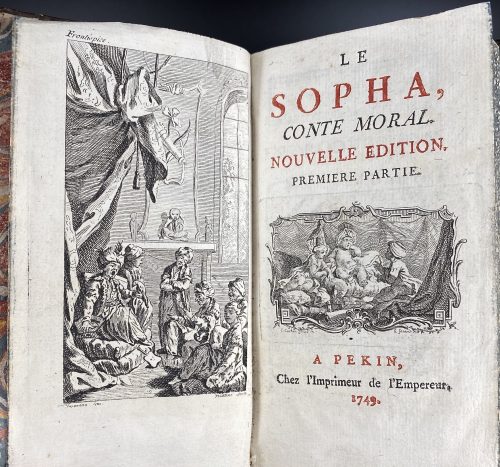 Title-page in black and red: LE | SOPHA, | CONTE MORAL. | NOUVELLE EDITION. | PREMIERE PARTIE. | {vignette} | A PEKIN, | Chez l'imprimeur de l'Empereur, | 1749. || Pagination: Two volumes in one. [2] – blanks, [2] – blank / frontis., [i, ii] – t.p. / blank, [iii] iv-xxi [xxii] ; [1] 2-253, [254-256] – table / blank, [2] – blanks; [i, ii] f.t. (seconde partie). [iii] 4-237 [238-240] – table / blank, [2] – blanks ; ills. 1 frontispiece, 4 plates and 2 vignettes by Pelletier after Clavereau, 2 fleurons by Fessard after Cochin. Collation: 12mo; a12, A8B4–T8V4, X8 [*1]; A8B4–T8V4. Binding: Full mottled calf, flat spine, compartments double-ruled in gilt, gilt flowers and foliage in compartments, crimson title label; marbled endpapers. Printed on laid paper, watermarked. Size: 14.8 x 8.8 cm Catalogue raisonné: Cohen, de Ricci (266); J. Lewine (124-5).
Title-page in black and red: LE | SOPHA, | CONTE MORAL. | NOUVELLE EDITION. | PREMIERE PARTIE. | {vignette} | A PEKIN, | Chez l'imprimeur de l'Empereur, | 1749. || Pagination: Two volumes in one. [2] – blanks, [2] – blank / frontis., [i, ii] – t.p. / blank, [iii] iv-xxi [xxii] ; [1] 2-253, [254-256] – table / blank, [2] – blanks; [i, ii] f.t. (seconde partie). [iii] 4-237 [238-240] – table / blank, [2] – blanks ; ills. 1 frontispiece, 4 plates and 2 vignettes by Pelletier after Clavereau, 2 fleurons by Fessard after Cochin. Collation: 12mo; a12, A8B4–T8V4, X8 [*1]; A8B4–T8V4. Binding: Full mottled calf, flat spine, compartments double-ruled in gilt, gilt flowers and foliage in compartments, crimson title label; marbled endpapers. Printed on laid paper, watermarked. Size: 14.8 x 8.8 cm Catalogue raisonné: Cohen, de Ricci (266); J. Lewine (124-5). -
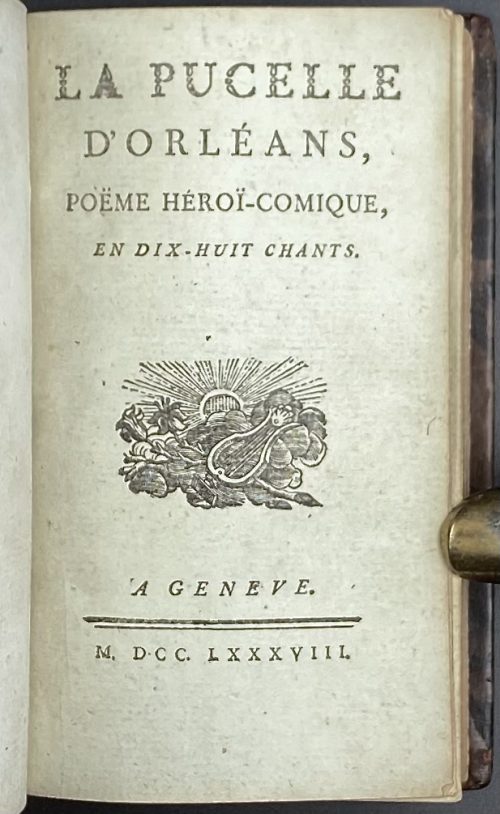 LA PUCELLE | D'ORLÉANS, | POËME HÉROÏ-COMIQUE, | EN DIX-HUIT CHANTS. |{vignette}| A GENEVE. | M. DCC.LXXXVIII.|| Pagination: engraved frontis., engraved portrait, [1, 2] – t.p. / blank, [3] 4-304; plates: engraved frontispiece, engraved portrait of Jeanne d'Arc and 18 engraved plates (the so-called 'suite anglaise' by Marillier, Clément-Pierre (French, 1740 – 1808) after Duflos, Pierre (French, 1742 – 1816). Publisher: Cazin, Hubert-Martin (French, 1724 – 1795). Modern binding to imitate full mottled calf of the 18th century, gilt double-ruled boards, gilt decorated spine with the crimson label “LA PUCELLE”, AEG, laid paper. Size: 13.3 x 8.7 cm; 18mo. Catalogue raisonné: Cohen, De Ricci 1032 (for 1777 and 1780 editions). J. Lewine p.559 (for 1777 16mo and even 12mo editions). The 'correct' 1st thus edition is called suite anglaise because instead of 'chant number' it's printed 'book number' on top of the pages. This copy is definitely a later pirated edition.
LA PUCELLE | D'ORLÉANS, | POËME HÉROÏ-COMIQUE, | EN DIX-HUIT CHANTS. |{vignette}| A GENEVE. | M. DCC.LXXXVIII.|| Pagination: engraved frontis., engraved portrait, [1, 2] – t.p. / blank, [3] 4-304; plates: engraved frontispiece, engraved portrait of Jeanne d'Arc and 18 engraved plates (the so-called 'suite anglaise' by Marillier, Clément-Pierre (French, 1740 – 1808) after Duflos, Pierre (French, 1742 – 1816). Publisher: Cazin, Hubert-Martin (French, 1724 – 1795). Modern binding to imitate full mottled calf of the 18th century, gilt double-ruled boards, gilt decorated spine with the crimson label “LA PUCELLE”, AEG, laid paper. Size: 13.3 x 8.7 cm; 18mo. Catalogue raisonné: Cohen, De Ricci 1032 (for 1777 and 1780 editions). J. Lewine p.559 (for 1777 16mo and even 12mo editions). The 'correct' 1st thus edition is called suite anglaise because instead of 'chant number' it's printed 'book number' on top of the pages. This copy is definitely a later pirated edition. -
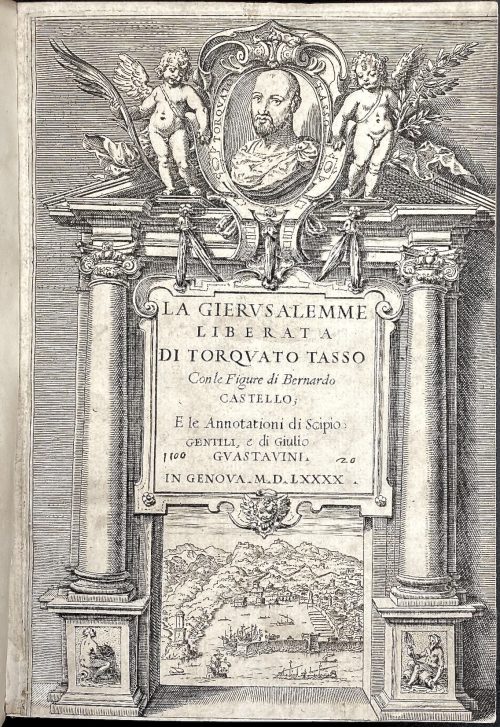 Engraved title with the portrait of Torquato Tasso, displayed in an oval medallion, bound in “TORQUATO TASSO”, between two naked putti; Architecture with two columns and Ionic capitals supporting an architectural pediment; between the columns is a table with the inscription: LA GIERVSALEMME | LIBERATA | DI TORQVATO TASSO | Con le Figure di Bernardo | CASTELLO; | E le Annotazioni di Scipio | GENTILI, e di Giulio | GVASTAVINI. | IN GENOVA. M.D.LXXXX .|| Contents: The 20 cantos are followed by: Tutte le stanza intere, che dall'autore sono state refiutate in questo libro; Annotationi di Scipio Gentili; Luoghi osservati dal mag. Giulio Guastavini, quali il Tasso nella sua Gierusalemme hà presi & imitati da poeti & altri scrittori antichi; Allegoria del poema; Tavola di tutti i nomi proprii et di tutte le materie principali contenute nel presente libro. Pagination: [2] engraved t.p. / blank, 3-11, [1] 2-255 [256], 1-71 [72] [1] 2-40, 4 unpag. leaves ‘Allegoria del poema’; total 387 pp. Collation: 8vo; π6 A-Q8 A-D8 E4 A-B8 χ4 (in the first quire M4 marked L4), ills. signed in collation. At p. 17 canto 3rd marked as 2nd, pp. 135 and 139 in 12th canto marked as 11th. Binding: later full polished calf, blind double-ruled covers, blind double-ruled raised bands, gilt lettering: GIERVSALEMME | LIBERATA and GENOVA | 1590. TMG. Printed on laid paper. Front joints split at head and tail. Title page and twenty full-page ill. facing the opening of each canto, engraved by Agostino Carracci and Giacomo Franco after Castello. Those for cantos 6-8, 10, 12, 16-17, 19-20 are by Carracci, 8 and 19 with his initials. The remainder are by Franco and are signed by him. Woodcut head and tailpieces, the Argomenti at the head of each canto within cartouches, initials. Catalogue raisonné: Adam Bartsch. Le peintre graveur. — Vienne: J. V. Degen, 1803.
Engraved title with the portrait of Torquato Tasso, displayed in an oval medallion, bound in “TORQUATO TASSO”, between two naked putti; Architecture with two columns and Ionic capitals supporting an architectural pediment; between the columns is a table with the inscription: LA GIERVSALEMME | LIBERATA | DI TORQVATO TASSO | Con le Figure di Bernardo | CASTELLO; | E le Annotazioni di Scipio | GENTILI, e di Giulio | GVASTAVINI. | IN GENOVA. M.D.LXXXX .|| Contents: The 20 cantos are followed by: Tutte le stanza intere, che dall'autore sono state refiutate in questo libro; Annotationi di Scipio Gentili; Luoghi osservati dal mag. Giulio Guastavini, quali il Tasso nella sua Gierusalemme hà presi & imitati da poeti & altri scrittori antichi; Allegoria del poema; Tavola di tutti i nomi proprii et di tutte le materie principali contenute nel presente libro. Pagination: [2] engraved t.p. / blank, 3-11, [1] 2-255 [256], 1-71 [72] [1] 2-40, 4 unpag. leaves ‘Allegoria del poema’; total 387 pp. Collation: 8vo; π6 A-Q8 A-D8 E4 A-B8 χ4 (in the first quire M4 marked L4), ills. signed in collation. At p. 17 canto 3rd marked as 2nd, pp. 135 and 139 in 12th canto marked as 11th. Binding: later full polished calf, blind double-ruled covers, blind double-ruled raised bands, gilt lettering: GIERVSALEMME | LIBERATA and GENOVA | 1590. TMG. Printed on laid paper. Front joints split at head and tail. Title page and twenty full-page ill. facing the opening of each canto, engraved by Agostino Carracci and Giacomo Franco after Castello. Those for cantos 6-8, 10, 12, 16-17, 19-20 are by Carracci, 8 and 19 with his initials. The remainder are by Franco and are signed by him. Woodcut head and tailpieces, the Argomenti at the head of each canto within cartouches, initials. Catalogue raisonné: Adam Bartsch. Le peintre graveur. — Vienne: J. V. Degen, 1803.Author: Written by Torquato Tasso (Italian, Sorrento 1544–1595 Rome)
Designer: Illustrations designed by Bernardo Castello (Italian, Genoa (?) 1557–1629 Genoa)
Engraver: Illustrations engraved by Agostino Carracci (Italian, Bologna 1557–1602 Parma)
Engraver: Illustrations engraved by Giacomo Franco (Italian, Venice 1550–1620 Venice)
Publisher: Published by Girolamo Bartoli , Genoa
Ref.: MET, HathiTrust, -
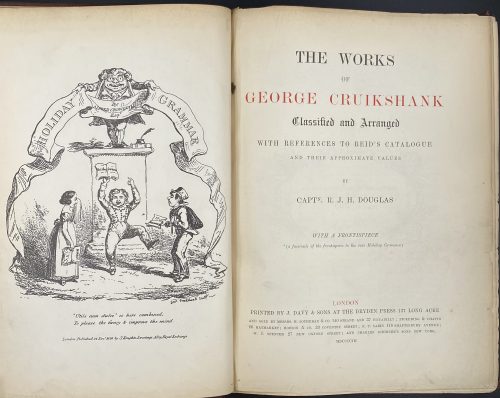 Half-title: THE WORKS | OF | GEORGE CRUIKSHANK | CLASSIFIED AND ARRANGED.|| Title: (in black and red) THE WORKS | OF | GEORGE CRUIKSHANK | CLASSIFIED AND ARRANGED | WITH REFERENCES TO REID'S CATALOGUE | AND THEIR APPROXIMATE VALUES| BY | CAPTN. R. J. H. DOUGLAS | WITH A FRONTISPIECE | (a facsimile of the frontispiece to the rare Holiday Grammar) | LONDON | PRINTED BY J. DAVY & SONS AT THE DRYDEN PRESS 137 LONG ACRE | AND SOLD BY MESSRS. H. SOTHERAN & CO. 140 STRAND AND 37 PICADILLY ; PICKERING & CATTO | 66 HAYMARKET ; ROBSON & CO 23 COVENTRY STREET ; F. T. SABIN 118 SHAFTESBURY AVENUE ; | W. T. SPENSER 27 NEW OXFORD STREET ; AND CHARLES SCRIBNER’S SONS NEW YORK. | MDCCCCIII || Imprint (title verso): One Thousand Copies of this book have been printed and the type distributed. This is No. 205. Bookplate to recto ffl: Reference Library of Francis Edwards Ltd. Not for sale. Inscription to recto ffl: “With the author’s compliments”. Pagination: ffl, [i, ii] – h.t. / blank, [2] – blank / frontis., [iii, iv] – t.p. (black and red) / Print run, [v] v-vi –preface, [2] – contents, [2] – f.t. / note; [1] 2-301 [302] – colophon; insert one sheet with type writing on Francis Edwards letterhead, bfl. (OCLC: ix, 302 pages : illustrations ; 26 cm) Collation: [A]5 B-T8 U7 Binding: Hardcover, burgundy cloth gilt-stamped with title and publisher’s device to front board and gilt lettering to spine.
Half-title: THE WORKS | OF | GEORGE CRUIKSHANK | CLASSIFIED AND ARRANGED.|| Title: (in black and red) THE WORKS | OF | GEORGE CRUIKSHANK | CLASSIFIED AND ARRANGED | WITH REFERENCES TO REID'S CATALOGUE | AND THEIR APPROXIMATE VALUES| BY | CAPTN. R. J. H. DOUGLAS | WITH A FRONTISPIECE | (a facsimile of the frontispiece to the rare Holiday Grammar) | LONDON | PRINTED BY J. DAVY & SONS AT THE DRYDEN PRESS 137 LONG ACRE | AND SOLD BY MESSRS. H. SOTHERAN & CO. 140 STRAND AND 37 PICADILLY ; PICKERING & CATTO | 66 HAYMARKET ; ROBSON & CO 23 COVENTRY STREET ; F. T. SABIN 118 SHAFTESBURY AVENUE ; | W. T. SPENSER 27 NEW OXFORD STREET ; AND CHARLES SCRIBNER’S SONS NEW YORK. | MDCCCCIII || Imprint (title verso): One Thousand Copies of this book have been printed and the type distributed. This is No. 205. Bookplate to recto ffl: Reference Library of Francis Edwards Ltd. Not for sale. Inscription to recto ffl: “With the author’s compliments”. Pagination: ffl, [i, ii] – h.t. / blank, [2] – blank / frontis., [iii, iv] – t.p. (black and red) / Print run, [v] v-vi –preface, [2] – contents, [2] – f.t. / note; [1] 2-301 [302] – colophon; insert one sheet with type writing on Francis Edwards letterhead, bfl. (OCLC: ix, 302 pages : illustrations ; 26 cm) Collation: [A]5 B-T8 U7 Binding: Hardcover, burgundy cloth gilt-stamped with title and publisher’s device to front board and gilt lettering to spine. -
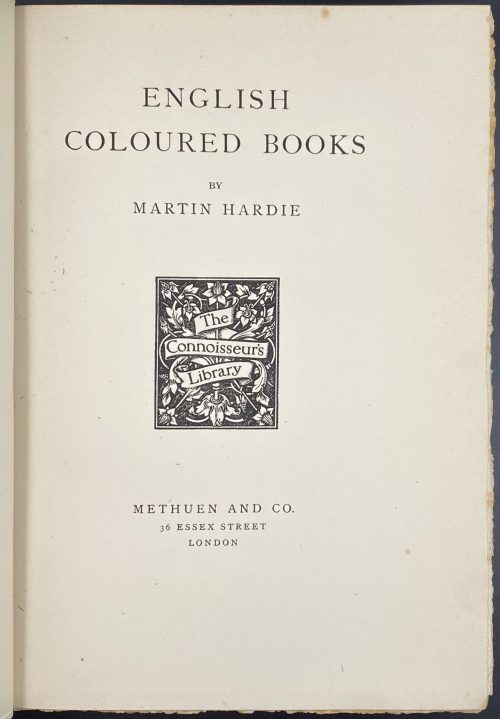 Half-title: THE CONNOISSEURS LIBRARY | GENERAL EDITOR : CYRIL DAVENPORT | […] | ENGLISH COLOURED BOOKS || Title: ENGLISH | COLOURED BOOKS | BY | MARTIN HARDIE | [device: THE CONNOISSEURS LIBRARY] | METHUEN AND CO. | 36 ESSEX STREET | LONDON || Dedication: TO MY WIFE | LOVE’S LABOUR : LOVE’S GIFT Pagination: ffl [i, ii] – h.t. / blank, [2] – blank / frontis. In colour, [iii, iv] – t.p. / First Published in 1906, [v, vi] – dedication / blank, vii-xxiv; 1-339 [340] bfl; 27 sheets of plates, colour and b/w. Collation: 8vo; a8 b4 A-X8 Y2. Binding: Hardcover, 26.3 x 19 x 5.7 cm; red cloth, blind-stamped with repeated fleuron, gilt floral designs and lettering in the frame to front cover, elaborate gilt floral design and lettering to spine; top margin gilt, other untrimmed, some pages uncut; plates w/guards. Printed on laid paper. Printed in Scotland by T. and A. Constable, at the Edinburgh university press. Contributors: Martin Hardie (British, 1875 – 1952) – Author Cyril Davenport (British, 1848 – 1941) – Editor of the series Sir Algernon Methuen (British, 1856 – 1924) – Publisher Thomas Constable (British, 1812 – 1881); Archibald Constable (British, 1774 – 1827) – Founders of the Publishing House "T. and A. Constable".
Half-title: THE CONNOISSEURS LIBRARY | GENERAL EDITOR : CYRIL DAVENPORT | […] | ENGLISH COLOURED BOOKS || Title: ENGLISH | COLOURED BOOKS | BY | MARTIN HARDIE | [device: THE CONNOISSEURS LIBRARY] | METHUEN AND CO. | 36 ESSEX STREET | LONDON || Dedication: TO MY WIFE | LOVE’S LABOUR : LOVE’S GIFT Pagination: ffl [i, ii] – h.t. / blank, [2] – blank / frontis. In colour, [iii, iv] – t.p. / First Published in 1906, [v, vi] – dedication / blank, vii-xxiv; 1-339 [340] bfl; 27 sheets of plates, colour and b/w. Collation: 8vo; a8 b4 A-X8 Y2. Binding: Hardcover, 26.3 x 19 x 5.7 cm; red cloth, blind-stamped with repeated fleuron, gilt floral designs and lettering in the frame to front cover, elaborate gilt floral design and lettering to spine; top margin gilt, other untrimmed, some pages uncut; plates w/guards. Printed on laid paper. Printed in Scotland by T. and A. Constable, at the Edinburgh university press. Contributors: Martin Hardie (British, 1875 – 1952) – Author Cyril Davenport (British, 1848 – 1941) – Editor of the series Sir Algernon Methuen (British, 1856 – 1924) – Publisher Thomas Constable (British, 1812 – 1881); Archibald Constable (British, 1774 – 1827) – Founders of the Publishing House "T. and A. Constable". -
![[RASPE, Rudolf Erich]. The Travels and Surprising Adventures of Baron Munchausen. / Illustrated with 37 curious engravings, from the Baron's own designs, and five woodcuts, by G. Cruikshank. — London: William Tegg, 1869. — xii + [10] + 268 pp.](https://varshavskycollection.com/wp-content/uploads/2021/02/LIB-2269.2019-5-500x466.jpeg) Half-title: BARON MUNCHAUSEN Title: THE TRAVELS | AND | SURPRISING ADVENTURES | OF | BARON MUNCHAUSEN. | ILLUSTRATED WITH | THIRTY-SEVEN CURIOUS ENGRAVINGS, | FROM | THE BARON'S OWN DESIGNS, | AND FIVE WOODCUTS, | BY G. CRUIKSHANK. | [device] | LONDON : WILLIAM TEGG. | 1869.|| [RASPE, Rudolf Erich]. The Travels and Surprising Adventures of Baron Munchausen. / Illustrated with 37 curious engravings, from the Baron's own designs, and five woodcuts, by G. Cruikshank. — London: William Tegg, 1869. Pagination: xii + [10] + 268 pp, 23 plates: hand-coloured engraved frontispiece, 5 woodcuts by Cruikshank, other b/w etchings, two folding plates. Binding: 19 x 13 cm; hardbound, 8vo, early 20th century 3/4 dark plum morocco gilt-ruled, raised bands, title label, gilt lettering, gilt in compartments, top edge gilt. Catalogue raisonné: A. Cohn: #584, p. 172. This edition is an identical re-issue of the 1867 edition.
Half-title: BARON MUNCHAUSEN Title: THE TRAVELS | AND | SURPRISING ADVENTURES | OF | BARON MUNCHAUSEN. | ILLUSTRATED WITH | THIRTY-SEVEN CURIOUS ENGRAVINGS, | FROM | THE BARON'S OWN DESIGNS, | AND FIVE WOODCUTS, | BY G. CRUIKSHANK. | [device] | LONDON : WILLIAM TEGG. | 1869.|| [RASPE, Rudolf Erich]. The Travels and Surprising Adventures of Baron Munchausen. / Illustrated with 37 curious engravings, from the Baron's own designs, and five woodcuts, by G. Cruikshank. — London: William Tegg, 1869. Pagination: xii + [10] + 268 pp, 23 plates: hand-coloured engraved frontispiece, 5 woodcuts by Cruikshank, other b/w etchings, two folding plates. Binding: 19 x 13 cm; hardbound, 8vo, early 20th century 3/4 dark plum morocco gilt-ruled, raised bands, title label, gilt lettering, gilt in compartments, top edge gilt. Catalogue raisonné: A. Cohn: #584, p. 172. This edition is an identical re-issue of the 1867 edition. -
![[ROSCOE, Thomas, translator]. Tales of Humour, Gallantry, & Romance, selected and translated from the Italian. With sixteen illustrative Drawings by George Cruikshank. London, Printed for Charles Baldwyn, 1827.](https://varshavskycollection.com/wp-content/uploads/2021/02/LIB-1079-2-500x839.jpg) Title: TALES | OF | Humour, Gallantry, & Romance, | SELECTED AND TRANSLATED | FROM THE ITALIAN. | Vignette "The Elopement, p. 183" | With sixteen illustrative Drawings by George Cruikshank. | — | LONDON : | PRINTED FOR CHARLES BALDWYN, | NEWGATE STREET. | MDCCCXXVII. Pagination: [2], [v]-vi [2] – Contents (Cohn's collation calls for this at the end) 3-253, [1]; title-page a cancel with vignette 'The Elopment', sixteen other plates by Cruikshank; as per HathiTrust: vi, 253, [3] p. (last p. blank), [16] leaves of plates: ill. Binding: 8vo, 20 x 13 cm, later polished calf, gilt, t.e.g. others untrimmed, by Rivière for H. Sotheran. Note: 1st edition, very rare 3rd issue, with a cancel title-page replacing that of 1824 issue when there were two issues and the work was entitled Italian Tales. Cohn notes the rarity of the 1827 edition, which restores one of the plates 'The Dead Rider', suppressed in the second issue, and also includes the plate done to replace it. "The rarest edition of this work is that published in 1827 in green paper boards [...]. This issue has no edition stated on the title. It has seventeen woodcuts, inclusive of the "Elopement" vignette upon the title. The suppressed plate "The Dear Rider" is restored, and the plate done to replace it is also included. The woodcut in other editions upon the title page is "The Pomegranate Seed". Probably compiled and translated by Thomas Roscoe (cf. National union catalog) from a variety of authors 'out of materials not generally accessible', but also ascribed to J. Y. Akerman and to one "Southern". Two or three tales that furnished plots for Shakespeare. Catalogue Raisonné: Cohn 444; this issue not found in OCLC or COPAC.
Title: TALES | OF | Humour, Gallantry, & Romance, | SELECTED AND TRANSLATED | FROM THE ITALIAN. | Vignette "The Elopement, p. 183" | With sixteen illustrative Drawings by George Cruikshank. | — | LONDON : | PRINTED FOR CHARLES BALDWYN, | NEWGATE STREET. | MDCCCXXVII. Pagination: [2], [v]-vi [2] – Contents (Cohn's collation calls for this at the end) 3-253, [1]; title-page a cancel with vignette 'The Elopment', sixteen other plates by Cruikshank; as per HathiTrust: vi, 253, [3] p. (last p. blank), [16] leaves of plates: ill. Binding: 8vo, 20 x 13 cm, later polished calf, gilt, t.e.g. others untrimmed, by Rivière for H. Sotheran. Note: 1st edition, very rare 3rd issue, with a cancel title-page replacing that of 1824 issue when there were two issues and the work was entitled Italian Tales. Cohn notes the rarity of the 1827 edition, which restores one of the plates 'The Dead Rider', suppressed in the second issue, and also includes the plate done to replace it. "The rarest edition of this work is that published in 1827 in green paper boards [...]. This issue has no edition stated on the title. It has seventeen woodcuts, inclusive of the "Elopement" vignette upon the title. The suppressed plate "The Dear Rider" is restored, and the plate done to replace it is also included. The woodcut in other editions upon the title page is "The Pomegranate Seed". Probably compiled and translated by Thomas Roscoe (cf. National union catalog) from a variety of authors 'out of materials not generally accessible', but also ascribed to J. Y. Akerman and to one "Southern". Two or three tales that furnished plots for Shakespeare. Catalogue Raisonné: Cohn 444; this issue not found in OCLC or COPAC. -
![George Cruikshank's omnibus / edited by Laman Blanchard. – London : Tilt and Bogue, 1842. – [2], vi, [2], [2] 300 p., [22] leaves of plates : ill's.](https://varshavskycollection.com/wp-content/uploads/2021/02/LIB-2558.2020-6-500x520.jpeg) Title: GEORGE CRUIKSHANK'S | OMNIBUS. | ILLUSTRATED WITH ONE HUNDRED ENGRAVINGS ON STEEL | AND WOOD. | "De omnibus rebus et quibusdam aliis." | EDITED BY LAMAN BLANCHARD, ESQ. | LONDON : | TILT AND BOGUE, FLEET STREET. | MDCCCXLII. Pagination: ffl, [2] – blanks [i, ii] – blank / engraved t.p. w/guard, [iii, iv] – t.p., colophon] [v], vi – contents, [vii, viii] – h.t. / blank, [ix] – list of etchings on steel, [x] – list of wood-cuts, [2] – blank, frontis. engraves portrait of G. Cruikshank; [1] 2-300 [2] – blanks, bfl; 22 full-page steel engravings (three not by Cruikshank) and 78 woodcuts. As per A. M. Cohn: i-ii+i-viii+1-2+1-300. Binding: 24 x 14 cm, later full red morocco by Kelly and Sons with gilt and embossed designs to covers, designs, title and year lettering to spine, facsimile in gilt of Cruikshank's signature to front cover, gilt line to inner edges, top edge gilt, marbled endpapers. Armorial bookplate of Harold A. Wernher of Luton Hoo to front pastedown. Major-General Sir Harold Augustus Wernher (1893 – 1973) – British military officer. Originally bound in green, then red cloth, this binding by Kelly and Sons (Packer, Maurice. Bookbinders of Victorian London. London: British Library, 1991 page 84). A. M. Cohn № 190, p. 65-66. Motto translation: (About all things and something more besides).
Title: GEORGE CRUIKSHANK'S | OMNIBUS. | ILLUSTRATED WITH ONE HUNDRED ENGRAVINGS ON STEEL | AND WOOD. | "De omnibus rebus et quibusdam aliis." | EDITED BY LAMAN BLANCHARD, ESQ. | LONDON : | TILT AND BOGUE, FLEET STREET. | MDCCCXLII. Pagination: ffl, [2] – blanks [i, ii] – blank / engraved t.p. w/guard, [iii, iv] – t.p., colophon] [v], vi – contents, [vii, viii] – h.t. / blank, [ix] – list of etchings on steel, [x] – list of wood-cuts, [2] – blank, frontis. engraves portrait of G. Cruikshank; [1] 2-300 [2] – blanks, bfl; 22 full-page steel engravings (three not by Cruikshank) and 78 woodcuts. As per A. M. Cohn: i-ii+i-viii+1-2+1-300. Binding: 24 x 14 cm, later full red morocco by Kelly and Sons with gilt and embossed designs to covers, designs, title and year lettering to spine, facsimile in gilt of Cruikshank's signature to front cover, gilt line to inner edges, top edge gilt, marbled endpapers. Armorial bookplate of Harold A. Wernher of Luton Hoo to front pastedown. Major-General Sir Harold Augustus Wernher (1893 – 1973) – British military officer. Originally bound in green, then red cloth, this binding by Kelly and Sons (Packer, Maurice. Bookbinders of Victorian London. London: British Library, 1991 page 84). A. M. Cohn № 190, p. 65-66. Motto translation: (About all things and something more besides). -
![George Cruikshank's table-book / edited by Gilbert Abbott à Beckett. – London: Punch office, 1845. – viii, 284 p., [12] leaves of plates : ill's.](https://varshavskycollection.com/wp-content/uploads/2021/02/LIB-2557.2020-5-500x722.jpeg) Title: GEORGE CRUIKSHANK'S | TABLE-BOOK. | EDITED BY | GILBERT ABBOTT À BECKETT. | ILLUSTRATED BY GEORGE CRUIKSHANK. | LONDON : | PUBLISHED AT THE PUNCH OFFICE, 92, FLEET STREET ; | AND SOLD BY ALL BOOKSELLERS. | MDCCCXLV.|| Pagination: ffl [2 blanks] [i, ii - engaved t.p. w/guard, verso blank] [iii], iv - letterpress t.p., colophon] [v], vi - list of engravings on still and on wood, [vii] viii - contents [2 - blank, engraved frontispiece] [1] 2-284 [2 blanks] bfl; 12 full-page steel etchings and 116 woodcuts and glyphographs by G. Cruikshank. Binding: Hardcover, 4to, 24.4 x 17 cm, later full red morocco by Kelly and Sons with gilt and embossed designs to covers, designs, title and year lettering to spine, facsimile in gilt of Cruikshank's signature to front cover, gilt line to inner edges, top edge gilt, marbled endpapers. Armorial bookplate of Harold A. Wernher of Luton Hoo to front pastedown. Major-General Sir Harold Augustus Wernher (1893 – 1973) – British military officer. Originally bound in red cloth, this binding by Kelly and Sons (Packer, Maurice. Bookbinders of Victorian London. — London: British Library, 1991 page 84). Title without the bottom section with lettering, on top lacking the 'Price one shilling', № 1, Vol. 1. inscriptions. Catalogue raisonné: A. M. Cohn № 191, p. 66-67.
Title: GEORGE CRUIKSHANK'S | TABLE-BOOK. | EDITED BY | GILBERT ABBOTT À BECKETT. | ILLUSTRATED BY GEORGE CRUIKSHANK. | LONDON : | PUBLISHED AT THE PUNCH OFFICE, 92, FLEET STREET ; | AND SOLD BY ALL BOOKSELLERS. | MDCCCXLV.|| Pagination: ffl [2 blanks] [i, ii - engaved t.p. w/guard, verso blank] [iii], iv - letterpress t.p., colophon] [v], vi - list of engravings on still and on wood, [vii] viii - contents [2 - blank, engraved frontispiece] [1] 2-284 [2 blanks] bfl; 12 full-page steel etchings and 116 woodcuts and glyphographs by G. Cruikshank. Binding: Hardcover, 4to, 24.4 x 17 cm, later full red morocco by Kelly and Sons with gilt and embossed designs to covers, designs, title and year lettering to spine, facsimile in gilt of Cruikshank's signature to front cover, gilt line to inner edges, top edge gilt, marbled endpapers. Armorial bookplate of Harold A. Wernher of Luton Hoo to front pastedown. Major-General Sir Harold Augustus Wernher (1893 – 1973) – British military officer. Originally bound in red cloth, this binding by Kelly and Sons (Packer, Maurice. Bookbinders of Victorian London. — London: British Library, 1991 page 84). Title without the bottom section with lettering, on top lacking the 'Price one shilling', № 1, Vol. 1. inscriptions. Catalogue raisonné: A. M. Cohn № 191, p. 66-67. -
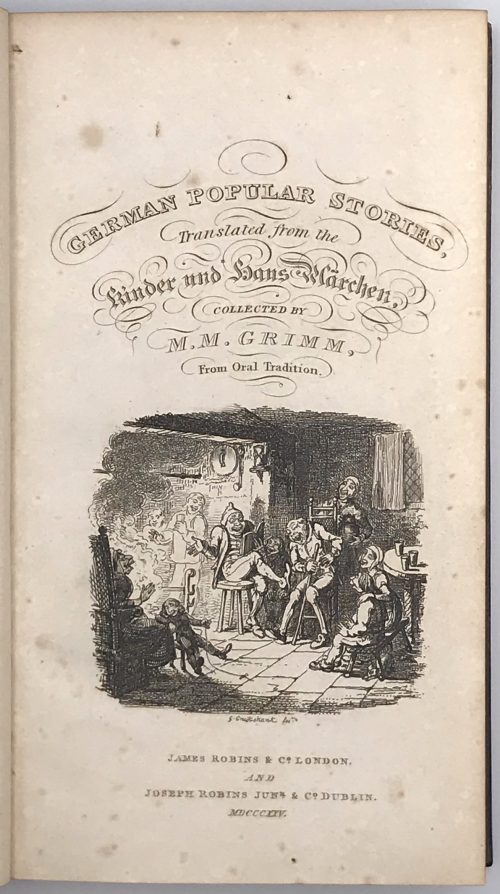 A two-volume set. Volume 1: GERMAN POPULAR STORIES | translated from the | Kinder und Haus Märchen, | COLLECTED BY | M. M. GRIMM, | from oral tradition. | [Vignette] | JAMES ROBINS & Co. LONDON. |AND | JOSEPH ROBINS JUNR & Co. DUBLIN. | MDCCCXXV.|| 12mo, pp. xii, 240; engraved title vignette and 11 plates by George Cruikshank, with a fine proof (?) of the plate illustrating ‘The Jew in the bush’ on India paper laid onto verso of leaf bound between half-title and title. Table of contents: Hans in luck -- The travelling musicians -- The golden bird -- The fisherman and his wife -- The tom-tit and the bear -- The twelve dancing princesses -- Rose-bud -- Tom thumb -- The grateful beasts -- Jorinda and Jorindel -- The waggish musician -- The queen bee -- The dog and the sparrow -- Frederick and Catherine -- The three children of fortune -- King grisly-beard -- The adventures of chanticleer and partlet -- Snow-drop -- The elves and the shoemaker -- The turnip -- Old sultan -- The lady and the lion -- The jew in the bush -- The king of the golden mountain -- The golden goose -- Mrs. fox -- Hansel and Grettel -- The giant with the three golden hairs -- The frog prince -- The fox and the horse -- Rumpel-stilts-kin.; Volume 2: GERMAN POPULAR STORIES | translated from the | Kinder und Haus Märchen, | COLLECTED BY | M. M. GRIMM, | from oral tradition. | [Vignette] | JAMES ROBINS & Co. LONDON. |AND | JOSEPH ROBINS JUNR & Co. DUBLIN. | MDCCCXXVI.|| 12mo, iv, 256, [2]; engraved title vignette and 9 plates by George Cruikshank. Table of contents: The goose-girl -- Faithful John -- The blue light -- Ashputtel -- The young giant and the tailor -- The crows and the soldier -- Pee-wit -- Hans and his wife Grettel -- Cherry, or the frog-bride -- Mother Holle -- The water of life -- Peter the goatherd -- The four clever brothers -- The elfin-grove -- The salad -- The nose -- The five servants -- Cat-skin -- The robber-bridegroom -- The three sluggards -- The seven ravens -- Roland and may-bird -- The mouse, the bird, and the sausage -- The juniper tree. Binding: bound without advertisements in 19th-century brown morocco by Leighton, spines decorated and lettered in gilt, gilt edges, marbled endpapers; armorial bookplates of Thomas Gaisford and Charles Tennant to endpapers. Note: The third edition of vol. 1 (first C. Baldwyn 1823) and the first edition of vol. 2 of the first English translation of Grimm’s Fairy Tales – including Tom Thumb, the Elves and the Shoemaker, Hansel and Grettel, the Frog Prince, and Rumpelstiltskin – with George Cruikshank’s celebrated illustrations. Of Cruikshank’s work, Ruskin remarked, ‘The etchings are the finest things, next to Rembrandt’s, that, as far as I know, has been done since etching was invented. You cannot look at them too much, nor copy them too often’ (The Elements of Drawing, 1857). Provenance: (1) Thomas Gaisford (1779-1855), classical scholar, Regius Professor of Greek at Oxford University, Dean of Christ Church, curator of the Bodleian Library and delegate of the Clarendon Press. (2) Sir Charles Tennant, 1st Baronet (1823-1906), a Scottish industrialist who amassed a notable library and collection of pictures at his Peeblesshire estate, ‘The Glen’. Catalogue raisonné: Albert M. Cohn 369.
A two-volume set. Volume 1: GERMAN POPULAR STORIES | translated from the | Kinder und Haus Märchen, | COLLECTED BY | M. M. GRIMM, | from oral tradition. | [Vignette] | JAMES ROBINS & Co. LONDON. |AND | JOSEPH ROBINS JUNR & Co. DUBLIN. | MDCCCXXV.|| 12mo, pp. xii, 240; engraved title vignette and 11 plates by George Cruikshank, with a fine proof (?) of the plate illustrating ‘The Jew in the bush’ on India paper laid onto verso of leaf bound between half-title and title. Table of contents: Hans in luck -- The travelling musicians -- The golden bird -- The fisherman and his wife -- The tom-tit and the bear -- The twelve dancing princesses -- Rose-bud -- Tom thumb -- The grateful beasts -- Jorinda and Jorindel -- The waggish musician -- The queen bee -- The dog and the sparrow -- Frederick and Catherine -- The three children of fortune -- King grisly-beard -- The adventures of chanticleer and partlet -- Snow-drop -- The elves and the shoemaker -- The turnip -- Old sultan -- The lady and the lion -- The jew in the bush -- The king of the golden mountain -- The golden goose -- Mrs. fox -- Hansel and Grettel -- The giant with the three golden hairs -- The frog prince -- The fox and the horse -- Rumpel-stilts-kin.; Volume 2: GERMAN POPULAR STORIES | translated from the | Kinder und Haus Märchen, | COLLECTED BY | M. M. GRIMM, | from oral tradition. | [Vignette] | JAMES ROBINS & Co. LONDON. |AND | JOSEPH ROBINS JUNR & Co. DUBLIN. | MDCCCXXVI.|| 12mo, iv, 256, [2]; engraved title vignette and 9 plates by George Cruikshank. Table of contents: The goose-girl -- Faithful John -- The blue light -- Ashputtel -- The young giant and the tailor -- The crows and the soldier -- Pee-wit -- Hans and his wife Grettel -- Cherry, or the frog-bride -- Mother Holle -- The water of life -- Peter the goatherd -- The four clever brothers -- The elfin-grove -- The salad -- The nose -- The five servants -- Cat-skin -- The robber-bridegroom -- The three sluggards -- The seven ravens -- Roland and may-bird -- The mouse, the bird, and the sausage -- The juniper tree. Binding: bound without advertisements in 19th-century brown morocco by Leighton, spines decorated and lettered in gilt, gilt edges, marbled endpapers; armorial bookplates of Thomas Gaisford and Charles Tennant to endpapers. Note: The third edition of vol. 1 (first C. Baldwyn 1823) and the first edition of vol. 2 of the first English translation of Grimm’s Fairy Tales – including Tom Thumb, the Elves and the Shoemaker, Hansel and Grettel, the Frog Prince, and Rumpelstiltskin – with George Cruikshank’s celebrated illustrations. Of Cruikshank’s work, Ruskin remarked, ‘The etchings are the finest things, next to Rembrandt’s, that, as far as I know, has been done since etching was invented. You cannot look at them too much, nor copy them too often’ (The Elements of Drawing, 1857). Provenance: (1) Thomas Gaisford (1779-1855), classical scholar, Regius Professor of Greek at Oxford University, Dean of Christ Church, curator of the Bodleian Library and delegate of the Clarendon Press. (2) Sir Charles Tennant, 1st Baronet (1823-1906), a Scottish industrialist who amassed a notable library and collection of pictures at his Peeblesshire estate, ‘The Glen’. Catalogue raisonné: Albert M. Cohn 369. -
![George Cruikshank. George Cruikshank's Fairy Library. Hop-O'-My Thumb. Jack and the Bean-Stalk. Cinderella. Puss in Boots. — London: George Bell and Sons, 1885. — pp.: [2] blank, [2] first half-title with blank verso, [i-ii] second half-title with blank verso, [2] frontispiece plate with blank recto, [iii-viii] title, colophone, editor's note, list of illustr. [2] title with blank verso, [1] 2-101 [3] blank, 24 plates with protective tissue, unpag. — Colophon: This edition is limited to 500 copies, with India paper impressions. The former editions have been from lithographic transfers. The plates were retouched under Mr. Cruikshank's direction shortly before his death, and have not been used since until now.](https://varshavskycollection.com/wp-content/uploads/2021/02/LIB-2454.2020-f-1-500x659.jpeg) Title: GEORGE CRUIKSHANK'S FAIRY LIBRARY. | HOP-O'-MY THUMB. | JACK AND THE BEAN-STALK. | CINDERELLA. | PUSS IN BOOTS. | [DEVICE] | LONDON: | GEORGE BELL AND SONS, YORK STREET, COVENT GARDEN. Pagination: [2] – blanks, [2] – first half-title with blank verso, [i-ii] – second half-title with blank verso, [2] – blank / frontispiece, [iii-viii] title, colophon, editor's note, list of illustrations, [2] – title with blank verso, [1] 2-101 [3] – blank; 24 plates with protective tissue. Colophon: This edition is limited to 500 copies, with India paper impressions. The former editions have been from lithographic transfers. The plates were retouched under Mr. Cruikshank's direction shortly before his death, and have not been used since until now. Binding: 4to, 22.2 x 17.5 cm, hardcover; 3/4 black calf ruled in gilt, brown calf spine with raised bands decorated in gilt, with gilt title lettering. Green marbled boards and end-papers. Abel E. Berland's bookplate pasted to front pastedown. Professionally rebound, re-backed with the original spine laid down, corners bumped. Catalogue Raisonné: Not in Alan M. Cohen's. As writes the British Library: "George Cruikshank’s [...] illustrations for the first English translation of Grimm’s Fairy Tales were praised widely, but his own rewriting of fairytales was criticised, most prominently by Charles Dickens. This was not due to the quality of the illustrations, but because, in line with his temperance beliefs, Cruikshank rewrote aspects of the fairytales to warn the reader against the evils of alcohol. Thus, for instance, the preparations for Cinderella’s marriage include the court throwing all alcohol in the palace on a bonfire; and in ‘Jack and the Beanstalk’, the giant is an alcoholic. Dickens, a friend of Cruikshank, was outraged at what he considered to be a betrayal of the essence of fairytales and, in protest, he published an essay in his weekly magazine Household Words entitled ‘Frauds on the Fairies’ in protest (1853)."
Title: GEORGE CRUIKSHANK'S FAIRY LIBRARY. | HOP-O'-MY THUMB. | JACK AND THE BEAN-STALK. | CINDERELLA. | PUSS IN BOOTS. | [DEVICE] | LONDON: | GEORGE BELL AND SONS, YORK STREET, COVENT GARDEN. Pagination: [2] – blanks, [2] – first half-title with blank verso, [i-ii] – second half-title with blank verso, [2] – blank / frontispiece, [iii-viii] title, colophon, editor's note, list of illustrations, [2] – title with blank verso, [1] 2-101 [3] – blank; 24 plates with protective tissue. Colophon: This edition is limited to 500 copies, with India paper impressions. The former editions have been from lithographic transfers. The plates were retouched under Mr. Cruikshank's direction shortly before his death, and have not been used since until now. Binding: 4to, 22.2 x 17.5 cm, hardcover; 3/4 black calf ruled in gilt, brown calf spine with raised bands decorated in gilt, with gilt title lettering. Green marbled boards and end-papers. Abel E. Berland's bookplate pasted to front pastedown. Professionally rebound, re-backed with the original spine laid down, corners bumped. Catalogue Raisonné: Not in Alan M. Cohen's. As writes the British Library: "George Cruikshank’s [...] illustrations for the first English translation of Grimm’s Fairy Tales were praised widely, but his own rewriting of fairytales was criticised, most prominently by Charles Dickens. This was not due to the quality of the illustrations, but because, in line with his temperance beliefs, Cruikshank rewrote aspects of the fairytales to warn the reader against the evils of alcohol. Thus, for instance, the preparations for Cinderella’s marriage include the court throwing all alcohol in the palace on a bonfire; and in ‘Jack and the Beanstalk’, the giant is an alcoholic. Dickens, a friend of Cruikshank, was outraged at what he considered to be a betrayal of the essence of fairytales and, in protest, he published an essay in his weekly magazine Household Words entitled ‘Frauds on the Fairies’ in protest (1853)." -
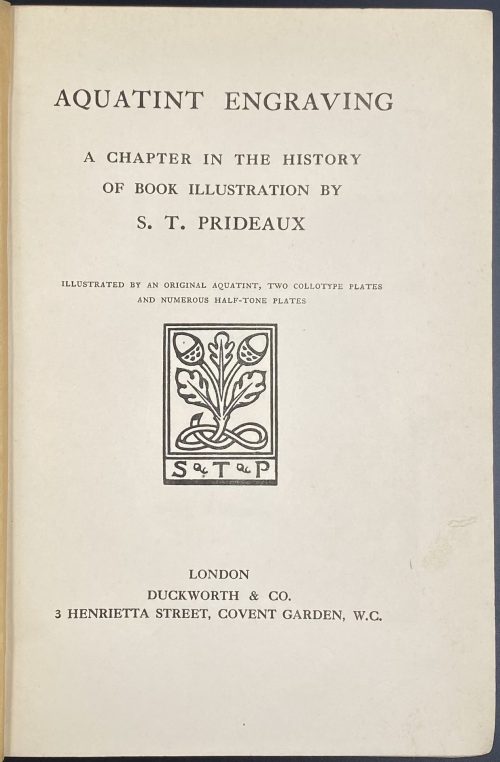 Half-title: AQUATINT ENGRAVING || Title: AQUATINT ENGRAVING | A CHAPTER IN THE HISTORY | OF BOOK ILLUSTRATION BY | S. T. PRIDEAUX | ILLUSTRATED BY AN ORIGINAL AQUATINT, TWO COLLOTYPE PLATES | AND NUMEROUS HALF-TONE PLATES | [Prideaux device] | LONDON | DUCKWORTH & CO. | 3 HENRIETTA STREET, COVENT GARDEN, W.C. || Pagination: ffl, [i, ii] – h.t. / blank, [2] – blank / frontis. w/guard, [iii, iv] – t.p. / coloph. "First Published, December 1909", [v, vi] – dedication "TO MY FATHER" / blank, vii-xv [xvi], [1] 2-434, bfl, + 24 pl. (incl. port). Collation: [a]6 b8 A-Z8 2A-2C8 2D4 Binding: Original navy cloth, gilt-ruled and lettered front board, gilt lettering to spine, a blind device to back board; upper margin gilt, free margin untrimmed. Author: Sarah Prideaux. "Engravers and the books they illustrated": p. 388-405. "Publications by Ackermann with aquatint plates": p. 374-378. "Biographical notices of engravers whose names appear on the plates": p. 358-371. "Books published before 1830 with aquatint plates": p. 325-357.
Half-title: AQUATINT ENGRAVING || Title: AQUATINT ENGRAVING | A CHAPTER IN THE HISTORY | OF BOOK ILLUSTRATION BY | S. T. PRIDEAUX | ILLUSTRATED BY AN ORIGINAL AQUATINT, TWO COLLOTYPE PLATES | AND NUMEROUS HALF-TONE PLATES | [Prideaux device] | LONDON | DUCKWORTH & CO. | 3 HENRIETTA STREET, COVENT GARDEN, W.C. || Pagination: ffl, [i, ii] – h.t. / blank, [2] – blank / frontis. w/guard, [iii, iv] – t.p. / coloph. "First Published, December 1909", [v, vi] – dedication "TO MY FATHER" / blank, vii-xv [xvi], [1] 2-434, bfl, + 24 pl. (incl. port). Collation: [a]6 b8 A-Z8 2A-2C8 2D4 Binding: Original navy cloth, gilt-ruled and lettered front board, gilt lettering to spine, a blind device to back board; upper margin gilt, free margin untrimmed. Author: Sarah Prideaux. "Engravers and the books they illustrated": p. 388-405. "Publications by Ackermann with aquatint plates": p. 374-378. "Biographical notices of engravers whose names appear on the plates": p. 358-371. "Books published before 1830 with aquatint plates": p. 325-357. -
![[Barham, Richard Harris]. The Ingoldsby Legends or Mirth and Marvels by Thomas Ingoldsby, esquire / First, Second and Third Series - 3 volumes; Illustr.: George Cruikshank and John Leech. — London: Richard Bentley, 1840-1847. — Vol. 1: Printed by London: Samuel Bentley, 1840. pp.: ff, [2 blank] [i ht] [ii colophon] [title, verso blank] [iii] iv-v [vi blank] [contents, list of ill.] [blank, etching on verso] [1] 2-338 [339] [7, incl. orig. FC and Sp.] bf, 6 plates: 1 by Buss, 3 by Leech, 2 by Cruikshank. — Vol. 2: Printed by London: S. & J. Bentley, Wilson, and Fley, 1842. pp.: ff, [2 blank] [i ht] [ii colophon] [title, verso blank] [v] vi-vii [viii blank] [contents, verso blank] [blank, etching on verso] [1] 2-288 [6, incl. orig. FC and Sp.] bf, 7 plates: 3 by Leech, 4 by Cruikshank. — Vol. 3: Printed by London: S. & J. Bentley, Wilson, and Fley, 1847. pp.: ff, [2 blank] [i ht] [ii colophon] [title, verso blank] [iii] iv-vi [contents, list of ill.] [blank, portrait on verso] [1] 2-364 [6, incl. orig. FC and Sp.] bf, 6 plates: 2 portraits, 2 by Leech, 2 by Cruikshank.](https://varshavskycollection.com/wp-content/uploads/2021/02/LIB-2483-1.2020-c-1-500x790.jpeg) 3-volume set, 1st edition, with original wrappers. Vol. 1: Half-title: THE | INGLODSBY LEGENDS. Title (in black and red, emblematic, engraved): THE | Ingoldsby Legends | OR | MIRTH AND MARVELS | by | THOMAS INGOLDSBY | ESQUIRE | In frame: | LONDON. | RICHARD BENTLEY. | MDCCCXL. | Under the frame: J. S. GWILT. | INV. Pagination: ffl, [2] – blanks, [i, ii] – h.t./ colophon, [2] – t.p. / verso blank, [iii] iv-v [vi] – blank, contents / list of ill., blank / etching, [1] 2-338 [339], [7] incl. orig. covers and spine bound in, bfl; 6 plates: 1 by Buss, 3 by Leech, 2 by Cruikshank. Vol. 2: Half-title: THE | INGLODSBY LEGENDS. |—| SECOND SERIES.|| Title (in black and red, emblematic, engraved): THE | Ingoldsby Legends | OR | MIRTH AND MARVELS | by | THOMAS INGOLDSBY | ESQUIRE | SECOND SERIES | In frame: | LONDON | RICHARD BENTLEY. | MDCCCXLII. | Under the frame: G. COOK SCULPo|| Pagination: ffl, [2] – blanks, [i, ii] – h.t. / colophon, [iii, iv] – t.p. / verso blank, [v] vi-vii [viii ] – blank, contents / blank, blank / etching, [1] 2-288 [6], incl. orig. covers and spine bound in, bfl; 7 plates: 3 by Leech, 4 by Cruikshank. Vol. 3: Half-title: THE | INGLODSBY LEGENDS. |—| THIRD SERIES.|| Title (in black and red, emblematic, engraved): THE | Ingoldsby Legends | OR | MIRTH AND MARVELS | by | THOMAS INGOLDSBY | ESQUIRE | THIRD SERIES | In frame: | LONDON | RICHARD BENTLEY. | MDCCCXLVII. | Under the frame: COOK || Pagination: ffl, [2] – blanks] [i, ii] – h.t. / colophon, [2] – t.p. / verso blank], [iii] iv-vi – contents / list of ill., blank / portrait, [1] 2-364 [6], incl. orig. covers and spine bound in, bfl; 6 plates: 2 portraits, 2 by Leech, 2 by Cruikshank. Binding: 3 volumes, 8vo, 20.5 x 13.5 cm, hardcover, full carmine morocco, triple ruled in gilt, top edge gilt, slightly raised bands, gilt lettering and double fillet gilt panels to spine by T. W. Morrell & Co. (London) for Brentano's bookstore in New York. 6, 7, and 6 (19 total) plates inset. The original brown figured cloth covers and spines preserved at the end of each volume. Catalogue raisonné: Albert M. Cohn, 1924: №50, p.20. Contrary to A. Cohn's description, the first etching in the first series is signed “Dalton del.” bottom left and “Buss sculp.” bottom right. It has been suggested that the name Dalton might refer to Richard Harris Dalton Barham (British, 1815-1886). Robert William Buss (1804 – 1875). Portrait (v.3, p.1): John William Cook (fl.1819 - 1862) after Richard James Lane (British, 1800 – 1872). Portrait (v.3, p.127): Henry Griffiths after Dalton. Seller's description: First editions, mixed states, in full crimson levant morocco by Morrel for Brentanos, New York. Vol.1, p. 236 is NOT blank, but unpaginated; Vol. 2 does NOT have a list of ill's on verso of contents; Vol. 3, p. 351 'to pot' NOT run together. Cloth spine and front cover bound in the back of each volume, all volumes have half-titles, with engraved titles and 19 plates by Cruikshank, Leech, et al. Conforms in the main to Sadlier 156b, 156e, and 156f.
3-volume set, 1st edition, with original wrappers. Vol. 1: Half-title: THE | INGLODSBY LEGENDS. Title (in black and red, emblematic, engraved): THE | Ingoldsby Legends | OR | MIRTH AND MARVELS | by | THOMAS INGOLDSBY | ESQUIRE | In frame: | LONDON. | RICHARD BENTLEY. | MDCCCXL. | Under the frame: J. S. GWILT. | INV. Pagination: ffl, [2] – blanks, [i, ii] – h.t./ colophon, [2] – t.p. / verso blank, [iii] iv-v [vi] – blank, contents / list of ill., blank / etching, [1] 2-338 [339], [7] incl. orig. covers and spine bound in, bfl; 6 plates: 1 by Buss, 3 by Leech, 2 by Cruikshank. Vol. 2: Half-title: THE | INGLODSBY LEGENDS. |—| SECOND SERIES.|| Title (in black and red, emblematic, engraved): THE | Ingoldsby Legends | OR | MIRTH AND MARVELS | by | THOMAS INGOLDSBY | ESQUIRE | SECOND SERIES | In frame: | LONDON | RICHARD BENTLEY. | MDCCCXLII. | Under the frame: G. COOK SCULPo|| Pagination: ffl, [2] – blanks, [i, ii] – h.t. / colophon, [iii, iv] – t.p. / verso blank, [v] vi-vii [viii ] – blank, contents / blank, blank / etching, [1] 2-288 [6], incl. orig. covers and spine bound in, bfl; 7 plates: 3 by Leech, 4 by Cruikshank. Vol. 3: Half-title: THE | INGLODSBY LEGENDS. |—| THIRD SERIES.|| Title (in black and red, emblematic, engraved): THE | Ingoldsby Legends | OR | MIRTH AND MARVELS | by | THOMAS INGOLDSBY | ESQUIRE | THIRD SERIES | In frame: | LONDON | RICHARD BENTLEY. | MDCCCXLVII. | Under the frame: COOK || Pagination: ffl, [2] – blanks] [i, ii] – h.t. / colophon, [2] – t.p. / verso blank], [iii] iv-vi – contents / list of ill., blank / portrait, [1] 2-364 [6], incl. orig. covers and spine bound in, bfl; 6 plates: 2 portraits, 2 by Leech, 2 by Cruikshank. Binding: 3 volumes, 8vo, 20.5 x 13.5 cm, hardcover, full carmine morocco, triple ruled in gilt, top edge gilt, slightly raised bands, gilt lettering and double fillet gilt panels to spine by T. W. Morrell & Co. (London) for Brentano's bookstore in New York. 6, 7, and 6 (19 total) plates inset. The original brown figured cloth covers and spines preserved at the end of each volume. Catalogue raisonné: Albert M. Cohn, 1924: №50, p.20. Contrary to A. Cohn's description, the first etching in the first series is signed “Dalton del.” bottom left and “Buss sculp.” bottom right. It has been suggested that the name Dalton might refer to Richard Harris Dalton Barham (British, 1815-1886). Robert William Buss (1804 – 1875). Portrait (v.3, p.1): John William Cook (fl.1819 - 1862) after Richard James Lane (British, 1800 – 1872). Portrait (v.3, p.127): Henry Griffiths after Dalton. Seller's description: First editions, mixed states, in full crimson levant morocco by Morrel for Brentanos, New York. Vol.1, p. 236 is NOT blank, but unpaginated; Vol. 2 does NOT have a list of ill's on verso of contents; Vol. 3, p. 351 'to pot' NOT run together. Cloth spine and front cover bound in the back of each volume, all volumes have half-titles, with engraved titles and 19 plates by Cruikshank, Leech, et al. Conforms in the main to Sadlier 156b, 156e, and 156f. -
![George Cruikshank : A Catalogue Raisonné Of The Work Executed During The Years 1806-1877; With Collations, Notes, Approximate Values, Facsimiles, And Illustrationsby Albert M. Cohn, author of a bibliographical catalogue of the printed works illustrated by George Cruikshank, etc. London : Office of "The Bookman's Jounral", 1924. [Cohn, Albert M.]](https://varshavskycollection.com/wp-content/uploads/2021/02/LIB-1650-c-500x630.jpg) GEORGE CRUIKSHANK | A CATALOGUE RAISONNÉ | OF THE WORK EXECUTED | DURING THE YEARS 1806-1877 | WITH COLLATIONS, NOTES, APPROXIMATE VALUES, | FACSIMILES, AND ILLUSTRATIONS | BY | ALBERT M. COHN | Author of A Bibliographical Catalogue of the Printed | Works Illustrated By George Cruikshank, etc. | LONDON |FROM THE OFFICE OF "THE BOOKMAN'S JOURNAL" | 7 HENRIETTA STREET, STRAND, W.C.2 | 1924. Pagination: ffl, [i, ii] – h.t. / Limited edition (122 of 500), [2] – blank / frontis. lith. portrait of G. Cruikshank w/guard, [iii, iv] – t.p. / printed in G.B., [v, vi] – dedicat. / blank, vii-xvi; [1, 2] – f.t. / blank, 3-375, [376] – Imprint., bfl; 31 leaves of plates, some mounted. Binding: size 30 x 24 x 5.5 cm, hardcover, bevelled boards, original brown cloth with gilded lettering to spine. Top edge gilt, other untrimmed; printed on laid paper. To front pastedown: "Ex libris – Fred Robison Heryer" (round, 55 mm, resembles a coin, printed on heavy gold-coloured foil with embossed lettering and an image of a seated man lettered ALEXANDROY in Greek. To back pastedown: Seller's sticker "From the book of J.W.Robinson Co., Seventh & Grand, Los Angeles." J. W. Robinson Co. – a chain of department stores, established by Joseph Winchester Robinson (American, 1846 – 1891). Some Fred Robison Heryer (American, 1907 – 1992) died in Kansas.
GEORGE CRUIKSHANK | A CATALOGUE RAISONNÉ | OF THE WORK EXECUTED | DURING THE YEARS 1806-1877 | WITH COLLATIONS, NOTES, APPROXIMATE VALUES, | FACSIMILES, AND ILLUSTRATIONS | BY | ALBERT M. COHN | Author of A Bibliographical Catalogue of the Printed | Works Illustrated By George Cruikshank, etc. | LONDON |FROM THE OFFICE OF "THE BOOKMAN'S JOURNAL" | 7 HENRIETTA STREET, STRAND, W.C.2 | 1924. Pagination: ffl, [i, ii] – h.t. / Limited edition (122 of 500), [2] – blank / frontis. lith. portrait of G. Cruikshank w/guard, [iii, iv] – t.p. / printed in G.B., [v, vi] – dedicat. / blank, vii-xvi; [1, 2] – f.t. / blank, 3-375, [376] – Imprint., bfl; 31 leaves of plates, some mounted. Binding: size 30 x 24 x 5.5 cm, hardcover, bevelled boards, original brown cloth with gilded lettering to spine. Top edge gilt, other untrimmed; printed on laid paper. To front pastedown: "Ex libris – Fred Robison Heryer" (round, 55 mm, resembles a coin, printed on heavy gold-coloured foil with embossed lettering and an image of a seated man lettered ALEXANDROY in Greek. To back pastedown: Seller's sticker "From the book of J.W.Robinson Co., Seventh & Grand, Los Angeles." J. W. Robinson Co. – a chain of department stores, established by Joseph Winchester Robinson (American, 1846 – 1891). Some Fred Robison Heryer (American, 1907 – 1992) died in Kansas. -
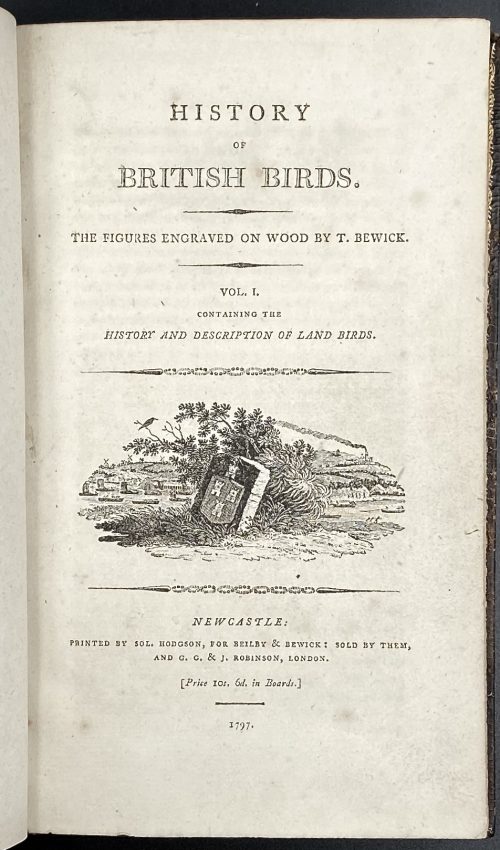 Volume 1: Title: HISTORY | OF | BRITISH BIRDS. | THE FIGURES ENGRAVED ON WOOD BY T. BEWICK. | VOL. I. | CONTAINING THE | HISTORY AND DESCRIPTION OF LAND BIRDS. | [Vignette] | NEWCASTLE: | PRINTED BY SOL. HODGSON, FOR BEILBY & BEWICK : SOLD BY THEM, | AND G. G. & J. ROBINSON, LONDON. | [Price 10s 6d. in Boards] | 1797|| Pagination: [2 blanks], [i, ii] – t.p. / blank, [iii] iv-xxx, [2] – f.t. / blank, [1] 2-335 [336 advert.] [2 blanks]; vignettes on t.p.'s; head- and tail-pieces; publisher's advertisement on final p. of v. 1. Collation: demi 8vo; a-b8, B-Y8; no sigs. A, p. 279 numbered correctly. Woodcuts: 140 descriptions of birds, 117 figures of birds, 91 vignettes, tail-pieces, etc. 1,000 copies printed. Variant B with a vignette at p. 22 printed vertically. Vignette at p. 285 without bars. Volume 2: Title: HISTORY | OF | BRITISH BIRDS. | THE FIGURES ENGRAVED ON WOOD BY T. BEWICK. | VOL. I. | CONTAINING THE | HISTORY AND DESCRIPTION OF WATER BIRDS. | [Vignette] | NEWCASTLE: | PRINTED BY EDWARD WALKER, FOR T. BEWICK : SOLD BY HIM, AND | LONGMAN AND REES, LONDON. | [Price 12s in Boards] | 1804|| Pagination: [2 blanks], [i, ii] – t.p. / blank; [iii] iv-xx, [1] 2-400, [2 blanks]. Collation: Demy 8vo in fours; a2 b-c4, A-3D4; E2, P2, Cc2 insigned. Woodcuts: 144 descriptions of birds, 101 figures of birds, 136 vignettes, tail-pieces, etc. Variant C: Vignette on p. 136 in 1st state, vignettes on pp. 269 and 359 in 2nd state. Binding: speckled full brown calf (restored), contemporary boards ruled in gilt, later spine with raised bands, gilt lettering and florets in compartments, marbled endpapers; 261 woodcut illustrations; printed on wove paper. In both volumes: armorial bookplate of "Clark, Knedlington, Yorks." with the motto "The time will come" on the front pastedown. Size: 21.5 x 14 cm, page: 20.6 x 12.6 cm, demi 8vo. Catalogue raisonné: Hugo (1866): № (99) 94 –120 (108) / pp. 40-58; Roscoe (1953): № 14 a-d, 17 a-d / pp. 46-52 and 65-76. See later edition in this collection: LIB-0860.2015.
Volume 1: Title: HISTORY | OF | BRITISH BIRDS. | THE FIGURES ENGRAVED ON WOOD BY T. BEWICK. | VOL. I. | CONTAINING THE | HISTORY AND DESCRIPTION OF LAND BIRDS. | [Vignette] | NEWCASTLE: | PRINTED BY SOL. HODGSON, FOR BEILBY & BEWICK : SOLD BY THEM, | AND G. G. & J. ROBINSON, LONDON. | [Price 10s 6d. in Boards] | 1797|| Pagination: [2 blanks], [i, ii] – t.p. / blank, [iii] iv-xxx, [2] – f.t. / blank, [1] 2-335 [336 advert.] [2 blanks]; vignettes on t.p.'s; head- and tail-pieces; publisher's advertisement on final p. of v. 1. Collation: demi 8vo; a-b8, B-Y8; no sigs. A, p. 279 numbered correctly. Woodcuts: 140 descriptions of birds, 117 figures of birds, 91 vignettes, tail-pieces, etc. 1,000 copies printed. Variant B with a vignette at p. 22 printed vertically. Vignette at p. 285 without bars. Volume 2: Title: HISTORY | OF | BRITISH BIRDS. | THE FIGURES ENGRAVED ON WOOD BY T. BEWICK. | VOL. I. | CONTAINING THE | HISTORY AND DESCRIPTION OF WATER BIRDS. | [Vignette] | NEWCASTLE: | PRINTED BY EDWARD WALKER, FOR T. BEWICK : SOLD BY HIM, AND | LONGMAN AND REES, LONDON. | [Price 12s in Boards] | 1804|| Pagination: [2 blanks], [i, ii] – t.p. / blank; [iii] iv-xx, [1] 2-400, [2 blanks]. Collation: Demy 8vo in fours; a2 b-c4, A-3D4; E2, P2, Cc2 insigned. Woodcuts: 144 descriptions of birds, 101 figures of birds, 136 vignettes, tail-pieces, etc. Variant C: Vignette on p. 136 in 1st state, vignettes on pp. 269 and 359 in 2nd state. Binding: speckled full brown calf (restored), contemporary boards ruled in gilt, later spine with raised bands, gilt lettering and florets in compartments, marbled endpapers; 261 woodcut illustrations; printed on wove paper. In both volumes: armorial bookplate of "Clark, Knedlington, Yorks." with the motto "The time will come" on the front pastedown. Size: 21.5 x 14 cm, page: 20.6 x 12.6 cm, demi 8vo. Catalogue raisonné: Hugo (1866): № (99) 94 –120 (108) / pp. 40-58; Roscoe (1953): № 14 a-d, 17 a-d / pp. 46-52 and 65-76. See later edition in this collection: LIB-0860.2015. -
![[Voltaire]. La Henriade, nouvelle édition / 2 Vol. — Paris: la Veuve Duchesne, Saillant, Desaint, Panckoucke et Nyon, [1769]-1770.](https://varshavskycollection.com/wp-content/uploads/2021/02/LIB-2581-1.2020-1-4-500x803.jpeg) A two-volume set. Vol. 1: LA | HENRIADE, | NOUVELLE ÉDITION | A PARIS | [medallion portrait of Voltaire] | Chez la Veuve Duchesne, Saillant, Desaint, | Panckoucke et Nyon, Libraires. || Pagination: [2] – engraved title with medallion portrait of Voltaire / blank, [i-iii] iv-xl, [1-3] 4-272, 10 plates and 10 vignettes after Eisen by de Longueil. Collation: 8vo; a-b8 c4, A-R8 Vol. 2: LA | HENRIADE, | NOUVELLE ÉDITION. | — | SECONDE PARTIE. |— | [Floral device] | A PARIS, | Chez la Veuve Duchesne, Saillant, Desaint, | Panckoucke et Nyon, Libraires. | — | M. DCC. LXX. Pagination: [1, 2] - t.p. / imprim., 3-316 [4 - table, imprint "De l'Imprimerie de Barbou."] Collation: A-V8. Binding: full brown calf, raised bands with the gilt floral tools in compartments, red and dark brown labels with gilt lettering: title, author, vol. number, and year; printed on laid paper. Wear, marks and rubbing, endpapers, corners and spine repaired/replaced; leaves are generally clean with the odd mark here or there. With frontispiece, 10 vignettes and 10 plates in vol. 1 as called for. Size: 19 x 12.5 cm each volume. Catalogue raisonné.: G. Ray, p. 59; Cohen-de Ricci p. 1026. LIB-2581-1.2020 and LIB-2581-2.2020.Illustrated by: Charles Eisen (French, 1720 – 1778) Engraved by: Joseph de Longueil (French, 1730 – 1792) Author: François Marie Arouet de Voltaire (French, 1694 – 1778) Publisher: Veuve Duchesne (Nicolas Bonaventure Duchesne died in 1765) Printer: Joseph Gérard Barbou (French, 1723 – 1790)
A two-volume set. Vol. 1: LA | HENRIADE, | NOUVELLE ÉDITION | A PARIS | [medallion portrait of Voltaire] | Chez la Veuve Duchesne, Saillant, Desaint, | Panckoucke et Nyon, Libraires. || Pagination: [2] – engraved title with medallion portrait of Voltaire / blank, [i-iii] iv-xl, [1-3] 4-272, 10 plates and 10 vignettes after Eisen by de Longueil. Collation: 8vo; a-b8 c4, A-R8 Vol. 2: LA | HENRIADE, | NOUVELLE ÉDITION. | — | SECONDE PARTIE. |— | [Floral device] | A PARIS, | Chez la Veuve Duchesne, Saillant, Desaint, | Panckoucke et Nyon, Libraires. | — | M. DCC. LXX. Pagination: [1, 2] - t.p. / imprim., 3-316 [4 - table, imprint "De l'Imprimerie de Barbou."] Collation: A-V8. Binding: full brown calf, raised bands with the gilt floral tools in compartments, red and dark brown labels with gilt lettering: title, author, vol. number, and year; printed on laid paper. Wear, marks and rubbing, endpapers, corners and spine repaired/replaced; leaves are generally clean with the odd mark here or there. With frontispiece, 10 vignettes and 10 plates in vol. 1 as called for. Size: 19 x 12.5 cm each volume. Catalogue raisonné.: G. Ray, p. 59; Cohen-de Ricci p. 1026. LIB-2581-1.2020 and LIB-2581-2.2020.Illustrated by: Charles Eisen (French, 1720 – 1778) Engraved by: Joseph de Longueil (French, 1730 – 1792) Author: François Marie Arouet de Voltaire (French, 1694 – 1778) Publisher: Veuve Duchesne (Nicolas Bonaventure Duchesne died in 1765) Printer: Joseph Gérard Barbou (French, 1723 – 1790) -
![[Voltaire]. La pucelle d'Orléans. Nouvelle édition. — [Geneve: Gabriel Cramer], 1762](https://varshavskycollection.com/wp-content/uploads/2021/02/LIB-2580.2020-1-6-500x841.jpeg) [François Marie Arouet de Voltaire]. La Pucelle d'Orléans, poëme, divisé en vingt chants, avec des notes. Nouvelle édition, corrigée, augmentée & collationnée sur le manuscript de l'auteur. – [Geneva: Gabriel Cramer], 1762. Half-title: LA PUCELLE. Title: LA | PUCELLE D'ORLÉANS, | POËME, | DIVISÉ EN VINGT CHANTS, | AVEC DES NOTES. | Nouvelle Edtition, corrigée, augumentée & colla- | tionnée sur le Manuscript de l'Auteur. | MDCCLXII || Pagination: [2] – blank leaf, [2] – h.t. / blank, [2] – t.p. / blank, [i] ii-viii, [1] 2-358 [2]– blank leaf; after p. 272 the following p. 277, collation and key words correct; 20 plates, one before every chant, by Gravelot, woodcut cul-de-lamps. Collation: 8vo; [π7] A-Y8 Z2 Binding: Hardcover; contemporary full mottled calf, re-backed, flat spine, ruled in gilt, remains of gilt lettering and decorations, marbled end-papers and all margins red. Catalogue raisonné: Cohen-de Ricci 1029: "Première édition avouée par l'auteur". Dimensions: book 20.2 x 12.5 cm; page 19.5 x 11.6 cm. Author: Voltair, François Marie Arouet de (French, 1694 – 1778). Printer: Gabriel Cramer (Swiss, 1723–1793). Artist: Gravelot, Hubert François (French, 1699 – 1773). Another copy in this collection: LIB-2504.2020.
[François Marie Arouet de Voltaire]. La Pucelle d'Orléans, poëme, divisé en vingt chants, avec des notes. Nouvelle édition, corrigée, augmentée & collationnée sur le manuscript de l'auteur. – [Geneva: Gabriel Cramer], 1762. Half-title: LA PUCELLE. Title: LA | PUCELLE D'ORLÉANS, | POËME, | DIVISÉ EN VINGT CHANTS, | AVEC DES NOTES. | Nouvelle Edtition, corrigée, augumentée & colla- | tionnée sur le Manuscript de l'Auteur. | MDCCLXII || Pagination: [2] – blank leaf, [2] – h.t. / blank, [2] – t.p. / blank, [i] ii-viii, [1] 2-358 [2]– blank leaf; after p. 272 the following p. 277, collation and key words correct; 20 plates, one before every chant, by Gravelot, woodcut cul-de-lamps. Collation: 8vo; [π7] A-Y8 Z2 Binding: Hardcover; contemporary full mottled calf, re-backed, flat spine, ruled in gilt, remains of gilt lettering and decorations, marbled end-papers and all margins red. Catalogue raisonné: Cohen-de Ricci 1029: "Première édition avouée par l'auteur". Dimensions: book 20.2 x 12.5 cm; page 19.5 x 11.6 cm. Author: Voltair, François Marie Arouet de (French, 1694 – 1778). Printer: Gabriel Cramer (Swiss, 1723–1793). Artist: Gravelot, Hubert François (French, 1699 – 1773). Another copy in this collection: LIB-2504.2020. -
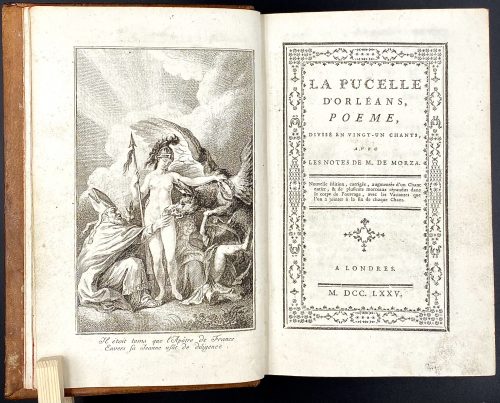 Half title: LA PUCELLE | D’ORLEANS.|| Title: LA PUCELLE | D’ORLEANS , | POEME , | DIVISÉ EN VINGT-UN CHANTS , AVEC | LES NOTES DE M. DE MORZA. | Nouvelle édition, corrigée, augmentée d'un Chant | entier, & de plusieurs morceaux répandus dans | le corps de l'ouvrage, avec les Variantes que | l'on a jointes à la fin de chaque Chant. | [ornament] | A LONDRES. |—| M. DCC. LXXV. || Pagination : [4] – two blank unnumbered fly leaves, [i,ii] – h.t. / double-ruled blank leaf, [2] – blank / frontispiece on verso, [iii, iv] – t.p. ruled and bordered / double-ruled blank leaf, [v]vi-viii – table, ix-xv – preface, [xvi] – double-ruled blank leaf, [1]2-447 [448] – double-ruled blank leaf, [2] – two blank unnumbered fly leaves; page 14 misnumbered 18; title within ornamental border; text within double-ruled borders; head- and tail-pieces; 22 leaves of plates (frontis. + one before each chant.) Collation: 8vo; a8 A-Z8 Aa-Ee8 Binding: 19.9 x 13.2 cm; full contemporary brown calf, blind ruled plates, spine with raised bands, gilt-ruled and tooled in compartments, red label with gilt lettering, all edges red; plate for chant 6, H4, H5 - separated from the block. De Morza is Voltaire (Cf. Quérard, v. 10, p. 306). Engravings unsigned; attributed to Desrais, Claude-Louis (French, 1746 – 1816). False imprint; possibly printed in Paris.
Half title: LA PUCELLE | D’ORLEANS.|| Title: LA PUCELLE | D’ORLEANS , | POEME , | DIVISÉ EN VINGT-UN CHANTS , AVEC | LES NOTES DE M. DE MORZA. | Nouvelle édition, corrigée, augmentée d'un Chant | entier, & de plusieurs morceaux répandus dans | le corps de l'ouvrage, avec les Variantes que | l'on a jointes à la fin de chaque Chant. | [ornament] | A LONDRES. |—| M. DCC. LXXV. || Pagination : [4] – two blank unnumbered fly leaves, [i,ii] – h.t. / double-ruled blank leaf, [2] – blank / frontispiece on verso, [iii, iv] – t.p. ruled and bordered / double-ruled blank leaf, [v]vi-viii – table, ix-xv – preface, [xvi] – double-ruled blank leaf, [1]2-447 [448] – double-ruled blank leaf, [2] – two blank unnumbered fly leaves; page 14 misnumbered 18; title within ornamental border; text within double-ruled borders; head- and tail-pieces; 22 leaves of plates (frontis. + one before each chant.) Collation: 8vo; a8 A-Z8 Aa-Ee8 Binding: 19.9 x 13.2 cm; full contemporary brown calf, blind ruled plates, spine with raised bands, gilt-ruled and tooled in compartments, red label with gilt lettering, all edges red; plate for chant 6, H4, H5 - separated from the block. De Morza is Voltaire (Cf. Quérard, v. 10, p. 306). Engravings unsigned; attributed to Desrais, Claude-Louis (French, 1746 – 1816). False imprint; possibly printed in Paris. -
![Jules Verne. Michael Strogoff : The courier of the Czar. (The story of the film). — London: The Readers Library Publishing Company Ltd., [1927]. — pp.: [1-13] 14-251 [252: printer's imprint] [253-256: blank], note: [note: first and last leaves used as front and rear paste-downs].](https://varshavskycollection.com/wp-content/uploads/2021/02/LIB-2460.2020-a-1-500x785.jpeg) First MGM edition, original maroon cloth, front and spine panels stamped in gold with decorations and lettering, partially darkened, wrap-around dust-jacket, chipped and torn near the head of spine with some loss, small chip and larger closed tear to lower panel. Photoplay edition. Film tie in edition for the 1926 French silent film which does not exist at this time in a full version. The front and rear panels depict scenes from the film. Bleiler (1978), p. 161. Not in Reginald (1979; 1992). Pagination: [2] – blank / advert., [2] – t.p. / coloph., [4] –advert. / editor's note, [2] – advert. / blank, [13] 14-251 [252: printer's imprint] [2] – blanks, note: [first and last leaves used as front and rear paste-downs]. Dimensions: 17 x 10.7 cm. Publisher: The Readers Library Publishing Company Ltd. (London). Publishing Year: 1927 (not indicated). Description of Shapero Rare Books, London: An attractive copy from this popular series of film editions, notable for their use of actors and scenes from the film version in question on the wrap-around dust-jacket, and sometimes photographic plates. A number of the film-makers involved were exiles from the Russian Revolution of 1917. The film's art direction was by Eduardo Gosch (Russian, American, 1890 – ?), César Lacca, Alexandre Lochakoff (Russian, French, fl. 1918–1939), Vladimir Meingard and Pierre Schild [Lakka Schildknecht] (Russian, Spanish, 1897 – 1968) who recreated the atmosphere of mid-nineteenth century Tsarist Russia. “Jules Verne has written no better book than this, in fact, it is deservedly ranked as one of the most thrilling tales ever written." Leonard S. Davidow, Classic Romances of Literature, 1937.
First MGM edition, original maroon cloth, front and spine panels stamped in gold with decorations and lettering, partially darkened, wrap-around dust-jacket, chipped and torn near the head of spine with some loss, small chip and larger closed tear to lower panel. Photoplay edition. Film tie in edition for the 1926 French silent film which does not exist at this time in a full version. The front and rear panels depict scenes from the film. Bleiler (1978), p. 161. Not in Reginald (1979; 1992). Pagination: [2] – blank / advert., [2] – t.p. / coloph., [4] –advert. / editor's note, [2] – advert. / blank, [13] 14-251 [252: printer's imprint] [2] – blanks, note: [first and last leaves used as front and rear paste-downs]. Dimensions: 17 x 10.7 cm. Publisher: The Readers Library Publishing Company Ltd. (London). Publishing Year: 1927 (not indicated). Description of Shapero Rare Books, London: An attractive copy from this popular series of film editions, notable for their use of actors and scenes from the film version in question on the wrap-around dust-jacket, and sometimes photographic plates. A number of the film-makers involved were exiles from the Russian Revolution of 1917. The film's art direction was by Eduardo Gosch (Russian, American, 1890 – ?), César Lacca, Alexandre Lochakoff (Russian, French, fl. 1918–1939), Vladimir Meingard and Pierre Schild [Lakka Schildknecht] (Russian, Spanish, 1897 – 1968) who recreated the atmosphere of mid-nineteenth century Tsarist Russia. “Jules Verne has written no better book than this, in fact, it is deservedly ranked as one of the most thrilling tales ever written." Leonard S. Davidow, Classic Romances of Literature, 1937. -
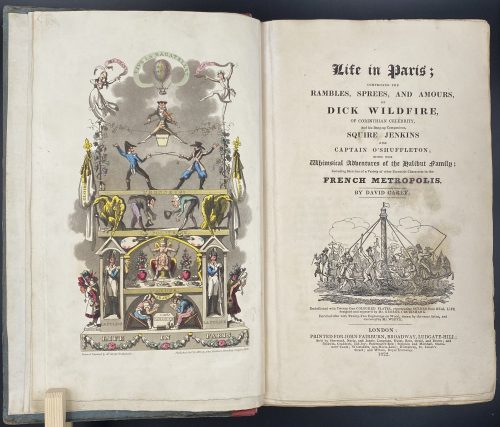
Title: Life in Paris ; | COMPRISING THE | RAMBLES, SPREES, AND AMOURS, | OF | DICK WILDFIRE, | OF CORINTHIAN CELEBRITY, | And his Bang-up Companions, SQUARE JENKINS | AND | CAPTAIN O’SHUFFLETON ; | WITH THE | Whimsical Adventures of the Halibut family ; | Including Sketches of a Variety of other Eccentric Characters in the | FRENCH METROPOLIS. | BY DAVID CAREY |[Vignette]| Embellished with Twenty-One COLOURED PLATES, representing SCENES from REAL LIFE, | designed and engraved by Mr. GEORGE CRUIKSHANK. | Enriched also with Twenty-Two Engravings on Wood, drawn by the same Artist, and | executed by Mr. WHITE. | LONDON : | PRINTED FOR JOHN FAIRBURN, BROADWAY, LUDGATE HILL; | Sold by Sherwood, Neely, and Jones ; Langman, Hurst, Rees, Orme, and Brown ; and | Baldwin, Craddoc, and Joy ; Paternoster-Row ; Simpkin and Marshall, Statio- | ners’ Court ; Whittakers Ave-Maria-Lane ; Humphrey, St. James’s | Street ; and Wilson, Royal Exchange. | 1822. ||
Edition: 1st edition in book form, 1st issue; large-paper copy bound from the parts in original blue paper boards, "most scarce" (Cohn).
Pagination: ffl, [i, ii] – h.t. ‘LIFE IN PARIS’ / ‘MARCHANT, Printer, Ingram-Court, London’, [2] – blank / Frontispiece (Ville la Bagatelle!!) hand-coloured, [iii, iv] – t.p. with vignette / blank, [v] vi-xxiv, [1] 2-489 [490 blank], [2] – 'TO THE BINDER' and 'Marchant, Printer, Ingram-Court, Fenchurch Street' "considered indispensable to a complete copy" (Cohn) / blank, bfl watermarked 1800; 21 hand-coloured aquatints and 22 wood-engraved text vignettes; cancelled leaves 143/4 and 335/6; pinholes from printing visible in most gatherings.
Collation: 4to; [a]-c4, B-Z4 Aa-Zz4 3A-3Q4 3R1 + [Ω]1
Binding: Original boards sometime re-backed with red paper, binder's end leaf watermarked 1800; red hard-grained morocco clamshell box.
Catalogue raisonné: Albert M. Cohn, 1924: № 109 p. 37/8; Abbey, J. R. (Life in England), 112; Tooley (Some English Books with Coloured Plates) 129; Hardie (English coloured books) 199.
Description of Shapero Rare Books, London: Of the copies that have come to auction since 1975 only one has been a large-paper copy in original boards. "The pictures are extremely spirited and true and are all the more wonderful in view of the fact that the artist’s continental experiences were limited to one day spent in Boulogne." (Hardie). In 1821, the journalist Pierce Egan published Life in London, an immediate success illustrated by the Cruikshank brothers, George and Robert. In order to capitalise on this success, another journalist, David Carey, decided to publish his own Life in Paris in monthly instalments (just like Life in London) and with a very similar frontispiece to the one that appears in Egan’s work; Life in Paris, however, was illustrated only by George Cruikshank. One of the earliest and most notable examples of the work of George Cruikshank, with fine, clean plates. -
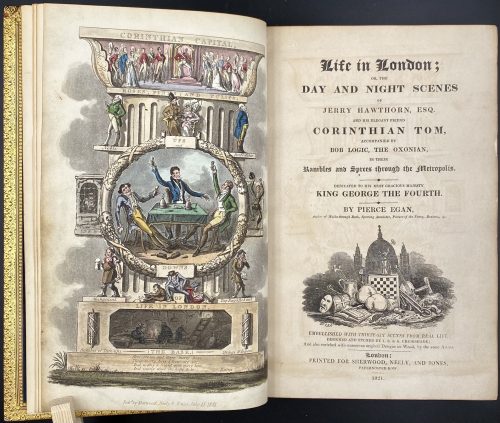
Title: Life in London ; | DAY AND NIGHT SCENES | OF | JERRY HAWTHORN, ESQ. | AND HIS ELEGANT FRIEND | CORINTHIAN TOM, | ACCOMPANIED BY | BOB LOGIC, THE OXONIAN, | IN THEIR |Rambles and Sprees through the Metropolis. | DEDICATED TO HIS MOST GRACIOUS MAJESTY | KING GEORGE THE FOURTH. | BY PIERCE EGAN, | Author of Walks through Bath, Sporting Anecdotes, Picture of the Fancy, Boxiana, &c. | [Vignette] | EMBELLISHED WITH THIRTY-SIX SCENES FROM REAL LIFE, | DESIGNED AND ETCHED BY I. R. & G. CRUIKSHANK ; | And also enriched with numerous original Designs on Wood, by the same Artists, | London: | PRINTED FOR SHERWOOD, NEELY, AND JONES, | PATERNOSTER-ROW. | 1821. ||
Edition: 1st edition, 1st issue: the first sheet of music is not numbered, absence of any footnote at page 9 (as per Cohn).
Pagination: 3 binder's flyleaves with a specimen of George Cruikshank's signature of Nov. 5th, 1860 to the first one; hand-coloured aquatint frontispiece facing the title page with blank recto, [iii-iv] – t.p. with vignette/ blank, [v] vi-viii – dedication, ix-xii – contents, [xiii]-xvi – list of illustrations; [1] 2-376; 35 hand-coloured aquatints, 3 folding leaves of music; bound without half-title [missing pp. i, ii], advertisements or 'to the subscribers' leaf.
Collation: 8vo; [A]7 B-Z8 Aa8-Bb4.
Binding: Full polished calf gilt by Rivière & Son, covers with triple gilt border, spine in 6 compartments, brown morocco lettering pieces to second and third, others richly gilt, raised bands, all edges gilt; neatly re-backed preserving spine.
Catalogue raisonné: Albert M. Cohn, 1924: № 262 p. 90; Abbey, J. R. (Life in England), 281; Tooley (Some English Books with Coloured Plates) 196; Prideaux (Aquatint Engraving) pp. 307, 310; Hardie (English coloured books) 197.
Description of Shapero Rare Books, London: There was a translation into French. At least six plays were based on Egan's characters, contributing to yet more sales. One of these was exported to America, launching the Tom and Jerry craze there. The version created by William Thomas Moncrieff was praised as The Beggar's Opera of its day. Moncrieff's production of Tom and Jerry, or Life in London ran continuously at the Adelphi Theatre for two seasons and it was the dramatist's work as much as the author's that did so much to popularise the book's trademark use of fashionable slang. In 1821 Egan announced the publication of a regular journal: Life in London, appearing monthly at a shilling a time. It was to be illustrated by George Cruikshank (1792 – 1878), and was dedicated to the King, George IV, who at one time had received Egan at court. The first edition of Life in London appeared on 15 July 1821. Egan's creation was an instant success. Pirate versions appeared, featuring such figures as 'Bob Tallyho', 'Dick Wildfire' and the like. Printmakers speedily knocked off cuts featuring the various 'stars' and the real-life public flocked to the 'sporting' addresses that Egan had his heroes frequent. -
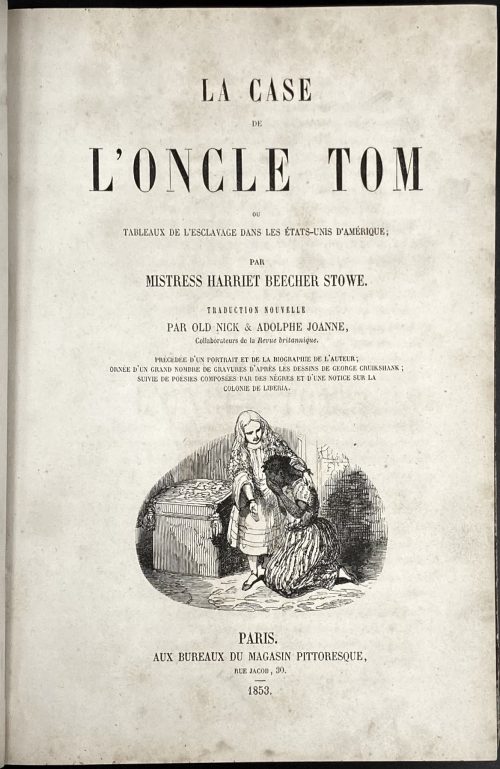 1st French edition (Paris, 1853) of Harriet Beecher Stowe's book Uncle Tom's Cabin; or, Life Among the Lowly, with 27 illustrations on wood by George Cruikshank (British, 1792 – 1878), translated into French by Paul-Émile Daurand-Forgues [pseudonym Old Nick] (French, 1813 – 1883) and Adolphe Joanne (French, 1813 – 1881). Title: LA CASE | DE | L'ONCLE TOM | OU | TABLE AUX DE L'ESCLAVAGE DANS LES ÉTATS-UNIS D'AMÉRIQUE ; | PAR MISTRESS HARRIET BEECHER STOWE. | TRADUCTION NOUVELLE | PAR OLD NICK & ADOLPHE JOANNE, | Collaboarteurs de la Revue britannique, | PRÉCÉDÉE D'UN PORTRAIT ET DE LA BIOGRAPHIE DE L'AUTEUR; | ORNÉE D'IU GRAND NOMBRE DE GRAVURES D'APRES LES DESSINS DE GEORGE CRUIKSHANK ; | SUIVIE DE POÉSIES COMPOSÉES PAR DES NÈGRES ET D'UNE NOTICE SUR LA | COLONIE DE LIBERIA. | [vignette] | PARIS. | AUX BUREAUX DU MAGASIN PITTORESQUE, | RUE JACOB, 30. | 1853. Pagination: ffl blank; [i-ii]: h.t. with stamped letters D. W. in the upper centre / imprim. to verso; [iii-iv] t.p. / blank; [v-vi] blank / frontispiece: portrait of Harriet Beecher Stowe, half-length to left, with hair in ringlets, and a shawl over shoulders, landscape behind, Henry Linton (British, 1815 – 1899) after Henry Anelay (British,1817 – 1883), wood-engraving with letterpress; [vij] Viij-xij; [1] 2-563 [564]; bfl blank; illustrations: 27 woodcuts by George Cruikshank. Collation: 8vo, π7 (1)–(35)8 363 Binding: Quarter brown calf, spine with raised bands, gilt-ruled compartments, title lettering, "D. W." in the bottom, marbled boards and endpapers. Dimensions: 24.1 x 16.4 cm. Catalogue raisonné: Albert M. Cohen (1924), №777, p. 221. "An edition was published in French with the woodcuts direct from the blocks, not, as in the English, merely from the stereotypes. The illustrations are far more impressive than those of Cassell's edition".
1st French edition (Paris, 1853) of Harriet Beecher Stowe's book Uncle Tom's Cabin; or, Life Among the Lowly, with 27 illustrations on wood by George Cruikshank (British, 1792 – 1878), translated into French by Paul-Émile Daurand-Forgues [pseudonym Old Nick] (French, 1813 – 1883) and Adolphe Joanne (French, 1813 – 1881). Title: LA CASE | DE | L'ONCLE TOM | OU | TABLE AUX DE L'ESCLAVAGE DANS LES ÉTATS-UNIS D'AMÉRIQUE ; | PAR MISTRESS HARRIET BEECHER STOWE. | TRADUCTION NOUVELLE | PAR OLD NICK & ADOLPHE JOANNE, | Collaboarteurs de la Revue britannique, | PRÉCÉDÉE D'UN PORTRAIT ET DE LA BIOGRAPHIE DE L'AUTEUR; | ORNÉE D'IU GRAND NOMBRE DE GRAVURES D'APRES LES DESSINS DE GEORGE CRUIKSHANK ; | SUIVIE DE POÉSIES COMPOSÉES PAR DES NÈGRES ET D'UNE NOTICE SUR LA | COLONIE DE LIBERIA. | [vignette] | PARIS. | AUX BUREAUX DU MAGASIN PITTORESQUE, | RUE JACOB, 30. | 1853. Pagination: ffl blank; [i-ii]: h.t. with stamped letters D. W. in the upper centre / imprim. to verso; [iii-iv] t.p. / blank; [v-vi] blank / frontispiece: portrait of Harriet Beecher Stowe, half-length to left, with hair in ringlets, and a shawl over shoulders, landscape behind, Henry Linton (British, 1815 – 1899) after Henry Anelay (British,1817 – 1883), wood-engraving with letterpress; [vij] Viij-xij; [1] 2-563 [564]; bfl blank; illustrations: 27 woodcuts by George Cruikshank. Collation: 8vo, π7 (1)–(35)8 363 Binding: Quarter brown calf, spine with raised bands, gilt-ruled compartments, title lettering, "D. W." in the bottom, marbled boards and endpapers. Dimensions: 24.1 x 16.4 cm. Catalogue raisonné: Albert M. Cohen (1924), №777, p. 221. "An edition was published in French with the woodcuts direct from the blocks, not, as in the English, merely from the stereotypes. The illustrations are far more impressive than those of Cassell's edition". -
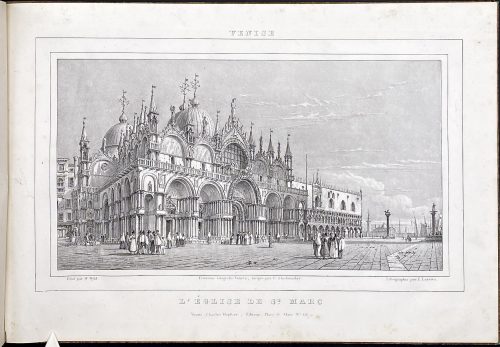 Owner's convolute binding of the period in quarter tan cloth, yellow marbled boards, no title page, no pagination. Contents: (1) Venetian Album –12 lithographs by Émile-Aubert Lessore (French, 1805 – 1876) after William Wyld (British, 1806 – 1889). — Venice: Charles Hopfner, [1834]. Printed at Premiata Litografia Veneta under the direction of Ferdinand Wolfgang Flachenecker (German, 1782 – 1847). Inscription: Premiata Litografia Veneta, dirigée par C. Flachenecker.
Owner's convolute binding of the period in quarter tan cloth, yellow marbled boards, no title page, no pagination. Contents: (1) Venetian Album –12 lithographs by Émile-Aubert Lessore (French, 1805 – 1876) after William Wyld (British, 1806 – 1889). — Venice: Charles Hopfner, [1834]. Printed at Premiata Litografia Veneta under the direction of Ferdinand Wolfgang Flachenecker (German, 1782 – 1847). Inscription: Premiata Litografia Veneta, dirigée par C. Flachenecker.- L'Église de St. Marc
- La place St. Marc
- Le palais Ducal
- Le Môle
- L'Arsenal
- La Riva dei Schiavoni
- Le Grand Canal, (1re vue)
- Le Grand Canal (2me vue)
- Le Grand Canal (3me vue)
- Le Grand Canal (4me vue)
- Le Grand Canal (5me vue)
- Le Grand Canal (6me vue)
- Title: Spiegazione / delli quattro prospetti dei bassi rilievi in marmo che circondano le mura della S. Casa di Loreto / qui annessi in puntata, oltre l'altro prospetto del palazzo pontificio / facciata del tempio, campanile, e cuppola etc.
- Prospetto della Basilica, e Piazza Lauretana, ed annesso Palazzo Apostolico / V. Jaffei incise.
- Settentrione. Prospetto laterale de Bassirilievi in Marmo, che circondano le Mura di S. Casa di Loreto. Jaffei incise Loreto.
- Oriente. Prospetto de Bassirilievi in Marmo, che circ=ondano le Mura di S. Casa. Jaffei incise Loreto l'Anno 1828.
- Mezzo Giorno. Prospetto laterale de Bassirilievi in Marmo, che circondano le Mura di S. Casa di Loreto. Jaffei dis. ed inc. in Loreto.
- Occidente. Prospetto de Bassirilievi in Marmo, che circ=ondano le Mura di S. Casa. Jaffei dis. ed inc. in Loreto l'Anno 1828.
-
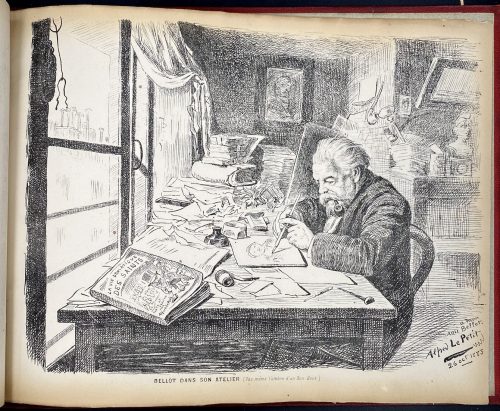 An album of the "Le Bon-Bock" dinners for the year 1884. Author, designer and publisher – Emile Bellot (French, 1831 – 1886), a Parisian artist and engraver. "Le Bon-Bock" was a monthly dinner of artists and men of letters, who gathered in Paris for good food, good company, and artistic performances, from 1875 to at least 1925. The story behind these gatherings as told by Emile Bellot, the founder, is this:
An album of the "Le Bon-Bock" dinners for the year 1884. Author, designer and publisher – Emile Bellot (French, 1831 – 1886), a Parisian artist and engraver. "Le Bon-Bock" was a monthly dinner of artists and men of letters, who gathered in Paris for good food, good company, and artistic performances, from 1875 to at least 1925. The story behind these gatherings as told by Emile Bellot, the founder, is this:In February 1875, Pierre Cottin1 came to me and said: 'I discovered a poet and tragedian of immense talent and who interprets the poems of the Great Victor Hugo in an astonishing way. Monsieur Gambini. I promised him that I would make it heard by an audience of artists and men of letters. I am counting on you who have many connections to keep my promise to him'. I gathered about 25 of my friends and acquaintances in a picnic dinner which took place at a restaurant 'Krauteimer' on the rue Rochechouart in Montmartre. They heard from Mr Gambini first, then my friends Étienne Carjat2, J. Gros3, Adrien Dézamy4, etc. performed. These gentlemen completed the evening so brilliantly that it was unanimously decided that we would start a similar dinner every month. Poets, musicians, men of letters, singers would be invited to this dinner. I was in charge of the organization of this little party and as it was the dream of my life to bring together old comrades, I was careful not to refuse and I pursued this good idea. Cottin and René Tener5 were kind enough to help me in this joyous task and especially my old friend Carjat. The following March began our 1st monthly dinner.
The name "Le Bon-Bock" means "The Good Bock", whilst Bock is a kind of beer, a dark, malty, lightly hopped ale. The dinner was named "Le Bon-Bock" in honour of the Éduard Manet painting (1873), a famous portrait of Emile Bellot, called "Le Bon-Bock".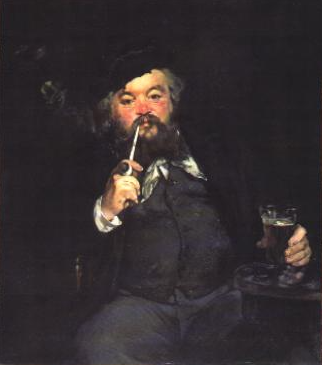 The invitations to the dinner were also produced by the artists and looked like this one by Alexandre Ferdinandus (October 3, 1883).
The invitations to the dinner were also produced by the artists and looked like this one by Alexandre Ferdinandus (October 3, 1883).
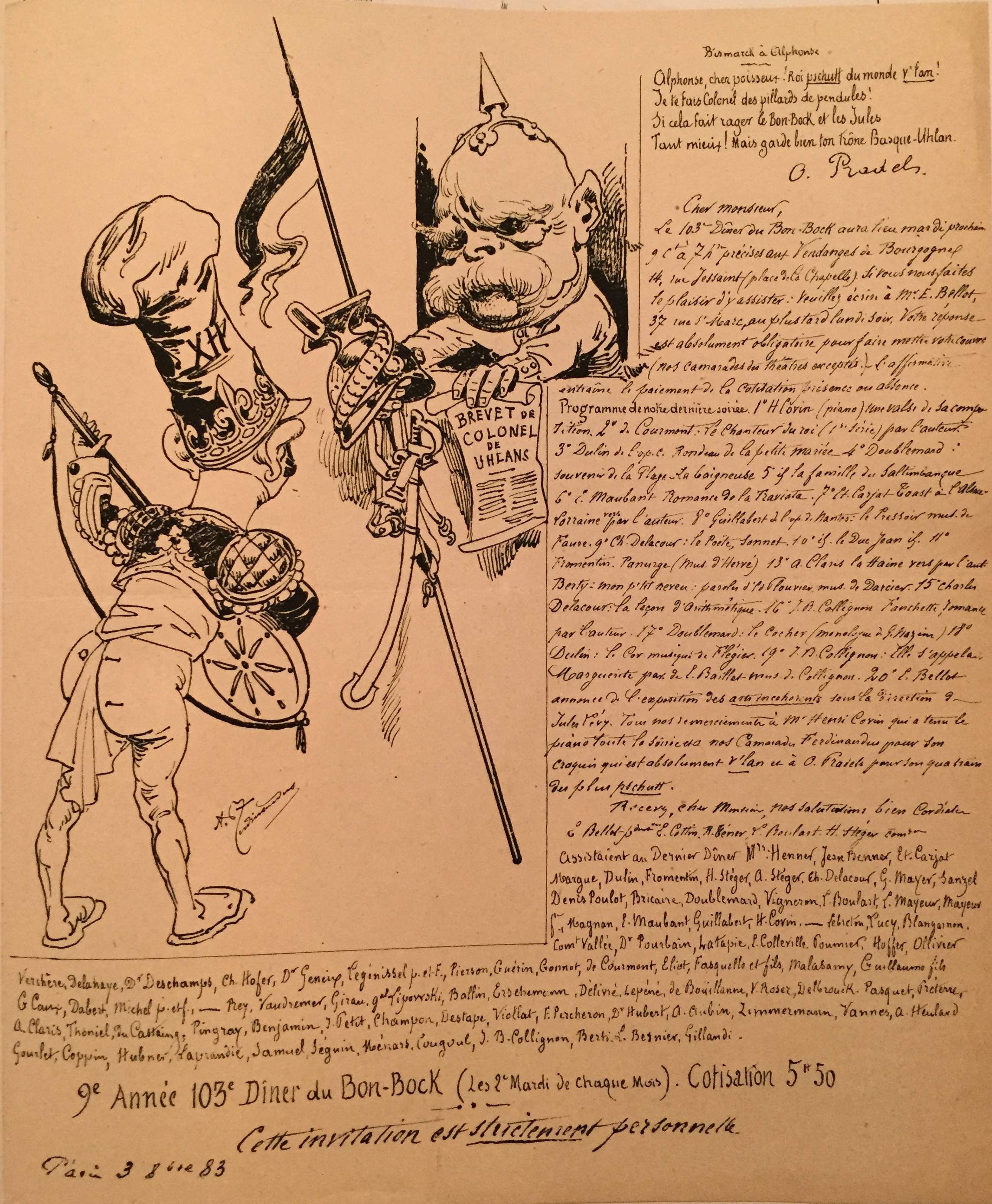 Besides this sketch of the Parisian social and artistic life at the end of the 19th century, the provenance of the album in our collection generates additional interest. The ink stamp to the front flyleaf reads: "Docteur Henry Uzan, 29 Avenue Perrichont, Paris XVI".
Doctor Henry Uzan was Jewish. He was arrested by the Pétain police on October 1, 1941, and interned in Drancy. With the few means at his disposal, he undertook to treat the sick whom he then saw leaving, week after week, towards their terrible destiny in the extermination camps. In October 1943 doctor Uzan was deported to the island of Alderney. After the Normandy Landing of June 6, 1944, Nazis evacuated the island detainees and transfer them to the Neuengamme camp, via northern France and Belgium. During the transfer, doctor Uzan managed to escape from the train on the night of September 3 to 4 around Dixmude in Flanders. He was taken in by the Belgian Resistance, which he joined before being repatriated to France.
In France, he continued working as a physician and was one of the founders of Association des internés et déportés politiques (AIDP). In 1945, together with his friends, the doctor designed the symbol for the Fédération nationale des déportés et internés résistants et patriotes:
Besides this sketch of the Parisian social and artistic life at the end of the 19th century, the provenance of the album in our collection generates additional interest. The ink stamp to the front flyleaf reads: "Docteur Henry Uzan, 29 Avenue Perrichont, Paris XVI".
Doctor Henry Uzan was Jewish. He was arrested by the Pétain police on October 1, 1941, and interned in Drancy. With the few means at his disposal, he undertook to treat the sick whom he then saw leaving, week after week, towards their terrible destiny in the extermination camps. In October 1943 doctor Uzan was deported to the island of Alderney. After the Normandy Landing of June 6, 1944, Nazis evacuated the island detainees and transfer them to the Neuengamme camp, via northern France and Belgium. During the transfer, doctor Uzan managed to escape from the train on the night of September 3 to 4 around Dixmude in Flanders. He was taken in by the Belgian Resistance, which he joined before being repatriated to France.
In France, he continued working as a physician and was one of the founders of Association des internés et déportés politiques (AIDP). In 1945, together with his friends, the doctor designed the symbol for the Fédération nationale des déportés et internés résistants et patriotes:
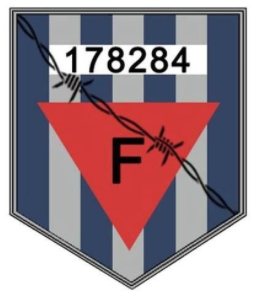 The story behind the number on the emblem (178284) is fascinating but it is out of the scope of this material.
The story behind the number on the emblem (178284) is fascinating but it is out of the scope of this material.
1. Pierre Cottin (French, 1823 – c. 1887) – Engraver, mezzotinter, genre and landscape painter; born in Chappelle-Saint-Denis (near Paris), a pupil of Jazet. Exhibited at the Salon from 1845, also in London from 1876 to 1879.↩ 2. Étienne Carjat (French, 1828 – 1906) – Journalist, caricaturist and photographer. ↩ 3. Jean Baptiste Louis Gros (French, 1793 – 1870) – Painter. ↩ 4. Adrien Dézamy (French, 1844 – 1891) – Writer, poet, general secretary of the Théâtre des Bouffes in Paris. ↩ 5. Rene Tener (French, 1846 – 1925) – Painter. ↩ Sources:Auguste Lepage. Les dîners artistiques et littéraires de Paris / Bibliothèque des Deux mondes (2e éd.) – Paris: Frinzine, Klein et Cie., 1884. [Accession № LIB-2606.2021 in this collection]
-
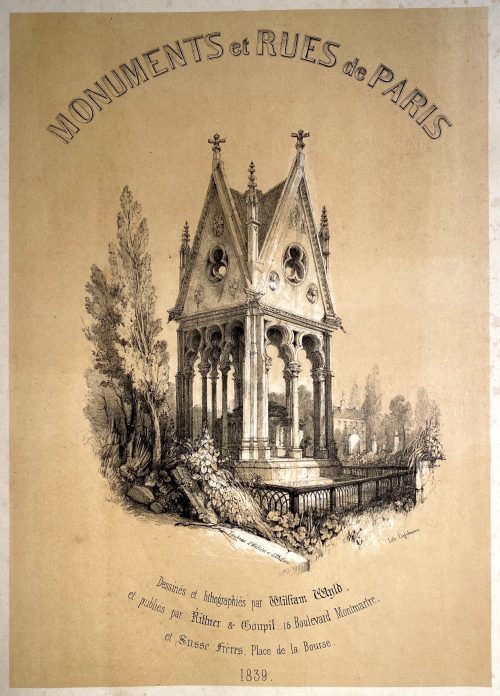 Pictorial album 55.5 x 41.0 cm, publisher’s quarter sheepskin over cloth, upper cover and flat spine lettered in gilt. Title: MONUMENTS et RUES de PARIS | Dessinés et lithographiés par William Wyld, | et publiés par Rittner & Goupil, 15 Boulevard Montmartre, | et Susse Frères, Place de la Bourse. | 1839. Collation: Title plate + 20 plates numbered from 1 to 20, printed by Godefroy Engelmann (French, 1788 – 1839) in tone lithography after drawings by William Wyld (British, 1806 – 1889). Published in Paris by Rittner & Goupil and Susse Frères in 1839. Plates: 54.8 x 39.8 cm. Contents:
Pictorial album 55.5 x 41.0 cm, publisher’s quarter sheepskin over cloth, upper cover and flat spine lettered in gilt. Title: MONUMENTS et RUES de PARIS | Dessinés et lithographiés par William Wyld, | et publiés par Rittner & Goupil, 15 Boulevard Montmartre, | et Susse Frères, Place de la Bourse. | 1839. Collation: Title plate + 20 plates numbered from 1 to 20, printed by Godefroy Engelmann (French, 1788 – 1839) in tone lithography after drawings by William Wyld (British, 1806 – 1889). Published in Paris by Rittner & Goupil and Susse Frères in 1839. Plates: 54.8 x 39.8 cm. Contents:Title page: Tombeau d'Heloïse et d'Abélard
- Le Pont Neuf
- L'église de la Madeleine
- La Porte St. Martin
- Palais des Tuileries
- Pont des Saints-Pères
- Hôtel de Ville
- Marché des Innocents
- Palais Royal
- Boulevard des Italiens
- Rue de la Paix
- Bourse et Tribunal de Commerce
- Porte St. Denis
- Pont Royal
- Place de la Concorde
- Paris from Père Lachaise
- Notre-Dame
- Jardin des Tuileries with Arc de Triomphe in the Distance
- Panthéon
- Chambre des députés
- Arc de Triomphe de l'Étoile
-
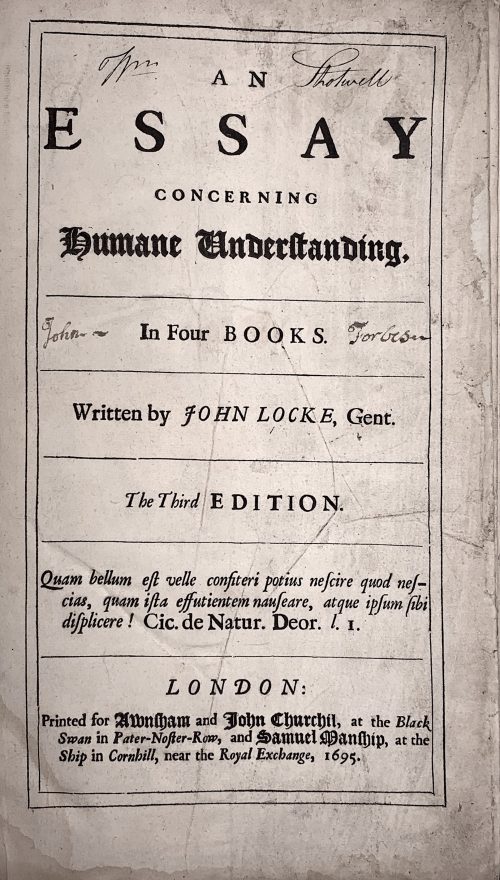 Title: AN | ESSAY | CONCERNING | HUMANE UNDERSTANDING, |—| In Four BOOKS. |—| Written by JOHN LOCKE, Gent. |—| The Third EDITION. |—| Quam bellum est velle confiteri potius nescire quod nes- | cias, quam ista effutientem nauseare, atque ipsum sibi | displicere! Cic. De Natur. Deor. l. I. |—| LONDON: | Printed for Awnsham and John Churchil, at the Black | Swan in Pater-Noster-Row, and Samuel Manship, at the | Ship in Cornhill, near the Royal Exchange, 1695. Collation: [π2]-b6, a-c4, B-Z4 Aa-Zz4 Aaa-Fff4 Ggg-Iii2 Pagination: [40] 1-407 [13]. Catalogue raisoné: The works of John Locke; a comprehensive bibliography from the seventeenth century to the present. Compiled by John C. Attig. Series: Bibliographies and Indexes in Philosophy, Number 1. Greenwood Press, Westport, CT & London, England, 1985. p. 42, №230 provides for pagination [40] 407, [13]p. Page by page reprint of 1694 edition. Regarding the epigraph on t.p.: The correct citation from , De Natura Deorum: "Quam bellum erat, Vellei, confiteri potius nescire, quod nescires, quam ista effutientem nauseare atque ipsum sibi displicere." [How delightful it would be, Velleius, if when you did not know a thing you would admit your ignorance, instead of uttering this drivel, which must make even your own gorge rise with disgust!] This life-time edition was presented as a gift to Dr Elisha Atkins (1949 – 2019), professor at Yale University School of Medicine, on July 1st, 1967, by his students, namely Carolyn Wells [Bush] (1923 – 2013), John Mooney (now a psychiatrist in Boston), and Charles Dinarello. Size: 32 x 23 cm Binding: Fill modern morocco, panelled and ruled gilt, raised bands, gilt in compartments, red label with gilt lettering; in a slipcase.
Title: AN | ESSAY | CONCERNING | HUMANE UNDERSTANDING, |—| In Four BOOKS. |—| Written by JOHN LOCKE, Gent. |—| The Third EDITION. |—| Quam bellum est velle confiteri potius nescire quod nes- | cias, quam ista effutientem nauseare, atque ipsum sibi | displicere! Cic. De Natur. Deor. l. I. |—| LONDON: | Printed for Awnsham and John Churchil, at the Black | Swan in Pater-Noster-Row, and Samuel Manship, at the | Ship in Cornhill, near the Royal Exchange, 1695. Collation: [π2]-b6, a-c4, B-Z4 Aa-Zz4 Aaa-Fff4 Ggg-Iii2 Pagination: [40] 1-407 [13]. Catalogue raisoné: The works of John Locke; a comprehensive bibliography from the seventeenth century to the present. Compiled by John C. Attig. Series: Bibliographies and Indexes in Philosophy, Number 1. Greenwood Press, Westport, CT & London, England, 1985. p. 42, №230 provides for pagination [40] 407, [13]p. Page by page reprint of 1694 edition. Regarding the epigraph on t.p.: The correct citation from , De Natura Deorum: "Quam bellum erat, Vellei, confiteri potius nescire, quod nescires, quam ista effutientem nauseare atque ipsum sibi displicere." [How delightful it would be, Velleius, if when you did not know a thing you would admit your ignorance, instead of uttering this drivel, which must make even your own gorge rise with disgust!] This life-time edition was presented as a gift to Dr Elisha Atkins (1949 – 2019), professor at Yale University School of Medicine, on July 1st, 1967, by his students, namely Carolyn Wells [Bush] (1923 – 2013), John Mooney (now a psychiatrist in Boston), and Charles Dinarello. Size: 32 x 23 cm Binding: Fill modern morocco, panelled and ruled gilt, raised bands, gilt in compartments, red label with gilt lettering; in a slipcase. -
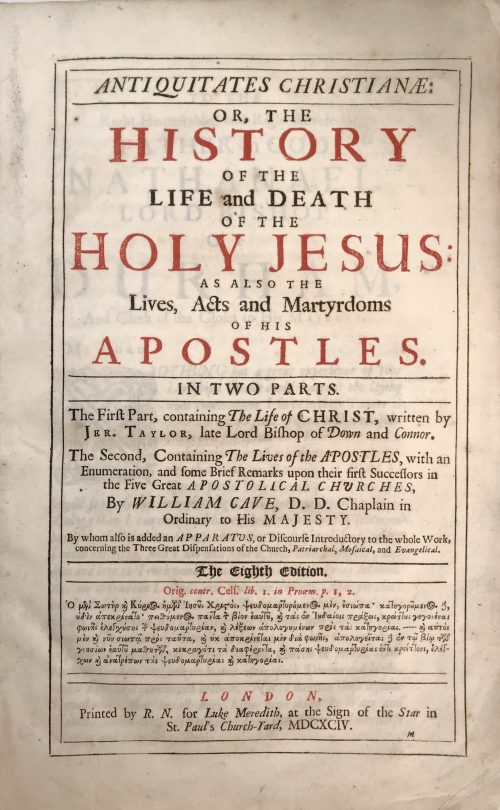 Title (black and red): ANTIQUITATES CHRISTIANÆ: |—| OR, THE | HISTORY | OF THE | LIFE AND DEATH | OF THE | HOLY JESUS: | AS ALSO THE Lives, Acts and Martyrdoms | OF HIS | APOSTLES. |—| IN TWO PARTS. |—| The Firƒt Part, containing The Life of CHRIST, written by | Jer. Taylor, Late Lord Bishop of Down and Connor. | The Second, Containing The Lives of the APOSTLES, with an | Enumeration, and ƒome Brief Remarks upon their firƒt Successors in | the Five Great APOSTOLICAL CHURCHES, | By WILLIAM CAVE, D. D. Chaplain in | Ordinary to His MAJESTY. | By whom alƒo is added an APPARATUS, or Diƒcourƒe Introductory to the whole Work, | concerning the Three Great Diƒpenƒations of the Church, Patriarchal, Moƒaical, and Evangelical. |—| THE EIGHTH EDITION. |—| Orig. contr. Celƒ. lib. 1. in Proœm. p. 1, 2. | [text in Greek] |—| LONDON, | Printed by R. N. for Luke Meredith, at the Sign of the Star in | St. Paul's Church-Yard, MDCXCIV. Collation of this book is unusual, it is called "Folio in 6s" (three sheets are folded in half to create a gathering of 6 leaves). Two unsigned leaves: (1) Engraved frontispiece "The Annunciation" by Willian Faithorne "the Elder" (British, 1616 – 1691), recto blank; (2) engraved title by the same engraver, verso blank; (*) gathering of 4: black and red title page, verso blank; epistle; to reader; imprim. (A6 to Sƒ6) Engraved portrait of Jeremy Taylor by Pierre Lombart (French, 1612 – 1682); faux title page: "The Great Exemplar of Sanctity and Holy Life... MDCXCIII"; dedication; contents, then to the end of the first book. (A-Z4 Aa-Bb4 Cc2) The second book has collation in quarto: Faux title page: "Antiquitates Christianæ: or the Lives, Acts and Martyrdoms... MDCXCIV", etc. to the end. Full formula: π2 *4 a-c6 d8 A-Z6 Aa-Sƒ6 A-Z4 Aa-Bb4 Cc2 Pagination: [12] I-LI [LII] [12] I-XXVIII, i-vi, (1st book): [2] I-145 [146-150] 151-432 [12]; (2nd book): [8] i-xiv, 1-188. 22 plates : frontis., t.p., portrait, one folding before p. 65, two after pp. [146], [150], 282, 304, 364, 386, 414, [422], and numerous head-pieces. Size: 36 x 23.5 x 5.7 cm Binding: full calf with the later spine, raised bands; front board with remnants of gilt ruling and blind stamped border, back bord probably original with a blind-stamped centre panel with fleurons.
Title (black and red): ANTIQUITATES CHRISTIANÆ: |—| OR, THE | HISTORY | OF THE | LIFE AND DEATH | OF THE | HOLY JESUS: | AS ALSO THE Lives, Acts and Martyrdoms | OF HIS | APOSTLES. |—| IN TWO PARTS. |—| The Firƒt Part, containing The Life of CHRIST, written by | Jer. Taylor, Late Lord Bishop of Down and Connor. | The Second, Containing The Lives of the APOSTLES, with an | Enumeration, and ƒome Brief Remarks upon their firƒt Successors in | the Five Great APOSTOLICAL CHURCHES, | By WILLIAM CAVE, D. D. Chaplain in | Ordinary to His MAJESTY. | By whom alƒo is added an APPARATUS, or Diƒcourƒe Introductory to the whole Work, | concerning the Three Great Diƒpenƒations of the Church, Patriarchal, Moƒaical, and Evangelical. |—| THE EIGHTH EDITION. |—| Orig. contr. Celƒ. lib. 1. in Proœm. p. 1, 2. | [text in Greek] |—| LONDON, | Printed by R. N. for Luke Meredith, at the Sign of the Star in | St. Paul's Church-Yard, MDCXCIV. Collation of this book is unusual, it is called "Folio in 6s" (three sheets are folded in half to create a gathering of 6 leaves). Two unsigned leaves: (1) Engraved frontispiece "The Annunciation" by Willian Faithorne "the Elder" (British, 1616 – 1691), recto blank; (2) engraved title by the same engraver, verso blank; (*) gathering of 4: black and red title page, verso blank; epistle; to reader; imprim. (A6 to Sƒ6) Engraved portrait of Jeremy Taylor by Pierre Lombart (French, 1612 – 1682); faux title page: "The Great Exemplar of Sanctity and Holy Life... MDCXCIII"; dedication; contents, then to the end of the first book. (A-Z4 Aa-Bb4 Cc2) The second book has collation in quarto: Faux title page: "Antiquitates Christianæ: or the Lives, Acts and Martyrdoms... MDCXCIV", etc. to the end. Full formula: π2 *4 a-c6 d8 A-Z6 Aa-Sƒ6 A-Z4 Aa-Bb4 Cc2 Pagination: [12] I-LI [LII] [12] I-XXVIII, i-vi, (1st book): [2] I-145 [146-150] 151-432 [12]; (2nd book): [8] i-xiv, 1-188. 22 plates : frontis., t.p., portrait, one folding before p. 65, two after pp. [146], [150], 282, 304, 364, 386, 414, [422], and numerous head-pieces. Size: 36 x 23.5 x 5.7 cm Binding: full calf with the later spine, raised bands; front board with remnants of gilt ruling and blind stamped border, back bord probably original with a blind-stamped centre panel with fleurons. -
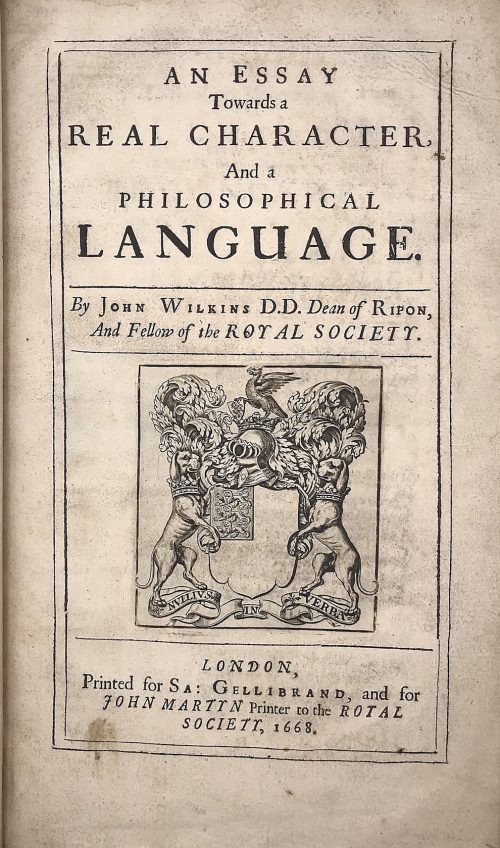 Title: AN ESSAY | Towards a | REAL CHARACTER, | And a | PHILOSOPHICAL | LANGUAGE. | By John Wilkins D.D. Dean of Ripon, | And Fellow of the ROYAL SOCIETY. |—| [armorial device] |—| LONDON, | Printed for Sa: Gellibrand, and for | JOHN MARTYN Printer to the ROYAL | SOCIETY, 1668. Pagination: [2] blank/order, [2] t.p./blank, [16], 1-454; + 79 leaves of Dictionary, unpaginated (158 pages); Illustrations: folding plates before pp. 167, 187, and two folding plates before p. 443. Collation: π2 a-d2 B-Z4 Aa-Zz4 Aaa-Lll4 Mmm3 aaa4 Aaa-Sss4 ttt3 Size: 4to, 32 x 20 x 5 cm; Binding: Full speckled calf, later polished calf spine with raised bands, double fillet ruled gilt compartments, crimson label with gilt lettering, margins sprinkled red. The work of John Wilkins is dedicated to the problem of the universal language. Wilkins was the Dean of Ripon from 1663 to 1672 and one of the founders of the Royal Society.
Title: AN ESSAY | Towards a | REAL CHARACTER, | And a | PHILOSOPHICAL | LANGUAGE. | By John Wilkins D.D. Dean of Ripon, | And Fellow of the ROYAL SOCIETY. |—| [armorial device] |—| LONDON, | Printed for Sa: Gellibrand, and for | JOHN MARTYN Printer to the ROYAL | SOCIETY, 1668. Pagination: [2] blank/order, [2] t.p./blank, [16], 1-454; + 79 leaves of Dictionary, unpaginated (158 pages); Illustrations: folding plates before pp. 167, 187, and two folding plates before p. 443. Collation: π2 a-d2 B-Z4 Aa-Zz4 Aaa-Lll4 Mmm3 aaa4 Aaa-Sss4 ttt3 Size: 4to, 32 x 20 x 5 cm; Binding: Full speckled calf, later polished calf spine with raised bands, double fillet ruled gilt compartments, crimson label with gilt lettering, margins sprinkled red. The work of John Wilkins is dedicated to the problem of the universal language. Wilkins was the Dean of Ripon from 1663 to 1672 and one of the founders of the Royal Society. -
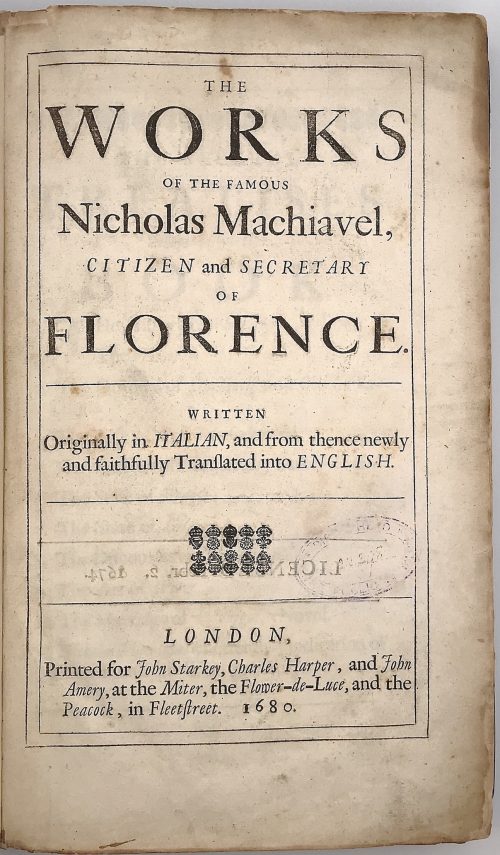 Title: THE | WORKS | OF THE FAMOUS | Nicholas Machiavel, | CITIZEN and SECRETARY | OF | FLORENCE. |—| WRITTEN | Originally in ITALIAN, and from thence newly | and faithfully Tranſlated into ENGLISH. |—|[ornament]|—| LONDON, | Printed for John Starkey, Charles Harper, and John | Amery, at the Miter, the Flower-de-Luce, and the | Peacock, in Fleetstreet. 1680. Content: (1) The history of Florence; (2) The Prince; (3) The Original of the Guelf and Ghibilin Factions; (4) The Life of Castruccio Castracani; (5) The Murther of Vitelli, etc. by Duke Valentino; (6) The State of France; (7) The State of Germany; (8) The Discourses on Titus Livius; (9) The Art of War; (10) The Marriage of Belphegor, a Novel; (11) Nicholas Machiavel's Letter in Vindication of Himself and His Writings. Pagination: ffl, 24 unnumbered pages before the first numbered: [2] – tp / license], [2] – contents / blank], [2] ftp “Florence” / blank, [3] – epistle to Clement VII, [3] – introduction, [12] – table; Misnumbering (X instead of Y format – X/Y): History of Florence: 1- 28/24, 19/91, 198/98, 180/108, 190/109, 174/164, 175/ 165, 179/169, 180/170, 185/175, 186/176, 188/178, 189/179, [190/180 blank]; The Prince, Lucca, State of France: [4] 199-262; State of Germany: 256/263, 266/264, 267/265 [268/266]; Discourses: [4] 267-314, 317-431 [432]; Art of War: [4] 433-528; [4] – publisher, [12] –Machiavelli’s letter, bfl. Collation: π3 Aa3 b-d2 B-Z4 Aa-Bb2 Cc-Zz4 Aaa-Yyy4 (*)-(**)4 Binding: Original mottled leather boards with embossing, later leather spine with 5 raised bands, crimson label with gilt lettering. Size: 32.4 x 21.0 x 4.0 cm Provenance: Bradford H. Gray This is the second edition; despite misnumbering, the collation is correct and all pages present. The first edition of this book was published in 1675 by Robert Bolter (British, fl. 1666 – 1683).
Title: THE | WORKS | OF THE FAMOUS | Nicholas Machiavel, | CITIZEN and SECRETARY | OF | FLORENCE. |—| WRITTEN | Originally in ITALIAN, and from thence newly | and faithfully Tranſlated into ENGLISH. |—|[ornament]|—| LONDON, | Printed for John Starkey, Charles Harper, and John | Amery, at the Miter, the Flower-de-Luce, and the | Peacock, in Fleetstreet. 1680. Content: (1) The history of Florence; (2) The Prince; (3) The Original of the Guelf and Ghibilin Factions; (4) The Life of Castruccio Castracani; (5) The Murther of Vitelli, etc. by Duke Valentino; (6) The State of France; (7) The State of Germany; (8) The Discourses on Titus Livius; (9) The Art of War; (10) The Marriage of Belphegor, a Novel; (11) Nicholas Machiavel's Letter in Vindication of Himself and His Writings. Pagination: ffl, 24 unnumbered pages before the first numbered: [2] – tp / license], [2] – contents / blank], [2] ftp “Florence” / blank, [3] – epistle to Clement VII, [3] – introduction, [12] – table; Misnumbering (X instead of Y format – X/Y): History of Florence: 1- 28/24, 19/91, 198/98, 180/108, 190/109, 174/164, 175/ 165, 179/169, 180/170, 185/175, 186/176, 188/178, 189/179, [190/180 blank]; The Prince, Lucca, State of France: [4] 199-262; State of Germany: 256/263, 266/264, 267/265 [268/266]; Discourses: [4] 267-314, 317-431 [432]; Art of War: [4] 433-528; [4] – publisher, [12] –Machiavelli’s letter, bfl. Collation: π3 Aa3 b-d2 B-Z4 Aa-Bb2 Cc-Zz4 Aaa-Yyy4 (*)-(**)4 Binding: Original mottled leather boards with embossing, later leather spine with 5 raised bands, crimson label with gilt lettering. Size: 32.4 x 21.0 x 4.0 cm Provenance: Bradford H. Gray This is the second edition; despite misnumbering, the collation is correct and all pages present. The first edition of this book was published in 1675 by Robert Bolter (British, fl. 1666 – 1683). -
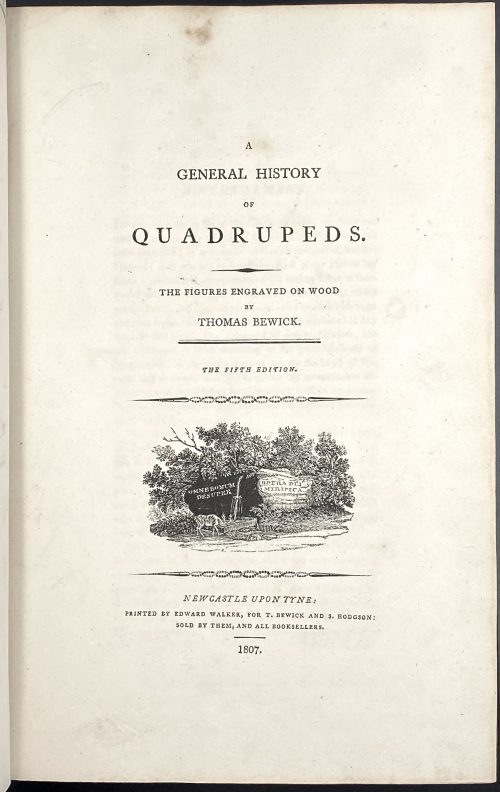 Title: A | GENERAL HISTORY | OF | QUADRUPEDS. | – | THE FIGURES ENGRAVED ON WOOD | BY | THOMAS BEWICK. | — | THE FIFTH EDITION | {vignette} | NEWCASTLE UPON TYNE: | PRINTED BY EDWARD WALKER, FOR T. BEWICK AND S. HODGSON: | SOLD BY THEM, AND ALL BOOKSELLERS. | 1807. Pagination: [2 blanks], [i, ii] – t.p. / blank], [iii, iv] – advertisement, [v] vi-x – index, [1] 2-525 [526 advert. of British Birds] [2 blanks]. Collation: Royal 8vo in fours; π (engraved title), a4 A-3T4 χ3T3. F2 signed 2F, 2E2 unsigned, p. 131 numbered correctly, p. 257 numbered 572. Size: 26 x 17 cm; page 24.5 x 16 cm (royal). Woodcuts: 302 descriptions of quadrupeds, 225 figures and 112 vignettes, tail-pieces, etc. Binding: Full diced brown calf, embossed blind corner fleurons, gilt-tooled border inside and outside, AEG, spine with raised bands, gilt in compartments, lettering; binding restored; armorial bookplate "Thorpe" to front pastedown. Likely to be Thomas Thorpe (1791 – 1851), a prominent bookseller in London: Bedford Street, Covent Garden; started in 1818, went bankrupt on Dec. 31, 1825. Thorpe's family coat of arms: stag standing on a crown and a lion rampant. Catalogue raisonné: S. Roscoe (1953): pp. 23-27. Hugo (1866): pp. 22-24.
Title: A | GENERAL HISTORY | OF | QUADRUPEDS. | – | THE FIGURES ENGRAVED ON WOOD | BY | THOMAS BEWICK. | — | THE FIFTH EDITION | {vignette} | NEWCASTLE UPON TYNE: | PRINTED BY EDWARD WALKER, FOR T. BEWICK AND S. HODGSON: | SOLD BY THEM, AND ALL BOOKSELLERS. | 1807. Pagination: [2 blanks], [i, ii] – t.p. / blank], [iii, iv] – advertisement, [v] vi-x – index, [1] 2-525 [526 advert. of British Birds] [2 blanks]. Collation: Royal 8vo in fours; π (engraved title), a4 A-3T4 χ3T3. F2 signed 2F, 2E2 unsigned, p. 131 numbered correctly, p. 257 numbered 572. Size: 26 x 17 cm; page 24.5 x 16 cm (royal). Woodcuts: 302 descriptions of quadrupeds, 225 figures and 112 vignettes, tail-pieces, etc. Binding: Full diced brown calf, embossed blind corner fleurons, gilt-tooled border inside and outside, AEG, spine with raised bands, gilt in compartments, lettering; binding restored; armorial bookplate "Thorpe" to front pastedown. Likely to be Thomas Thorpe (1791 – 1851), a prominent bookseller in London: Bedford Street, Covent Garden; started in 1818, went bankrupt on Dec. 31, 1825. Thorpe's family coat of arms: stag standing on a crown and a lion rampant. Catalogue raisonné: S. Roscoe (1953): pp. 23-27. Hugo (1866): pp. 22-24. -
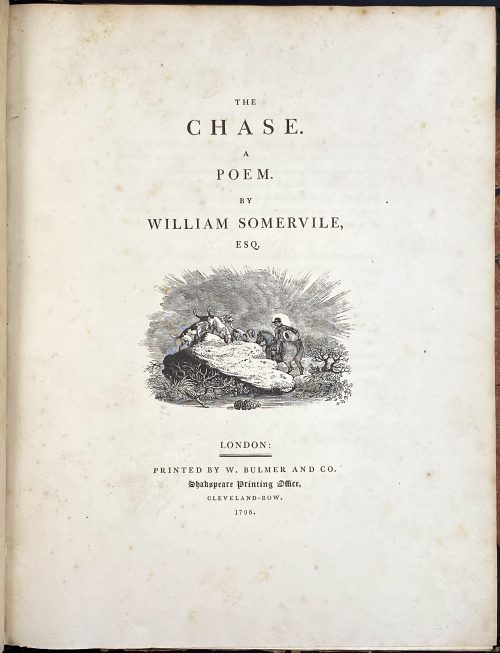 Royal 4to, 29.8 x 23.5 cm, contemporary half brown morocco, marbled boards gilt ruled, spine with gilt-ruled raised bands, gilt title lettering; "William Gore" armorial bookplate to front pastedown. Title page: THE | CHASE. | A | POEM. | BY | WILLIAM SOMERVILLE, | ESQ. | [VIGNETTE] | LONDON : | PRINTED BY W. BULMER AND CO. | Shakespeare Printing Office, | CLEVELAND-ROW. | 1796. Collation: without signatures. — Pagination: [i-v] vi-xv [xvi], [i] ii-vii [viii], [1-5] 6-126; illustrations: engraved title, 4 running titles, 4 headpieces, 4 tailpieces – 13 altogether, all drafted by John Bewick, 12 executed by Thomas Bewick and the last one by Charlton Nesbit. Catalogue Raisonné: Thomas Hugo. The Bewick Collector, vol. 1 (1866): p. 38, № 94: "The first edition... was printed in royal 4to". John Bewick made all the drawing on the blocks but was not able to execute the engravings himself "because of ill-health. They were engraved by Thomas Bewick, with the exception of the tail-piece at the end of the volume, which was engraved by Nesbit". Thomas Bewick (c. 11 August 1753 – 8 November 1828); John Bewick (1760 – 1795), the younger brother of Thomas, died at the age of 35. Christie's, who sold a similar copy on 29 Oct 2012, provides for the size 2°.
Royal 4to, 29.8 x 23.5 cm, contemporary half brown morocco, marbled boards gilt ruled, spine with gilt-ruled raised bands, gilt title lettering; "William Gore" armorial bookplate to front pastedown. Title page: THE | CHASE. | A | POEM. | BY | WILLIAM SOMERVILLE, | ESQ. | [VIGNETTE] | LONDON : | PRINTED BY W. BULMER AND CO. | Shakespeare Printing Office, | CLEVELAND-ROW. | 1796. Collation: without signatures. — Pagination: [i-v] vi-xv [xvi], [i] ii-vii [viii], [1-5] 6-126; illustrations: engraved title, 4 running titles, 4 headpieces, 4 tailpieces – 13 altogether, all drafted by John Bewick, 12 executed by Thomas Bewick and the last one by Charlton Nesbit. Catalogue Raisonné: Thomas Hugo. The Bewick Collector, vol. 1 (1866): p. 38, № 94: "The first edition... was printed in royal 4to". John Bewick made all the drawing on the blocks but was not able to execute the engravings himself "because of ill-health. They were engraved by Thomas Bewick, with the exception of the tail-piece at the end of the volume, which was engraved by Nesbit". Thomas Bewick (c. 11 August 1753 – 8 November 1828); John Bewick (1760 – 1795), the younger brother of Thomas, died at the age of 35. Christie's, who sold a similar copy on 29 Oct 2012, provides for the size 2°. -
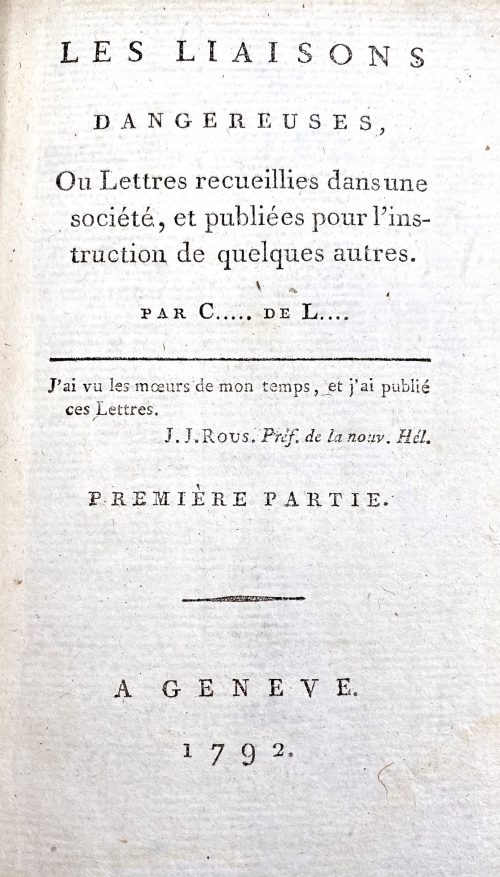 Four parts bound in two 18mo volumes (1-2 & 3-4), half polished brown calf, dot-ruled, flat spine with gilt bands and lettering, marbled boards, some plates with guard sheets, margins sparkled red. Title-page: LES LIAISONS | DANGEREUSES, | Ou Lettres recueillies dans une | société, et publiées pour l’ins- | truction de quelques autres. | par C….. de L… | — | J’ai vu les mœurs de mon temps, et j’ai publié | ces Lettres. | J. J. Rous. Préf. De la nouv. Hél. | PREMIÈRE PARTIE. | — | A GENEVE. | 1792. || Vol. 1: Pagination: ffep, blank, [2] – h.t., [i, ii] – t.p. part one, [iii] iv-xxij, [1] 2-245 [246] + 2 plates (p. 26 & p. 75); [1, 2] – h.t., [3, 4] – t.p. part two, [5] 6-233 [234], fep + 2 plates (p. 59 & p. 222). Collation: part 1: a12, A-M18 N5; part 2: A-M18 N9, plus four plates by various engravers after Le Barbier. Vol. 2: Pagination: ffep, blank, [1, 2] – h.t., [3, 4] – t.p. part three, [5] 6-225 [226] + 2 plates (p. 69 & p. 215); [1, 2] – h.t., [3, 4] – t.p. part four, [5] 6-250, fep + 2 plates (p. 25 & p. 201). Collation: part 3: A-M18 N5; part 4: A-N18 O5, plus four plates by various engravers after Le Barbier. Illustrations: After Le Barbier, engravers: Halbou (1), Simonet (1), N. Thomas (2), Dambrun (2), and Delignon (2). In the first illustration (vol. 1, part one, p. 26) Le Barbier signed “Le Barbier Jnv. 1794”, however, the edition was published (anonymously) in 1792. Cohen-De Ricci mentions an edition of 1794 (Paris: Maradan) and 1801 (Genéve) with the same plates. Lewine mentions a reprint of 1794 without naming the publisher. Catalogue raisonné: Cohen-De Ricci: 234-5, Ray: p. 79; Lewine: 109-10. Contributors: Choderlos de Laclos, Pierre Ambroise François (French, 1741 – 1803) – author. Le Barbier, Jean-Jacques-François (French, 1738 – 1826) – artist Engravers: Dambrun, Jean (French, 1741 – c. 1808) Delignon, Jean Louis (French, 1755 – 1804) Halbou, Louis Michel (1730 – 1809) Thomas, N. (French, c. 1750 – 1812) Simonet, Jean-Baptiste Blaise (French, 1742 – 1813)
Four parts bound in two 18mo volumes (1-2 & 3-4), half polished brown calf, dot-ruled, flat spine with gilt bands and lettering, marbled boards, some plates with guard sheets, margins sparkled red. Title-page: LES LIAISONS | DANGEREUSES, | Ou Lettres recueillies dans une | société, et publiées pour l’ins- | truction de quelques autres. | par C….. de L… | — | J’ai vu les mœurs de mon temps, et j’ai publié | ces Lettres. | J. J. Rous. Préf. De la nouv. Hél. | PREMIÈRE PARTIE. | — | A GENEVE. | 1792. || Vol. 1: Pagination: ffep, blank, [2] – h.t., [i, ii] – t.p. part one, [iii] iv-xxij, [1] 2-245 [246] + 2 plates (p. 26 & p. 75); [1, 2] – h.t., [3, 4] – t.p. part two, [5] 6-233 [234], fep + 2 plates (p. 59 & p. 222). Collation: part 1: a12, A-M18 N5; part 2: A-M18 N9, plus four plates by various engravers after Le Barbier. Vol. 2: Pagination: ffep, blank, [1, 2] – h.t., [3, 4] – t.p. part three, [5] 6-225 [226] + 2 plates (p. 69 & p. 215); [1, 2] – h.t., [3, 4] – t.p. part four, [5] 6-250, fep + 2 plates (p. 25 & p. 201). Collation: part 3: A-M18 N5; part 4: A-N18 O5, plus four plates by various engravers after Le Barbier. Illustrations: After Le Barbier, engravers: Halbou (1), Simonet (1), N. Thomas (2), Dambrun (2), and Delignon (2). In the first illustration (vol. 1, part one, p. 26) Le Barbier signed “Le Barbier Jnv. 1794”, however, the edition was published (anonymously) in 1792. Cohen-De Ricci mentions an edition of 1794 (Paris: Maradan) and 1801 (Genéve) with the same plates. Lewine mentions a reprint of 1794 without naming the publisher. Catalogue raisonné: Cohen-De Ricci: 234-5, Ray: p. 79; Lewine: 109-10. Contributors: Choderlos de Laclos, Pierre Ambroise François (French, 1741 – 1803) – author. Le Barbier, Jean-Jacques-François (French, 1738 – 1826) – artist Engravers: Dambrun, Jean (French, 1741 – c. 1808) Delignon, Jean Louis (French, 1755 – 1804) Halbou, Louis Michel (1730 – 1809) Thomas, N. (French, c. 1750 – 1812) Simonet, Jean-Baptiste Blaise (French, 1742 – 1813) -
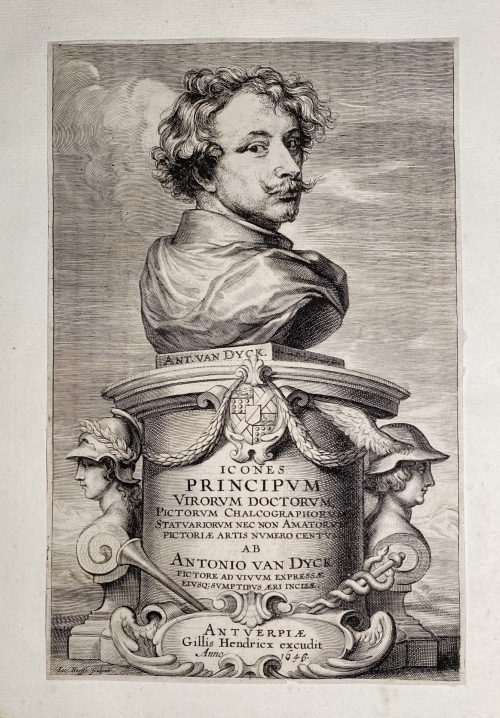 A book of sixty-eight copperplate engravings (burin and etching) by various artists after Anthony van Dyck, and one engraving by Lucas Vorsterman I, printed in black on laid paper, bound in full calf with a blind-stamped double-fillet ruling to the boards, spine with raised bands, gilt floral lozenges in compartments, gilt lettering "RECUE DE FIGUR", all margins sprinkled red, marbled end-papers. Engravers: Adriaen Lommelin (French engraver, 1637 – c. 1673) : 12 plates: №№ 3, 17, 18, 20, 21, 24, 25, 26, 28, 30, 35, and 48. Anthony van Dyck (Flemish, 1599 – 1641) : partially engraved himself 1 plate: № 53. Antoine Couchet (Flemish, 1630 – 1678) : 1 plate № 30. Conrad Waumans [Woumans] (Flemish engraver, 1619 – after 1675) : 6 plates: №№ 5, 32, 36, 57, 64, and 66. Cornelis Galle the Younger (Flemish engraver, 1615 – 1678) : 5 plates: №№ 2, 7, 10, 29, and 33. Hendrick Snyers (Flemish engraver, 1611 – 1644) : 1 plate: № 9. Jacob Neefs, or Neeffs (Flemish engraver, 1610 – after 1660): 4 plates: №№ 1, 16, 45, and 67. Johannes [Jan] Meyssens (Flemish engraver and publisher, 1612 – 1670) : engraved 6 plates: №№ 4, 22, 31, 51, 61, and 62. Lucas Vorsterman the Elder (Flemish engraver, 1595 – 1675) : engraved 7 plates: №№ 11, 15, 55, 58, 59, 65, and 69. Michael Natalis, or Noël (Flemish engraver, 1610 – 1668) : 1 plate: № 34 Paulus Pontius (Flemish engraver, 1603 – 1658) : 2 plates: №№ 37 and 52. Peeter Clouwet (Flemish engraver, 1629 – 1670) : 3 plates: №№ 13, 27, and 49. Peeter van Lisebetten (Flemish engraver, 1630 – 1678) : 1 plate: № 56. Pieter de Bailliu (Flemish engraver, 1613 – after 1660) : 4 plates: №№ 8, 14, 44, and 54. Pieter de Jode II (Flemish, 1606 – 1670/74) : 7 plates: №№ 12, 19, 23, 46, 47, 50, and 60. Richard Gaywood (British, fl. 1644 – 1668) : 1 plate: № 63. Robert van Voerst (Dutch, 1597 – 1636) : 1 plate: № 6. Schelte Adamsz. Bolswert (Flemish, c. 1586 – 1659) : 2 plates: №№ 18 and 68. Wenceslaus Hollar (Bohemian, 1607 – 1677) : 6 plates: №№ 38, 39, 40, 41, 42, and 43. Publishers: 36 prints were printed/published by Johannes [Jan] Meyssens (Flemish, 1612 – 1670) : (2), (4), (5), (7), (8), (9), (10), (12), (14), (22), (29), (31), (32), (33), (34), (36), (37), (39), (40), (41), (42), (43), (44), (45), (46), (51), (53), (54), (56), (57), (60), (61), (62), (64), (66), (67). Gillis Hendricx (fl. 1640 – 1677) published 11 prints, including the title page: (1), (13), (18), (26), (30), (47), (48), (50), (59), (65), (68). N. Burgund. Cons. Brab : (20); John Overton (British, 1639/40 – 1713) : (63); Hendrik van der Borcht II (Dutch, 1614 – c. 1690) : (38); Peter Stent (British, fl. c. 1637 – 1665) : (63). Description of plates:
A book of sixty-eight copperplate engravings (burin and etching) by various artists after Anthony van Dyck, and one engraving by Lucas Vorsterman I, printed in black on laid paper, bound in full calf with a blind-stamped double-fillet ruling to the boards, spine with raised bands, gilt floral lozenges in compartments, gilt lettering "RECUE DE FIGUR", all margins sprinkled red, marbled end-papers. Engravers: Adriaen Lommelin (French engraver, 1637 – c. 1673) : 12 plates: №№ 3, 17, 18, 20, 21, 24, 25, 26, 28, 30, 35, and 48. Anthony van Dyck (Flemish, 1599 – 1641) : partially engraved himself 1 plate: № 53. Antoine Couchet (Flemish, 1630 – 1678) : 1 plate № 30. Conrad Waumans [Woumans] (Flemish engraver, 1619 – after 1675) : 6 plates: №№ 5, 32, 36, 57, 64, and 66. Cornelis Galle the Younger (Flemish engraver, 1615 – 1678) : 5 plates: №№ 2, 7, 10, 29, and 33. Hendrick Snyers (Flemish engraver, 1611 – 1644) : 1 plate: № 9. Jacob Neefs, or Neeffs (Flemish engraver, 1610 – after 1660): 4 plates: №№ 1, 16, 45, and 67. Johannes [Jan] Meyssens (Flemish engraver and publisher, 1612 – 1670) : engraved 6 plates: №№ 4, 22, 31, 51, 61, and 62. Lucas Vorsterman the Elder (Flemish engraver, 1595 – 1675) : engraved 7 plates: №№ 11, 15, 55, 58, 59, 65, and 69. Michael Natalis, or Noël (Flemish engraver, 1610 – 1668) : 1 plate: № 34 Paulus Pontius (Flemish engraver, 1603 – 1658) : 2 plates: №№ 37 and 52. Peeter Clouwet (Flemish engraver, 1629 – 1670) : 3 plates: №№ 13, 27, and 49. Peeter van Lisebetten (Flemish engraver, 1630 – 1678) : 1 plate: № 56. Pieter de Bailliu (Flemish engraver, 1613 – after 1660) : 4 plates: №№ 8, 14, 44, and 54. Pieter de Jode II (Flemish, 1606 – 1670/74) : 7 plates: №№ 12, 19, 23, 46, 47, 50, and 60. Richard Gaywood (British, fl. 1644 – 1668) : 1 plate: № 63. Robert van Voerst (Dutch, 1597 – 1636) : 1 plate: № 6. Schelte Adamsz. Bolswert (Flemish, c. 1586 – 1659) : 2 plates: №№ 18 and 68. Wenceslaus Hollar (Bohemian, 1607 – 1677) : 6 plates: №№ 38, 39, 40, 41, 42, and 43. Publishers: 36 prints were printed/published by Johannes [Jan] Meyssens (Flemish, 1612 – 1670) : (2), (4), (5), (7), (8), (9), (10), (12), (14), (22), (29), (31), (32), (33), (34), (36), (37), (39), (40), (41), (42), (43), (44), (45), (46), (51), (53), (54), (56), (57), (60), (61), (62), (64), (66), (67). Gillis Hendricx (fl. 1640 – 1677) published 11 prints, including the title page: (1), (13), (18), (26), (30), (47), (48), (50), (59), (65), (68). N. Burgund. Cons. Brab : (20); John Overton (British, 1639/40 – 1713) : (63); Hendrik van der Borcht II (Dutch, 1614 – c. 1690) : (38); Peter Stent (British, fl. c. 1637 – 1665) : (63). Description of plates: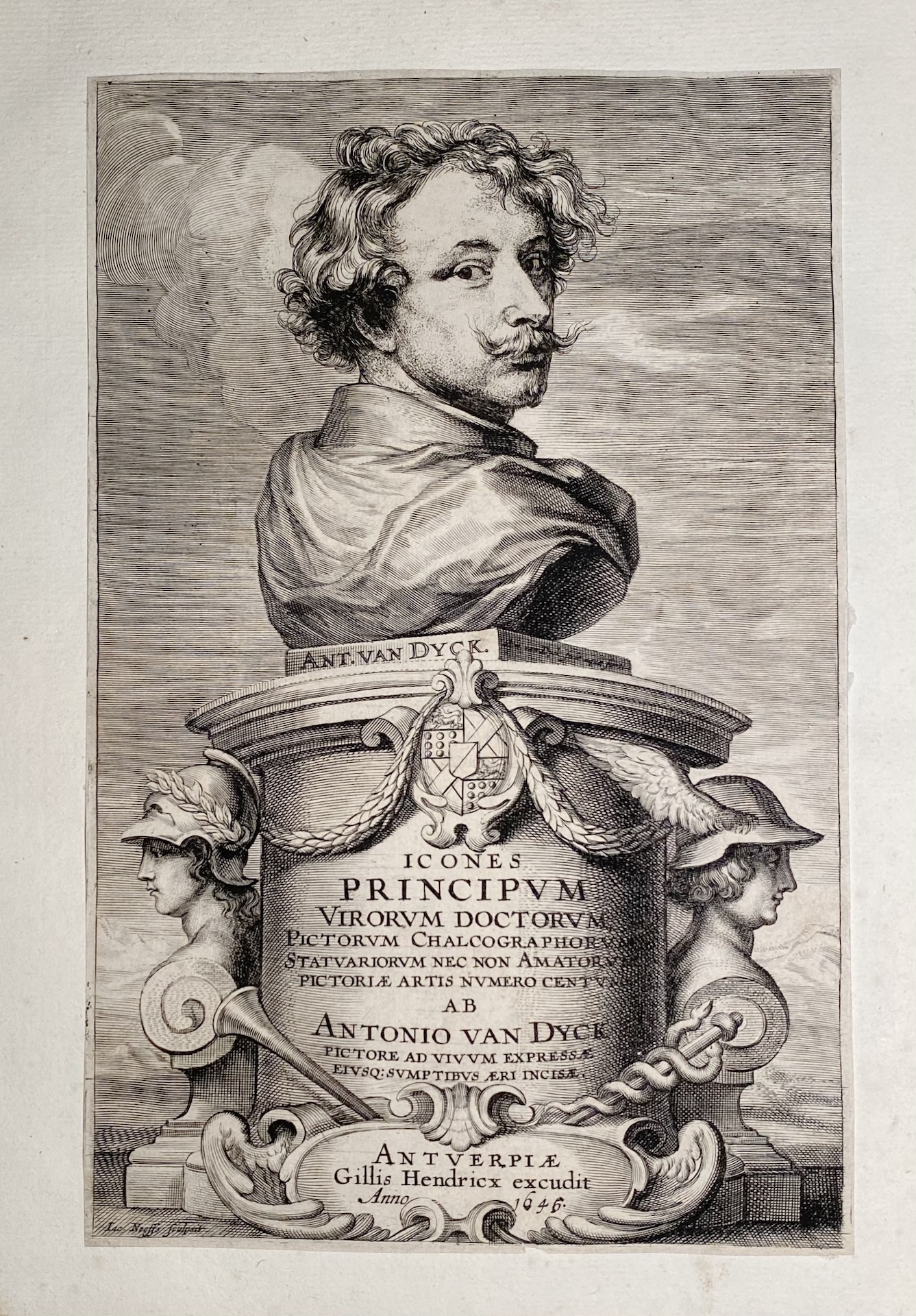
1. Engraved title page by Jacob Neeffs in 1646. On the slab supporting the bust, left: “ANT. VAN DYCK”, right: “Ant. van Dyck fecit aqua forti”. On the face of pedestal: “PRINCIPVM | VIRORVM DOCTORVM, | PICTORVM CHALCOGRAPHORVM, | STATVARIORVM NEC NON AMATORVM | PICTORIÆ ARTIS NVMERO CENTVM | AB | ANTONIO VAN DYCK, | PICTORE AD VIVVM EXPRESSÆ | EIVSQ: SVMPTIBVS ÆRI INCISÆ.” In cartouche: “ANTVERPIÆ | Gillis Hendricx excudit | Anno 1645” (corrected by hand “1646”). At lower left margin: “Iac. Neeffs Sculpsit.” The print with cut off margins pasted to the bound-in leaf. Size of the print: 24.3 x 15.8 cm. 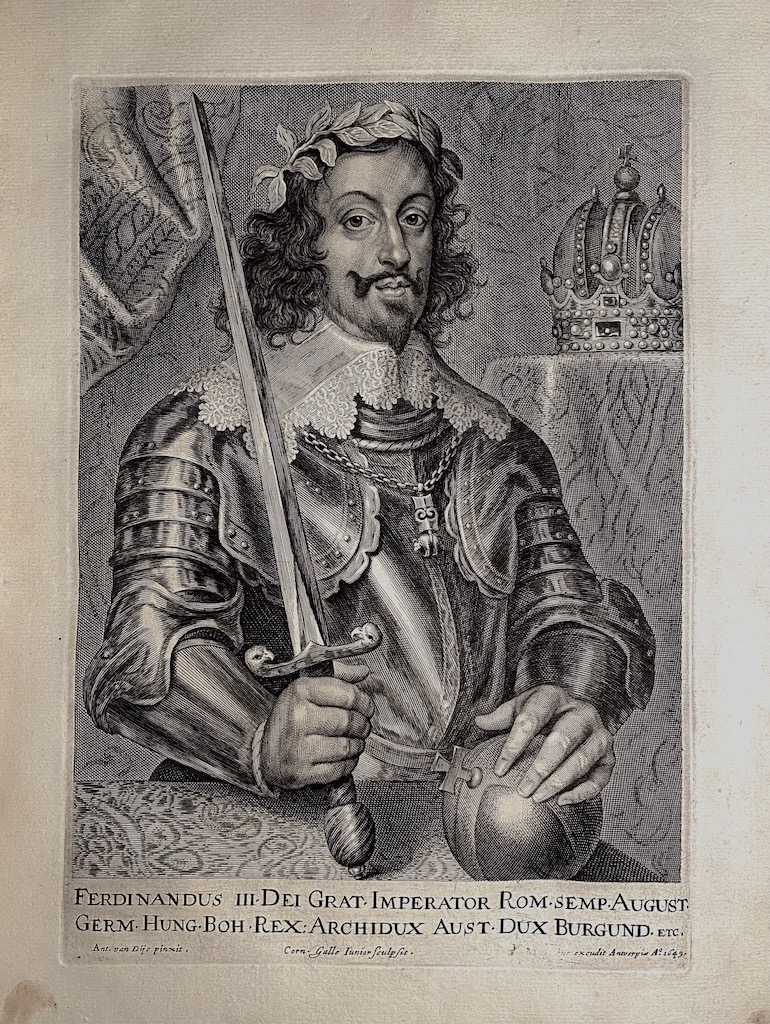
2. Ferdinand III, Holy Roman Emperor and King of Hungary and Bohemia (1608 – 1657); engraved by Cornelis Galle the Younger (Flemish, 1615–1678) in 1649. Inscription: “FERDINANDUS III. DEI GRAT. IMPERATOR ROM.SEMP.AUGUST. | GERM. HUNG. BOH. REX: ARCHIDICUX AU ST. DUX BURGUND. ETC.”. Below: “Ant. van Dÿc pinxit” <–> “Corn. Galle Iunior sculp∫it.”<–> “…excudit Antuerpiæ A.o 1649”. Second state with Meyssens’ name burnished. 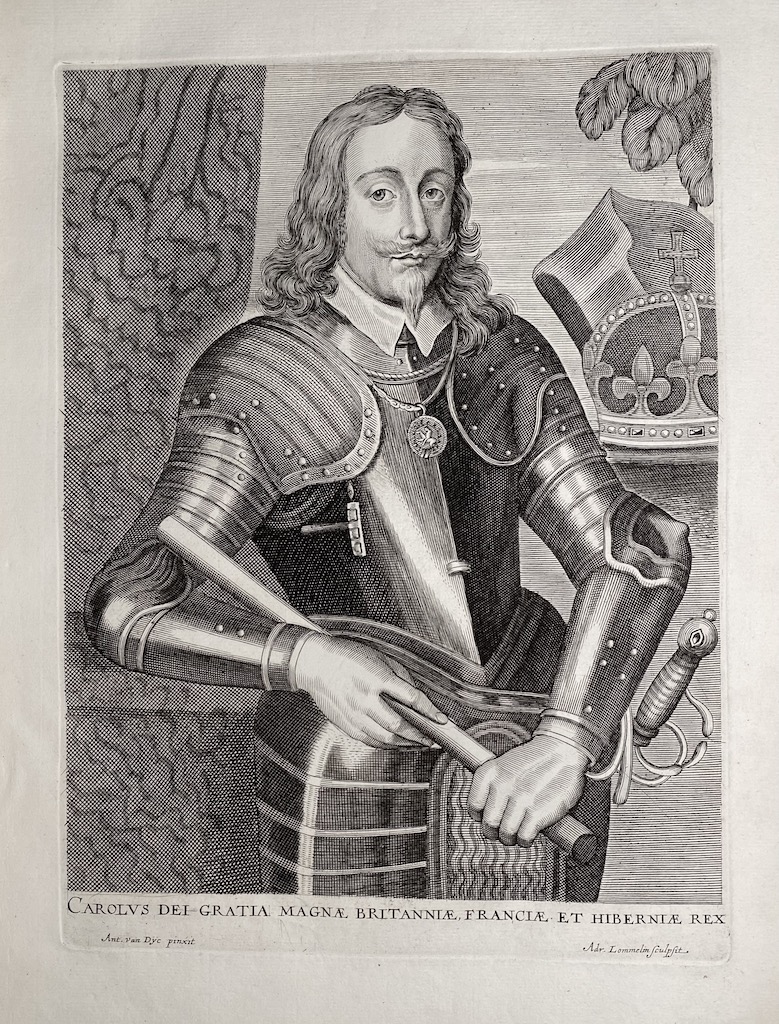
3. Charles I, King of England, Scotland, and Ireland (British, 1600 – 1649); engraved by Adriaen Lommelin (French, 1637 – c. 1673). Inscription: “CAROLVS DEI GRATIA MAGNÆ BRITANNIÆ, FRANCIÆ ET HIBERNIÆ REX”. Below: “Ant. van Dÿc pinxit” <–> “Adr. Lommelin sculpsit”. 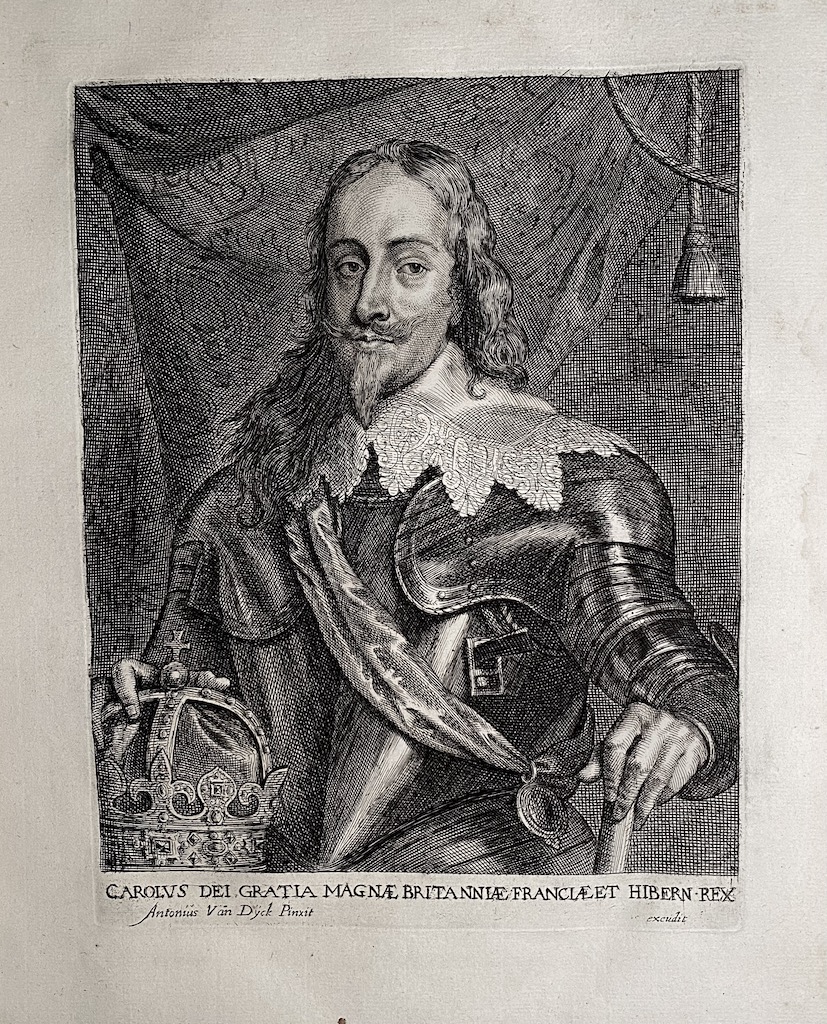
4. Charles I, King of England, Scotland, and Ireland (British, 1600 – 1649); engraved by Johannes [Jan] Meyssens (Flemish, 1612 – 1670). Inscription: “CAROLVS DEI GRATIA MAGNÆ BRITANNIÆ, FRANCIÆ ET HIBERNIÆ REX”. Below: Antonius Van Dÿck eques pinxit” <–> “...excudit”. Meyssens’ name burnished. [See similar print №61 with Ioannes Meysens name present]. 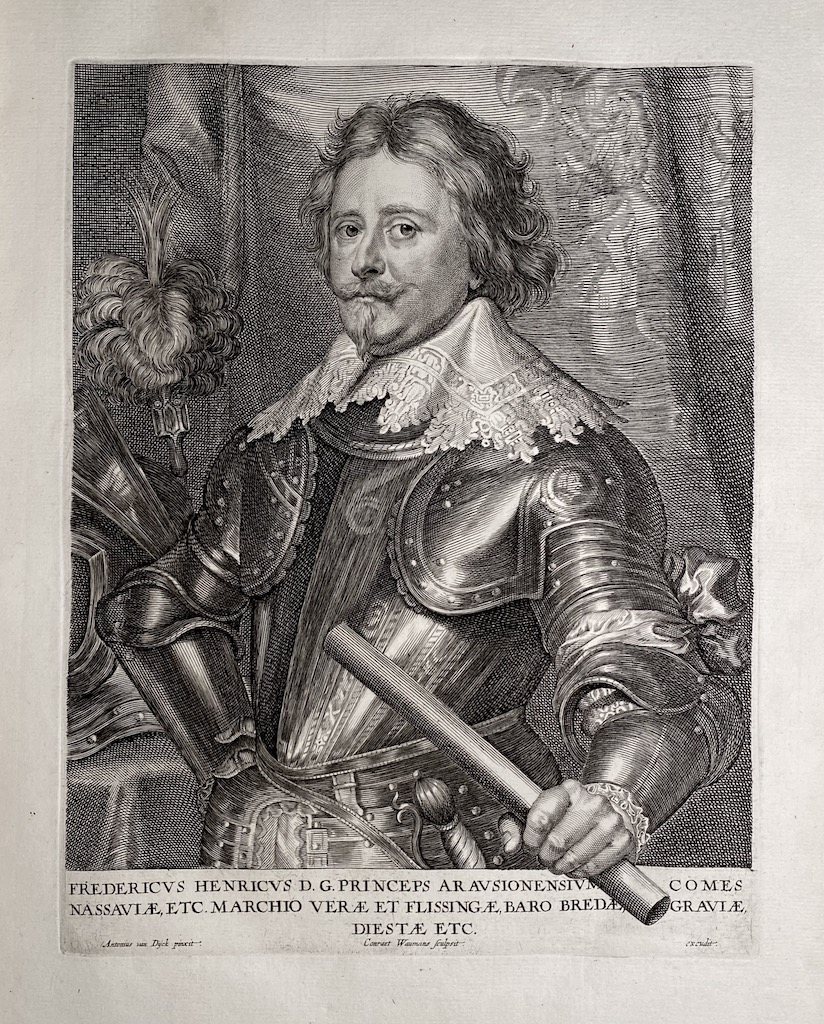
5. Frederick Henry, Prince of Orange, Count of Nassau (Dutch, 1584 – 1647); engraved by Conrad Waumans [Woumans] (Flemish, 1619 – after 1675). Inscription: “FREDERICVS HENRICVS, D.G. PRINCEPS ARAVSIONENSIVM, COMES | NASSAVIÆ, ETC. | MARCHIO VERÆ ET FLISSINGÆ, BARO BREDÆ GRAVÆ, | DIESTÆ ETC.” Below: “Antonius van Dÿck pinxit” <–> “Conraet Waumans sculpsit” <–> “…excudit”. Meyssens’ name burnished. [Similar to №57, but with Ioannes Meyssens name in place]. 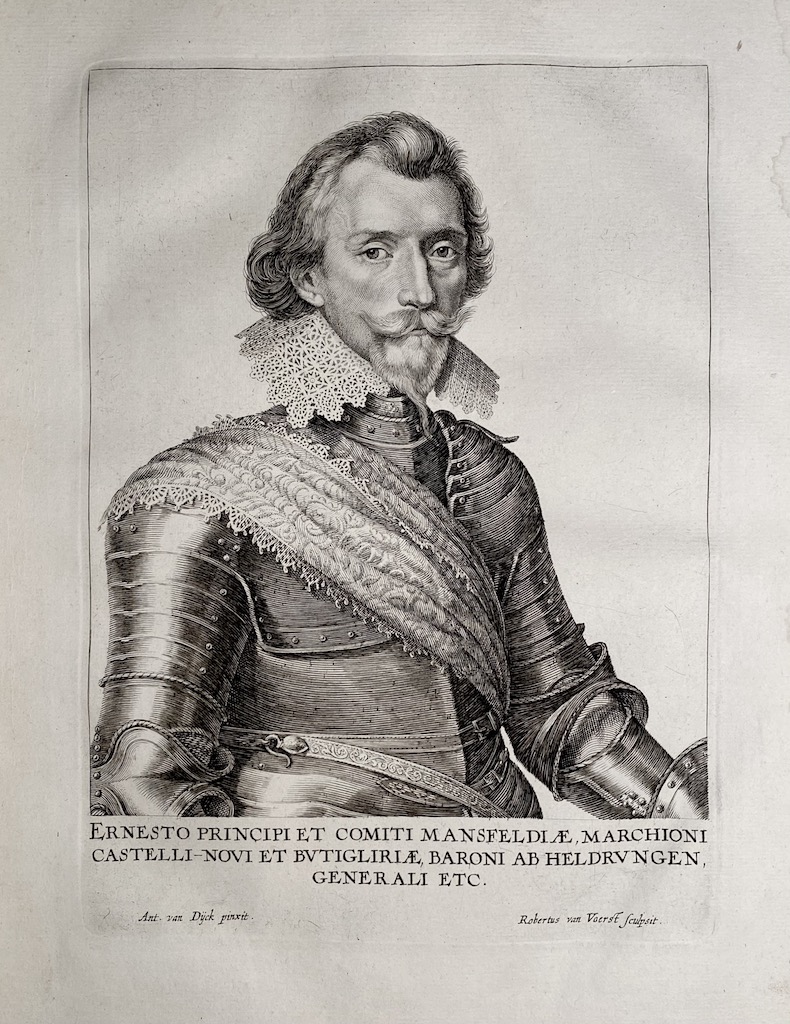
6. Count Ernst von Mansfield (German, 1580 – 1626); engraved by Robert van Voerst (Dutch, 1597 – 1636). Inscription: “ERNESTO PRINCIPI ET COMITI MANSFELDIÆ, MARCHIONI | CASTELLI-NOVI ET BUTIGLIRIÆ, BARONI AB HELDRUNGEN, GENERALI ETC.” Below “Ant. Van Dÿck pinxit” <–> “Robertus van Voerst Sculpsit”. 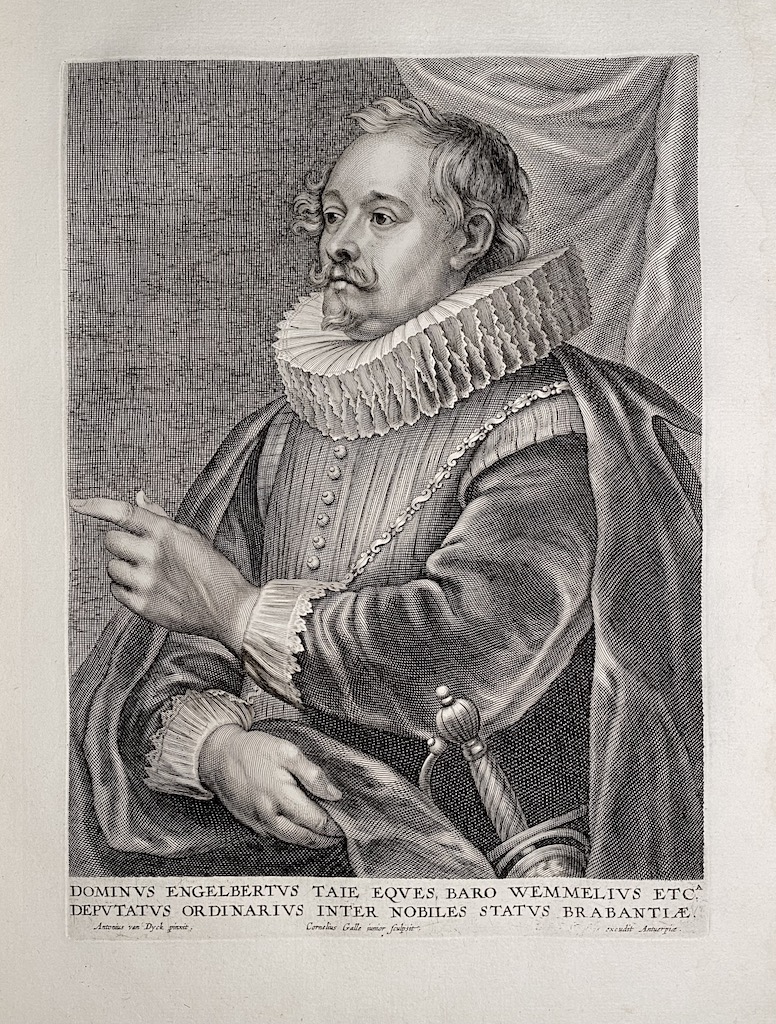
7. Engelbert Taye, Baron of Wemmel (Flemish, ? – 1638); engraved by Cornelis Galle the Younger. “DOMINVS ENGELBERTVS TAIE EQVES, BARO WEMMELIVS ETC.A | DEPVTATVS ORDINARIVS INTER NOBILES STATVS BRABANTIÆ.”. Below: “Antonius van Dyck pinxit”, “Cornelius Galle iunior ∫culpsit” <–> “…excudit Antuerpiæ.”. Second state, with “Ioannes Meyssens” erased. 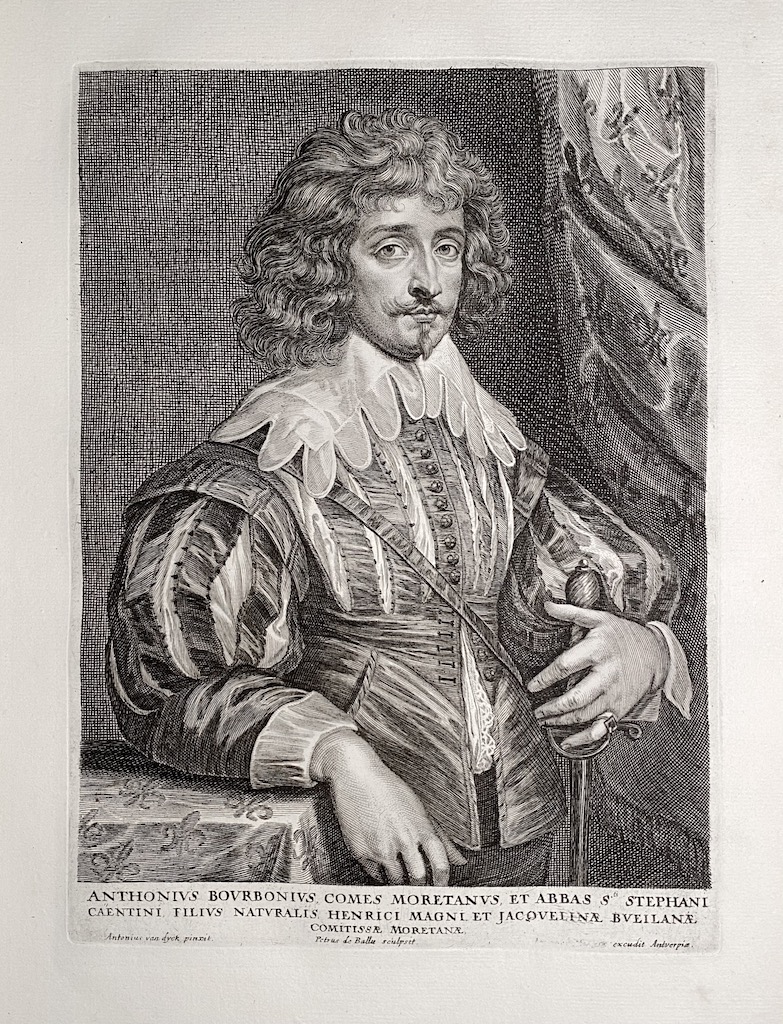
8. Antoine de Bourbon, comte de Moret (French, 1607 – 1632); engraved by Pieter de Bailliu (Flemish, 1613 – after 1660). Inscription: “ATHONIVS BOVRBONIVS, COMES MORETANVS, ET ABBAS S.TI STEPHANI | CAENTINI, FILIVS NATVRALIS, HENRICI MAGNI ET JACQVELINÆ BVEILANÆ | COMITISSÆ MORETANÆ,”. Below: “Antonius van dyck pinxit.” <–> “Petrus de Ballu sculpsit.” <–>“… excudit Antverpiæ.”. Second state with “Ioannes Meyssens” erased. Antoine de Bourbon was the illegitimate son of Henri IV, Roi de France and Jacqueline de Bueil, Comtesse de Moret. 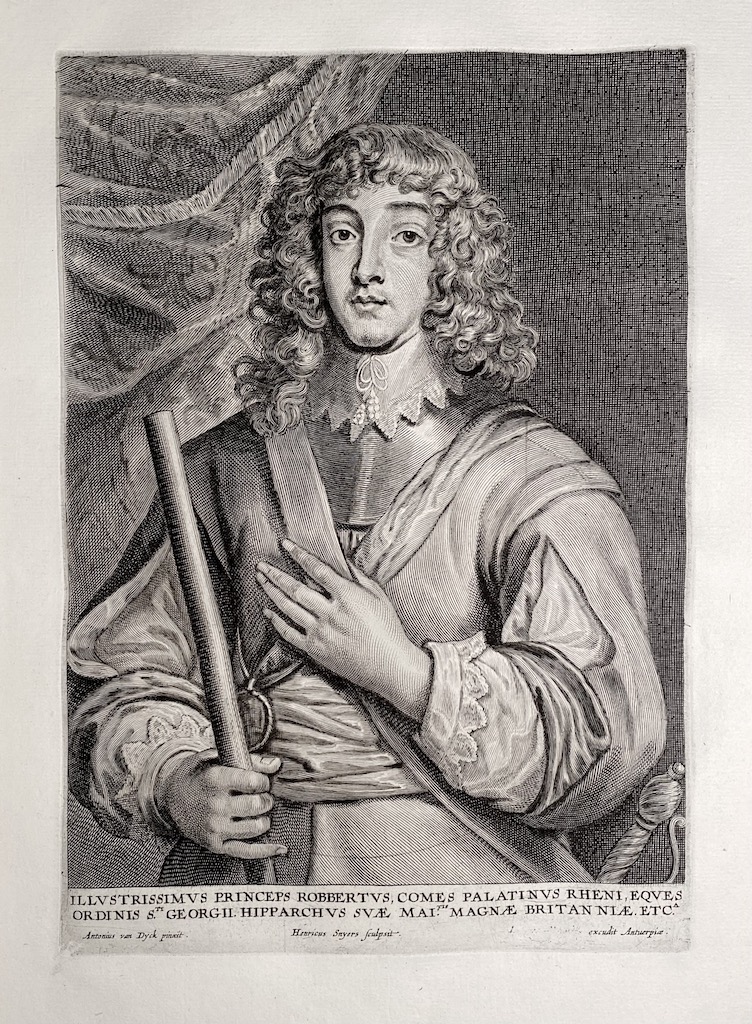
9. Prince Rupert of the Rhine (German, Bohemian, 1619 –1682); engraved by Hendrick Snyers (Flemish, 1611 – 1644). Inscription: “ILLVSTRISSIMVS PRINCEPS ROBBERTVS, COMES PALATINVS RHENI, EQVES | ORDINIS S.TI GEORGII. HIPPARCHVS SVÆ MAI.TIS MAGNÆ BRITANNIÆ. ETC.A”. Below: “Antonius van Dyck pinxit” <–> “Henricus Snyers sculpsit” <–> “...excudit Antuerpiæ.”. Second state with “Ioannes Meyssens” erased. 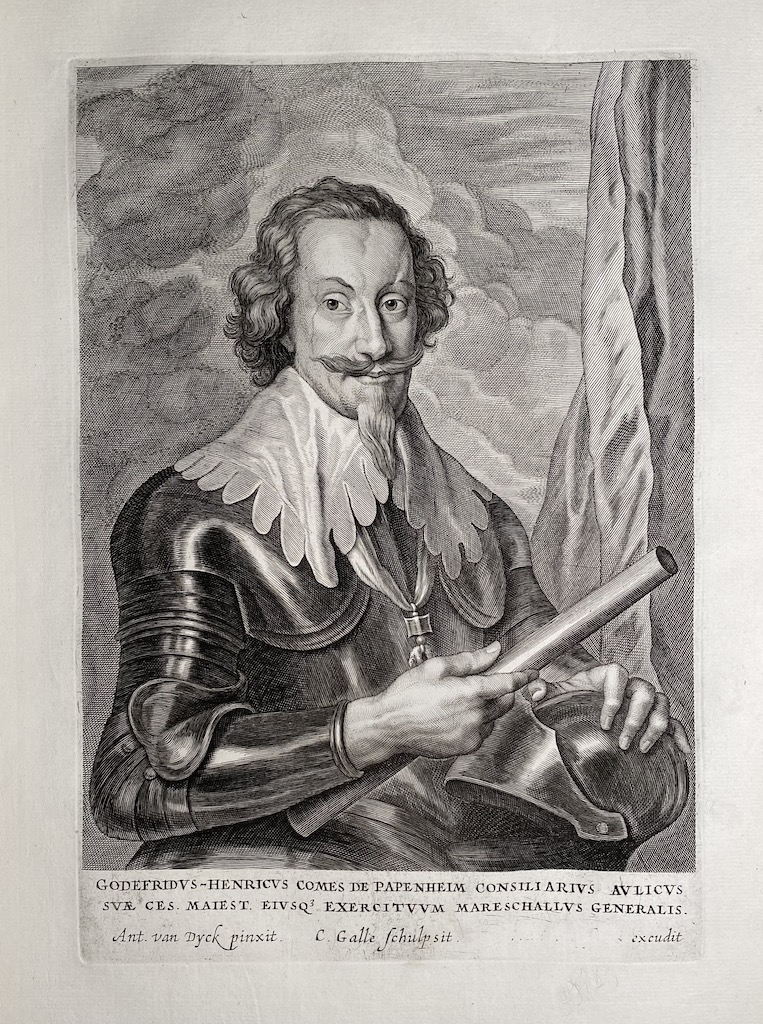
10. Gottfried-Heinrich, Count of Pappenheim; engraved by Cornelis Galle the Younger. Inscription: “GODEFRIDVS-HENRICVS COMES DE PAPENHEIM CONSILIARIVS AVLICVS | SVÆ CES. MAIES. EIVSQ³ EXERCITVVM MARESCHALLVS GENERALIS.” Lettered with production details below: “Ant. van Dyck pinxit” <–> “C. Galle ∫chulpsit.” <–> “…excudit”. Second state with “Ioan. Meyßens” erased. 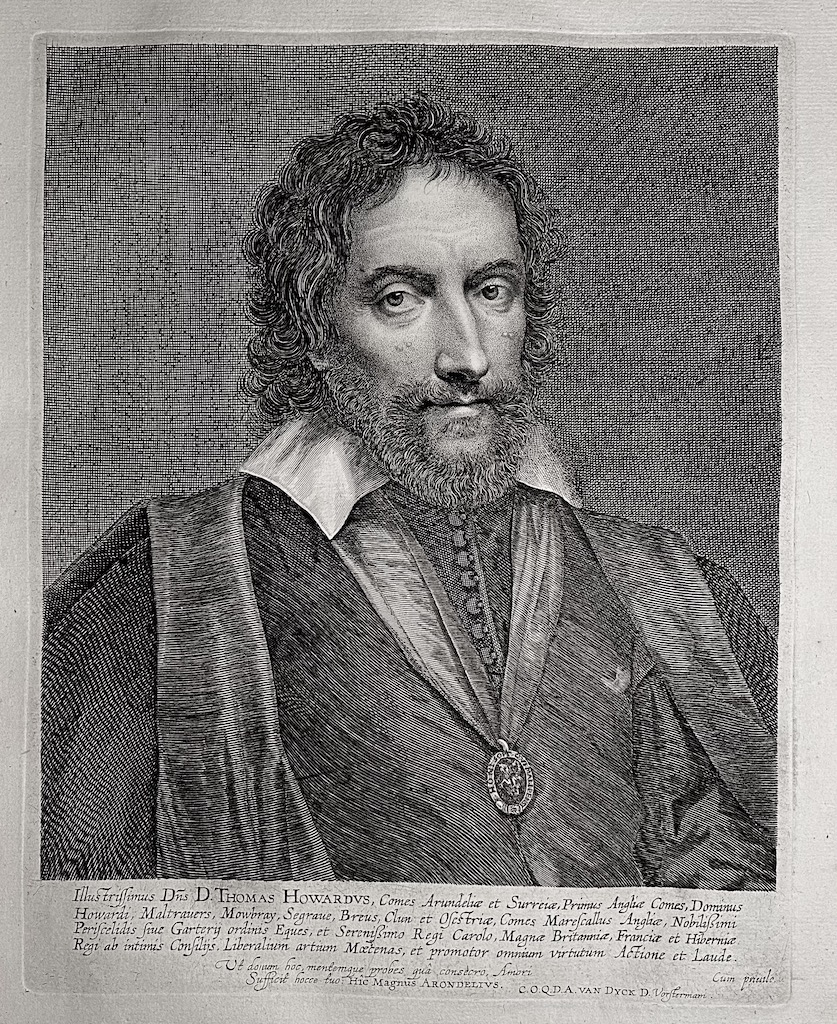
11. Thomas Howard, 14th Earl of Arundel (British, 1585 – 1646); engraved by Lucas Vorsterman the Elder (1595–1675). Inscription: “Illustri∫∫imus Dñs. D.Thomas Howardvs, Comes Arundeliæ et Surreiæ, Primus Angliæ Comes, Dominus | Howardi, Maltrauers, Mowbray, Segraue, Breus, Clun et O∫estriæ, Comes Mare∫callus Angliæ, Nobilißimi | Pericelidis ∫iue Garterij ordinis Eques, et Serenißimo Regi Carolo, Magnæ Britaniæ, Franciæ et Hiberniæ | Regi ab intimis Consilijs, Liberalium artium Mæcenas, et promotor omnion virtutum Actione et Laude.”. Below: “Ut donum hoc, mantenque probes qua consecro, Amori | Sufficit hocci tuo: Hic Magnvs ARONDELIVS”, “C.O.Q.D.A. VAN DYCK D. Vor∫termani.”, “Cum priuile.”. Third state with ‘Opera Vorstermanni’ burnished and two lines of Latin added below the four lines of the title. 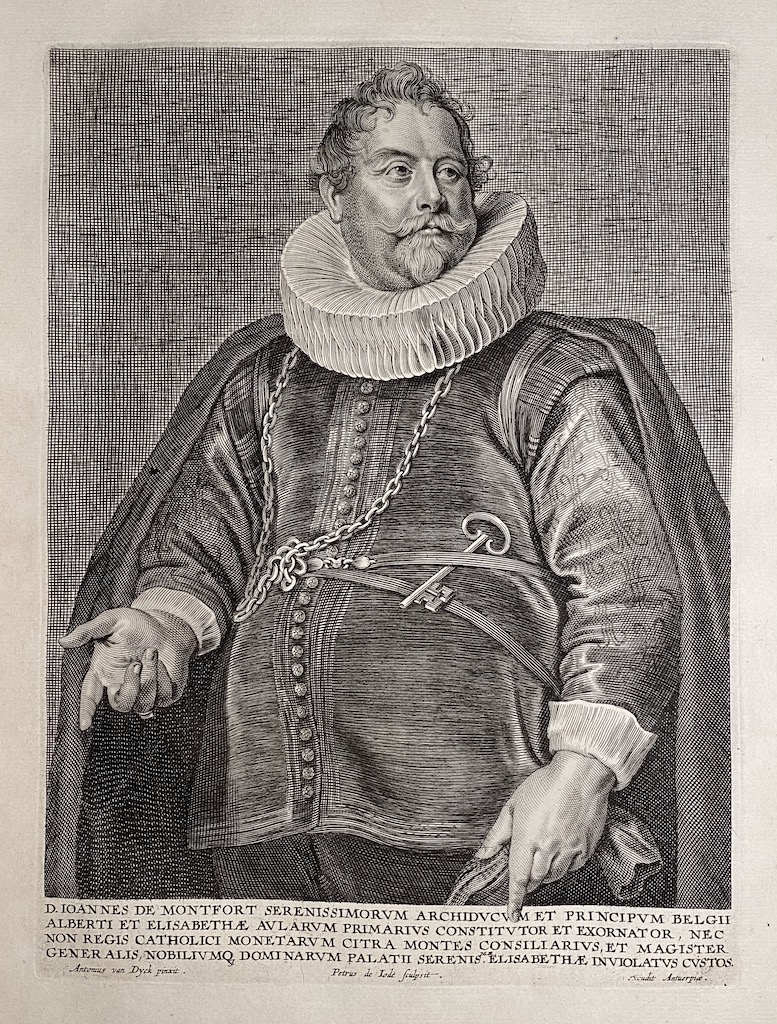
12. Jan van Montfort [Jean de Montfort] (Flemish, 1567 – 1648); engraved by Pieter de Jode II (Flemish, 1606 – 1670/74). Inscription: “D. IOANNES DE MONTFORT SERENISSIMORVM ARCHIDVCVM ET PRINCIPVM BELGII | ALBERTI ET ELISABETHÆ AVLARVM PRIMARIVS CONSTITVTOR ET EXORNATOR, NEC | NON REGIS CATHOLICI MONETARVM CITRA MONTES CONSILIARIVS, ET MAGISTER. | GENERALIS, NOBILIVMQ3 DOMINARVM PALATII SERENIS.MÆ ELISABETHÆ INVIOLATVS CVSTOS.” Below: “Antonius van Dyck pinxit.” <–> “Petrus de Iode sculpsit.” <–> “…excudit Antuerpiæ”. Second state with “Ioannes Meyssens” erased. 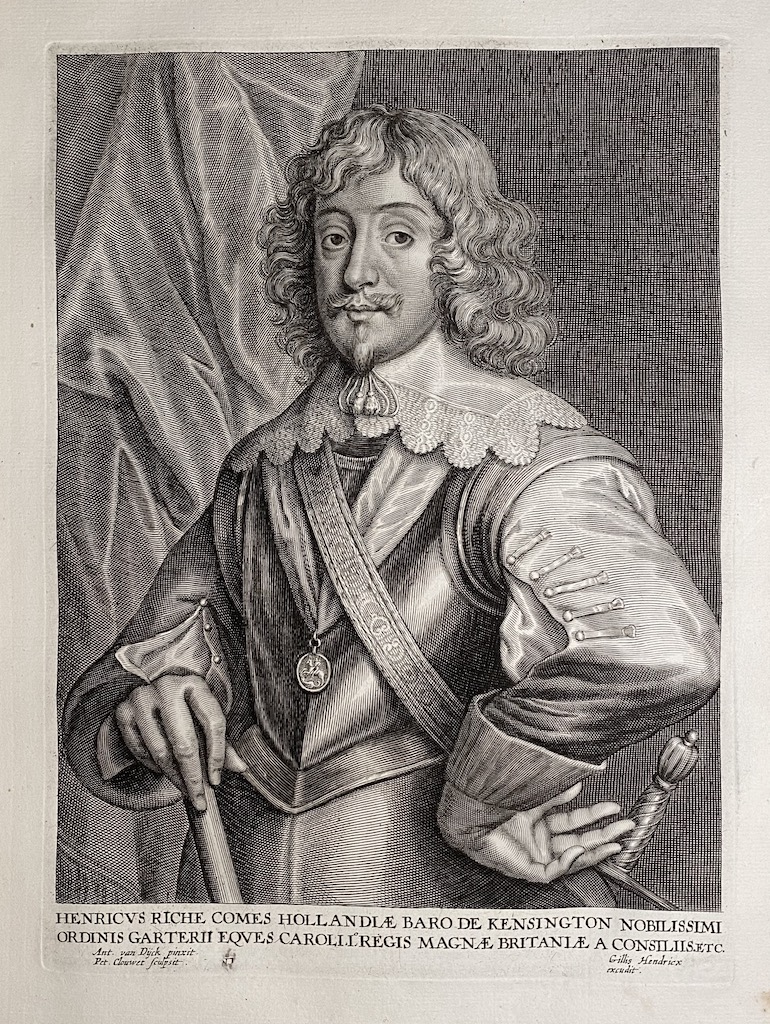
13. Henry Rich, 1st Earl of Holland (British, 1590 – 1649), engraved by Pieter Clouwet (Flemish, 1629 – 1670). Inscription: “HENRICVS RICHE COMES HOLLANDIÆ BARO DE KENSINGTON NOBILISSIMI | ORDINIS GARTERII EQVES CAROLI. LOREGIS MAGNÆ BRITANIÆ A CONSILIIS. ETC.”. Below: “Ant. van Dÿck pinxit.” | “Pet. Clouwet sculpsit” <–> “Gillis Hendricx | excudit”. Third state with the title added and production details re-engraved. 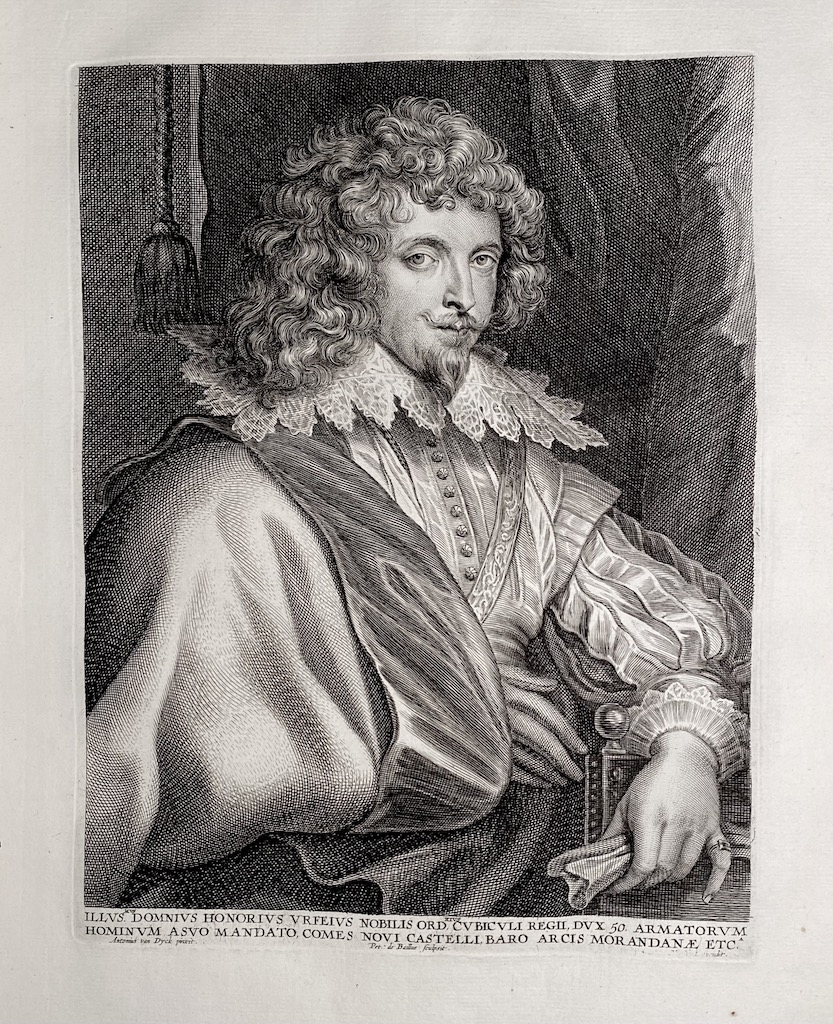
14. Honoré d’Urfé, marquis de Valromey, comte de Châteauneuf (French, 1568 – 1625); engraved by Pieter de Bailliu (Flemish, 1613 – 1660). Inscription: “ILLVS.MVS DOMNIVS HONORIVS VRFEIVS NOBILIS ORD.RIVS CVBICVLI REGII, DVX 50. ARMATORVM | HOMINVM A SVO MANDATO, COMES NOVI CASTELLI, BARO ARCIS MORANDANÆ ETC.A”. Below: “Antonius van Dyck pinxit” <–> “Pet. de Bailliue sculpsit.” <–> “… excudit”. Second lettered state with title and production details, with “Ioannes Meyssens” erased. [There is another copy in this binding, №54, where Ioannes Meysens' name is in place]. 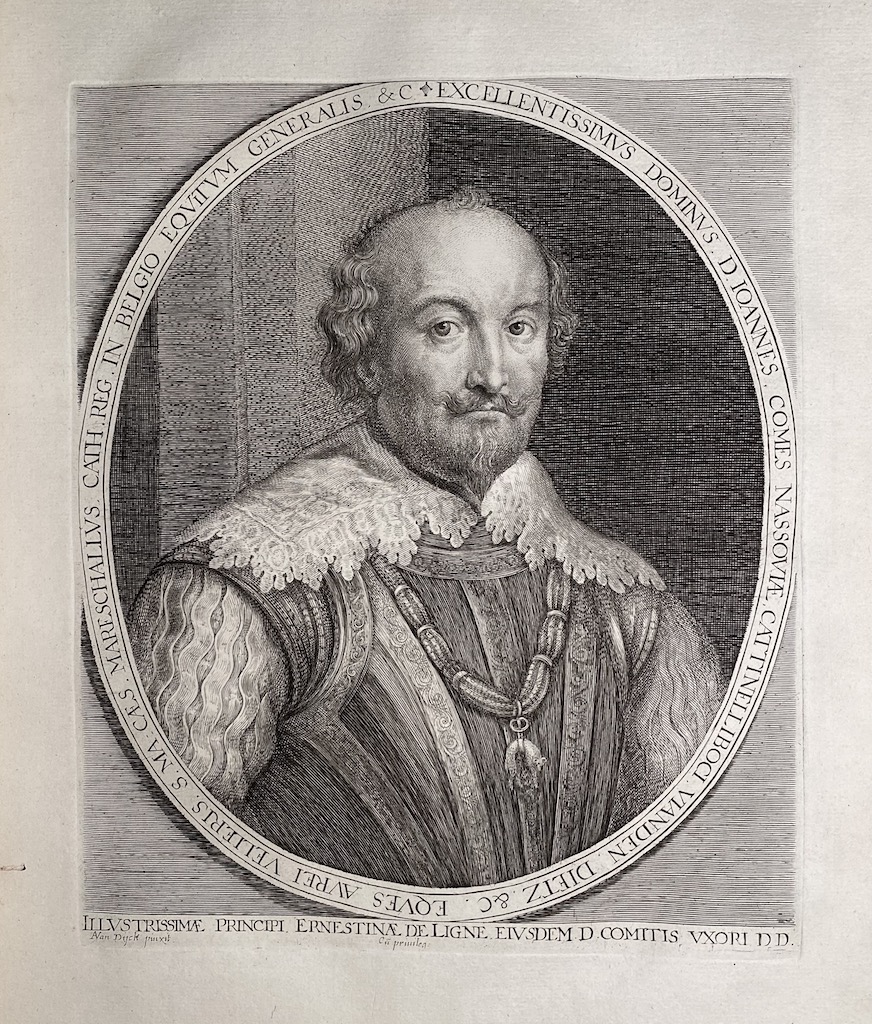
15. Johannes [John VIII], Count of Nassau-Siegen (German, 1583 – 1638); engraved by Lucas Vorsterman I (Flemish, 1595 – 1675). Inscription: in the oval around the portrait “EXCELLENTISSIMVS DOMINVS: D. IOANNES, COMES NASSAOVIÆ, CATTNELLIBOCI: VIANDEN, DIETZ, &C. EQVES AVREI VELLERIS. S. MA: CÆS, MARESCHALIVS, CATH. REG. IN BELGIO. EQVITVM GENERALIS. &C”, in lower margin: “ILLVSTRISSIMÆ PRINCIPI ERNESTINÆ DE LIGNE EIVSDEM D. COMITIS VXORI DD.”, and “AVan Dÿck pinxit.” <–> “Cu Priuleg”. Fourth state with Vorsterman’s address burnished. [For the third state with “Lucas Vorsterman exc” present see № 55]. 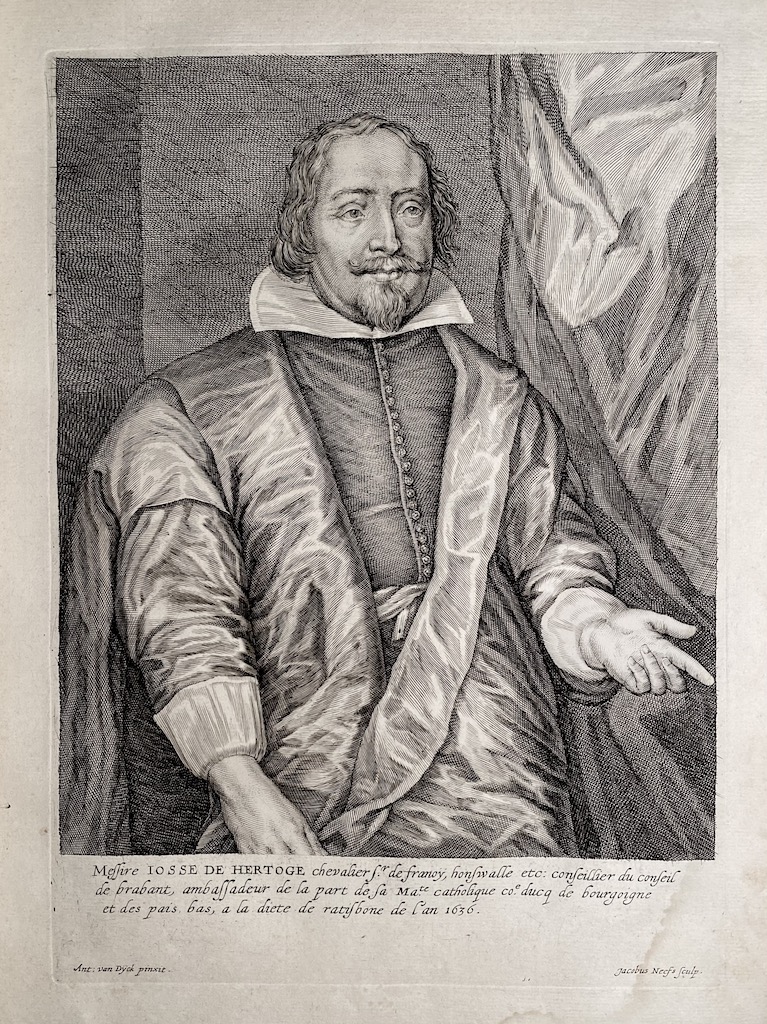
16. Joost de Hertoghe (Flemish, ? –1638); engraved by Jacobus Neefs. Inscription: "Me∫∫ire IOSSE DE HERTOGE chevalier ∫.r de franoÿ, hon∫walle etc: con∫eillier du conseil | de brabant, amba∫∫adeur de la part de ∫a Ma.te catholique co.e ducq de bourgoigne | et des pais bas, a la diete de rati∫bone de l'an 1636." In Lower margine: "Ant: van Dÿck pinxit.", <–>"Jacobus Neefs ∫culp.". Second, lettered state with the title and production details added. 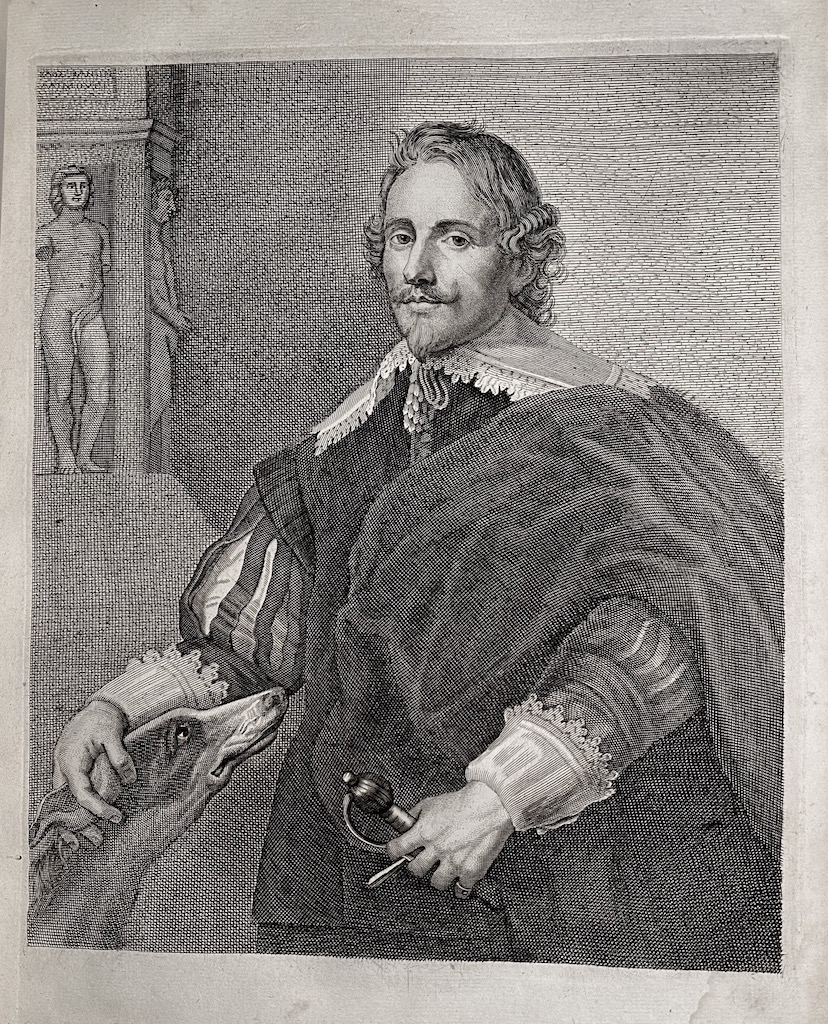
17. Philippe Le Roy (Flemish, 1596 – 1679). No inscription. The printmaker is unidentified but is possibly Adriaen Lommelin. The print is a copy of the print by Vorsterman and Pontius. 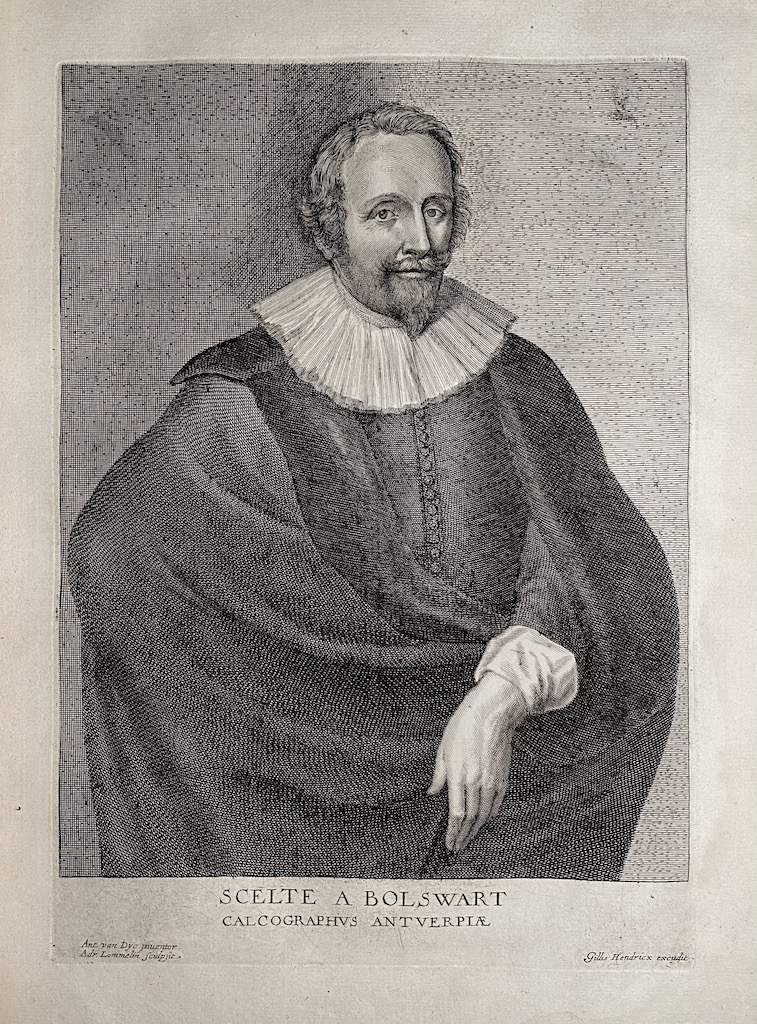
18. Schelte Adamsz. Bolswert (Flemish, c. 1586 – 1659); engraved by Adriaen Lommelin, published by Gillis Hendricx. Inscription: “SCELTE A BOLSWART | CALCOGRAPHVS ANTVERPIÆ”. In lower margin: “Ant. van Dÿc inuentor | Adr. Lommelin sculpsit” <–> “Gillis Hendricx excudit”. Third state with an entirely different head, title and production details added. 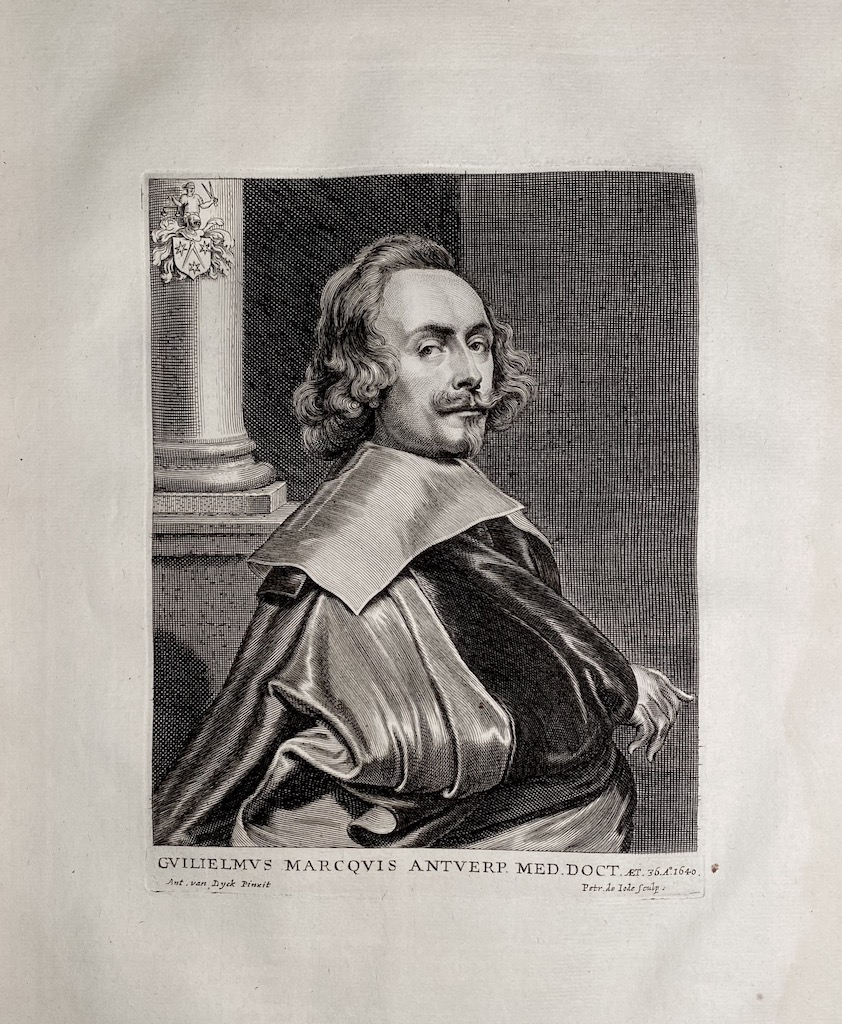
19. Willem Marquis (Flemish, 1604 – 1640); engraved by Pieter de Jode II. Inscription: “GVILIELMVS MARCQUIS ANTVERP. MED. DOCT. ÆT. 36.A.O 1640.” In lower margin: “Ant. van Dyck Pinxit” <–> “Petr. de Iode sculp.”. Second, lettered state with Borreken’s name burnished and replaced by Van Dyck’s. 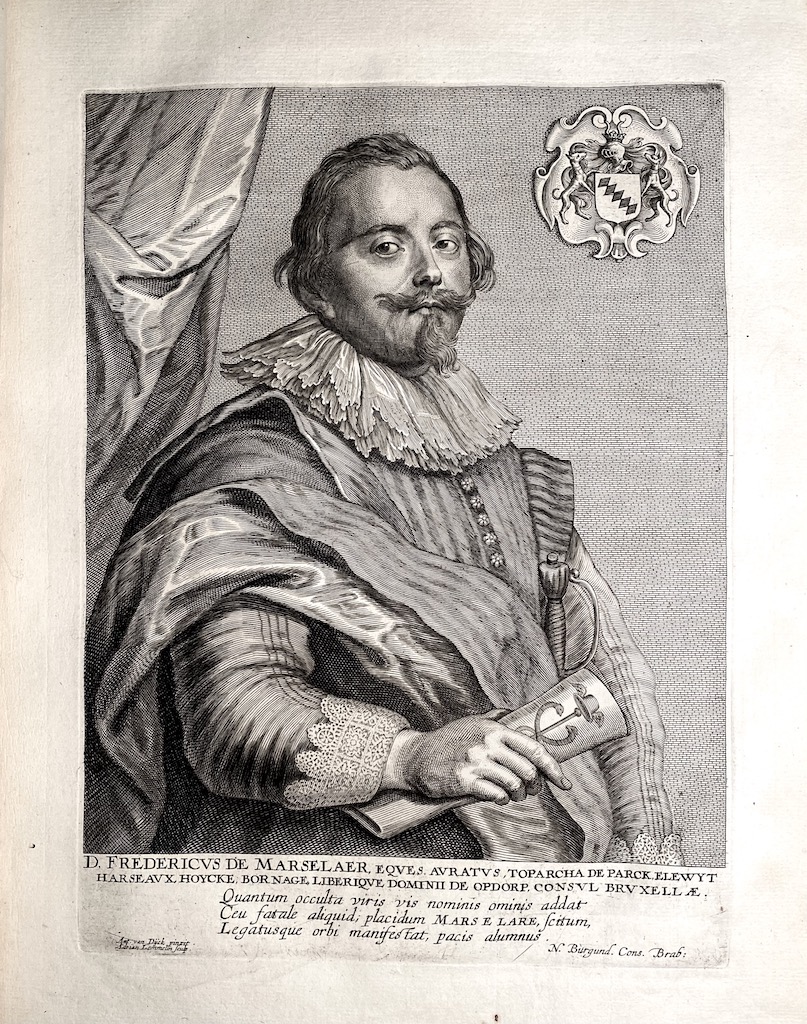
20. Frederik de Marselaer (Flemish, 1584 – 1670); engraved by Adriaen Lommelin. Inscription: “D. FREDERICVS DE MARSELAER, EQVES AVRATVS, TOPARCHA DE PARCK, ELEWYT | HARSEAVX, HOYCKE, BORNAGE, LIBERIQUE DOMINII DE OPDORP, CONSVL BRVXELLÆ.” Three lines of verse below: “Quantum occulta viris vis nominis ominis addat | Ceu fatale aliuid; placidum Mars E Lare, scitum, | Legatusue orbi manifestat, pacis alumnus.”. In lower margin: “Ant. van Dÿck pinxit | Adrian Lommelin sculpsit” <–> “N. Burgund. Cons. Brab:”. Third state with the roll of paper rounded. 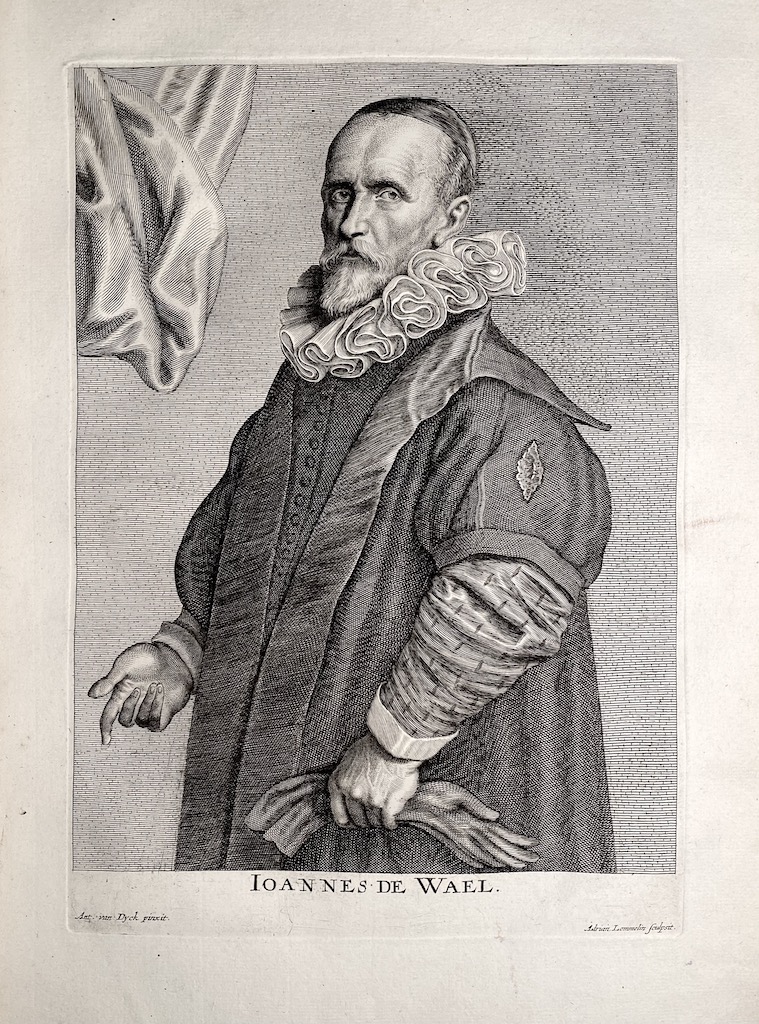
21. Jan Baptist de Wael I (Flemish, 1558 – 1633); engraved by Adriaen Lommelin. Inscription: “IOANNES DE WAEL.”. In lower margin: “Ant. van Dyck pinxit.”<–> and “Adrian Lommelin sculpsit.”. Second, lettered state with the title and production details. British Museum № 1872,1012.4168. 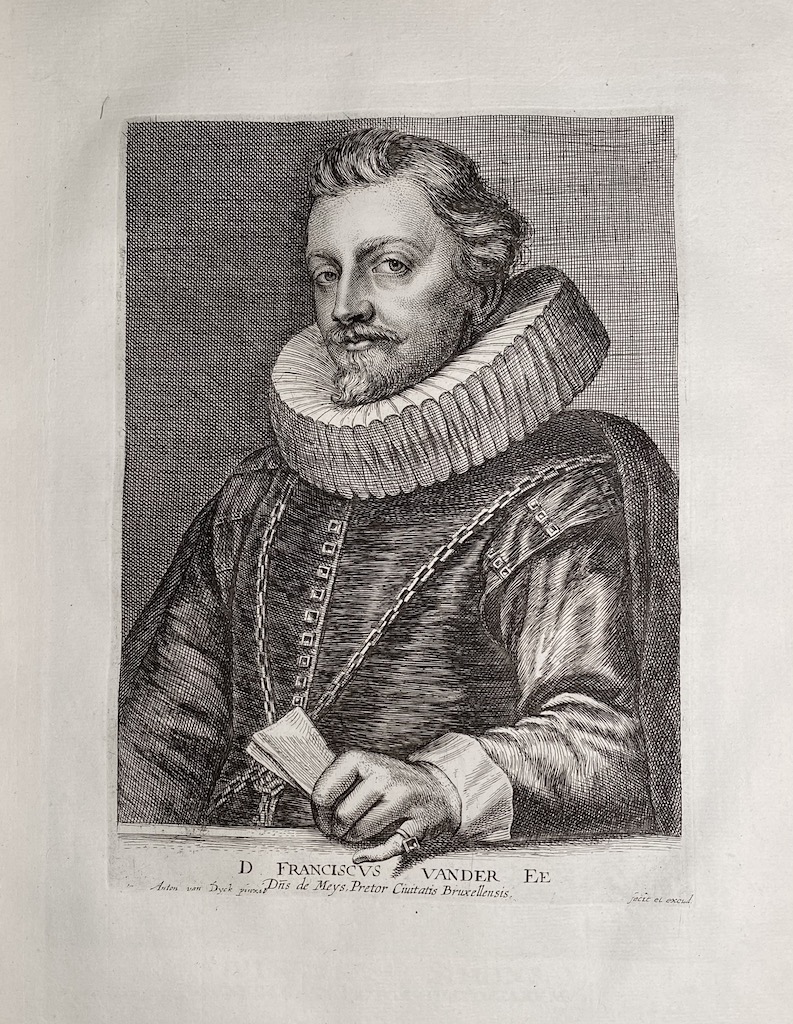
22. François van der Ee (Flemish, ? – 1645); engraved and published by Johannes Meyssens. Inscription: “D . FRANCISCVS VANDER EE | Dñs de Meys, Pretor Ciuitatis Bruxellensis”. In lower margin: “Anton van Dyck pinxit”, and “fecit et excud.”. Fourth, lettered state, finished with the burin, with second line added to the title, with address “Ioannes Meyssens” almost completely burnished. 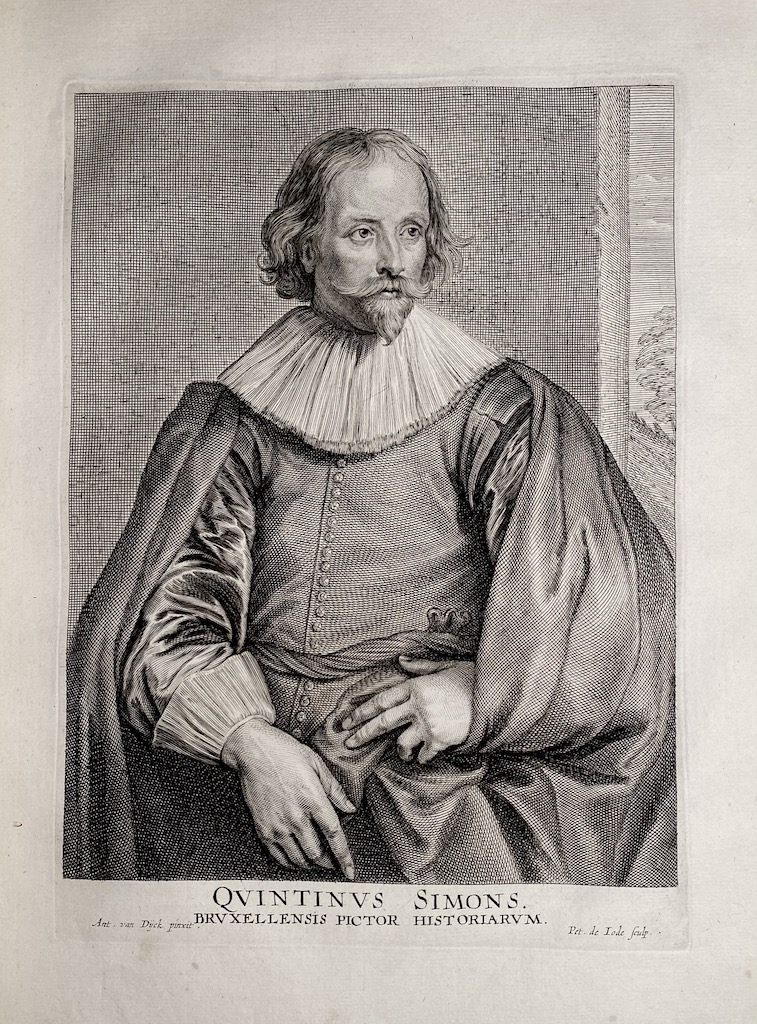
23. Quintijn Simons (Flemish, 1592 – after 1634); engraved by Pieter de Jode II. Inscription: “QVINTINVS SIMONIS. | BRVXELLENSIS PICTOR HISTORIARVM.”. In lower margin: “Ant. van Dijck pinxit.” <–> “Pet. de Iode sculp.”. Third state with second line of title added. 
24. Adriaan Stevens (Flemish, 1561 – 1640); engraved by Adriaen Lommelin. Inscription: "INTEGERRIMVS VIR ADRIANVS STEVENS / S.P.Q. ANTVERP. AB ELEMOSYNIS.". In lower margin:"Ant van Dÿc pinxit." <–> "A. Lommelin sculp.". British Museum # R,1b.20. 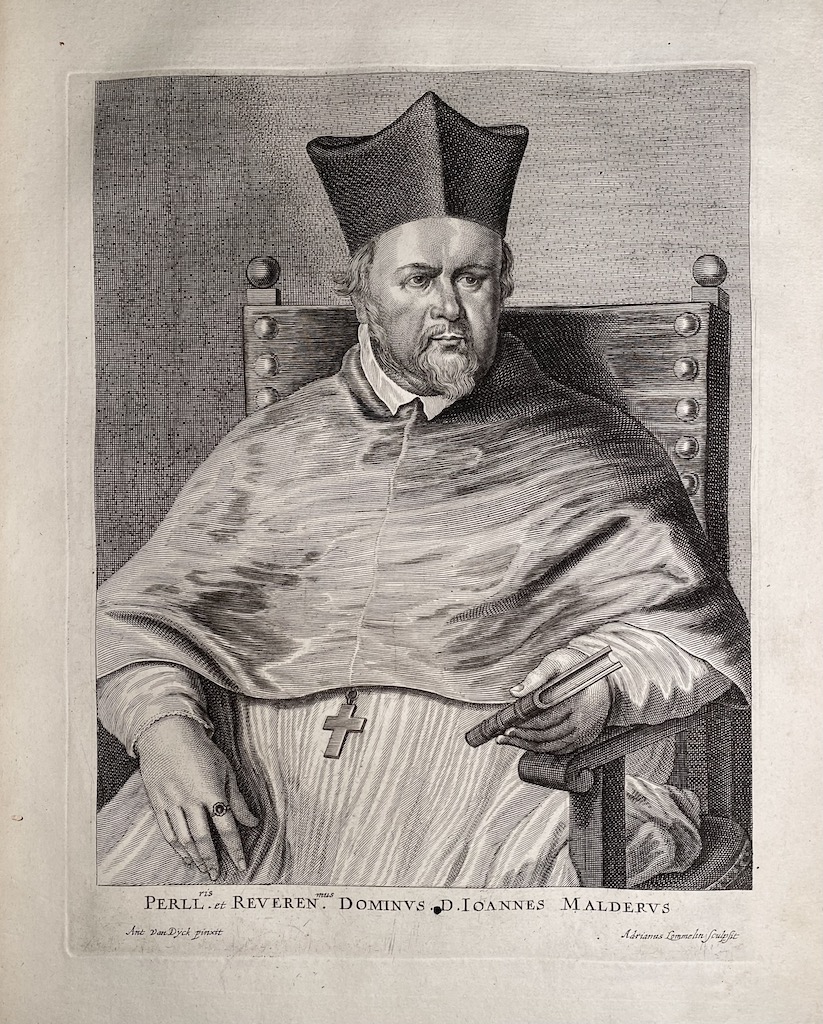
25. Jan van Malderus (Flemish, 1563 – 1633); engraved by Adriaen Lommelin. Inscription: “PERLL.ris et REVEREN.mus DOMINVS. D. IOANNES MALDERVS”. In lower margin: “Ant Van Dÿck pinxit” <–> “Adrianus Lommelin sculpsit”. 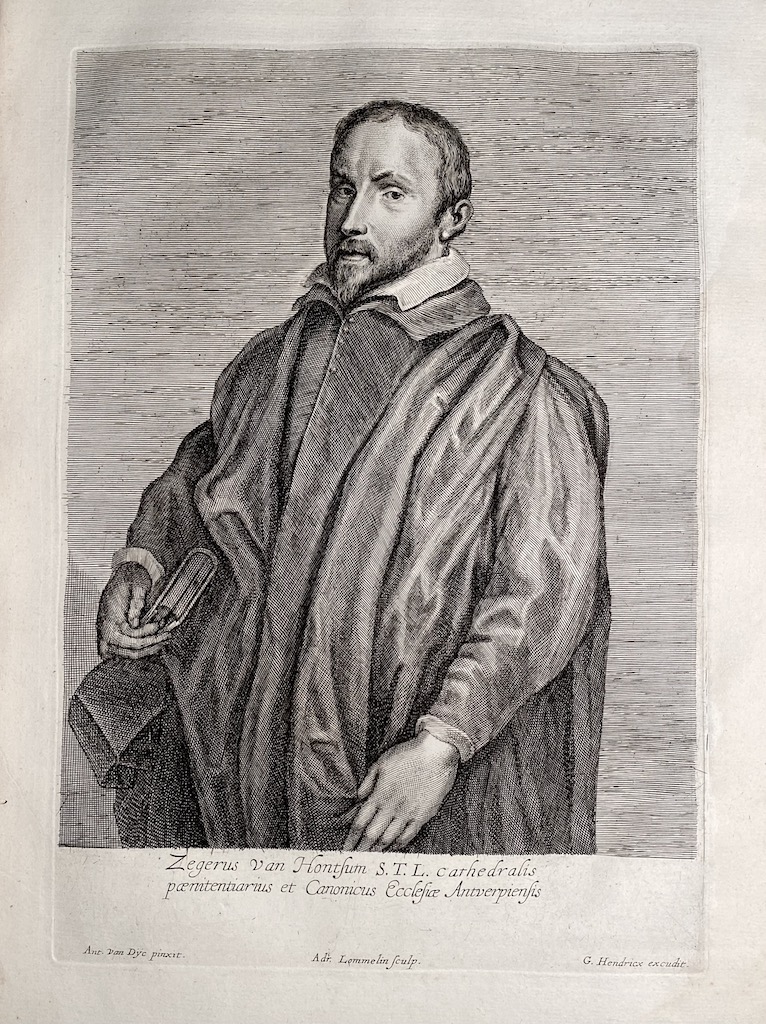
26. Zeger van Hontsum (Flemish, ? – -1643). Engraved by Adriaen Lommelin, published by Gillis Hendricx. Inscription: “Zegerus van Hontsum S.T.L. cathedralis | pænitentiarius et Canonicus Ecclesiæ Antuerpiensis”. In lower margin: “Ant. van Dÿc pinxit” <–> “Adr. Lommelin sculp.” <–> “G. Hendricx excudit”. 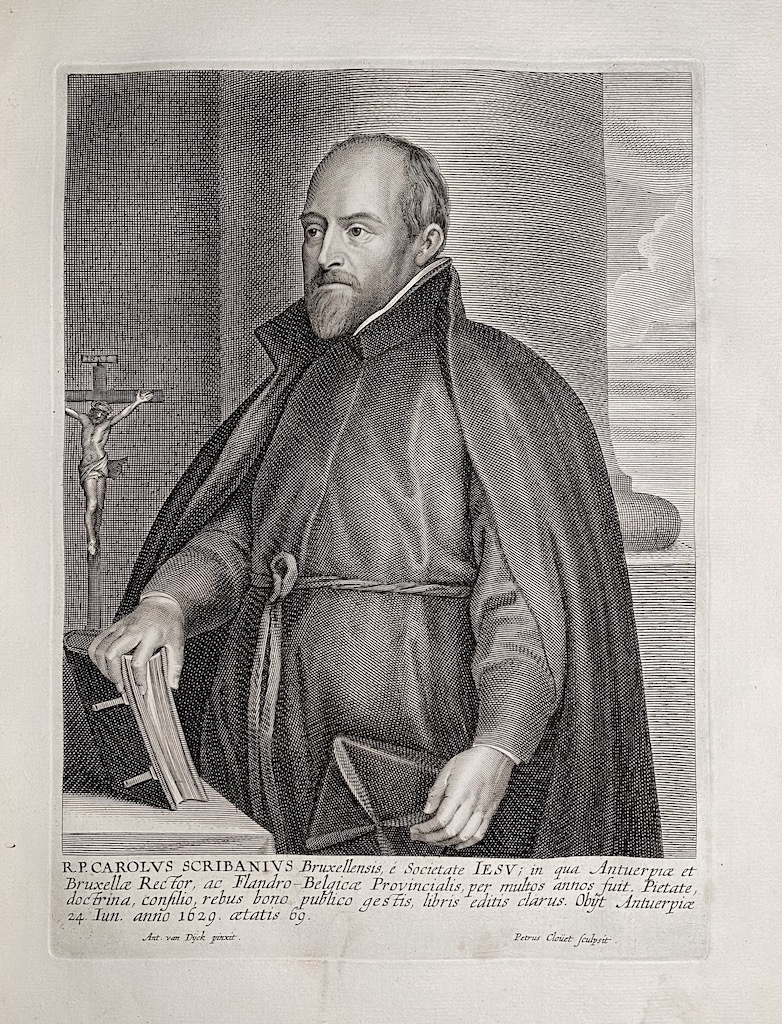
27. Carolus Scribani (Flemish, 1561 – 1629); engraved by Pieter Clouwet. Inscription: “R. P. CAROLVS SCRIBANIVS Bruxellensis, é Societate IESV; in qua Antuerpiæ et I Bruxellæ Rector, ac Flandro-Belgicæ Provincialis, per multos annos fuit. Pietate, | doctrina, consilio, rebus bono publico gestis, libris editis clarus. Obijt Antverpiæ | 24. Iun. anno 1629. ætatis 69.”. In lower margin: “Antonius van Dÿck pinxit.” <–> “Petrus Cloüet Sculpsit.”. Second, lettered state with the title and production details. 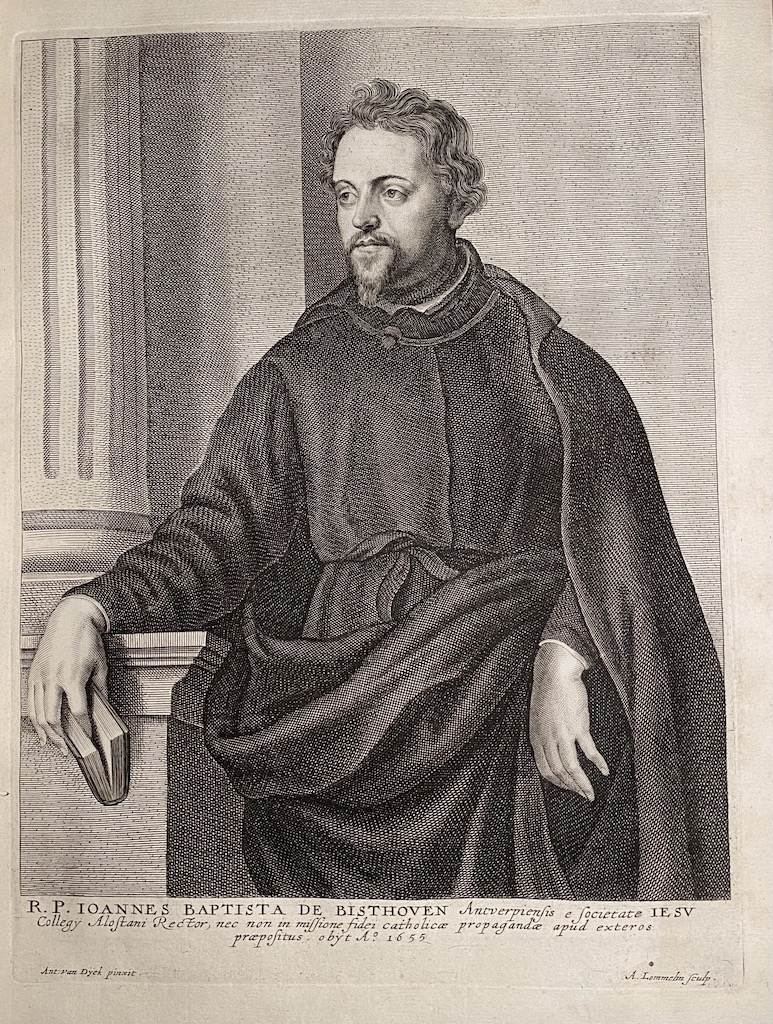
28. Jan Baptist van Bisthoven (Flemish, 1602 – 1655); engraved by Adriaen Lommelin. Inscription: “R.P. IOANNES BAPTISTA DE BISTHOVEN Antverpiensis e societate IESV | Collegÿ Alostani Rector, nec non in missione fidei catholicæ propagandæ apud exteros | præpositus obÿt A.o 1655”. In lower margin: “Ant:van Dÿck pinxit”, and “A. Lommelin sculp”. Second, lettered state with the title and production details. 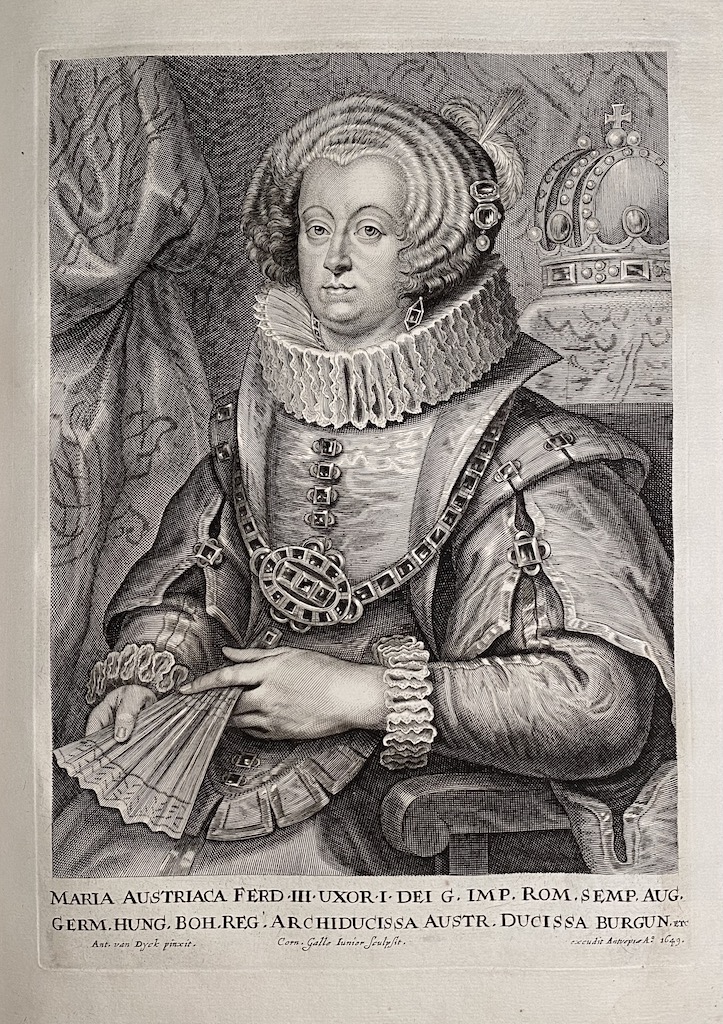
29. Maria of Austria (Spanish, 1606 – 1646); engraved by Cornelis Galle the Younger, published by Johannes Meyssens. Inscription: “MARIA AUSTRIACA FERD. III. UXOR. I. DEI G. IMP. ROM. SEMP. AUG. | GERM. HUNG. BOH. REG. ARCHIDUCISSA AUTR. DUCISSA BURGUN. ETC”. In lower margin: “Ant. van Dyck pinxit.” <–> “Corn. Galle Iunior sculpsit.” <–> “...excudit Antuerpiæ A.o 1649”. Third, lettered state with Meyssens’ name burnished badly. 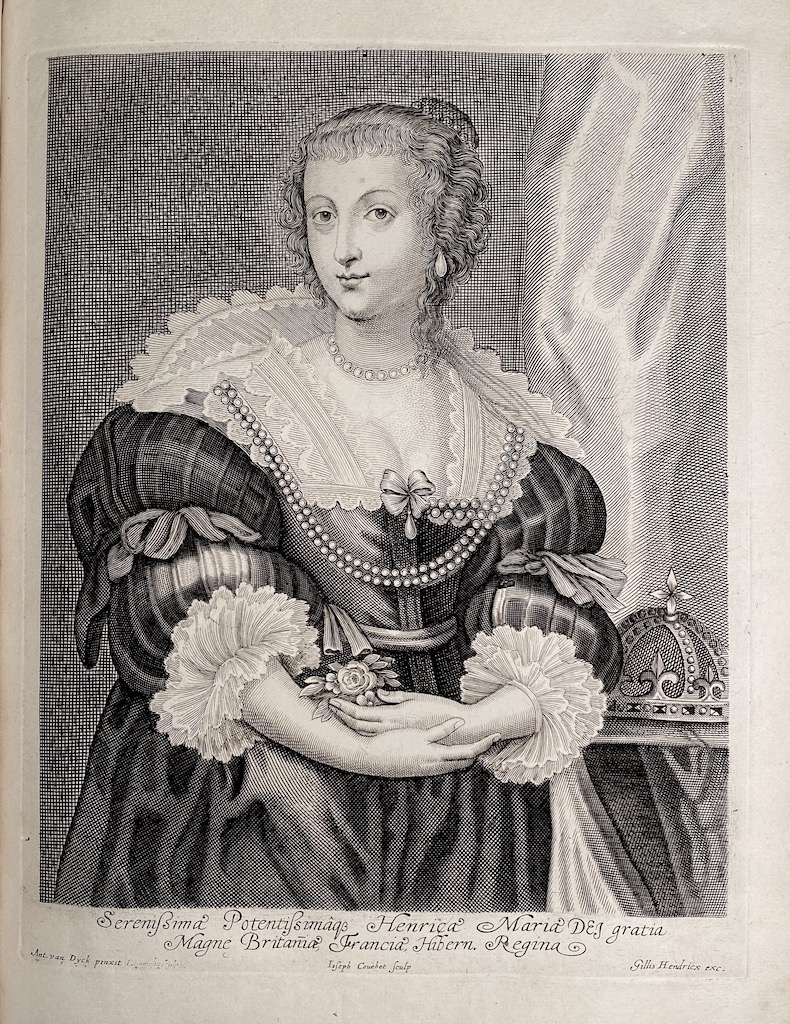
30. Henriette Marie de Bourbon, Queen of Charles I (French, 1609 – 1669); engraved by Antoine Couchet and Adriaen Lommelin, published by Gillis Hendricx. Inscription: “Serenißima Potenti∫simâq Henrica Maria Dei gratia | Magne Britaniæ, Franciæ, Hibern. Regina”. In lower margin: “Ant. van Dyck pinxit” <–> “Ioseph Couchet sculp” <–> “Gillis Hendricx exc.”. State with “Lommelin sculp.” right after “Ant. van Dyck pinxit” burnished, but still legible. 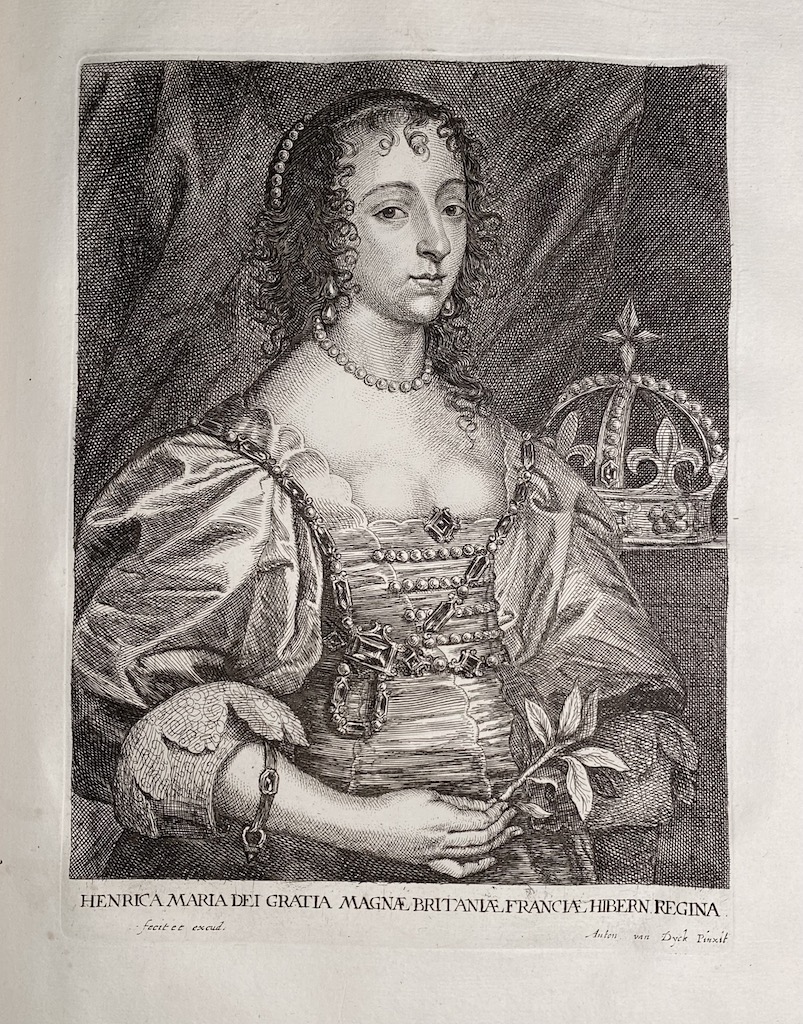
31. Henriette Marie de Bourbon, engraved and published by Ioannes Meyssens. Inscription: “HENRICA MARIA DEI GRATIA MAGNÆ BRITANIÆ FRANCIAÆ HIBERN. REGINA.”. In lower margin: “fecit et excud.” <–> “Anton van Dyck Pinxit”. Third state, finished with a burin; with Meyssens’ name burnished. [Similar to print №62 which has "Ioan. Mey∫ens" signature present]. 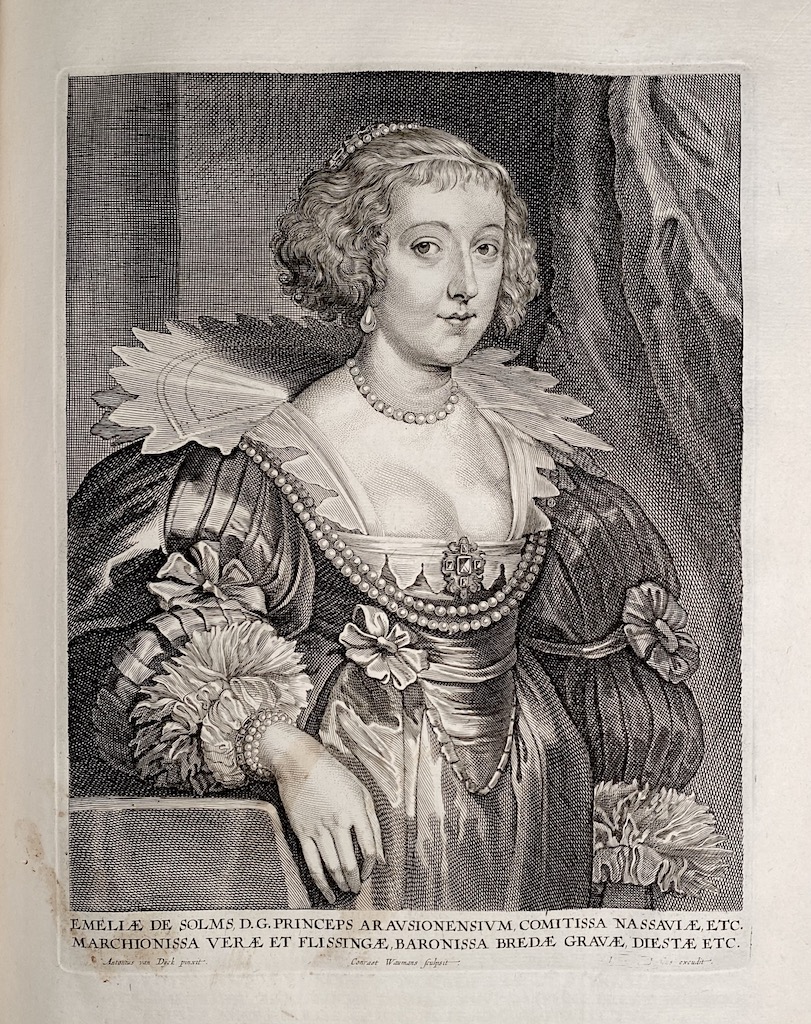
32. Amalia van Solms, Princess of Orange (German, 1602 – 1675), engraved by Conraad Waumans and published by Johannes Meyssens. Inscription: “EMELIÆ DE SOLMS, D. G. PRINCPES ARAVSIONENSIVM, COMITISSA NASSAUVIÆ, ETC. | MARCHIONISSA VERÆ ET FLISSINGÆ, BARONISSA BREDÆ, GRAVÆ, DIESTÆ ETC.”. In lower margin: “Antonius van Dijck pinxit.” <–> “Conraet Waumans sculpsit.” <–> “… excudit”. First, lettered state with the title and production details, with Meyssens’ name burnished. [Similar to №66, which has Ioannes Meysens name present]. 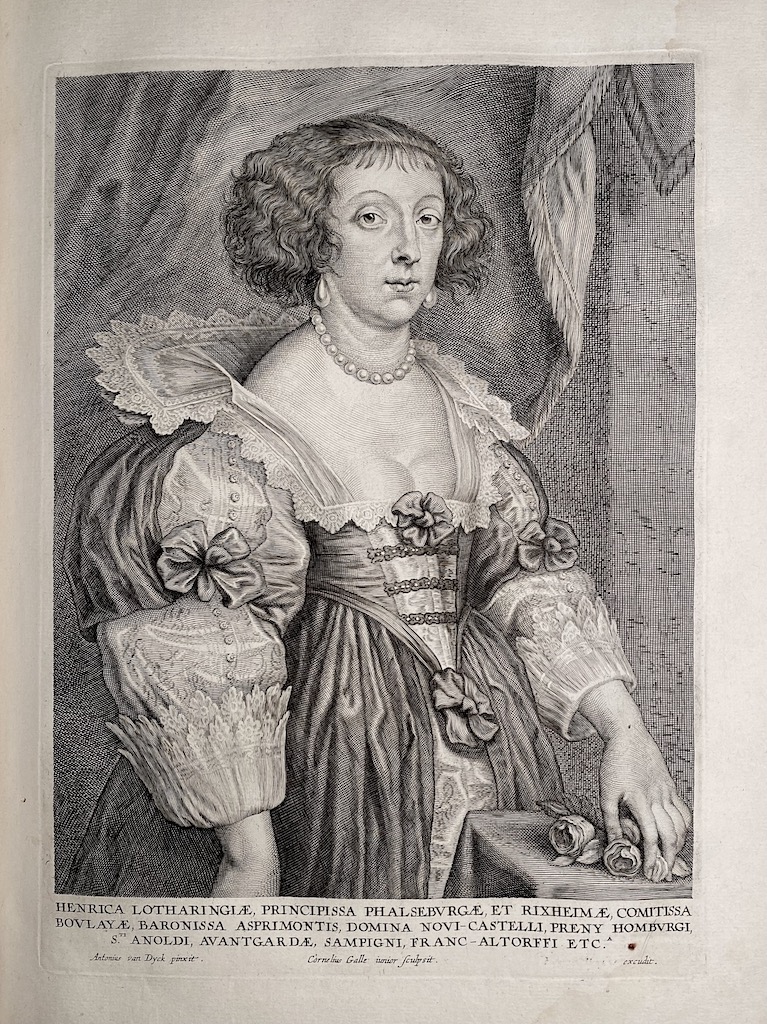
33. Henriette de Lorraine, Princess of Phalsbourg (or Pfalzburg) (French, 1605 – 1660); engraved by Cornelis Galle the Younger, published by Ioannes Meyssens. Inscription: “HENRICA LOTHARINGIÆ, PRINCIPISSA PHALSEBVRGÆ, ET RIXHEIMÆ, COMITISSA | BOVLAYÆ, BARONISSA ASPIRIMONTIS, DOMINA NOVI-CASTELLI, PRENY | HOMBVRGI, S.TI ANOLDI, AVANTGARDÆ, SAMPIGNI, FRANC-ALTORFFI ETC.A”. In lower margin: “Antonius van Dyck pinxit.” <–> “Cornelius Galle iunior sculpsit.” <–> “… excudit.”. First state with the title and production details, with Ioannes Meyssens’ name burnished. British Museum # R,1a.248. 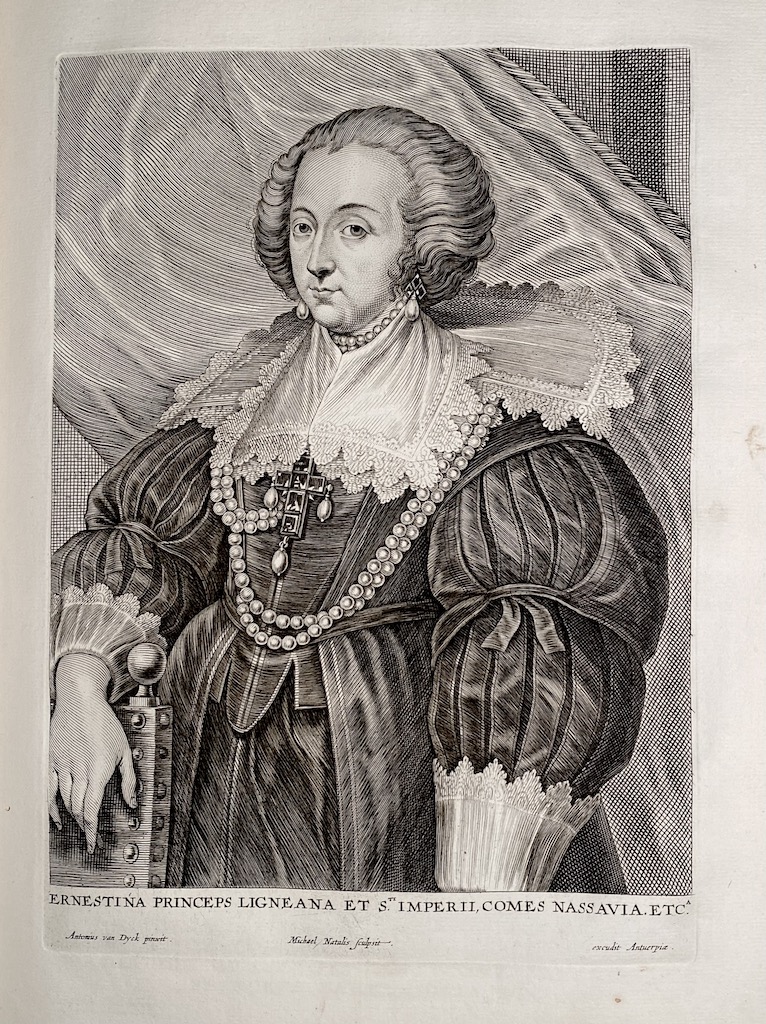
34. Ernestine Yolande de Ligne, Countess of Nassau-Siegen (Flemish, 1594 – 1668); engraved by Michiel Natalis, published by Jan Meyssens. Inscription: “ERNESTINA PRINCEPS LIGNEANA ET S.TI IMPERII, COMES NASSAVI. ETC.A”. In lower margin: “Antonius van Dyck pinxit.” <–> “Michael Natalis sculpsit.” <–> “…excudit Antuerpiæ.”. Second state with the initials of Ioannes Meyssens erased. 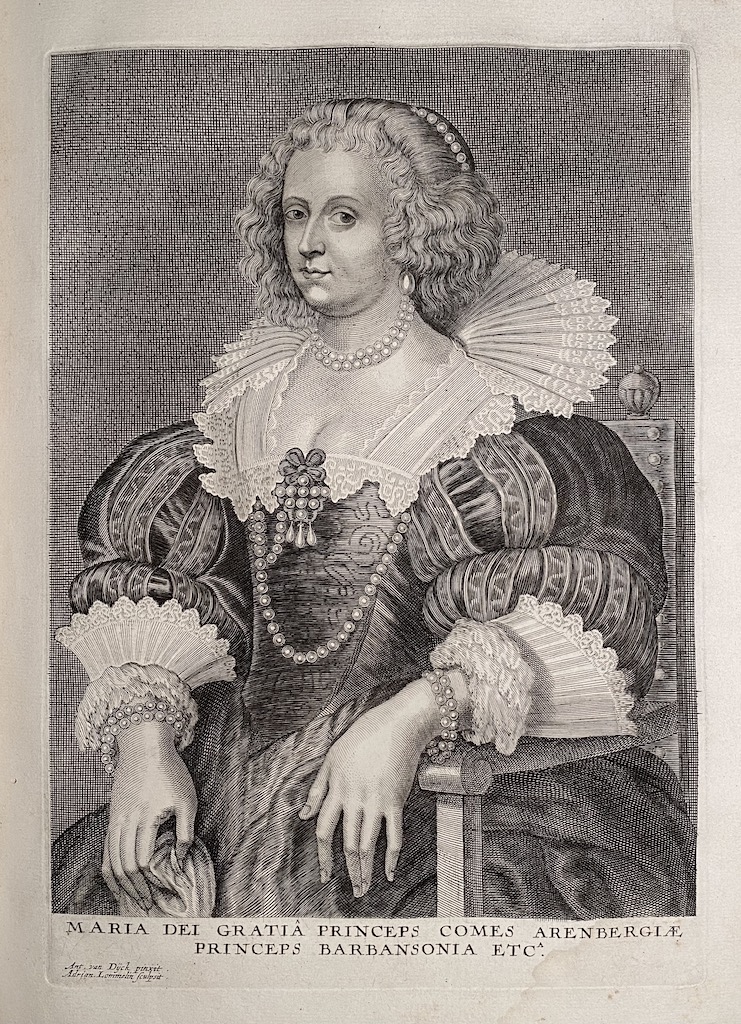
35. Marie de Barbançon, Princess of Arenberg (1602 – 1675); engraved by Adriaen Lommelin. Inscription: “MARIA DEI GRATIÂ PRINCEPS COMES ARENBERGIÆ | PRINCEPS BARBASONIA ETC.A”. In lower margin: “Ant. van Dÿck pinxit. | Adrian. Lommelin sculpsit.”. Second, lettered state with title and production details and adjustments made in the face. British Museum # 1876,1014.181 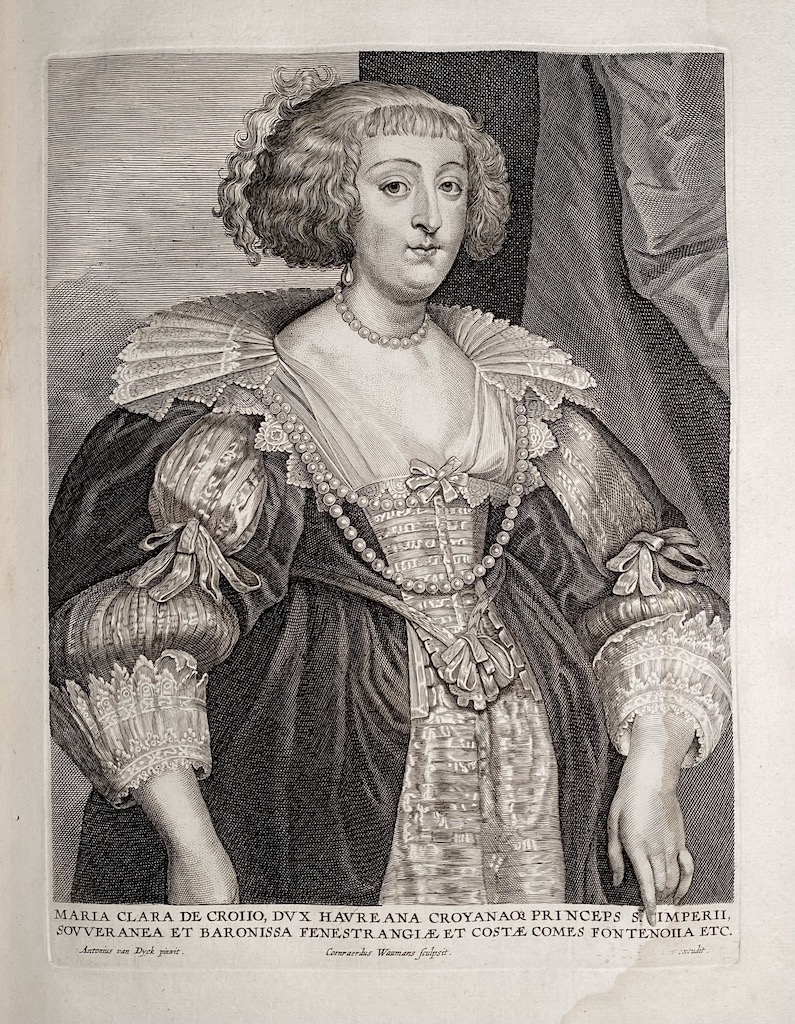
36. Marie-Claire de Croy, Duchess of Havré (Flemish, 1605 – 1664); engraved by Conraad Waumans, published by Ioannes Meyssens. Inscription: “MARIA CLARA DE CROIIO, DVX HAVREANA CROYANAQ3 PRINCEPS STE. IMPERII, | SOVVERANEA ET BARONISSA FENESTRANGIÆ ET COSTÆ COMES FONTENOIIA ETC.”. In lower margin: “Antonius van Dyck pinxit.” <–> “Coenraerdus Waumans sculpsit.” <–> “…excudit.”. Third state with Ioannes Meyssens’ name burnished. British Museum # 1891,1015.21. [Similar to №64, which has Ioannes Meysens’ name present]. 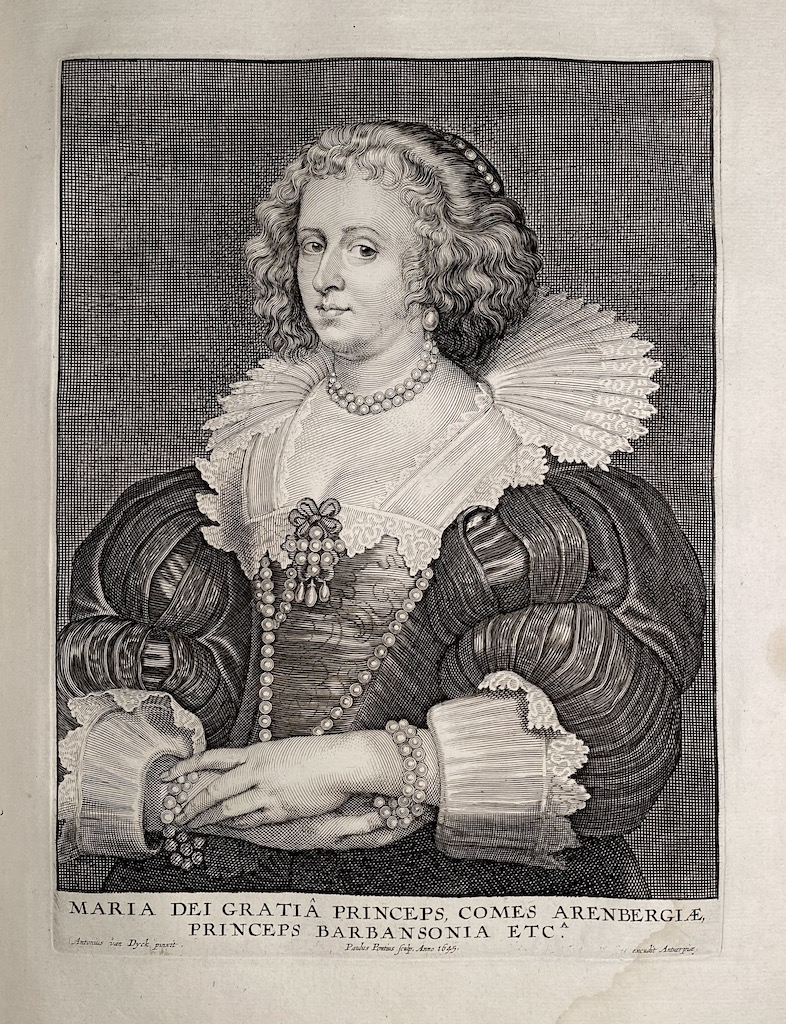
37. Marie de Barbançon, Princess of Arenberg (1602 – 1675); engraved by Paulus Pontius, published by Ioannes Meyssens. Inscription: “MARIA DEI GRATIÂ PRINCEPS COMES ARENBERGIÆ, | PRINCEPS BARBASONIA ETC.A”. In lower margin: “Antonius van Dyck pinxit. | Paulus Pontius sculp. Anno 1645.” <–> “… excudit Antuerpiæ”. Second state with a thick borderline, title and production details added, Ioannes Meyssens’s name burnished. 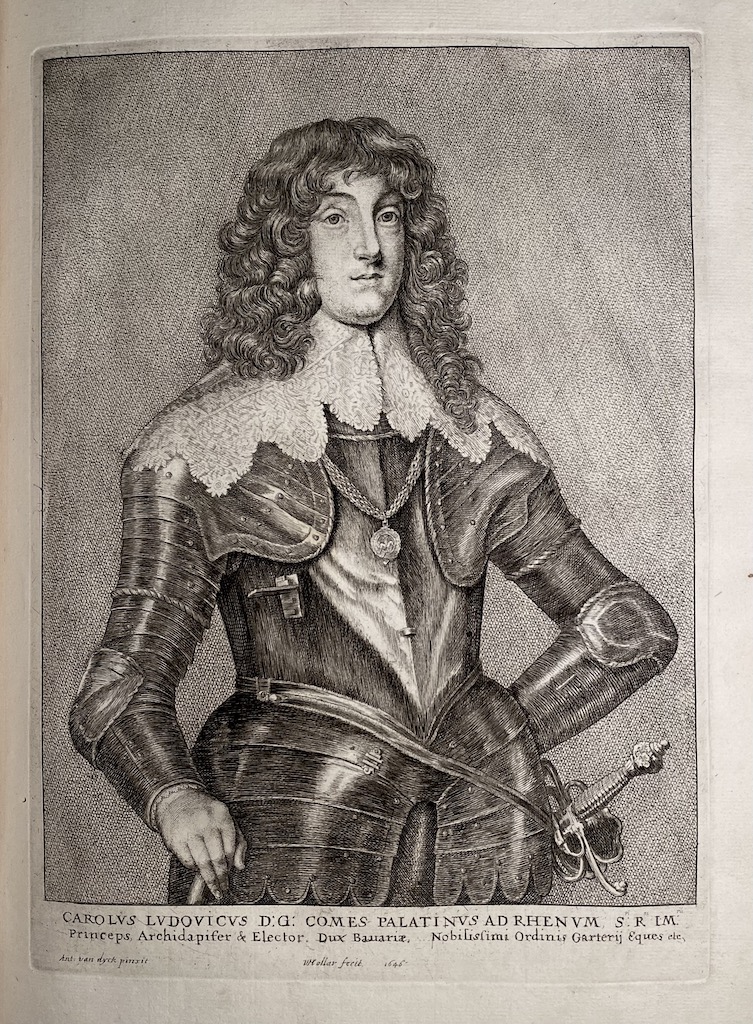
38. Karl I Ludwig, Elector Palatine (German, 1617 – 1680); engraved by Wenceslaus Hollar (Bohemian, 1607 – 1677). Inscription: “CAROLVS LVDOVICVS D:G: COMES PALATINVS AD RHENVM, S:ri R.ni IM:rii | Princeps, Archidapifer & Elector, Dux Bauariæ, …Nobilissimi Ordinis Garterij Eques etc.”. Below: “Ant: van Dyck pinxit” <–> “WHollar fecit,” <–> “1646”. First, lettered state with the title and production details, without “H: van de Borcht excu:”. British Museum # 1867,1012.598. Hendrik van der Borcht II (Dutch, 1614 – c. 1690) 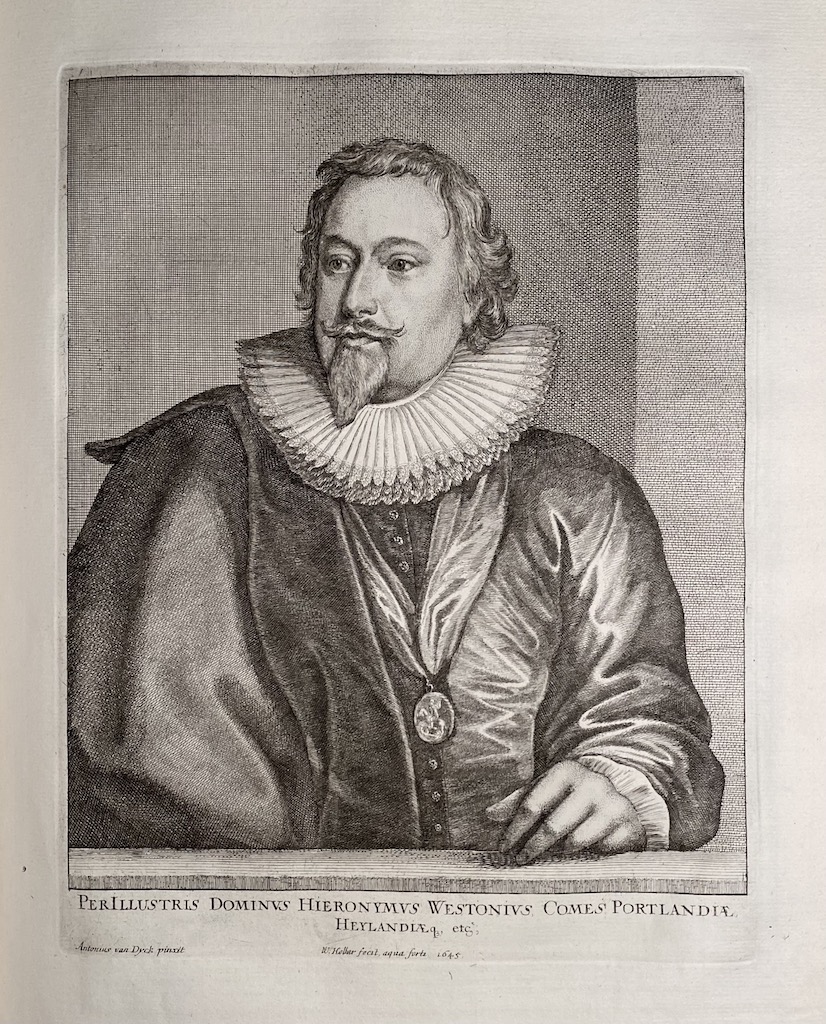
39. Richard Weston, 1st Earl of Portland (British, 1577 – 1635); engraved by Wenceslaus Hollar, published by Ioannes Meyssens. Inscription: “PERILLUSTRIS DOMINVS HIERONYMVS WESTONIVS, COMES PORTLANDIÆ, | HEYLANDÆq3, etc’,”. Below: “Antonius van Dyck pinxit”<–> “W: Hollar fecit, aqua forte. 1645”. Ioannes Meyssens’s name completely burnished. 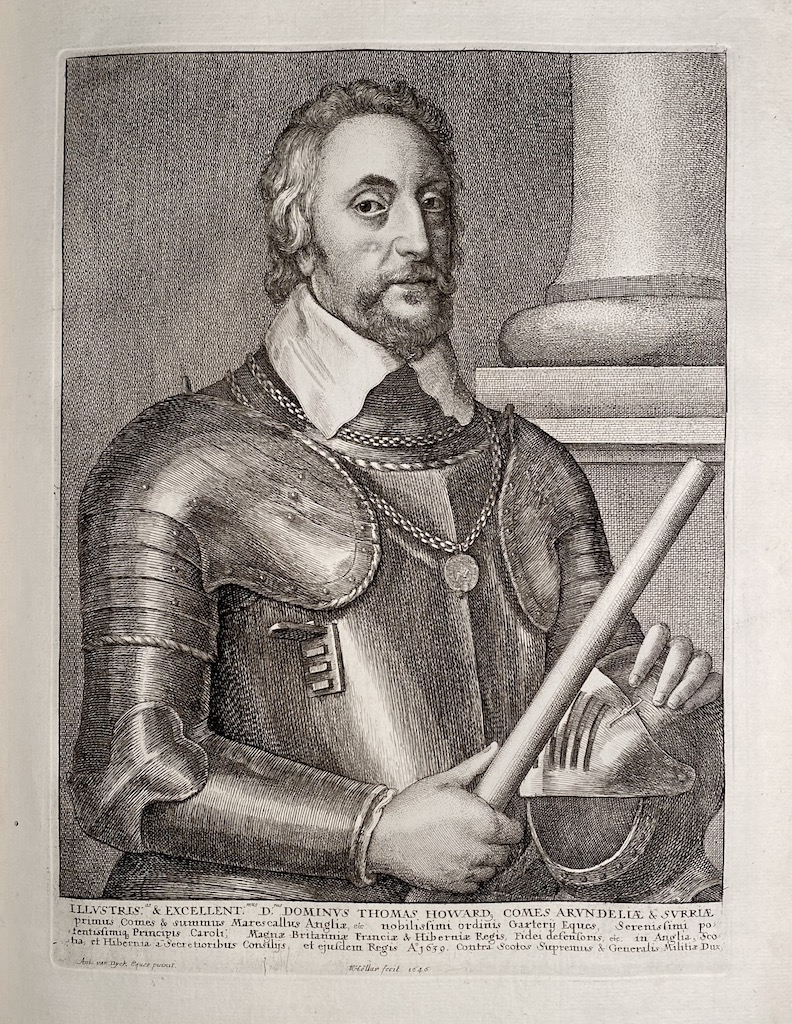
40. Thomas Howard, 14th Earl of Arundel (British, 1585 – 1646); engraved by Wenceslaus Hollar, published by Ioannes Meyssens. Inscription: "ILLVSTRIS:us & EXCELLENT:mus D:nus. DOMINVS THOMAS HOWARD, COMES ARXNDELIÆ & SVRRIÆ | primus Comes & summus Marescallus Angliæ, etc nobilisimi ordiuis Garterÿ Eques, Serenis∫imi po: | tentis∫imq3 Principis Caroli: Magnæ Britanniæ & Hiberniæ Regis, Fidei defen∫oris, etc. in Anglia, Sco | tia et Hibernia a Secretioribus Consilijs, et eju∫dem Regis Ao1639. Contra | Scotos Supremus & Generalis Militiæ Dux,”. In lower margin: “Ant: van Dyck Eques pinxit” <–> “WHollar fecit 1646”. Second state with Ioannes Meyssens’s name completely burnished. 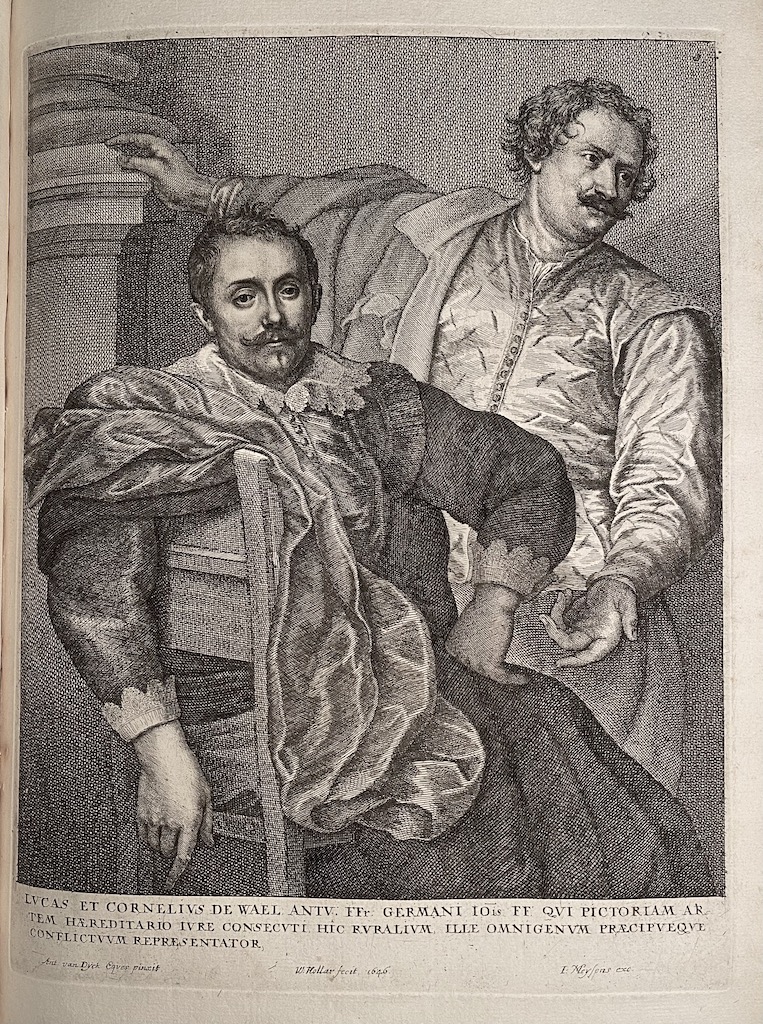
41. Lucas de Wael (Flemish, 1591 – 1661) and Cornelis de Wael (Flemish, 1592 – 1667); engraved by Wenceslaus Hollar, published by Ioannes Meyssens. Inscription: “LVCAS ET CORNELIVS DE WAEL ANTV: FFr. GERMANI IOis QUI PICTORIAM AR | TEM HÆREDITARIO IVRE CONSECVTI HIC RVRALIVM, ILLE OMNIGENVM PRÆCIPVEQVE / CONFLICTVVM REPRÆSENTATOR.”. In lower margin: “Ant. van Dyck Eques pinxit.” <–> “W: Hollar fecit, 1646.” <–> “I: Meysens exc”. First, lettered state with the title and production details. 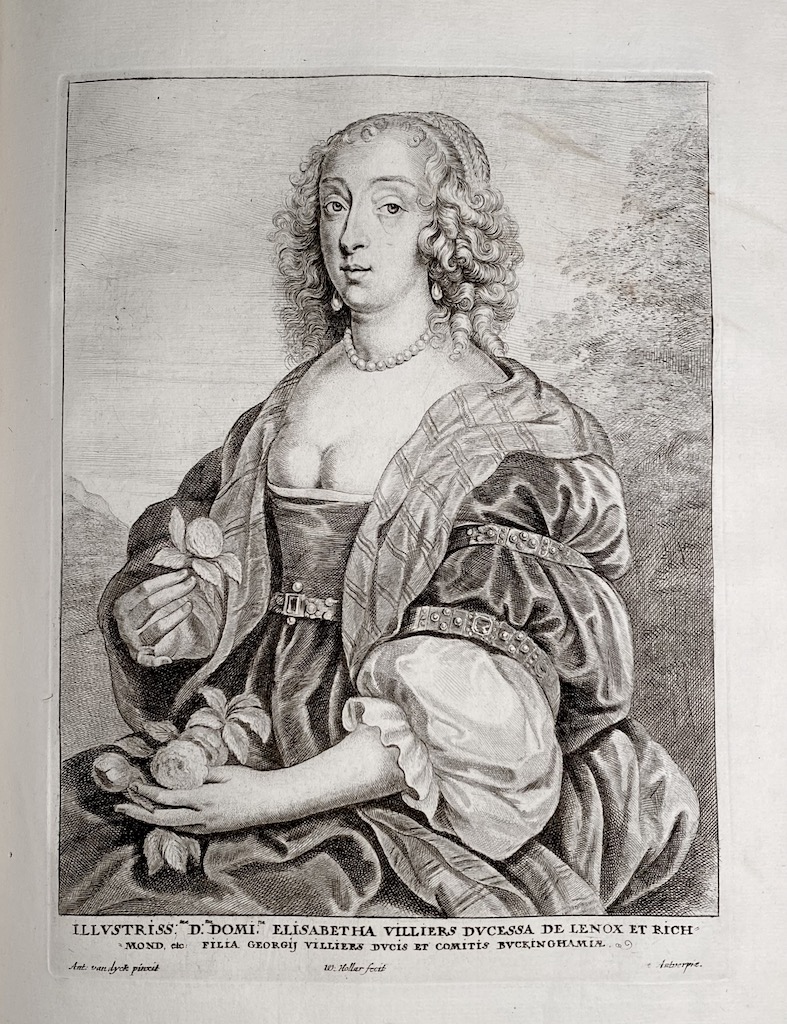
42. Mary (Elisabetha ) Villiers, Duchess of Lennox and Richmond (British, 1622 – 1685); engraved by Wenceslaus Hollar, published by Ioannes Meyssens. Inscription: “ILLUSTRISS: ma D:ma DOMI.na ELISABETHA VILLIERS DVCESSA DE LENOX ET RICH | MOND. etc: FILIA GEORGIJ VILLIERS DVCIS ET COMITIS BVCKINGHAMIÆ.”. In lower margin: “Ant: van dyck pinxit” <–> “W:Hollar fecit” <–> “… Antverpiæ.”. Ioannes Meyssens’ name completely burnished. First state with the title and production details. 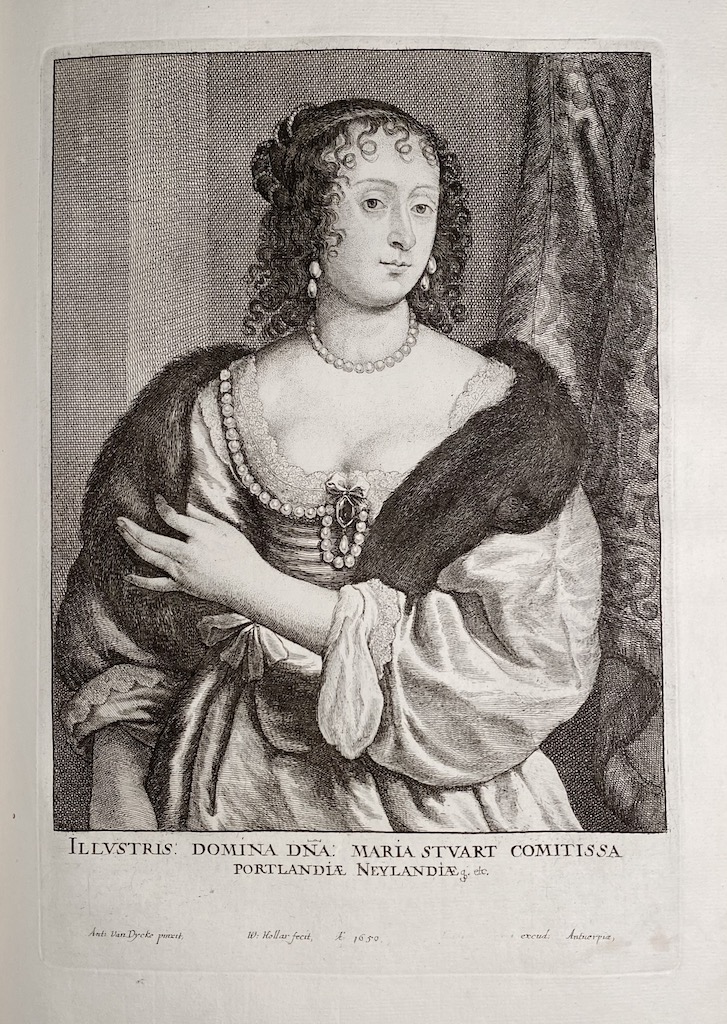
43. Frances (Maria) Stuart, Countess of Portland (British, 1617 – 1694); engraved by Wenceslaus Hollar, published by Ioannes Meyssens. Inscription: “ILLVSTRIS: DOMINA DNA: MARIA STVART COMITISSA | PORTLANDIÆ NEYLANDIÆ, etc.”. Below: “Ant: Van Dycke pinxit,” <–> “W: Hollar fecit, A:o 1650,”, “...excud: Antuerpiæ,”. Second state with Meyssens’ name burnished. British Museum # 1853,0112.1761 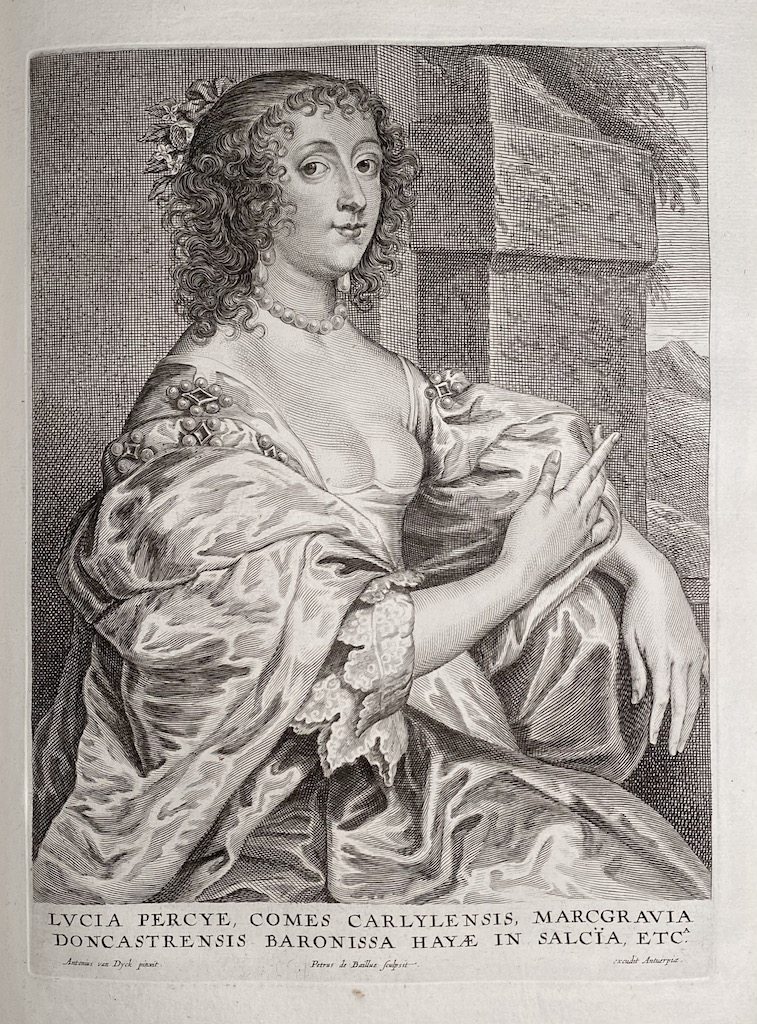
44. Lucy Percy, Countess of Carlisle (British, 1599 – 1660); engraved by Pieter de Bailliu, published by Ioannes Meyssens. Inscription: “LVCIA PERCYE, COMES CARLYLENSIS, MARCGRAVIA | DONCASTRENSIS BARONISSA HAYÆ IN SALCÏA, ETC.A”. In lower margin: “Antonius van Dyck pinxit.” <–> “Petrus de Baillue sculpsit.” <–> “...excudit Antuerpia.”. Third, lettered state with Joannes Meyssens’ name burnished. 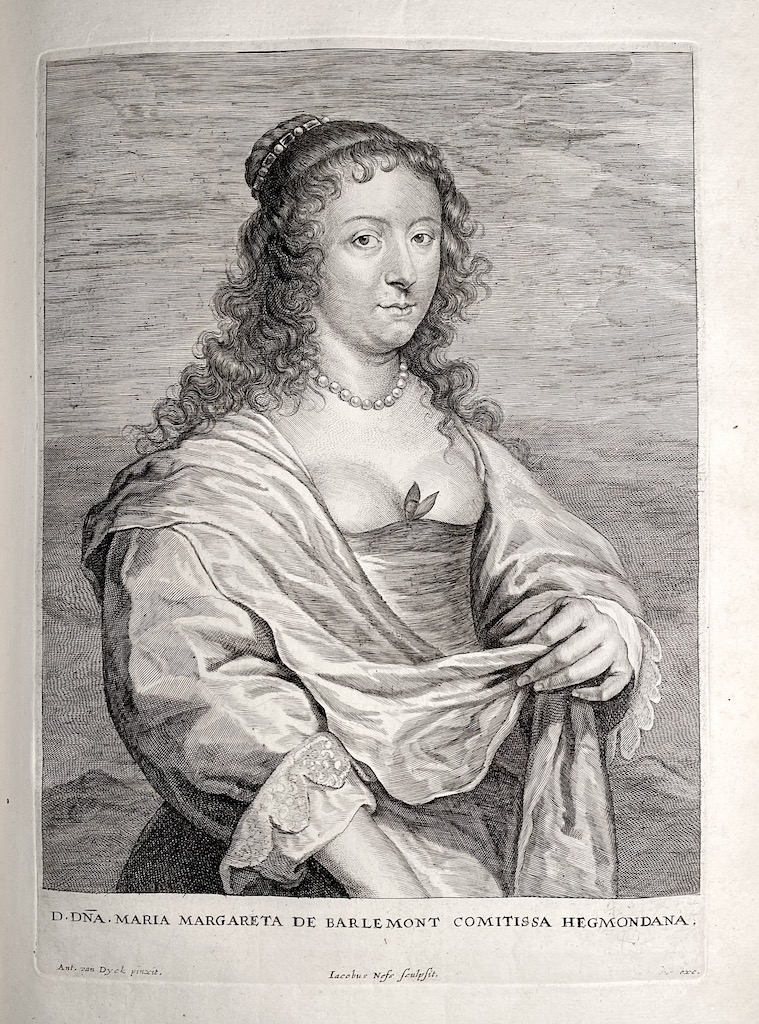
45. Marie-Marguerite de Berlaymont ( ? – 1654); engraved by Jacobus Neeffs, published by Ioannes Meyssens. Inscription: “D.DNA. MARIA MARGARETA DE BARLEMONT COMITISSA HEGMONDANA.” In lower margin: “Ant. van Dyck pinxit.” <–> “Iacobus Nefs sculpsit.”<–> “...exc.”. Fourth state with Ioannes Meyssens’ name erased. British Museum # 1876,1014.206. [Similar to №67, which has Ioannes Meysens name present]. 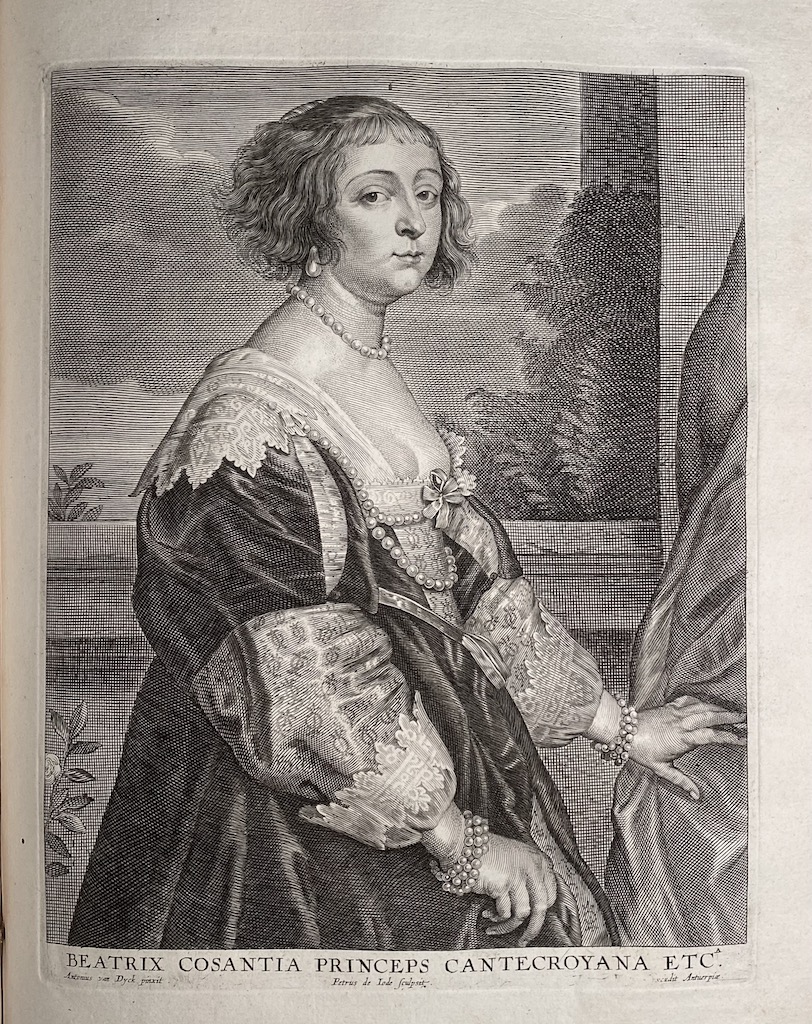
46. Béatrix Constance de Cussance, Princess of Cantecroix (French, 1614 – 1663); engraved by Pieter de Jode II, published by Ioannes Meyssens. Inscription: “BEATRIX COSANTIA PRINCEPS CANTECROYANA ETC.A”. In lower margin: “Antonius van Dyck pinxit” <–>“Petrus de Iode sculpsit.” <–> “… excudit Antuerpiæ.”. Second, lettered state with Meyssens’ name burnished. 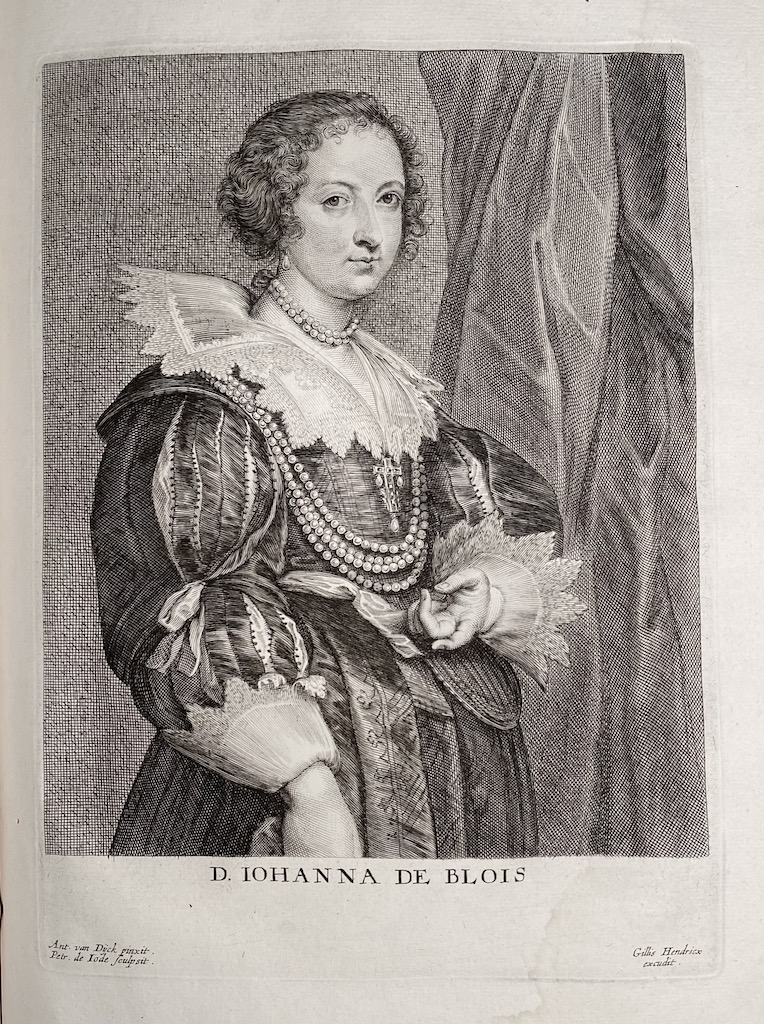
47. Johanna de Blois; engraved by Pieter de Jode II, published by Gillis Hendricx. Inscription: “D. IOHANNA DE BLOIS”. In the lower margin: “Ant. van Dÿck pinxit | Petr. de Iode sculpsit” <–> “Gillis Hendricx | excudit.”. British Museum # 1876,1014.189. 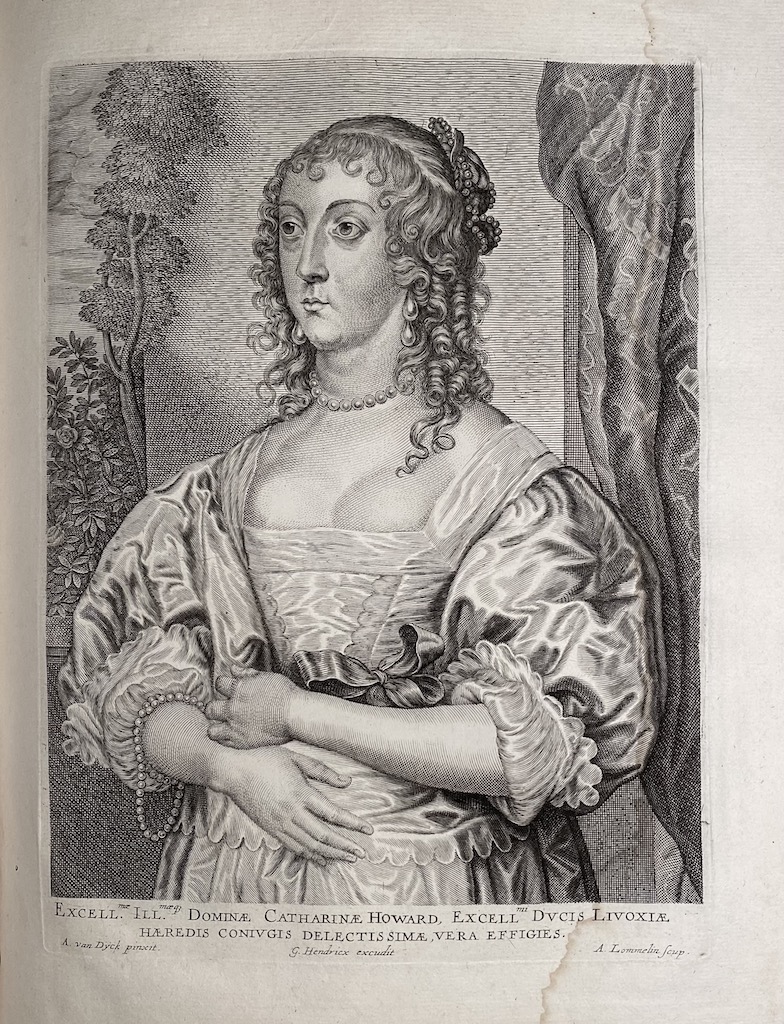
48. Katherine Howard, Countess of Newburgh, Lady d’Aubigny (British, ? – 1650); engraved by Adriaen Lommelin, published by Gillis Hendricx. Inscription: “EXCELLmæ ILL.mæq3 DOMINÆ CATHARINÆ HOWARD, EXCELLmi DUCIS LIVOXIÆ | HÆREDIS CONIUGIS DELECTISSIMÆ, VERA EFFIGIES.” In lower margin: “A. van Dÿck pinxit.” <–> “G. Hendricx excudit” <–> “A. Lommelin scup.”. British Museum # P,3.326 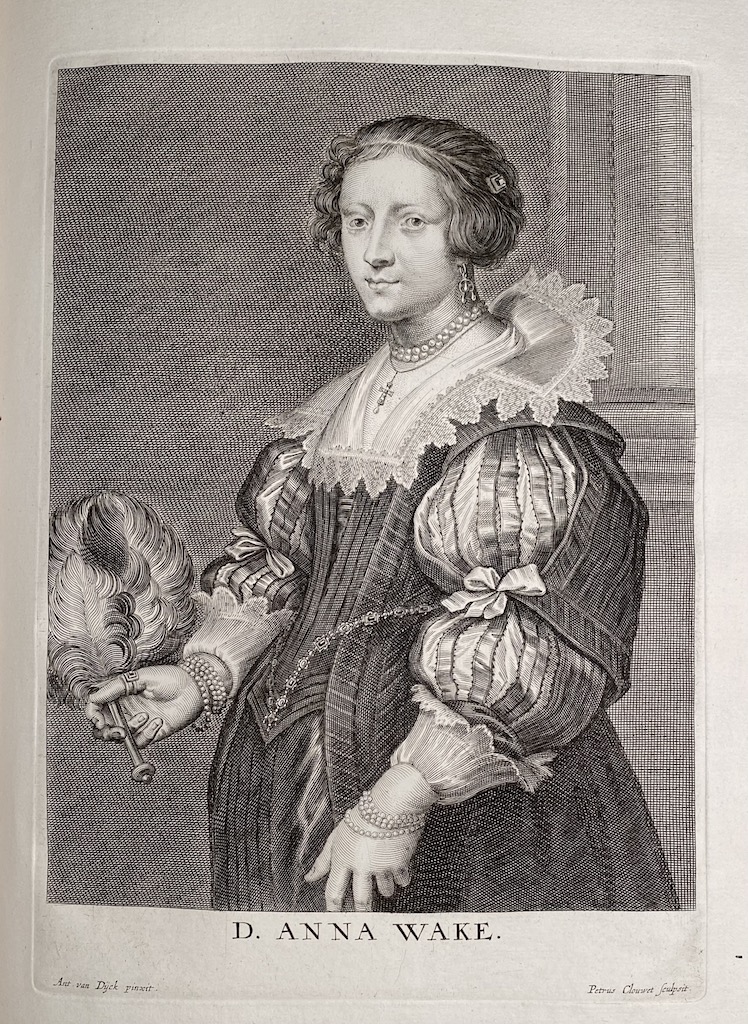
49. Anna Wake (Flemish, 1606 – 1680); engraved by Pieter Clouwet. Inscription: “D. ANNA WAKE.”. In lower margin: “Ant. van Dÿck pinxit.” <–> “Petrus Clouwet sculpsit”. 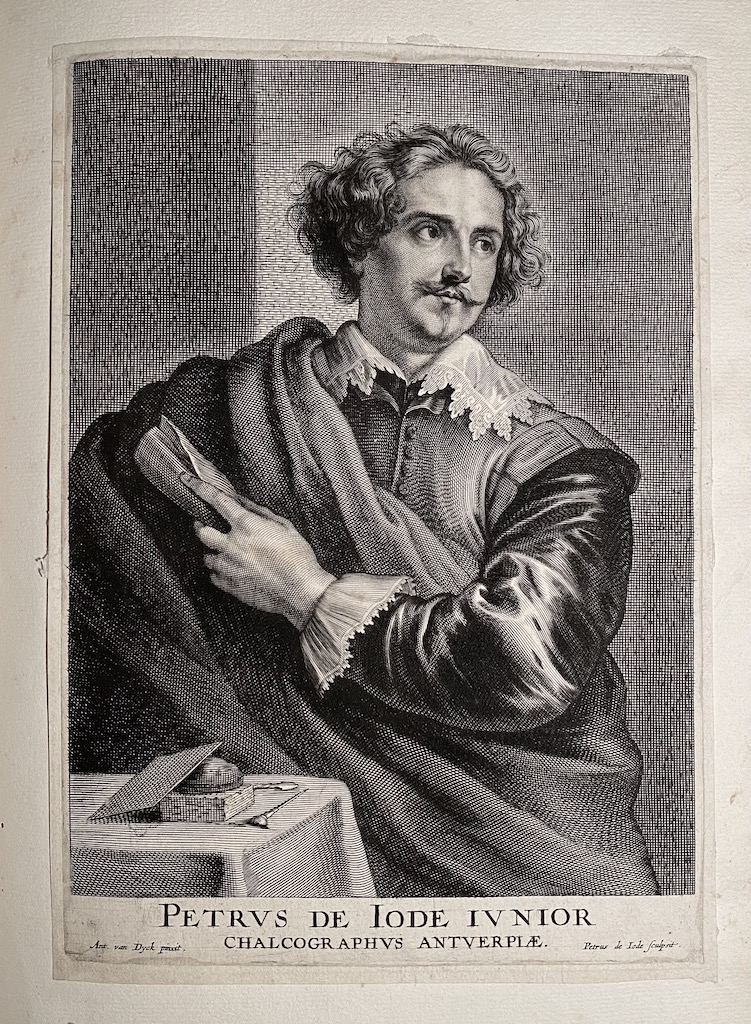
50. Pieter de Jode II (Flemish, 1606-1670/74); engraved by Pieter de Jode II. Inscription: “PETRVS DE IODE IVNIOR / CHALCOGRAPHVS ANTVERPIÆ.”. In lower margin: “Ant. van Dyck pinxit.”<–> “Petrus de Iode sculpsit.”. Third state (before the initials G.H. (of Gillis Hendricx) added. The print with cut off margins pasted to the bound-in leaf. 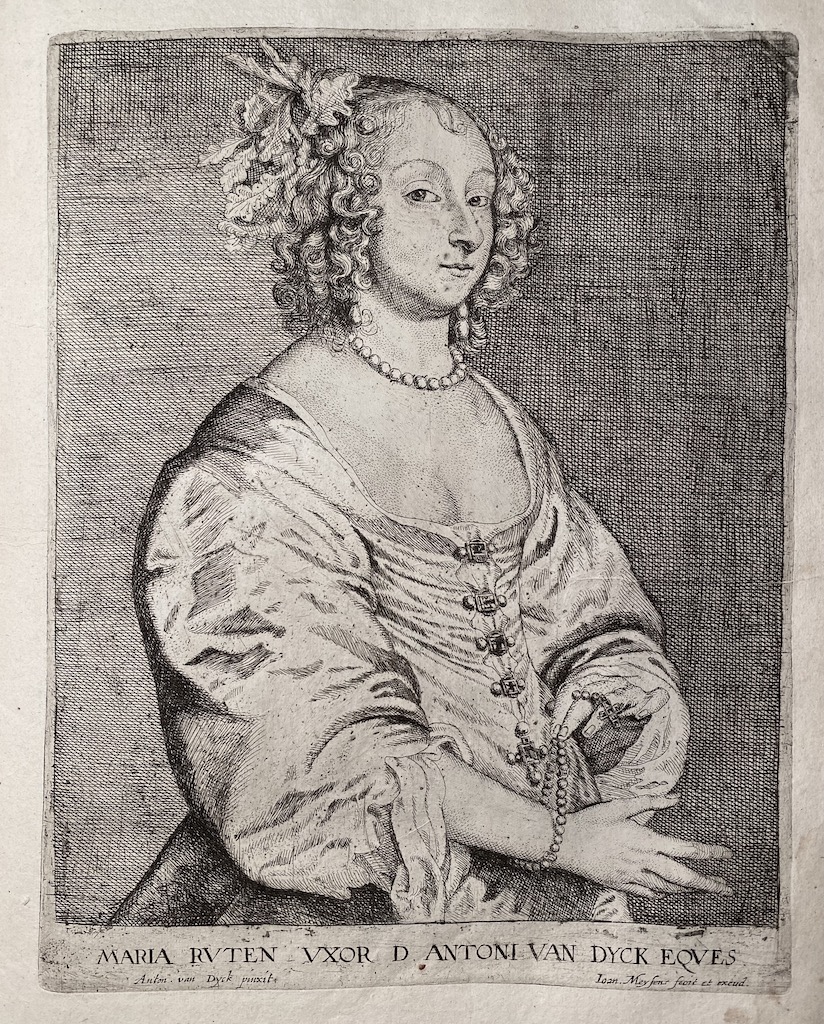
51. Mary Ruthven, Lady van Dyck (Scottish, c. 1622 – 1645); engraved and published by Ioannes Meyssens. Inscription: “MARIA RVTEN VXOR D. ANTONI VAN DYCK EQVES”. In lower margin: “Anton.van Dyck pinxit” <–> “Ioan. Meysens fecit et excud.”. First, lettered state with the title and production details. Tired plate. British Museum # 1863,0725.747. Van Dyck's wife. 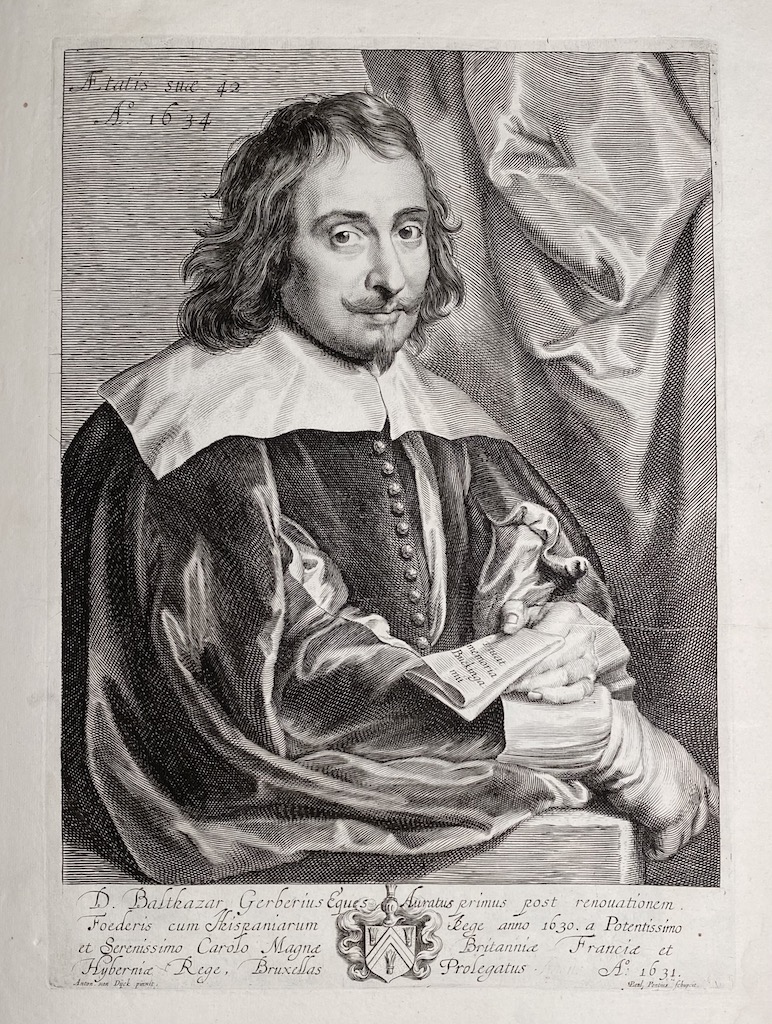
52. Sir Balthazar Gerbier (British, Flemish, 1592 – 1663); engraved by Paulus Pontius. Inscription: “D. Balthazar Gerberius Eques Auratus primus post renouationem. | Foederis cum Hispaniarum Rege anno 1630. A Potentissimo | et Serenissimo Carolo Magnæ Britanniæ Franciæ et Hiberniæ. Rege, Bruxellas Prolegatus. A:o 1631”. Below “Anton van Dyck pinxit”<–> “Paul Pontius schupcit.”. Top left corner: “Ætatis suæ 42 | A.o 1634”. The paper in Gerbier’s hand is lettered “viuat | memoria | Buckinga: | mii”. 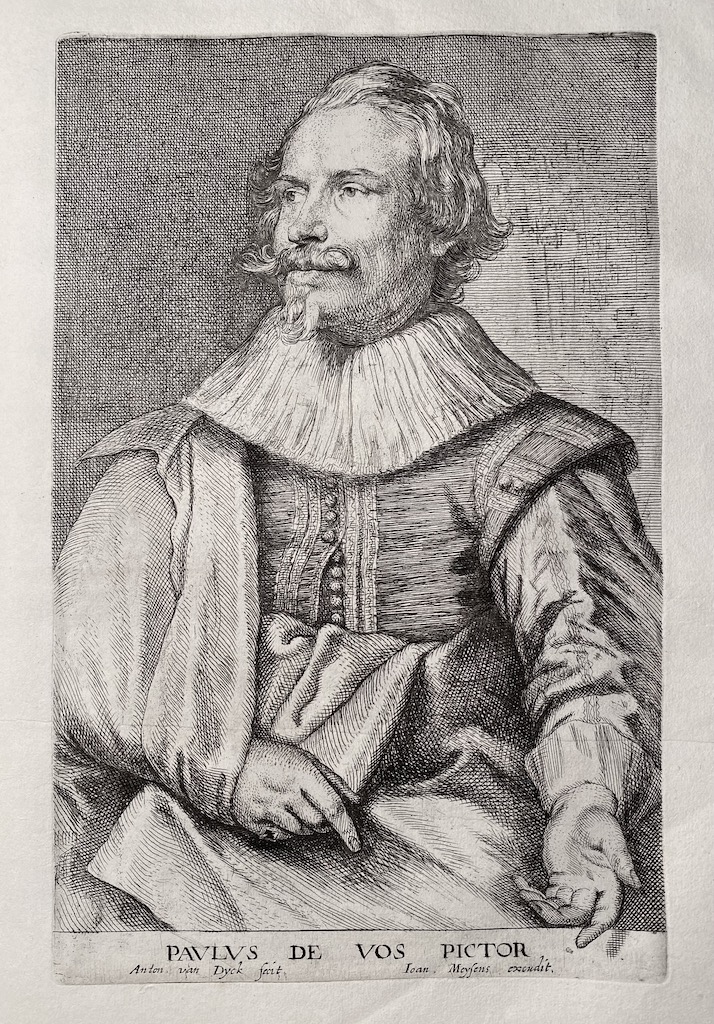
53. Paul de Vos (Flemish, 1596 – 1678); printed by Ioannes Meyssens, face and collar engraved by Anthony van Dyck, the body engraved by Ioannes Meyssens. Second, lettered state. Inscription: PAVLVS DE VOS PICTOR”. In lower margin: “Anton. van Dyck pinxit fecit.”, and “Ioan. Meysens excudit.”. British Museum # R,1b.95. [Look s very much alike №68, but with a one-line inscription and engraved by Meyssens instead of Bolswert]. 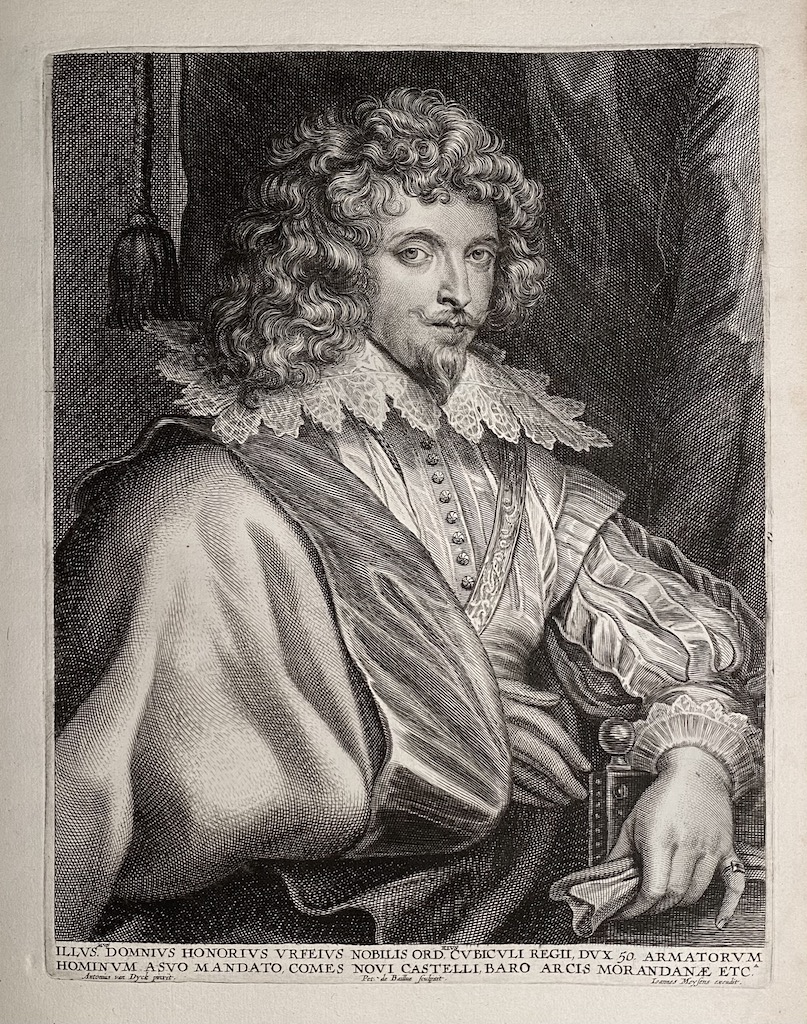
54. Honoré d’Urfé, marquis de Valromey, comte de Châteauneuf (French, 1568 – 1625); engraved by Pieter de Bailliu (Flemish, 1613 – 1660). Inscription: “ILLVS.MVS DOMNIVS HONORIVS VRFEIVS NOBILIS ORD.RIVS CVBICVLI REGII, DVX 50. ARMATORVM | HOMINVM A SVO MANDATO, COMES NOVI CASTELLI, BARO ARCIS MORANDANÆ ETC.A”. Below: “Antonius van Dyck pinxit” <–> “Pet. de Bailliue sculpsit.” <–> “Ioanes Meysens excudit.”. Second lettered state with title and production details. [Similar to №14, but with Ioanes Meysens name in place]. 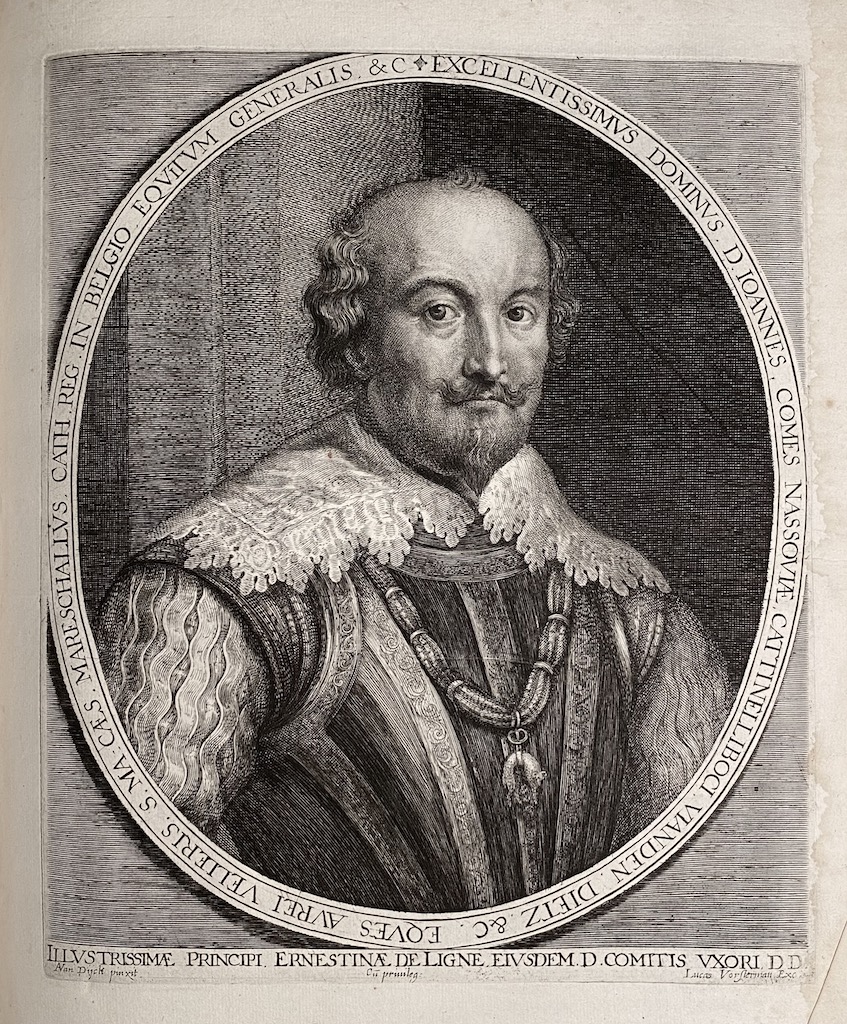
55. Johannes [John VIII], Count of Nassau-Siegen (German, 1583 – 1638); engraved by Lucas Vorsterman I (Flemish, 1595 – 1675). Inscription: in the oval around the portrait “EXCELLENTISSIMVS DOMINVS: D. IOANNES, COMES NASSAOVIÆ, CATTNELLIBOCI: VIANDEN, DIETZ, &C. EQVES AVREI VELLERIS. S. MA: CÆS, MARESCHALIVS, CATH. REG. IN BELGIO. EQVITVM GENERALIS. &C”, in lower margin: “ILLVSTRISSIMÆ PRINCIPI ERNESTINÆ DE LIGNE EIVSDEM D. COMITIS VXORI DD.”. Below: “AVan Dÿck pinxit.” <–> “Cū Priuleg” <–> “Lucas Vorsterman exc”. Third state. [For the fourth state with Lucas “Vorsterman exc” burnished see № 15]. 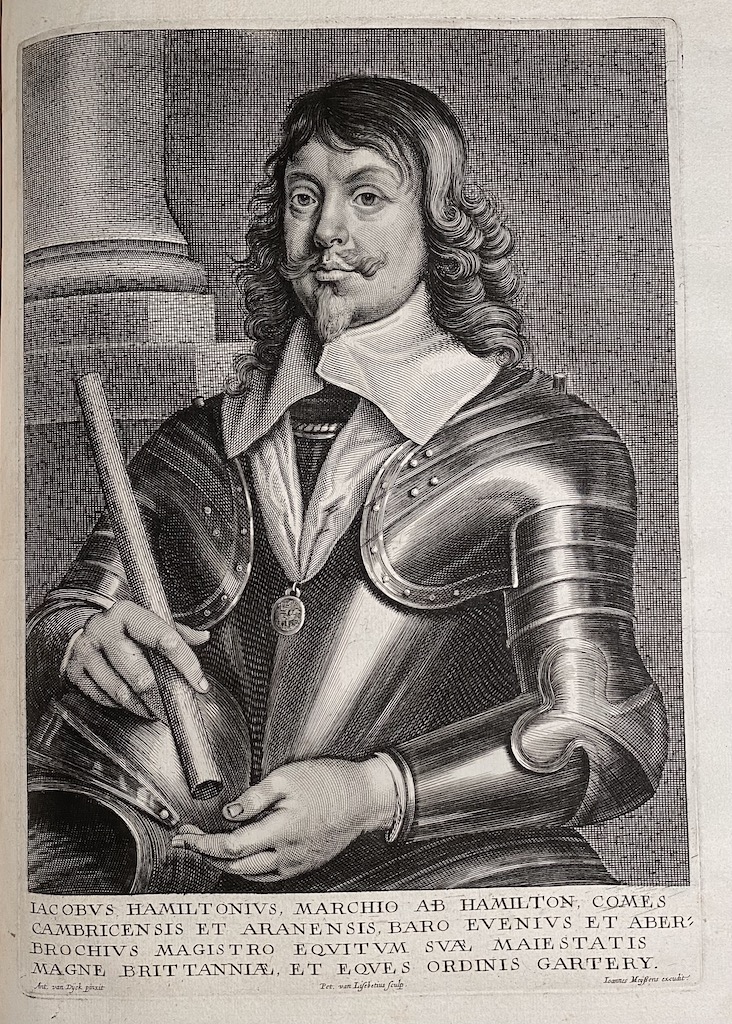
56. James Hamilton, 1st Duke of Hamilton (British, 1606 – 1649); engraved by Peeter van Lisebetten (Flemish,(1630 – 1678), published by Ioannes Meysens. Inscription: “IACOBVS HAMILTONIVS, MARCHIO AB HAMILTON, COMES | CAMBRICENSIS ET ARANENSIS, BARO EVENIVS ET ABER: | BROCHIVS MAGISTRO EQVITVM SVÆ MAIESTATIS | MAGNE BRITTANIÆ, ET EQUES ORDINIS GARTERY.”.In lower margin: “Ant. van Dÿck pinxit” <–> “Pet. van Lisebetius sculp.”<–> “Ioannes Meÿssens excudit.”. Second state with title and signatures. British Museum # P,2.208. 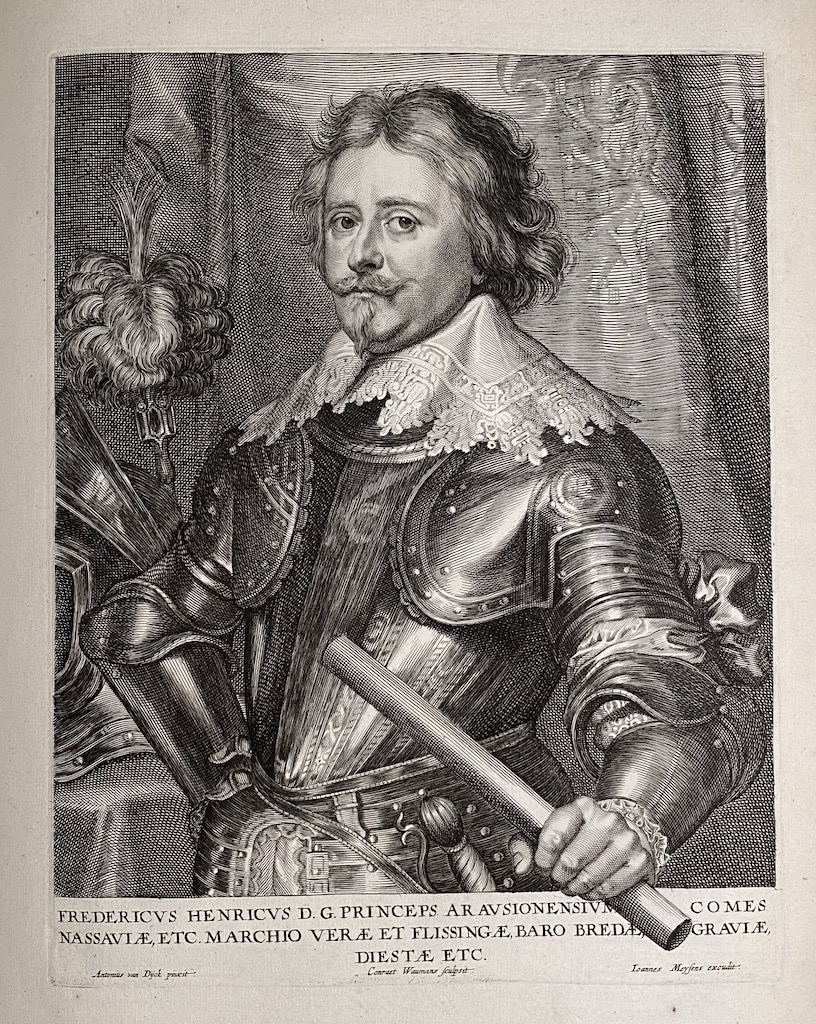
57. Frederick Henry, Prince of Orange, Count of Nassau (Dutch, 1584 – 1647); engraved by Conrad Waumans [Woumans] (Flemish, 1619 – after 1675). Inscription: “FREDERICVS HENRICVS, D.G. PRINCEPS ARAVSIONENSIVM, COMES | NASSAVIÆ, ETC. | MARCHIO VERÆ ET FLISSINGÆ, BARO BREDÆ GRAVÆ, | DIESTÆ ETC.”. Below: “Antonius van Dÿck pinxit” <–> “Conraet Waumans sculpsit” <–> “Ioannes Meyssens excudit.” First, lettered state with title and production details. [Similar to №5, but this one with Ioannes Meyssens name present]. 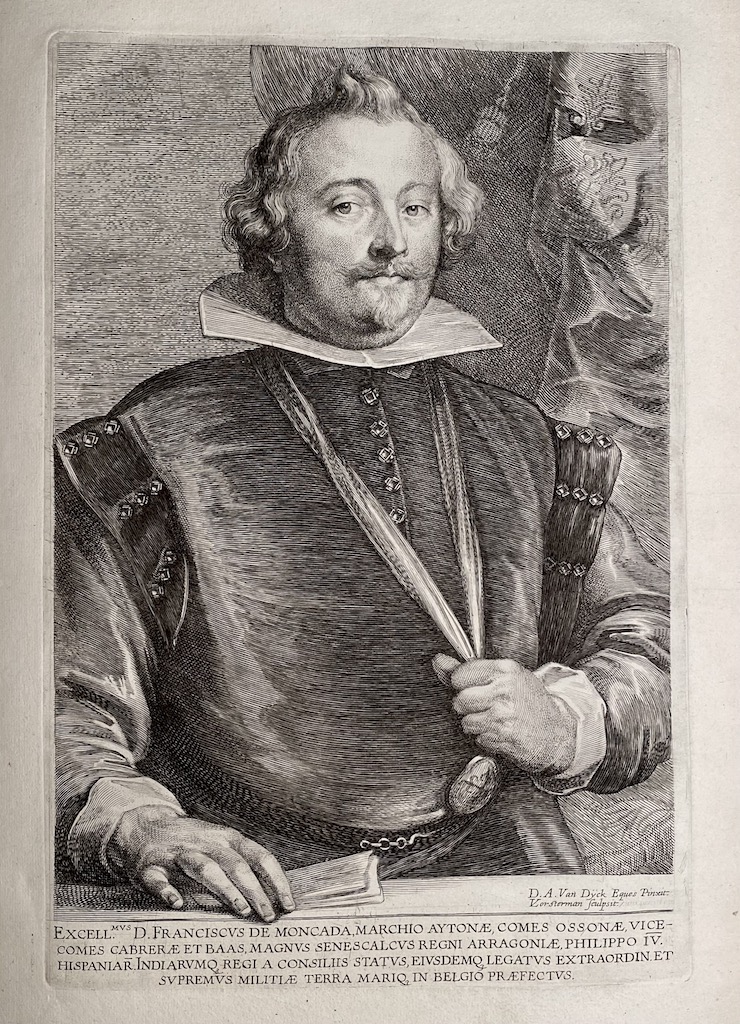
58. Francisco de Moncada, Count d’Osuna (Spanish, 1568 – 1635); engraved by Lucas Vorsterman I. Inscription: “EXCELL.MVS D. FRANCISCVS DE MONCADA MARCHIO AYTONÆ, COMES OSSONÆ VICE– | COMES CABRERÆ ET BAAS, MAGNVS SENESCALCVS REGNI ARRAGONIÆ, PHILIPPO IV. | HISPANIAR.INDIARVMQ3 REGI A CONSILIIS STATVS, EIVSDEMQ3 LEGATVS EXTRAORDIN,ET | SVPREMVS MILITIÆ TERRA MARIQ3 IN BELGIO PRÆFECTVS". Above within portrait frame, to the right: “D.A.van Dÿck pinxit. | LVorsterman sculpsit.”. 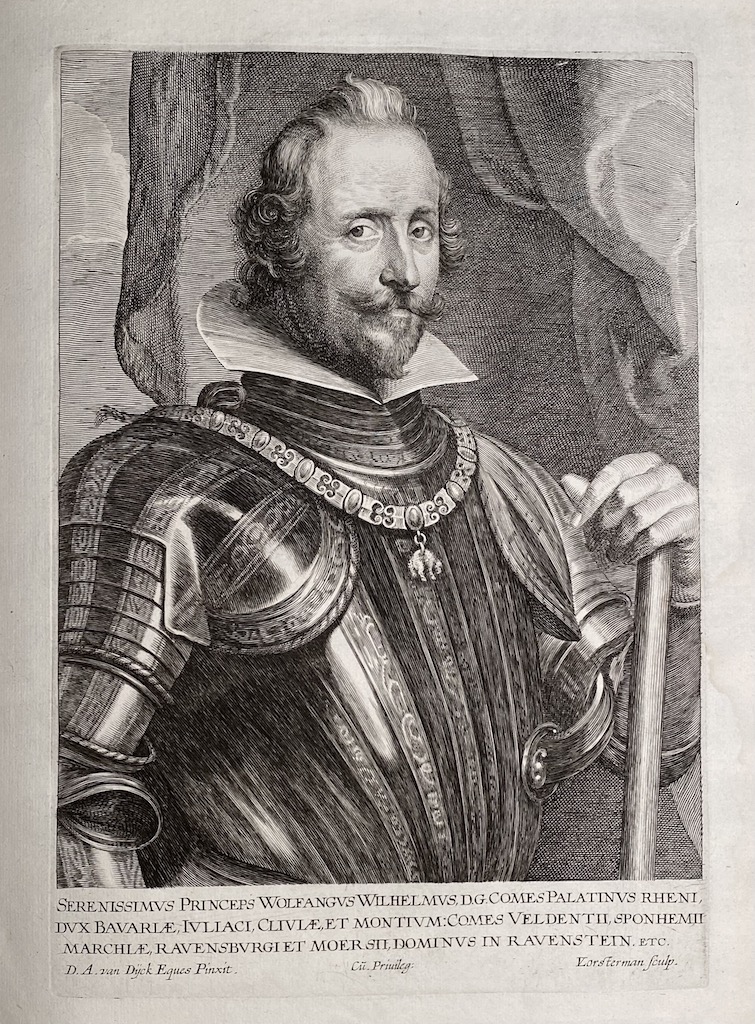
59. Wolfgang Wilhelm, Count of Pfalz-Neuburg and Duke of Jülich (German, 1578 – 1653); engraved by Lucas Vorsterman I. Inscription: "SERENISSIMVS PRINCEPS WOLFGANGVS WILHELMVS, D.G. COMES PALATINVS RHENI, | DVX BAVARIÆ, IVLIACÆ, ET MONTIVM :COMES VELDENTII, SPONHEMII | MARCHIÆ, RAVENSBVRGI ET MOERSII, DOMINVS IN RAVENSTEIN. ETC." In lower margin: "D. A. van Dÿck Eques Pinxit." <–> "Cū. Priuileg:" <–> "LVorsterman sculp.". Fifth state with initials of Gillis Hendricx burnished. British Museum # 1863,0509.825. 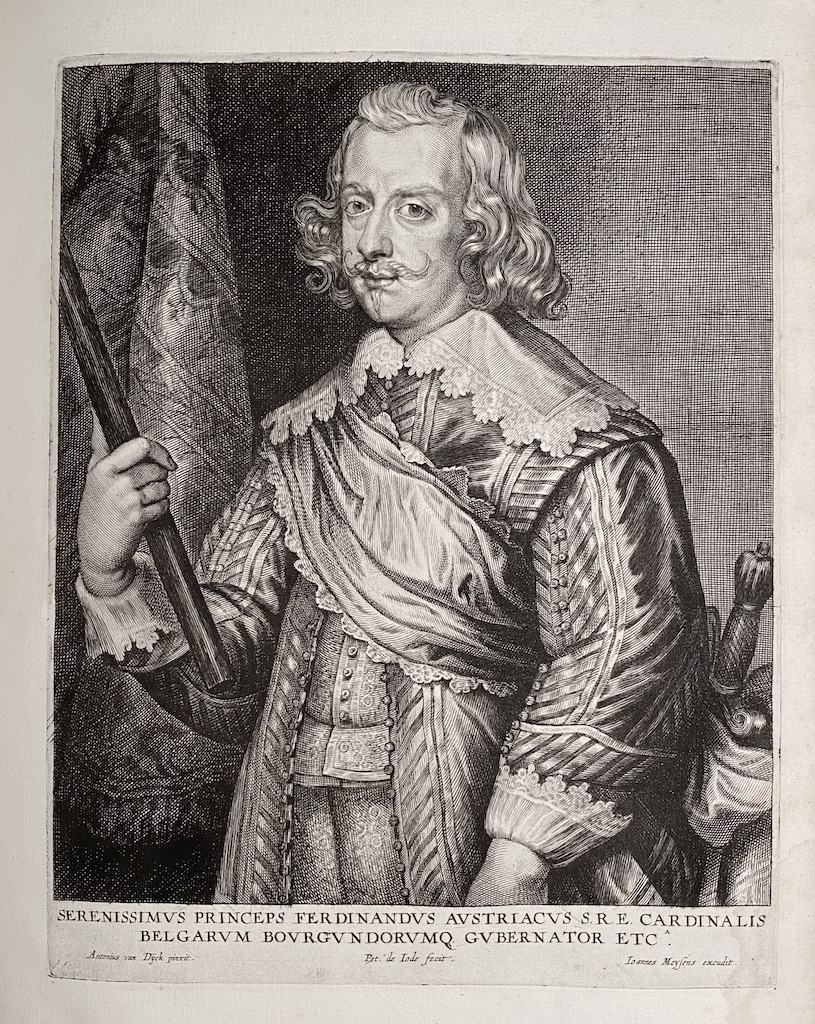
60. Ferdinand, Cardinal Infante of Spain and Archduke of Austria (Spanish, 1609 – 1641); engraved by Pieter de Jode II, published by Ioannes Meyssens. Inscription: “SERENISSIMVS PRINCEPS FERDINANDVS AVSTRIACVS S.R.E CARDINALIS | BELGARVM BORGVNDIORVMQ3 GVBERNATOR ETC.A”. In lower margin: “Antonius van Dÿck pinxit” <–> “Pet. de Iode fecit” <–> “Ioannes Meysens excudit”. Third, lettered state with title and production details. British Museum # R,1a.28. 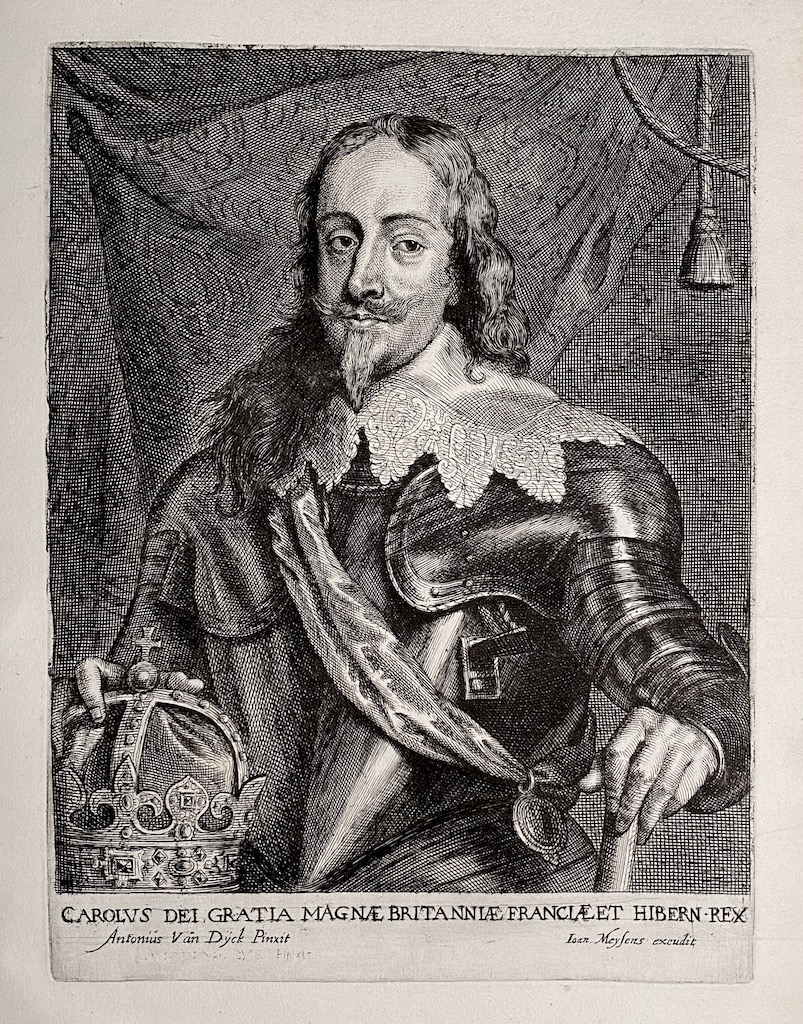
61. Charles I, King of England, Scotland, and Ireland (British, 1600 – 1649); engraved by Johannes [Jan] Meyssens (Flemish, 1612 – 1670). Inscription: “CAROLVS DEI GRATIA MAGNÆ BRITANNIÆ, FRANCIÆ ET HIBERNIÆ REX”. Below: “Antonius Van Dÿck eques pinxit” <–> “Ioan. Meysens excudit”. [Similar to №4, but with Ioannes Meysens name present]. 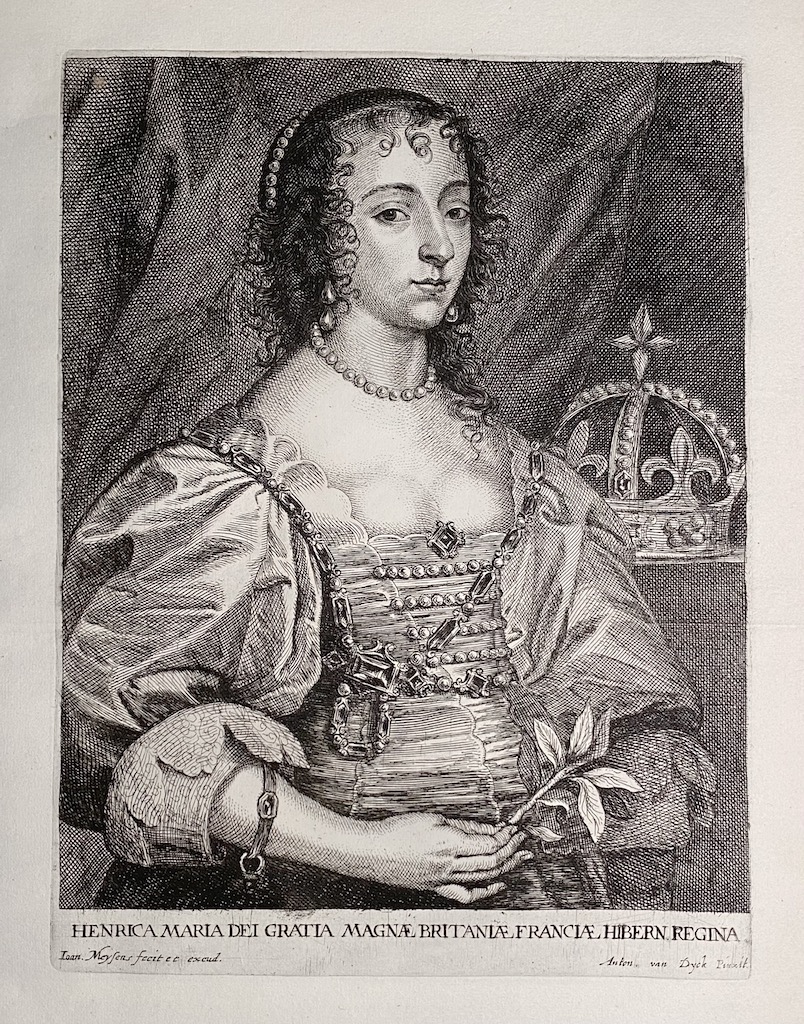
62. Henriette Marie de Bourbon, engraved and published by Ioannes Meyssens. Inscription: “HENRICA MARIA DEI GRATIA MAGNÆ BRITANIÆ FRANCIAÆ HIBERN. REGINA.” Lettered with production details in lower margin: “Ioan. Meysens fecit et excud.” <–> “Anton van Dyck Pinxit”. Third state, finished with a burin. [Similar to print №31, but this one with Ioan. Mey∫ens signature present]. 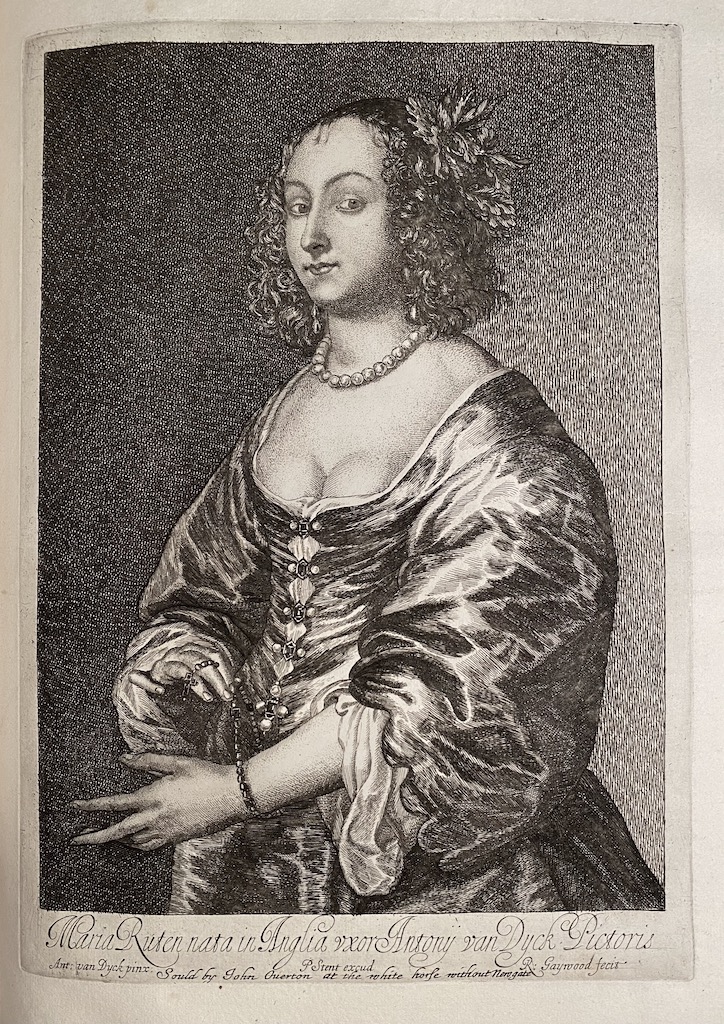
63. Mary Ruthven, Lady van Dyck (Scottish, c. 1622 – 1645); copy in reverse by Richard Gaywood after Bolswert (see also №51 by Meyssens) published by Peter Stent. Inscription: “Maria Ruten nata in Anglia vxor Antonÿ van Dyck Pictoris”. Below: “Ant: van Dyck pinx:”, “P Stent excud”, “R: Gaywood fecit”. Below centre: “Sould by John Ouerton at the white horse without New gate”. John Overton, publisher (British, 1639/40 – 1713); Richard Gaywood (British, fl. c. 1644 – 1677). Peter Stent (British, fl. c. 1637 – 1665). See BM # P,3.351. 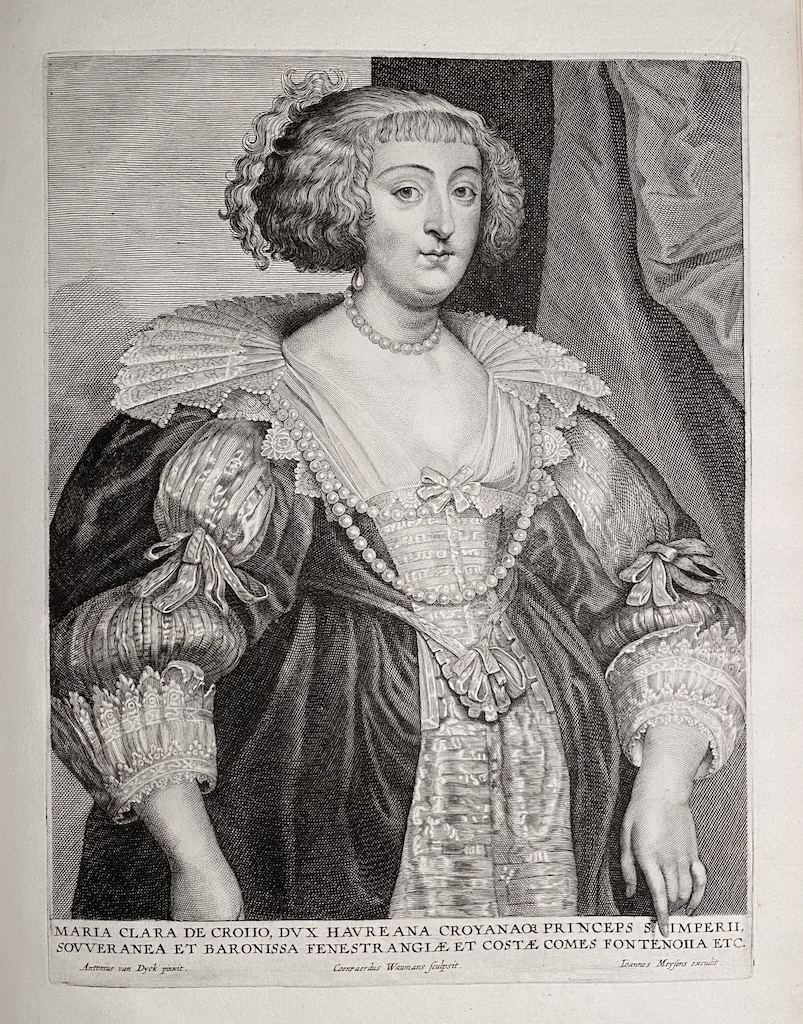
64. Marie-Claire de Croy, Duchess of Havré (Flemish, 1605 – 1664); engraved by Conraad Waumans, published by Ioannes Meyssens. Inscription: “MARIA CLARA DE CROIIO, DVX HAVREANA CROYANAQ3 PRINCEPS STE. IMPERII, | SOVVERANEA ET BARONISSA FENESTRANGIÆ ET COSTÆ COMES FONTENOIIA ETC”. In lower margin: “Antonius van Dyck pinxit.” <–> “Coenraerdus Waumans sculpsit.” <–> “Ioannes Meysens excudit.”. Second state. British Museum # R,1a.188. [Similar to №36, but this one with Ioannes Meysens name present]. 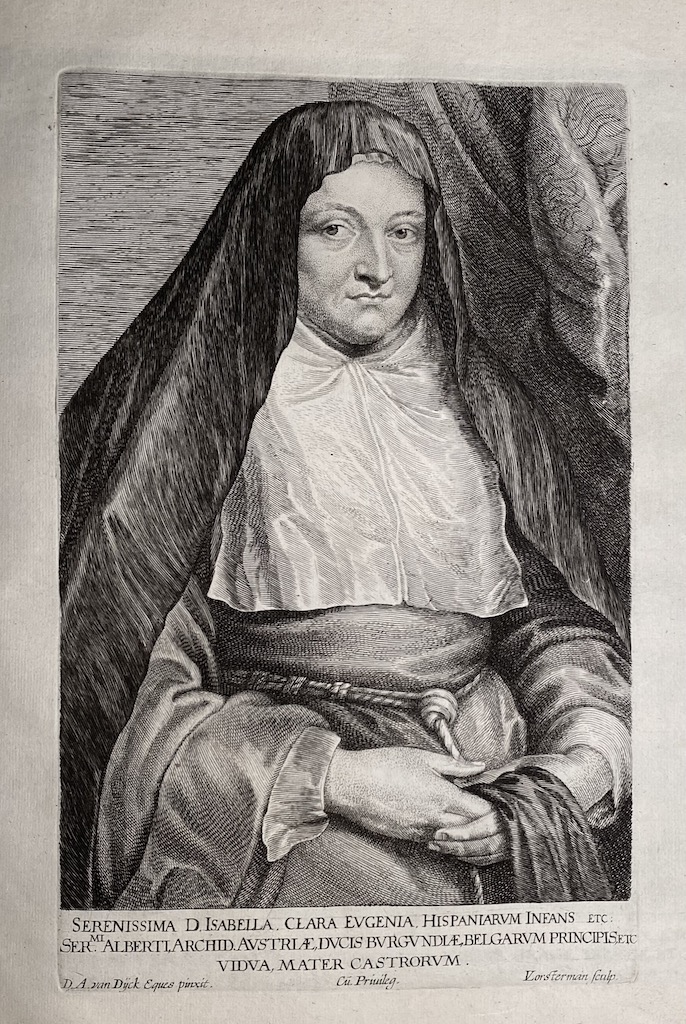
65. Isabel Clara Eugenia, ruler of the Spanish Netherlands (Spanish, 1566 – 1633); engraved by Lucas Vorsterman I. “SERENISSIMA D. ISABELLA. CLARA. EVGENIA. HISPANIARVM INFANS ETC. | SER.MI ALBERTI. ARCHID. AVSTRIÆ, DVCIS BVRGVNDIÆ, BELGARVM PRINCIPIS, ETC. | VIDVA, MATER CASTRORVM.” In lower margin: “D. A.van Dÿck Eques pinxit.” <–> “Cū Priuileg.” <–> “LVorsterman sculp.”. Fourth state with initials of Gillis Hendricx burnished. British Museum # 1863,0509.820. 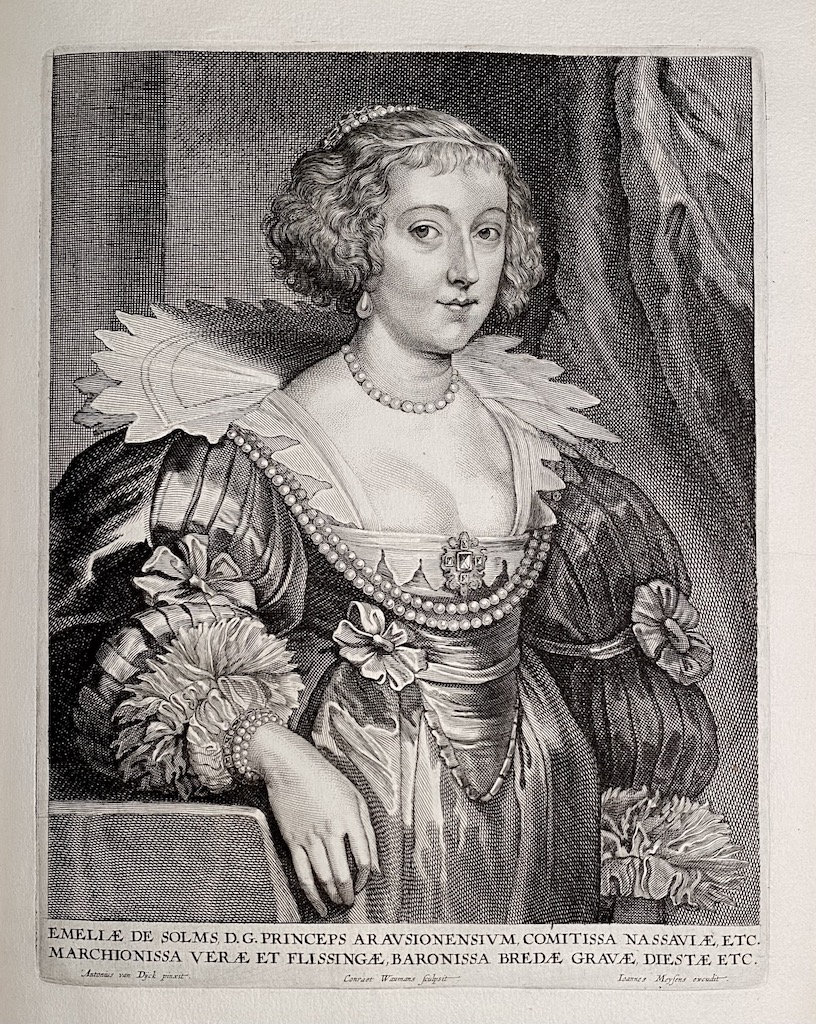
66. Amalia van Solms, Princess of Orange (German, 1602 – 1675), engraved by Conraad Waumans and published by Johannes Meyssens. Inscription: “EMELIÆ DE SOLMS, D. G. PRINCPES ARAVSIONENSIVM, COMITISSA NASSAUVIÆ, ETC. | MARCHIONISSA VERÆ ET FLISSINGÆ, BARONISSA BREDÆ, GRAVÆ, DIESTÆ ETC.” In lower margin: “Antonius van Dijck pinxit.”, “Conraet Waumans sculpsit.” and “Ioannes Meysens excudit.”. First, lettered state with the title and production details lettered. [Similar to №32, but this one with Ioannes Meysens name present]. 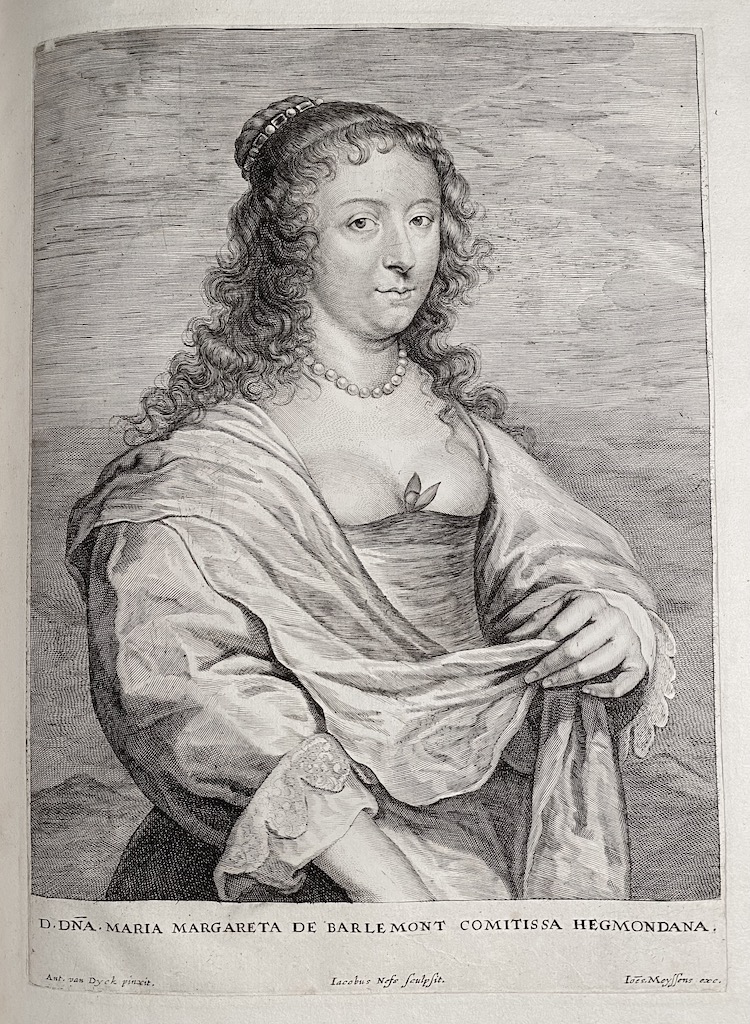
67. Marie-Marguerite de Berlaymont ( ? – 1654); engraved by Jacobus Neeffs, published by Ioannes Meyssens. Inscription: “D.DNA. MARIA MARGARETA DE BARLEMONT COMITISSA HEGMONDANA.” In lower margin: “Ant. van Dyck pinxit.” <–> “Iacobus Nefs sculpsit.” <–> “Ioes Meyssens exc.”. Fourth state. [Similar to №45, but this one with Ioannes Meysens name present]. 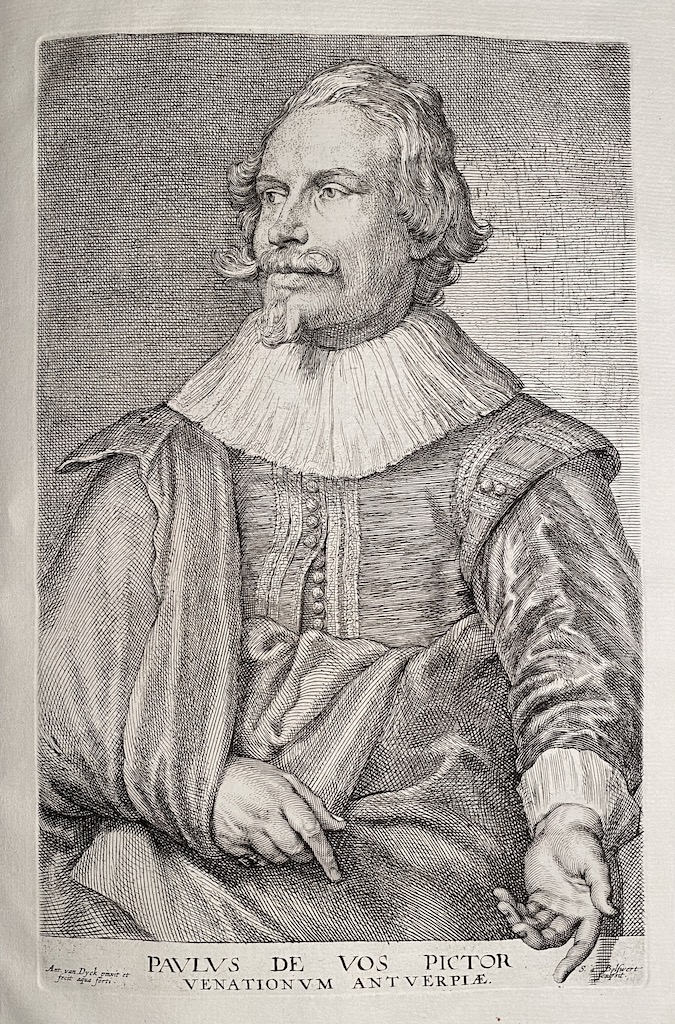
68. Paul de Vos (Flemich, 1596-1678); engraved and etched by Anthony van Dyck and by Schelte Adamsz. Bolswert, published by Gillis Hendricx. Eighth state with the initials of Gillis Hendricx burnished. Inscription: PAVLVS DE VOS PICTOR | VENATIONVM ANTVERPIÆ.”. “Ant. van Dyck pinxit et | fecit aqua forti.” <–> “S. à Bol∫wert | sculpsit. ”. [Look s very much alike №53, but with a two-line inscription and engraved by Bolswert instead of Meyssens, etc.]. 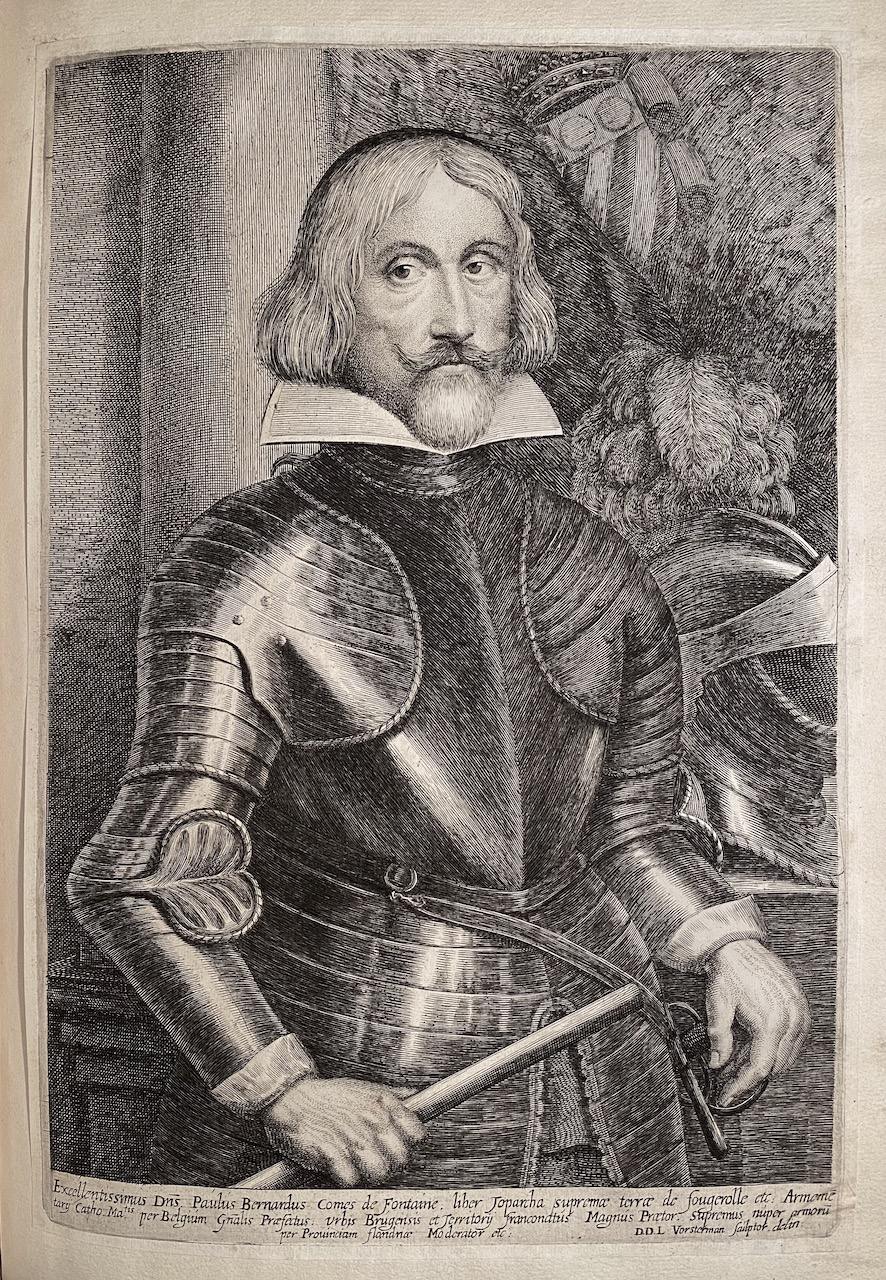
69. Paul-Bernard de Fontaines (French, 1566 – 1643) delineated and engraved by Lucas Vorsterman I (Flemish, 1595 – 1675) in 1615–75. Inscription: “Excellentissimus Dns. Paulus Bernardus Comes de Fontaine. liber Toparcha supremae terrae de fougerolle etc: Armeme tarij Catho. Matis. per Belgium Gnalis Praefectus: Vrbis Brugensis et Territorij fraconatus Magnus Praetor. Supremus nuper armpru Prouinciam flandriae Moderator etc: D.D.L Vorsterman sculptor. delin”. Cut without margins and pasted to inbound leaf. See: MET: Accession Number: 51.501.1332 -
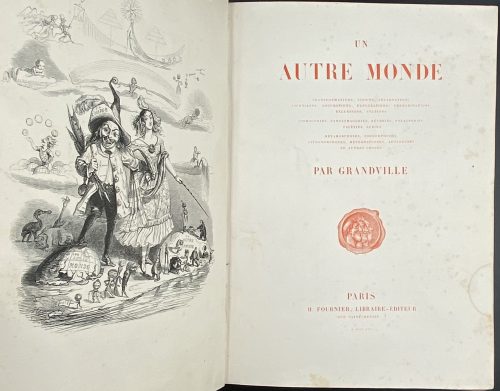 Description: One volume, collated 4t0, 27.3 x 20 cm, bound in contemporary quarter black chagrin, gilt ornaments and lettering to spine (reliure à l'époque romantique), marbled end-papers; printed on wove paper (vélin fort). Title-page (red): UN | AUTRE MONDE | TRANSFORMATIONS, VISIONS, INCARNATIONS | ASCENSIONS, LOCOMOTIONS, EXPLORATIONS, PÉRÉGRINATIONS | EXCURSIONS, STATIONS || COSMOGONIES, FANTASMAGORIES, RÈVERIES, FOLATRERIES | FACÉCIES, LUBIES || MÉTAMORPHOSES, ZOOMORPHOSES | LITHOMORPHOSES, MÉTEMPSYCHOSES, APOTHÉOSES | ET AUTRES CHOSES | PAR GRANDVILLE | [device] | PARIS | H. FOURNIER, LIBRAIRE-ÉDITEUR | RUE SAINT-BENOIT, 7 | M DCCC XLIV Pagination: ff, [2] half-title in red / imprim., [2] blank / frontis. in black, [2] title page in red / blank, [1] 2-295, [1] explication and erratum, bf, illustrations. Collation: 4to, (1)-(37)4 with frontispiece, 133 woodcut vignettes, 15 full-page black woodcuts, and 36 hand-coloured plates. Catalogue raisonné: Carteret (p. 285) describes the book as 'in-8', but the collation is actually in quarto (in-4, or 4to) with series signed in Arabic numerals. Ray (French): p. 275-7. The publication is anonymous, however, Grandville reveals the author's name (that's Taxile Delord) on the vignette on p. 292 at the bottom of the plate (under ICI).
Description: One volume, collated 4t0, 27.3 x 20 cm, bound in contemporary quarter black chagrin, gilt ornaments and lettering to spine (reliure à l'époque romantique), marbled end-papers; printed on wove paper (vélin fort). Title-page (red): UN | AUTRE MONDE | TRANSFORMATIONS, VISIONS, INCARNATIONS | ASCENSIONS, LOCOMOTIONS, EXPLORATIONS, PÉRÉGRINATIONS | EXCURSIONS, STATIONS || COSMOGONIES, FANTASMAGORIES, RÈVERIES, FOLATRERIES | FACÉCIES, LUBIES || MÉTAMORPHOSES, ZOOMORPHOSES | LITHOMORPHOSES, MÉTEMPSYCHOSES, APOTHÉOSES | ET AUTRES CHOSES | PAR GRANDVILLE | [device] | PARIS | H. FOURNIER, LIBRAIRE-ÉDITEUR | RUE SAINT-BENOIT, 7 | M DCCC XLIV Pagination: ff, [2] half-title in red / imprim., [2] blank / frontis. in black, [2] title page in red / blank, [1] 2-295, [1] explication and erratum, bf, illustrations. Collation: 4to, (1)-(37)4 with frontispiece, 133 woodcut vignettes, 15 full-page black woodcuts, and 36 hand-coloured plates. Catalogue raisonné: Carteret (p. 285) describes the book as 'in-8', but the collation is actually in quarto (in-4, or 4to) with series signed in Arabic numerals. Ray (French): p. 275-7. The publication is anonymous, however, Grandville reveals the author's name (that's Taxile Delord) on the vignette on p. 292 at the bottom of the plate (under ICI).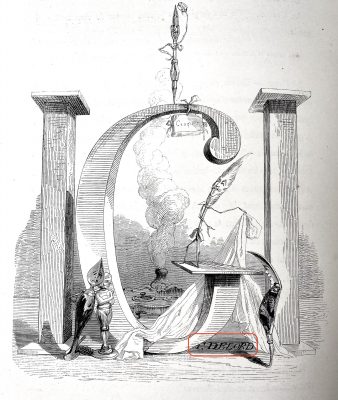
-
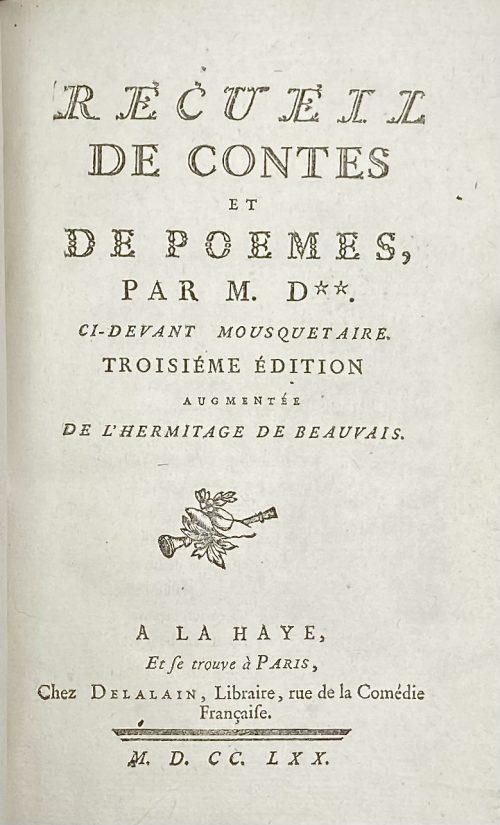 Title page: RECUEIL | DE CONTES | ET | DE POEMES, | PAR M. D**. | CI-DEVANT MOUSQUETAIRE. | TROSIÉME ÉDITION | AUGUMENTÉE | DE L'HERMITAGE DE BEAUVAIS. | [device] | A LA HAYE, | Et se trouve à Paris, | Chez Delalain, Libraire, rue de la Comédie | Française. | — | M. D. CC. LXX. IRZA | ET MARSIS , | POËME, includes: L'isle merveilleuse, Poëme, Chant 1re et Chant 2nd, Invocation a La Fontaine, and Alphonse, Conte – Cohen and De Ricci (#317) describe 2nd edition by the same publisher, 1769, 77 p., with similar illustrations after Charles Eisen: (1) engraved title by Louis Claude Legrand (2) L’Isle 1er: Frontispiece by Joseph de Longueil, (3) headpiece and (4) tailpiece by Emmanuel de Ghendt, and (5) L’Isle 2nd: Frontispiece by Jean Massard, (6) headpiece by Emmanuel de Ghendt + (7) tailpiece unsigned. Les Cerises et la Méprise, Contes en vers – Cohen and De Ricci (#311) also describe the 2nd edition of 1769, with the same (8) frontispiece by De Longueil after Eisen. Sélim et Sélima, Poeme imité de l'allemand; L'hermitage de beauvais, Conte –Cohen and De Ricci (#322) describe edition of 1769 by Sébastien Jorry, with the same (9) frontispiece by Emmanuel de Ghendt after Eisen. Size: 18.6 x 12.3 cm, small 8vo. Binding: polished, multi-coloured stained calf with gilt triple fillet border to boards; gilt floral arabesque and gilt lettering to flat spine: "Oeuvres de Dorat | Contes"; all edges gilt; blue-and-white marbled endpapers. Pagination: ffl, [2] IRZA ET MARSIS engraved half-title / blank, [1-2] - RECUEIL title page / blank, 3-8 (avis sur cette édition); [1 - L'Isle...] 2-184, bfl; Illustrations (copperplate engravings): 5 plates, 2 headpieces and 2 tailpieces. Collation: Octavo; a8 (title and avis sur cette édition); A-L8, M4. Author of the text: Claude Joseph Dorat, (French, 1734 – 1780) Artist: Charles-Dominique-JosephEisen (French, 1720 – 1778) Engravers: Emmanuel Jean Nepomucène de Ghendt (French, 1738 – 1815) Louis Claude Legrand (French, 1723 – 1807) Joseph de Longueil (French, 1730 – 1792) Jean Massard (French, 1740 – 1822)
Title page: RECUEIL | DE CONTES | ET | DE POEMES, | PAR M. D**. | CI-DEVANT MOUSQUETAIRE. | TROSIÉME ÉDITION | AUGUMENTÉE | DE L'HERMITAGE DE BEAUVAIS. | [device] | A LA HAYE, | Et se trouve à Paris, | Chez Delalain, Libraire, rue de la Comédie | Française. | — | M. D. CC. LXX. IRZA | ET MARSIS , | POËME, includes: L'isle merveilleuse, Poëme, Chant 1re et Chant 2nd, Invocation a La Fontaine, and Alphonse, Conte – Cohen and De Ricci (#317) describe 2nd edition by the same publisher, 1769, 77 p., with similar illustrations after Charles Eisen: (1) engraved title by Louis Claude Legrand (2) L’Isle 1er: Frontispiece by Joseph de Longueil, (3) headpiece and (4) tailpiece by Emmanuel de Ghendt, and (5) L’Isle 2nd: Frontispiece by Jean Massard, (6) headpiece by Emmanuel de Ghendt + (7) tailpiece unsigned. Les Cerises et la Méprise, Contes en vers – Cohen and De Ricci (#311) also describe the 2nd edition of 1769, with the same (8) frontispiece by De Longueil after Eisen. Sélim et Sélima, Poeme imité de l'allemand; L'hermitage de beauvais, Conte –Cohen and De Ricci (#322) describe edition of 1769 by Sébastien Jorry, with the same (9) frontispiece by Emmanuel de Ghendt after Eisen. Size: 18.6 x 12.3 cm, small 8vo. Binding: polished, multi-coloured stained calf with gilt triple fillet border to boards; gilt floral arabesque and gilt lettering to flat spine: "Oeuvres de Dorat | Contes"; all edges gilt; blue-and-white marbled endpapers. Pagination: ffl, [2] IRZA ET MARSIS engraved half-title / blank, [1-2] - RECUEIL title page / blank, 3-8 (avis sur cette édition); [1 - L'Isle...] 2-184, bfl; Illustrations (copperplate engravings): 5 plates, 2 headpieces and 2 tailpieces. Collation: Octavo; a8 (title and avis sur cette édition); A-L8, M4. Author of the text: Claude Joseph Dorat, (French, 1734 – 1780) Artist: Charles-Dominique-JosephEisen (French, 1720 – 1778) Engravers: Emmanuel Jean Nepomucène de Ghendt (French, 1738 – 1815) Louis Claude Legrand (French, 1723 – 1807) Joseph de Longueil (French, 1730 – 1792) Jean Massard (French, 1740 – 1822) -
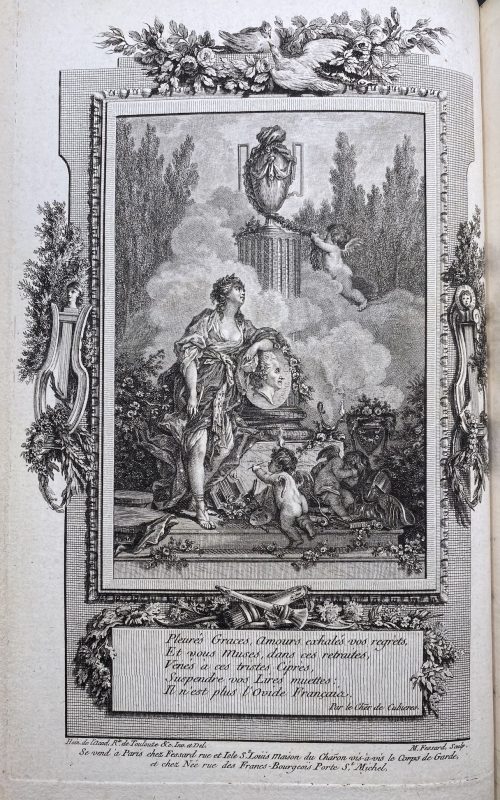 Title page: LES | BAISERS , | PRÉCÉDES | DU MOIS DE MAI, | POËME. | [vignette] | A LA HAYE , | Et se trouve à Paris | Chez Lambert , Imprimeur, rue de la Harpe. | Et Delalain , rue de la Comédie Françoise. | M. DCC. LXX Size: 8vo; 24.5 x 15.5 cm; Binding by Hippolyte Duru – stamp at the back of the front end paper DURU, 1855; full red calf, boards decorated in gilt, raised bands and gilt decorations in compartments, gilt lettering, AEG, peacock marbled end papers, text and illustrations printed on Holland paper. Collation: 2 ffls, engraved half-title by N. Ponce after Ch. Eisen, frontispiece by Etienne Fessard after Claude-Jean-Baptiste Hoin (French, 1750 – 1817) w/guard tissue, t.p. by J. Aliamet after Ch. Eisen, Réflexions préliminaires: A8, B4; 'Le Mois de Mai' half-title, imprim. note on verso, frontispice by De Longueil after Ch. Eisen w/guard tissue, A4 C-F(8) H4; 2bfls. Frontispiece by Etienne Fessard is unique in this edition. Pagination: [2] 3-24, [27]/28, 5/6, 31/32 31/34 11/12 37-119 [120], 22 head-pieces after Ch. Eisen and 22 end-pieces after Marillier, engraved by Baquoy, Binet, Delaunay, Lingée, De Longueil, Masquelier, Massard, and Née. Mistakes in pagination likely confirms first printing first edition. Catalogue raisonné: Cohen, De Ricci (1912): 308-311). Artists: Charles Eisen (French, 1720–1778); Clément Pierre Marillier (French, 1740–1808), and Claude-Jean-Baptiste Hoin (French, 1750–1817). Engravers: Jacques Aliamet (French, 1726–1788); Jean Charles Baquoy (French, 1721–1777); Louis Binet (French, 1744–about 1800); Nicolas Delaunay (French, 1739–1792); Etienne Fessard (French, 1714–1777); Charles Louis Lingée (French, 1748–1819); Joseph de Longueil (French, 1730–1792); Louis Joseph Masquelier (French, 1741–1811); Jean Massard (1740–1822); François Denis Née (French, 1735–1818); Nicholas Ponce (French, 1746–1831).
Title page: LES | BAISERS , | PRÉCÉDES | DU MOIS DE MAI, | POËME. | [vignette] | A LA HAYE , | Et se trouve à Paris | Chez Lambert , Imprimeur, rue de la Harpe. | Et Delalain , rue de la Comédie Françoise. | M. DCC. LXX Size: 8vo; 24.5 x 15.5 cm; Binding by Hippolyte Duru – stamp at the back of the front end paper DURU, 1855; full red calf, boards decorated in gilt, raised bands and gilt decorations in compartments, gilt lettering, AEG, peacock marbled end papers, text and illustrations printed on Holland paper. Collation: 2 ffls, engraved half-title by N. Ponce after Ch. Eisen, frontispiece by Etienne Fessard after Claude-Jean-Baptiste Hoin (French, 1750 – 1817) w/guard tissue, t.p. by J. Aliamet after Ch. Eisen, Réflexions préliminaires: A8, B4; 'Le Mois de Mai' half-title, imprim. note on verso, frontispice by De Longueil after Ch. Eisen w/guard tissue, A4 C-F(8) H4; 2bfls. Frontispiece by Etienne Fessard is unique in this edition. Pagination: [2] 3-24, [27]/28, 5/6, 31/32 31/34 11/12 37-119 [120], 22 head-pieces after Ch. Eisen and 22 end-pieces after Marillier, engraved by Baquoy, Binet, Delaunay, Lingée, De Longueil, Masquelier, Massard, and Née. Mistakes in pagination likely confirms first printing first edition. Catalogue raisonné: Cohen, De Ricci (1912): 308-311). Artists: Charles Eisen (French, 1720–1778); Clément Pierre Marillier (French, 1740–1808), and Claude-Jean-Baptiste Hoin (French, 1750–1817). Engravers: Jacques Aliamet (French, 1726–1788); Jean Charles Baquoy (French, 1721–1777); Louis Binet (French, 1744–about 1800); Nicolas Delaunay (French, 1739–1792); Etienne Fessard (French, 1714–1777); Charles Louis Lingée (French, 1748–1819); Joseph de Longueil (French, 1730–1792); Louis Joseph Masquelier (French, 1741–1811); Jean Massard (1740–1822); François Denis Née (French, 1735–1818); Nicholas Ponce (French, 1746–1831). -
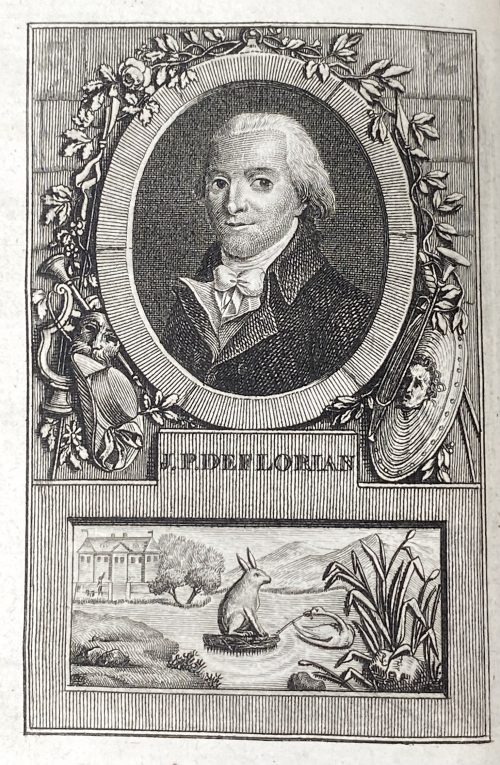 Title: FABLES | DE | M. DE FLORIAN , | de l’académie françoise, de celles de Madrid , | Florence, etc. | — | Je tâche d'y tourner le vice ridicule , | Ne pouvant l'attaquer avec des bras d'Hercule. | La Font. Fables , liv. V , I. — | [publisher's device ] | A PARIS, | DE L'IMPRIMERIE DE P. DIDOT L'AINÉ, | 1792. Pagination: ffl, [2 - h.t. / Imp.] [2 - blank / frontis.] [2 - tp. / blank] [5] 6-224 [2 - advert. / blank], bfl. Collation: numbered 1(5), 2-18(6), 19(3); engarved frontispiece portrait of Florian after François Hüet-Villiers, 5 engraved plates by Longueil, Delignon, and Gaucher after Flouest. Binding: Contemporary full mottled calf, all margins red, gilt floral ornaments to flat spine, red label with gilt lettering. Catalogue raisonné: Cohen, de Ricci 1912: p. 398-9.
Title: FABLES | DE | M. DE FLORIAN , | de l’académie françoise, de celles de Madrid , | Florence, etc. | — | Je tâche d'y tourner le vice ridicule , | Ne pouvant l'attaquer avec des bras d'Hercule. | La Font. Fables , liv. V , I. — | [publisher's device ] | A PARIS, | DE L'IMPRIMERIE DE P. DIDOT L'AINÉ, | 1792. Pagination: ffl, [2 - h.t. / Imp.] [2 - blank / frontis.] [2 - tp. / blank] [5] 6-224 [2 - advert. / blank], bfl. Collation: numbered 1(5), 2-18(6), 19(3); engarved frontispiece portrait of Florian after François Hüet-Villiers, 5 engraved plates by Longueil, Delignon, and Gaucher after Flouest. Binding: Contemporary full mottled calf, all margins red, gilt floral ornaments to flat spine, red label with gilt lettering. Catalogue raisonné: Cohen, de Ricci 1912: p. 398-9. -
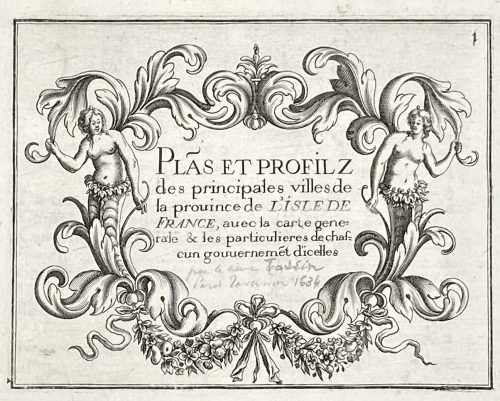 Title page: Text engraved within a vignette with two naked female torses in garlands: Plãs et profilz | des principales villes de | la prouince de L'ISLE DE | FRANCE, auec la carte gene~ | rale & les particulieres de chaf~ | cun gouuernement d'icelles. Below handwritten pencil inscription by a previous owner: "par ... Tassin ... 1634". Size: 17.6 x 23.7 cm, Binding: Italian style, green half-vellum, burgundy morocco title label with vertical gilt lettering to spine, peacock marbled boards. Pagination: Two blank flyleaves in the front and two in the back; 18 numbered engraved plates, including:
Title page: Text engraved within a vignette with two naked female torses in garlands: Plãs et profilz | des principales villes de | la prouince de L'ISLE DE | FRANCE, auec la carte gene~ | rale & les particulieres de chaf~ | cun gouuernement d'icelles. Below handwritten pencil inscription by a previous owner: "par ... Tassin ... 1634". Size: 17.6 x 23.7 cm, Binding: Italian style, green half-vellum, burgundy morocco title label with vertical gilt lettering to spine, peacock marbled boards. Pagination: Two blank flyleaves in the front and two in the back; 18 numbered engraved plates, including:- Title page
- Table of Contents
- Normandie
- Environs de Paris
- Folding map of Paris – a simplified copy of Mathieu Merian's 1615 perspective plan, with minor updates, notably on the current housing estate of Ile Saint-Louis.
- Paris
- Gouvernment de Soissons
- Soissons
- Gouvernment de Beauvais
- Beauvais
- Gouvernment de Compiègne
- Compiègne
- Gouvernment de Noyon
- Noyon
- Gouvernment de Coussi
- Coussi
- Gouvernment de Senlis
- Senlis
-
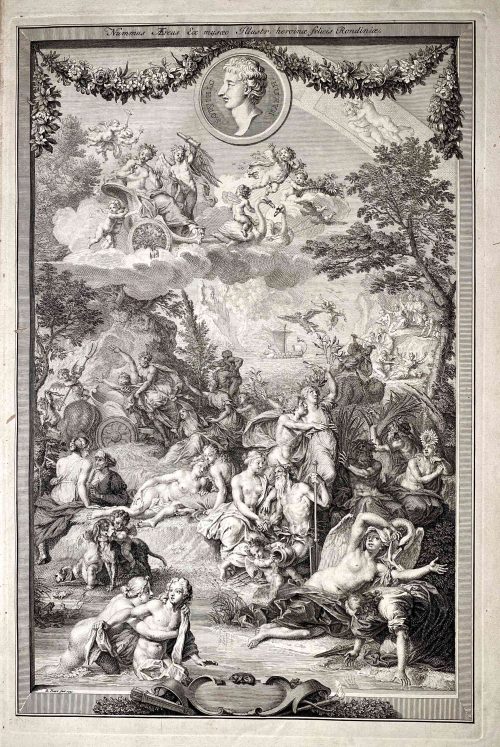 Vol. 1 title: OVID'S | METAMORPHOSES | IN LATIN AND ENGLISH, | TRANSLATED BY | THE MOST EMINENT HANDS. | With HISTORICAL EXPLICATIONS | Of the FABLES, | WRITTEN IN FRENCH BY | The ABBOT BANIER, | MEMBER OF THE ACADEMY OF INSCRIPTIONS | AND BELLES LETTRES. | TRANSLATED INTO ENGLISH. | Adorned with Sculptures, by B. Picart, and other able Masters. | VOLUME THE FIRST. | [Device] | AMSTERDAM, | Printed for the WETSTEINS and SMITH. | MD CC XXII || — Pagination: [26 – Half-title, frontis., t.p., dedic., The Bookseller's Preface To This Edition, Mr. Banier's Preface To The French Translation, Contents], [1] 2-247 – Text of books 1-7, with illus., [1 blank]. Vol. 2 half-title: OVID'S | METAMORPHOSES | IN LATIN AND ENGLISH | TWO VOLUMES || — Pagination: [2 – half-title / blank], 249-524 – Text of books 8-15, with illus., incl. 3 leaves of pl., [4 – Index]. Three leaves between pages 264 and 271 are included in the pagination as pp. [265-70] but do not carry page-numbers or letterpress text. They each carry two prints on their rectos and are blank on the verso. Vol. II without the engraved title page. The names of the translators are given in the list of Contents as Dryden, Addison, Eusden, Arthur Mainwaring, Croxall, Tate, Stonestreet, Vernon, Gay, Pope, Stephen Harvey, Congreve, Ozel, Temple Stanyan, , Catcot, Rowe, Samuel Garth, Welsted. The frontispiece is signed as made by B. Picart. The six plates on pages [265, 267, 269] are all signed as painted by C. Le Brun and engraved by Iakob Folkema. Of the 124 illustrations, most are unsigned by a draughtsman, but some are signed as designed by G. Maas, one as designed by Jul. Romain, two as designed by G. Maas and drawn by J. de Wit, one as drawn by 'HA', one as painted by C. le Brun, one as made by B. Picart, one as designed by P. Testa and drawn by B. Picart, one as designed by S. Le Clerc, one as designed by B. Picart. Many are signed by their engravers - Philip à Gunst (one as directed by B. Picart and engraved by Phil. à Gunst), J. Vandelaar (or I. Wandelaar), Martin Bouche, Jan Schenck, 'MB', Petr. Paul. Bouche, Iakob Folkema, W. Jongman, Fred. Bouttats. The title-page vignette of Volume I is signed as drawn by B. v. Overbeke and engraved by F. Mulder. Many tailpieces are signed 'VLS'. The book is dedicated by the publishers, R. and J. Wetstein and W. Smith, to the Countess of Pembroke. [Description is cited from the Royal Academy of Arts] Physical description: Two large 4to volumes, first title page printed in red and black, added engraved title in the first volume; half-title in the second volume; illustrated throughout with copperplate engravings in text; text printed in parallel columns in Latin and English; three leaves extraneous to collation each with two engravings in the second volume; bookplate pasted to the front endpaper in each volume: Ex Libris Theodore C. Tebbetts (Theodore Charles Tebbetts, American, 1871 – 1920) designed after Francis Carruthers Gould (British, 1844 – 1925); pages 517-520 of the second volume torn with loss of bottom blank corners and a word or two; original full leather, spines tooled elaborately in gilt; some boards detached, endcaps and corners rather worn, contents bright and fresh. Size: Large 4to; 47.5 x 31 cm.
Vol. 1 title: OVID'S | METAMORPHOSES | IN LATIN AND ENGLISH, | TRANSLATED BY | THE MOST EMINENT HANDS. | With HISTORICAL EXPLICATIONS | Of the FABLES, | WRITTEN IN FRENCH BY | The ABBOT BANIER, | MEMBER OF THE ACADEMY OF INSCRIPTIONS | AND BELLES LETTRES. | TRANSLATED INTO ENGLISH. | Adorned with Sculptures, by B. Picart, and other able Masters. | VOLUME THE FIRST. | [Device] | AMSTERDAM, | Printed for the WETSTEINS and SMITH. | MD CC XXII || — Pagination: [26 – Half-title, frontis., t.p., dedic., The Bookseller's Preface To This Edition, Mr. Banier's Preface To The French Translation, Contents], [1] 2-247 – Text of books 1-7, with illus., [1 blank]. Vol. 2 half-title: OVID'S | METAMORPHOSES | IN LATIN AND ENGLISH | TWO VOLUMES || — Pagination: [2 – half-title / blank], 249-524 – Text of books 8-15, with illus., incl. 3 leaves of pl., [4 – Index]. Three leaves between pages 264 and 271 are included in the pagination as pp. [265-70] but do not carry page-numbers or letterpress text. They each carry two prints on their rectos and are blank on the verso. Vol. II without the engraved title page. The names of the translators are given in the list of Contents as Dryden, Addison, Eusden, Arthur Mainwaring, Croxall, Tate, Stonestreet, Vernon, Gay, Pope, Stephen Harvey, Congreve, Ozel, Temple Stanyan, , Catcot, Rowe, Samuel Garth, Welsted. The frontispiece is signed as made by B. Picart. The six plates on pages [265, 267, 269] are all signed as painted by C. Le Brun and engraved by Iakob Folkema. Of the 124 illustrations, most are unsigned by a draughtsman, but some are signed as designed by G. Maas, one as designed by Jul. Romain, two as designed by G. Maas and drawn by J. de Wit, one as drawn by 'HA', one as painted by C. le Brun, one as made by B. Picart, one as designed by P. Testa and drawn by B. Picart, one as designed by S. Le Clerc, one as designed by B. Picart. Many are signed by their engravers - Philip à Gunst (one as directed by B. Picart and engraved by Phil. à Gunst), J. Vandelaar (or I. Wandelaar), Martin Bouche, Jan Schenck, 'MB', Petr. Paul. Bouche, Iakob Folkema, W. Jongman, Fred. Bouttats. The title-page vignette of Volume I is signed as drawn by B. v. Overbeke and engraved by F. Mulder. Many tailpieces are signed 'VLS'. The book is dedicated by the publishers, R. and J. Wetstein and W. Smith, to the Countess of Pembroke. [Description is cited from the Royal Academy of Arts] Physical description: Two large 4to volumes, first title page printed in red and black, added engraved title in the first volume; half-title in the second volume; illustrated throughout with copperplate engravings in text; text printed in parallel columns in Latin and English; three leaves extraneous to collation each with two engravings in the second volume; bookplate pasted to the front endpaper in each volume: Ex Libris Theodore C. Tebbetts (Theodore Charles Tebbetts, American, 1871 – 1920) designed after Francis Carruthers Gould (British, 1844 – 1925); pages 517-520 of the second volume torn with loss of bottom blank corners and a word or two; original full leather, spines tooled elaborately in gilt; some boards detached, endcaps and corners rather worn, contents bright and fresh. Size: Large 4to; 47.5 x 31 cm. -
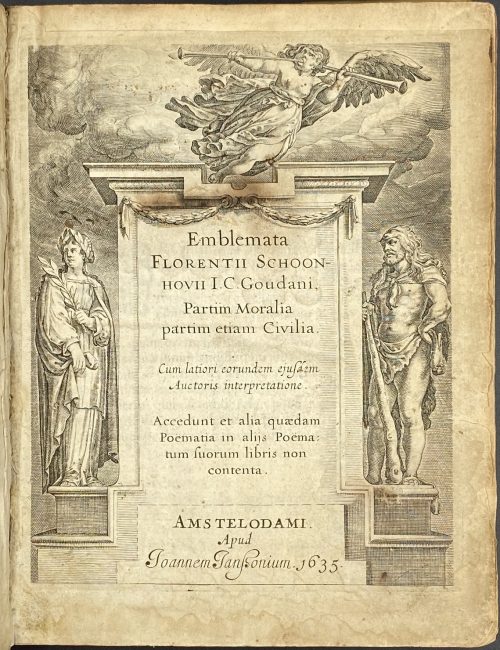 Title: Emblemata | Florentii Schoon~ | hovii I. C. Goudani, | Partim moralia | partim etiam Civilia. | Cum latiori eorundem ejusdem | Auctoris interpretatione. | Accedunt et alia quædam | Poëmatia in alijs Poëma | tum suorum libris non | contenta. | Amstelodami. | Apud | Joannem Janßonium •1635• Size: 20 x15.5 cm, small 4to Edition: 3rd edition (the first two editions being by Burier, Gouda, 1618 and by Elzevir, Leiden, 1626. Collation: ¶/*6, A-Z4, Aa-Ff4, Gg2. Pagination: [2] - enrgaved t.p. / blank, [6] - dedication, [2] - lectori benevolo, [2] - in commend. / frontis. engraved portrait of Gerardus Traudenius – academic/intellectual; author/poet (Dutch, fl. 1615 – 1623), 1-235. Illustrated with engraved title, portrait of dedicatee, and 74 engraved emblems by Crispijn van de Passe the Younger (1594/5 – 1670). Binding: bound in full contemporary Dutch blind-stamped parchment over thin boards, laced case construction, inked title to spine, no flyleaves, signature washed from the title, the blank margin of title trimmed away at head, slight marginal water stain to the first signature, front bottom board corner bumped.
Title: Emblemata | Florentii Schoon~ | hovii I. C. Goudani, | Partim moralia | partim etiam Civilia. | Cum latiori eorundem ejusdem | Auctoris interpretatione. | Accedunt et alia quædam | Poëmatia in alijs Poëma | tum suorum libris non | contenta. | Amstelodami. | Apud | Joannem Janßonium •1635• Size: 20 x15.5 cm, small 4to Edition: 3rd edition (the first two editions being by Burier, Gouda, 1618 and by Elzevir, Leiden, 1626. Collation: ¶/*6, A-Z4, Aa-Ff4, Gg2. Pagination: [2] - enrgaved t.p. / blank, [6] - dedication, [2] - lectori benevolo, [2] - in commend. / frontis. engraved portrait of Gerardus Traudenius – academic/intellectual; author/poet (Dutch, fl. 1615 – 1623), 1-235. Illustrated with engraved title, portrait of dedicatee, and 74 engraved emblems by Crispijn van de Passe the Younger (1594/5 – 1670). Binding: bound in full contemporary Dutch blind-stamped parchment over thin boards, laced case construction, inked title to spine, no flyleaves, signature washed from the title, the blank margin of title trimmed away at head, slight marginal water stain to the first signature, front bottom board corner bumped. -
 Magazine article by Edgar Jepson: The Iron Tsuba of Japan (Section: Oriental Art), published in volume Vol. 70 (September–December) of The Connoisseur: An Illustrated Magazine for Collectors, Vol. 70 (September–December); pp. 143-152 / C. Reginald Grundy [ed.] — London: Published by the Proprietor, W. CLAUSE JOHNSON, at the Editorial and Advertisement Offices of The Connoisseur, 1924. Owner's half black morocco, gilt lettering to spine, blue cloth boards. Two volumes bound together without original covers. Size 28.5 x 22 cm. Vol. 1: The Connoisseur | An Illustrated Magazine | For Collectors | Edited by C. Reginald Grundy | Vol. LXIX. | (MAY—AUGUST, 1924) | LONDON | Published by the Proprietor, W. CLAUSE JOHNSON, at the | Editorial and Advertisement Offices of The Connoisseur, | at 1, Duke Street, St. James's, S.W. 1 | 1924 || Pp.: [i-ii] iii-xviii [xix] [1, 2 - plate] 3-249 [250]. Vol. 2: The Connoisseur | An Illustrated Magazine | For Collectors | Edited by C. Reginald Grundy | Vol. LXX. | (SEPTEMBER—DECEMBER, 1924) | LONDON | Published by the Proprietor, W. CLAUSE JOHNSON, at the | Editorial and Advertisement Offices of The Connoisseur, | at 1, Duke Street, St. James's, S.W. 1 | 1924 || Pp.: [i-ii] iii-xxii [2 blanks] [1, 2 - plate] 3-261 [262]. The Iron Tsuba of Japan by Edgar Jepson The heart of Japan was in the sword. However admirable may be the paintings, the prints, the netsuke, the lacquer, or the bronzes of the Japanese masters, the supreme artistic achievements of Japan were the blades of Masamune, Muramasa, Sadamune, and Rai Kunitsugu. But not a little of the heart of Japan went also in the tsuba, the guard which protected the hand that wielded the blade, into the iron tsuba of the fighting Samurai. Beside the forgers of the iron tsuba of Japan the ironsmiths of the rest of the world have been mere children. The earliest tsuba were of bronze or copper, often gilded. It is probable that they were replaced by iron tsuba during the Kamakura period, the great fighting era, which lasted from A.D. 1185 to 1333. During the later half of the twelfth century leather tsuba, strengthened by thin iron plates or a metal rim, also replaced the bronze and copper tsuba. It was at this time that a family of armourers of the name of Masuda, and in particular Masuda Munesuke, the founder of the Myochin family, began to forge iron tsuba — thin, round plates of great hardness and density. But it is probable that no tsuba perforated with a view to decorative effects were forged before the end of the fourteenth century. These fourteenth-century tsuba are exceedingly rare in England. I have seen none in the museums, none in the famous collections that have been sold during the last ten years. Those photographed in Herr Oeder's book might easily be the fifteenth century. No. 1 is a curious cup-shape tsuba decorated with a bronze and copper inlay. No. 2, with its edges curiously twisted in the forging, looks like Myochin work. But it is not of the Myochin iron. The Myochin family produced some of the greatest ironsmiths of Japan. Armourers first of all, tsubasmiths, forgers of sake-kettles, articulated reptiles, crustacea, and insects — everything that can be done with iron they did; they pushed their medium to its limit. They were forging iron tsuba in 1160, and they were still forging them in 1860. And it was their own iron, or rather their own steel. They discovered the secret of it early, and they kept that secret in the family for all those hundreds of years. There is no mistaking a Myochin tsuba: balance it on your finger and tap it with a piece of metal, always it gives forth a clear bell-like ring that you get from the work of no other ironsmith, Japanese or European. Always the Myochin tsuba is before everything a protection to the hand of the swordsman; to that everything is, as it should be, subordinated. No. 3 is a Myochin tsuba of the fifteenth century, and probably of the early fifteenth century. No. 4, by Myochin Munetaka, perforated with a grotesque figure, is an example of that twisting and twisting of the iron in the forging till it forms a pattern like the grain of wood. The Myochin smiths invented these wood-grain tsuba, and no other smiths equalled them in their forging. In the sixteenth century, the fighting tsuba was probably at its best. It was a century of great tsubasmiths. Then the first Nobuiye, whose tsuba fetched £100 apiece, circa 1800, in Japan, and the first Kaneiye flourished. No. 5 is a tsuba forged by a great smith, Iyesada of Sotome, in the manner of Nobuiye I, decorated with the karakusa tendrils that Nobuiye delighted in, with lightning and clouds. No. 6 is a guard of Sanada Tembo, the chief smith of the Tembo family, stamped, punning fashion, with the character Tembo. Akin to the Tembo tsuba were those of the Kiami and Hoan smiths. Then also the Heianjo smiths and the Owari smiths, especially those of Nagoya and the Yamakichi family, forged their strongest tsuba. Those of the Yamakichi were tested after the forging by being pounded in iron mortars — at least, so the legend runs. But they were a sternly utilitarian family, and I have never seen a Yamakichi tsuba of any beauty. In the later half of the fifteenth century arose the fashion of decorating tsuba with an inlay, zogan, of bronze. The Heianjo tsuba, forged at Kyoto in the latter half of the fifteenth and the beginning of the sixteenth century, were often thus inlaid. The earliest of them were called "Onin", of which No. 7 is an example. In addition to the bronze inlay around the edge, it is inlaid with a representation, some say, of snow; others say, of the duckweed on a pond. No. 8 is probably a Heianjo tsuba, but I am not quite sure about it. The inlaid acacia branches might be very early Shoami work. But to judge by the iron, it is a fifteenth-century tsuba; and the authorities place the beginning of the Shoami school not later than early in the sixteenth century. No. 10 is an example of the Fushimi-zogan, a flat inlay of a light-coloured bronze. These tsuba took their name from the fact that they were first forged at Fushimi, in Yamashiro, in the sixteenth century. It is of the type known as Mon-zukashi, perforated with crests (mon) à jour. The Yoshiro-zogan tsuba were also first forged at Fushimi by Yoshiro Naomasa. They were distinguished from the Fushimi-zogan by the fact that their inlay was generally a little raised-not always-for the inlay of No. 9, a tsuba forged by a later nineteenth-century Yoshiro, is quite flat. It is an interesting tsuba, for, with its decoration grown florid and excessive, it marks the intermediate stage between the simple and delightful designs of the genuine fighting tsuba and the elaborate pictures in gold and silver on the tsuba of the eighteenth-century smiths of Awa and Kyoto, which have become mere ornaments of the goldsmith. The Gomoku-zogan (No. 11) tsuba were probably first forged earlier than the Fushimi and Yoshiro-zogan tsuba. This inlay, in slight relief, is a representation in a light-coloured bronze and copper of twigs caught in the eddies of streams. The seventeenth century and early eighteenth century were the great periods of perforated tsuba. The designs, and they are often admirable, are for the most part in plain fretwork; but they are also chased. No. 12, a crane under an acacia, is a tsuba of a Higo smith, great forgers of fighting tsuba during this period. These smiths also excelled in nunome zogan, a very thin gold and silver inlay, with which they further decorated their perforated guards. The smiths of the Umetada and Shoami families also forged iron tsuba during this period; but their designs, though sometimes pleasing enough, are rarely fine. The best work of Myoju Umetada is in sentoku, not iron. The Choshu smiths, coming later, surpass the perforated guards of both the Umetada and Shoami smiths in beauty of design. No. 13, a lotus in the round, not only fretwork, but also engraved, is a good example of the admirable balance they so often attained in their designs. It is a sufficiently realistic lotus, but yet of a delightful simplicity. In considerable contrast is No. 14, the dragon by Soheishi Soten — one of the only two authentic tsuba of his forging known — the first forger of hikone-bori tsuba, which were in extraordinary favour in Japan during the eighteenth century, and illustrated every important event in Japanese history. It is on the elaborate side, but fine, strong work, and an excellent guard to the hand, for the lighter and more open part, which gives the design its admirable balance, is on the inside, and not exposed to the full swing of an opponent's blade. A few years ago there was a tendency to decry the Namban tsuba as having sprung too directly from foreign sources. But though the original suggestion may have been Chinese, or, as some say, Portuguese, the Japanese made it entirely their own, as characteristically Japanese as anything can well be, but, it must be admitted, of a decadent period. The school took its rise at the beginning of the seventeenth century, and the early tsuba were forged of a specially hard iron, the Wootz, imported from Southern India. No. 15, the signs of the Zodiac, is an excellent tsuba from the fighting point of view. Both it and No. 16 are of quite charming, if elaborate, design, and both of them, with their delicate scroll-work, so astonishingly undercut, are the very last word in the work of the ironsmith-veritable iron lace. To return to the simpler perforated tsuba, the smiths of Akasaka, a suburb of Tokyo, produced probably the most charming designs. Their style derives considerably from the Higo smiths, and their earlier fighting tsuba are very like the Higo tsuba. But always their work was just a little lighter than that of the Higo smiths, and in the end they moved right away from them and became the forgers of very light guards indeed. No. 17, is a representation of the Hiyokudori, the fabulous double bird, in which were reincarnated the souls of the two lovers, Gompachi and Komurasaki; and No. 18, “the tsuba of a hundred ducks "— there are about forty — are characteristic designs of the school. In the work of the Akasaka smiths the balance, which makes the design of a good tsuba so admirable and delightful, attains its height. This admirable balance seems often to be obtained by a deliberate sacrifice of symmetry. About nine hundred and ninety-nine European ironsmiths out of a thousand would have made the right and left sides of the Hiyoku-dori line by line, and perforation by perforation, exactly alike; he would have cut out exactly as many ducks on the one side of “the tsuba of a hundred ducks” as on the other, and made each duck on the right side correspond exactly in position and attitude with a duck on the left side. By variations the tsubasmith attained a finer balance, almost a higher symmetry. No. 19, often called by collectors the "rose-window" tsuba, but really a stylised chrysanthemum, is a favourite design of the Akasaka smiths, but Hizen work and inlaid in the Hizen manner with gold nunome. No. 20 is a Satsuma tsuba of the middle period. The Satsuma smiths of the nineteenth century produced probably the most ornate of all the iron guards, for the most part calibashes and beans with their leaves and tendrils realistic in the extreme, but of charming design. Few crafts have been carried further than that of the tsubasmith; few crafts working in a difficult medium have handled more subjects with greater feeling for beauty or greater liveliness of fancy. It is interesting to note again and again how school influences school, and smith influences smith. But, as in all the applied arts, the finest tsuba were forged by men who never lost sight of the purpose of a tsuba, that it is before everything a protection to the hand, and never subjected that purpose to a passion for virtuosity. Illustrations: No 1. FOURTEENTH-CENTURY TSUBA, WITH BRONZE AND COPPER INLAY No. 2. FOURTEENTH-CENTURY TSUBA, RESEMBLING MYOCHIN WORK No. 3. MYOCHIN TSUBA, FIFTEENTH CENTURY No. 4. MYOCHIN TSUBA, NINETEENTH CENTURY No. 5. SIXTEENTH-CENTURY TSUBA No. 6. SIXTEENTH-CENTURY TSUBA BY IYESADA OF SOTOME BY SANADA TEMBO No. 7. ONIN TSUBA No. 8. HEIANJO (?) TSUBA No. 9. YOSHIRO TSUBA, NINETEENTH CENTURY No. 10. FUSHIMI-ZOGAN, NINETEENTH CENTURY No. 11.- GOMOKU-ZOGAN, SIXTEENTH CENTURY No. 12. HIGO TSUBA, SEVENTEENTH CENTURY No. 13. CHOSHU TSUBA, SEVENTEENTH CENTURY No. 14. SOTEN TSUBA, SEVENTEENTH CENTURY No. 15. NAMBAN TSUBA, EIGHTEENTH CENTURY No. 16. NAMBAN TSUBA, NINETEENTH CENTURY Nos. 17. AND 18. AKASAKA TSUBA, EIGHTEENTH CENTURY No. 19. HIZEN TSUBA, EIGHTEENTH CENTURY No. 20. SATSUMA TSUBA, EIGHTEENTH CENTURY
Magazine article by Edgar Jepson: The Iron Tsuba of Japan (Section: Oriental Art), published in volume Vol. 70 (September–December) of The Connoisseur: An Illustrated Magazine for Collectors, Vol. 70 (September–December); pp. 143-152 / C. Reginald Grundy [ed.] — London: Published by the Proprietor, W. CLAUSE JOHNSON, at the Editorial and Advertisement Offices of The Connoisseur, 1924. Owner's half black morocco, gilt lettering to spine, blue cloth boards. Two volumes bound together without original covers. Size 28.5 x 22 cm. Vol. 1: The Connoisseur | An Illustrated Magazine | For Collectors | Edited by C. Reginald Grundy | Vol. LXIX. | (MAY—AUGUST, 1924) | LONDON | Published by the Proprietor, W. CLAUSE JOHNSON, at the | Editorial and Advertisement Offices of The Connoisseur, | at 1, Duke Street, St. James's, S.W. 1 | 1924 || Pp.: [i-ii] iii-xviii [xix] [1, 2 - plate] 3-249 [250]. Vol. 2: The Connoisseur | An Illustrated Magazine | For Collectors | Edited by C. Reginald Grundy | Vol. LXX. | (SEPTEMBER—DECEMBER, 1924) | LONDON | Published by the Proprietor, W. CLAUSE JOHNSON, at the | Editorial and Advertisement Offices of The Connoisseur, | at 1, Duke Street, St. James's, S.W. 1 | 1924 || Pp.: [i-ii] iii-xxii [2 blanks] [1, 2 - plate] 3-261 [262]. The Iron Tsuba of Japan by Edgar Jepson The heart of Japan was in the sword. However admirable may be the paintings, the prints, the netsuke, the lacquer, or the bronzes of the Japanese masters, the supreme artistic achievements of Japan were the blades of Masamune, Muramasa, Sadamune, and Rai Kunitsugu. But not a little of the heart of Japan went also in the tsuba, the guard which protected the hand that wielded the blade, into the iron tsuba of the fighting Samurai. Beside the forgers of the iron tsuba of Japan the ironsmiths of the rest of the world have been mere children. The earliest tsuba were of bronze or copper, often gilded. It is probable that they were replaced by iron tsuba during the Kamakura period, the great fighting era, which lasted from A.D. 1185 to 1333. During the later half of the twelfth century leather tsuba, strengthened by thin iron plates or a metal rim, also replaced the bronze and copper tsuba. It was at this time that a family of armourers of the name of Masuda, and in particular Masuda Munesuke, the founder of the Myochin family, began to forge iron tsuba — thin, round plates of great hardness and density. But it is probable that no tsuba perforated with a view to decorative effects were forged before the end of the fourteenth century. These fourteenth-century tsuba are exceedingly rare in England. I have seen none in the museums, none in the famous collections that have been sold during the last ten years. Those photographed in Herr Oeder's book might easily be the fifteenth century. No. 1 is a curious cup-shape tsuba decorated with a bronze and copper inlay. No. 2, with its edges curiously twisted in the forging, looks like Myochin work. But it is not of the Myochin iron. The Myochin family produced some of the greatest ironsmiths of Japan. Armourers first of all, tsubasmiths, forgers of sake-kettles, articulated reptiles, crustacea, and insects — everything that can be done with iron they did; they pushed their medium to its limit. They were forging iron tsuba in 1160, and they were still forging them in 1860. And it was their own iron, or rather their own steel. They discovered the secret of it early, and they kept that secret in the family for all those hundreds of years. There is no mistaking a Myochin tsuba: balance it on your finger and tap it with a piece of metal, always it gives forth a clear bell-like ring that you get from the work of no other ironsmith, Japanese or European. Always the Myochin tsuba is before everything a protection to the hand of the swordsman; to that everything is, as it should be, subordinated. No. 3 is a Myochin tsuba of the fifteenth century, and probably of the early fifteenth century. No. 4, by Myochin Munetaka, perforated with a grotesque figure, is an example of that twisting and twisting of the iron in the forging till it forms a pattern like the grain of wood. The Myochin smiths invented these wood-grain tsuba, and no other smiths equalled them in their forging. In the sixteenth century, the fighting tsuba was probably at its best. It was a century of great tsubasmiths. Then the first Nobuiye, whose tsuba fetched £100 apiece, circa 1800, in Japan, and the first Kaneiye flourished. No. 5 is a tsuba forged by a great smith, Iyesada of Sotome, in the manner of Nobuiye I, decorated with the karakusa tendrils that Nobuiye delighted in, with lightning and clouds. No. 6 is a guard of Sanada Tembo, the chief smith of the Tembo family, stamped, punning fashion, with the character Tembo. Akin to the Tembo tsuba were those of the Kiami and Hoan smiths. Then also the Heianjo smiths and the Owari smiths, especially those of Nagoya and the Yamakichi family, forged their strongest tsuba. Those of the Yamakichi were tested after the forging by being pounded in iron mortars — at least, so the legend runs. But they were a sternly utilitarian family, and I have never seen a Yamakichi tsuba of any beauty. In the later half of the fifteenth century arose the fashion of decorating tsuba with an inlay, zogan, of bronze. The Heianjo tsuba, forged at Kyoto in the latter half of the fifteenth and the beginning of the sixteenth century, were often thus inlaid. The earliest of them were called "Onin", of which No. 7 is an example. In addition to the bronze inlay around the edge, it is inlaid with a representation, some say, of snow; others say, of the duckweed on a pond. No. 8 is probably a Heianjo tsuba, but I am not quite sure about it. The inlaid acacia branches might be very early Shoami work. But to judge by the iron, it is a fifteenth-century tsuba; and the authorities place the beginning of the Shoami school not later than early in the sixteenth century. No. 10 is an example of the Fushimi-zogan, a flat inlay of a light-coloured bronze. These tsuba took their name from the fact that they were first forged at Fushimi, in Yamashiro, in the sixteenth century. It is of the type known as Mon-zukashi, perforated with crests (mon) à jour. The Yoshiro-zogan tsuba were also first forged at Fushimi by Yoshiro Naomasa. They were distinguished from the Fushimi-zogan by the fact that their inlay was generally a little raised-not always-for the inlay of No. 9, a tsuba forged by a later nineteenth-century Yoshiro, is quite flat. It is an interesting tsuba, for, with its decoration grown florid and excessive, it marks the intermediate stage between the simple and delightful designs of the genuine fighting tsuba and the elaborate pictures in gold and silver on the tsuba of the eighteenth-century smiths of Awa and Kyoto, which have become mere ornaments of the goldsmith. The Gomoku-zogan (No. 11) tsuba were probably first forged earlier than the Fushimi and Yoshiro-zogan tsuba. This inlay, in slight relief, is a representation in a light-coloured bronze and copper of twigs caught in the eddies of streams. The seventeenth century and early eighteenth century were the great periods of perforated tsuba. The designs, and they are often admirable, are for the most part in plain fretwork; but they are also chased. No. 12, a crane under an acacia, is a tsuba of a Higo smith, great forgers of fighting tsuba during this period. These smiths also excelled in nunome zogan, a very thin gold and silver inlay, with which they further decorated their perforated guards. The smiths of the Umetada and Shoami families also forged iron tsuba during this period; but their designs, though sometimes pleasing enough, are rarely fine. The best work of Myoju Umetada is in sentoku, not iron. The Choshu smiths, coming later, surpass the perforated guards of both the Umetada and Shoami smiths in beauty of design. No. 13, a lotus in the round, not only fretwork, but also engraved, is a good example of the admirable balance they so often attained in their designs. It is a sufficiently realistic lotus, but yet of a delightful simplicity. In considerable contrast is No. 14, the dragon by Soheishi Soten — one of the only two authentic tsuba of his forging known — the first forger of hikone-bori tsuba, which were in extraordinary favour in Japan during the eighteenth century, and illustrated every important event in Japanese history. It is on the elaborate side, but fine, strong work, and an excellent guard to the hand, for the lighter and more open part, which gives the design its admirable balance, is on the inside, and not exposed to the full swing of an opponent's blade. A few years ago there was a tendency to decry the Namban tsuba as having sprung too directly from foreign sources. But though the original suggestion may have been Chinese, or, as some say, Portuguese, the Japanese made it entirely their own, as characteristically Japanese as anything can well be, but, it must be admitted, of a decadent period. The school took its rise at the beginning of the seventeenth century, and the early tsuba were forged of a specially hard iron, the Wootz, imported from Southern India. No. 15, the signs of the Zodiac, is an excellent tsuba from the fighting point of view. Both it and No. 16 are of quite charming, if elaborate, design, and both of them, with their delicate scroll-work, so astonishingly undercut, are the very last word in the work of the ironsmith-veritable iron lace. To return to the simpler perforated tsuba, the smiths of Akasaka, a suburb of Tokyo, produced probably the most charming designs. Their style derives considerably from the Higo smiths, and their earlier fighting tsuba are very like the Higo tsuba. But always their work was just a little lighter than that of the Higo smiths, and in the end they moved right away from them and became the forgers of very light guards indeed. No. 17, is a representation of the Hiyokudori, the fabulous double bird, in which were reincarnated the souls of the two lovers, Gompachi and Komurasaki; and No. 18, “the tsuba of a hundred ducks "— there are about forty — are characteristic designs of the school. In the work of the Akasaka smiths the balance, which makes the design of a good tsuba so admirable and delightful, attains its height. This admirable balance seems often to be obtained by a deliberate sacrifice of symmetry. About nine hundred and ninety-nine European ironsmiths out of a thousand would have made the right and left sides of the Hiyoku-dori line by line, and perforation by perforation, exactly alike; he would have cut out exactly as many ducks on the one side of “the tsuba of a hundred ducks” as on the other, and made each duck on the right side correspond exactly in position and attitude with a duck on the left side. By variations the tsubasmith attained a finer balance, almost a higher symmetry. No. 19, often called by collectors the "rose-window" tsuba, but really a stylised chrysanthemum, is a favourite design of the Akasaka smiths, but Hizen work and inlaid in the Hizen manner with gold nunome. No. 20 is a Satsuma tsuba of the middle period. The Satsuma smiths of the nineteenth century produced probably the most ornate of all the iron guards, for the most part calibashes and beans with their leaves and tendrils realistic in the extreme, but of charming design. Few crafts have been carried further than that of the tsubasmith; few crafts working in a difficult medium have handled more subjects with greater feeling for beauty or greater liveliness of fancy. It is interesting to note again and again how school influences school, and smith influences smith. But, as in all the applied arts, the finest tsuba were forged by men who never lost sight of the purpose of a tsuba, that it is before everything a protection to the hand, and never subjected that purpose to a passion for virtuosity. Illustrations: No 1. FOURTEENTH-CENTURY TSUBA, WITH BRONZE AND COPPER INLAY No. 2. FOURTEENTH-CENTURY TSUBA, RESEMBLING MYOCHIN WORK No. 3. MYOCHIN TSUBA, FIFTEENTH CENTURY No. 4. MYOCHIN TSUBA, NINETEENTH CENTURY No. 5. SIXTEENTH-CENTURY TSUBA No. 6. SIXTEENTH-CENTURY TSUBA BY IYESADA OF SOTOME BY SANADA TEMBO No. 7. ONIN TSUBA No. 8. HEIANJO (?) TSUBA No. 9. YOSHIRO TSUBA, NINETEENTH CENTURY No. 10. FUSHIMI-ZOGAN, NINETEENTH CENTURY No. 11.- GOMOKU-ZOGAN, SIXTEENTH CENTURY No. 12. HIGO TSUBA, SEVENTEENTH CENTURY No. 13. CHOSHU TSUBA, SEVENTEENTH CENTURY No. 14. SOTEN TSUBA, SEVENTEENTH CENTURY No. 15. NAMBAN TSUBA, EIGHTEENTH CENTURY No. 16. NAMBAN TSUBA, NINETEENTH CENTURY Nos. 17. AND 18. AKASAKA TSUBA, EIGHTEENTH CENTURY No. 19. HIZEN TSUBA, EIGHTEENTH CENTURY No. 20. SATSUMA TSUBA, EIGHTEENTH CENTURY -
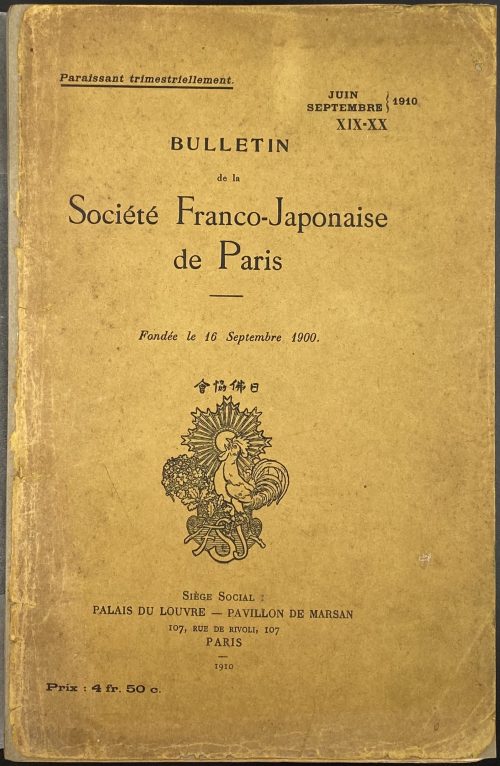 Comte de Tressan. L'évolution de la garde de sabre japonaise de la fin du XVe siècle au commencement du XVIIe (suite), 34 illustr. – pp. 7-35. // Bulletin de la Société Franco-Japonaise de Paris; №№ 19-20, Juin–Septembre 1910, 216 p. — Paris: Société Franco-Japonaise de Paris, Siège Social, 1910. Publisher's original green wrappers with black lettering: On top: Paraissant trimestriellement. | JUIN | SEPTEMBRE | } 1920 | XIX-XX | In the middle: BULLETIN | de la | Société Franco-Japonaise | de Paris | [—] Fondée le 16 Septembre 1900 | [device] | Bottom: Siège Social : | PALAIS DU LOUVRE — PAVILLON DE MARSAN | 107, RUE DE RIVOLI, 107 | Paris | 1910 | Prix : 4 fr 50 c || — Pp.: [4] [1-5] 6-216 [2 - errata / blank] [2 - imprim./ blank] [6]. Size: 27 x 17.5 cm.
Comte de Tressan. L'évolution de la garde de sabre japonaise de la fin du XVe siècle au commencement du XVIIe (suite), 34 illustr. – pp. 7-35. // Bulletin de la Société Franco-Japonaise de Paris; №№ 19-20, Juin–Septembre 1910, 216 p. — Paris: Société Franco-Japonaise de Paris, Siège Social, 1910. Publisher's original green wrappers with black lettering: On top: Paraissant trimestriellement. | JUIN | SEPTEMBRE | } 1920 | XIX-XX | In the middle: BULLETIN | de la | Société Franco-Japonaise | de Paris | [—] Fondée le 16 Septembre 1900 | [device] | Bottom: Siège Social : | PALAIS DU LOUVRE — PAVILLON DE MARSAN | 107, RUE DE RIVOLI, 107 | Paris | 1910 | Prix : 4 fr 50 c || — Pp.: [4] [1-5] 6-216 [2 - errata / blank] [2 - imprim./ blank] [6]. Size: 27 x 17.5 cm. -
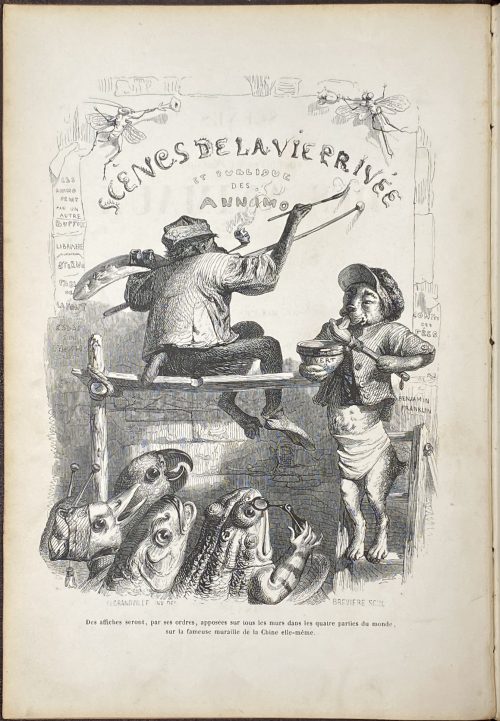 A two-volume set in the contemporary full calf, imitating the editorial cloth binding. Vol. 1: SCÈNES | DE LA | VIE PRIVÉE ET PUBLIQUE | DES ANIMAUX | VIGNETTES | PAR GRANDVILLE. | — | ÉTUDES DE MŒURS CONTEMPORAINES | PUBLIÉES | SOUS LA DIRECTION DE M. P. – J. STAHL , | AVEC LA COLLABORATION | DE MESSIEURS | DE BALZAC. – L. BAUDE. – E. DE LA BEDOLLIERE. – P. BERNARD. – J. JANIN. | ED. LEMOINE. – CHARLES NODIER. – GEORGE SAND. | [VIGNETTE] | PARIS. | J. HETZEL ET PAULIN , ÉDITEURS , | RUE DE SEINE-SAINT-GERMAIN , 33. | 1842 Pagination: [2 blanks] [2 - ht. / imprim.] [2 - blank / frontis.] [2 - t.p. / blank] [4] [1] 2-386 [6 - table] [2 blanks], 96 whole-page wood-engravings after Grandville, vignettes within the text including head and tailpieces, together with a frontispiece. VOL. 2: SCÈNES | DE LA | VIE PRIVÉE ET PUBLIQUE | DES ANIMAUX | VIGNETTES | PAR GRANDVILLE. | — | ÉTUDES DE MŒURS CONTEMPORAINES | PUBLIÉES | SOUS LA DIRECTION DE M. P. – J. STAHL , | AVEC LA COLLABORATION | DE | MM. DE BALZAC, – L' HERITIER (DE L' AIN), – ALFRED DE MUSSET – PAUL DE MUSSET, | CHARLES NODIER, – MADAME M. MENESSIER NODIER, – LOUIS VIARDOT. | [VIGNETTE] | PARIS, | J. HETZEL , ÉDITEUR , | RUE DE SEINE-SAINT-GERMAIN , 33. | 1842 Pagination: [2 - ht. / imprim.] [2 - blank / frontis.] [2 - t.p. / blank] [1] 2-390 [6 - table], 105 whole-page wood-engravings after Grandville, vignettes within the text including head and tailpieces, together with a frontispiece. Size: Each volume 27 x 18 cm; In-4to (usually classified as 8vo, however, the numeric signatures provide for gathering in-quarto). Binding: Full burgundy calf, gilt embossed Grandville's characters to boards and spine, lettering to spine, white moire end-papers to vol. 1, and yellow end-papers to vol. 2, all margins gilt. Combination of the 1st and 2nd print-runs of the 1st edition. Ref.: L. Carteret, 1927: pp. 552-558. Wikipedia; Gallica; Hathi Trust. In: British Museum, MET, RISD Museum, Fine Arts Museums of San Francisco.
A two-volume set in the contemporary full calf, imitating the editorial cloth binding. Vol. 1: SCÈNES | DE LA | VIE PRIVÉE ET PUBLIQUE | DES ANIMAUX | VIGNETTES | PAR GRANDVILLE. | — | ÉTUDES DE MŒURS CONTEMPORAINES | PUBLIÉES | SOUS LA DIRECTION DE M. P. – J. STAHL , | AVEC LA COLLABORATION | DE MESSIEURS | DE BALZAC. – L. BAUDE. – E. DE LA BEDOLLIERE. – P. BERNARD. – J. JANIN. | ED. LEMOINE. – CHARLES NODIER. – GEORGE SAND. | [VIGNETTE] | PARIS. | J. HETZEL ET PAULIN , ÉDITEURS , | RUE DE SEINE-SAINT-GERMAIN , 33. | 1842 Pagination: [2 blanks] [2 - ht. / imprim.] [2 - blank / frontis.] [2 - t.p. / blank] [4] [1] 2-386 [6 - table] [2 blanks], 96 whole-page wood-engravings after Grandville, vignettes within the text including head and tailpieces, together with a frontispiece. VOL. 2: SCÈNES | DE LA | VIE PRIVÉE ET PUBLIQUE | DES ANIMAUX | VIGNETTES | PAR GRANDVILLE. | — | ÉTUDES DE MŒURS CONTEMPORAINES | PUBLIÉES | SOUS LA DIRECTION DE M. P. – J. STAHL , | AVEC LA COLLABORATION | DE | MM. DE BALZAC, – L' HERITIER (DE L' AIN), – ALFRED DE MUSSET – PAUL DE MUSSET, | CHARLES NODIER, – MADAME M. MENESSIER NODIER, – LOUIS VIARDOT. | [VIGNETTE] | PARIS, | J. HETZEL , ÉDITEUR , | RUE DE SEINE-SAINT-GERMAIN , 33. | 1842 Pagination: [2 - ht. / imprim.] [2 - blank / frontis.] [2 - t.p. / blank] [1] 2-390 [6 - table], 105 whole-page wood-engravings after Grandville, vignettes within the text including head and tailpieces, together with a frontispiece. Size: Each volume 27 x 18 cm; In-4to (usually classified as 8vo, however, the numeric signatures provide for gathering in-quarto). Binding: Full burgundy calf, gilt embossed Grandville's characters to boards and spine, lettering to spine, white moire end-papers to vol. 1, and yellow end-papers to vol. 2, all margins gilt. Combination of the 1st and 2nd print-runs of the 1st edition. Ref.: L. Carteret, 1927: pp. 552-558. Wikipedia; Gallica; Hathi Trust. In: British Museum, MET, RISD Museum, Fine Arts Museums of San Francisco. -
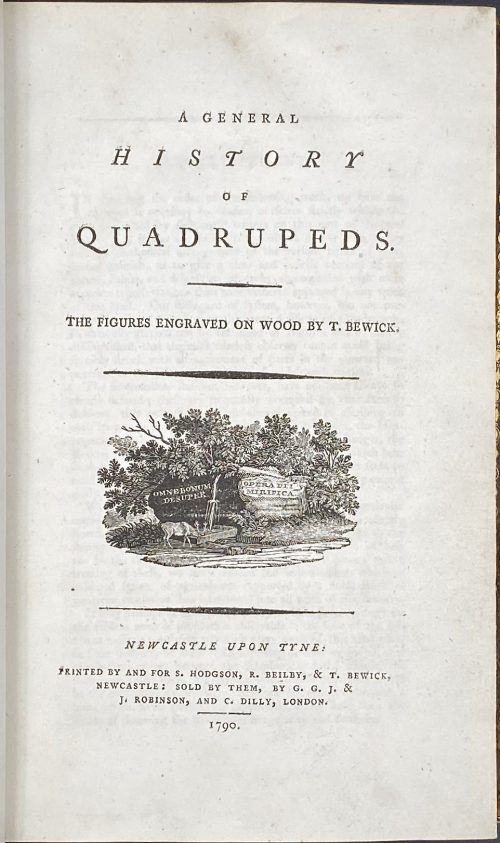 Title: A GENERAL | HISTORY | OF | QUADRUPEDS. | – | THE FIGURES ENGRAVED ON WOOD BY THOMAS BEWICK. | {vignette} | — | NEWCASTLE UPON TYNE : | PRINTED BY AND FOR S. HODGSON, R. BEILBY, & T. BEWICK, | NEWCASTLE: SOLD BY THEM, BY G. G. J. & | J. ROBINSON, AND C. DILLY, LONDON. | 1790. Pagination: [4 blanks], [i, ii] – t.p. / blank, [iii, iv] – advertisement / index, v-viii – index, [1] 2-456 [4 blanks]. Collation: demi 8vo; a⁴ A-Ee⁸ Ff⁴. A3 unsigned, catchword at p.375 THE instead of WE. Variant A (with a fly facing upward). Size: 21.8 x 14 cm; page 21.2 x 13 cm. Woodcuts: 260 descriptions of quadrupeds; 200 figures of quadrupeds, 104 vignettes, tailpieces, etc. Binding: Full marbled calf, gilt double border, black label with gilt lettering to flat spine. There were 1,500 copies Demy copies printed. Catalogue raisonné: S. Roscoe (1953): pp. 5-11; Hugo (1866): pp. 22-23.
Title: A GENERAL | HISTORY | OF | QUADRUPEDS. | – | THE FIGURES ENGRAVED ON WOOD BY THOMAS BEWICK. | {vignette} | — | NEWCASTLE UPON TYNE : | PRINTED BY AND FOR S. HODGSON, R. BEILBY, & T. BEWICK, | NEWCASTLE: SOLD BY THEM, BY G. G. J. & | J. ROBINSON, AND C. DILLY, LONDON. | 1790. Pagination: [4 blanks], [i, ii] – t.p. / blank, [iii, iv] – advertisement / index, v-viii – index, [1] 2-456 [4 blanks]. Collation: demi 8vo; a⁴ A-Ee⁸ Ff⁴. A3 unsigned, catchword at p.375 THE instead of WE. Variant A (with a fly facing upward). Size: 21.8 x 14 cm; page 21.2 x 13 cm. Woodcuts: 260 descriptions of quadrupeds; 200 figures of quadrupeds, 104 vignettes, tailpieces, etc. Binding: Full marbled calf, gilt double border, black label with gilt lettering to flat spine. There were 1,500 copies Demy copies printed. Catalogue raisonné: S. Roscoe (1953): pp. 5-11; Hugo (1866): pp. 22-23.


